HYUNDAI MOBIS AV1A0IHAN CAR AVN User Manual
HYUNDAI MOBIS CO., LTD. CAR AVN Users Manual
Users Manual
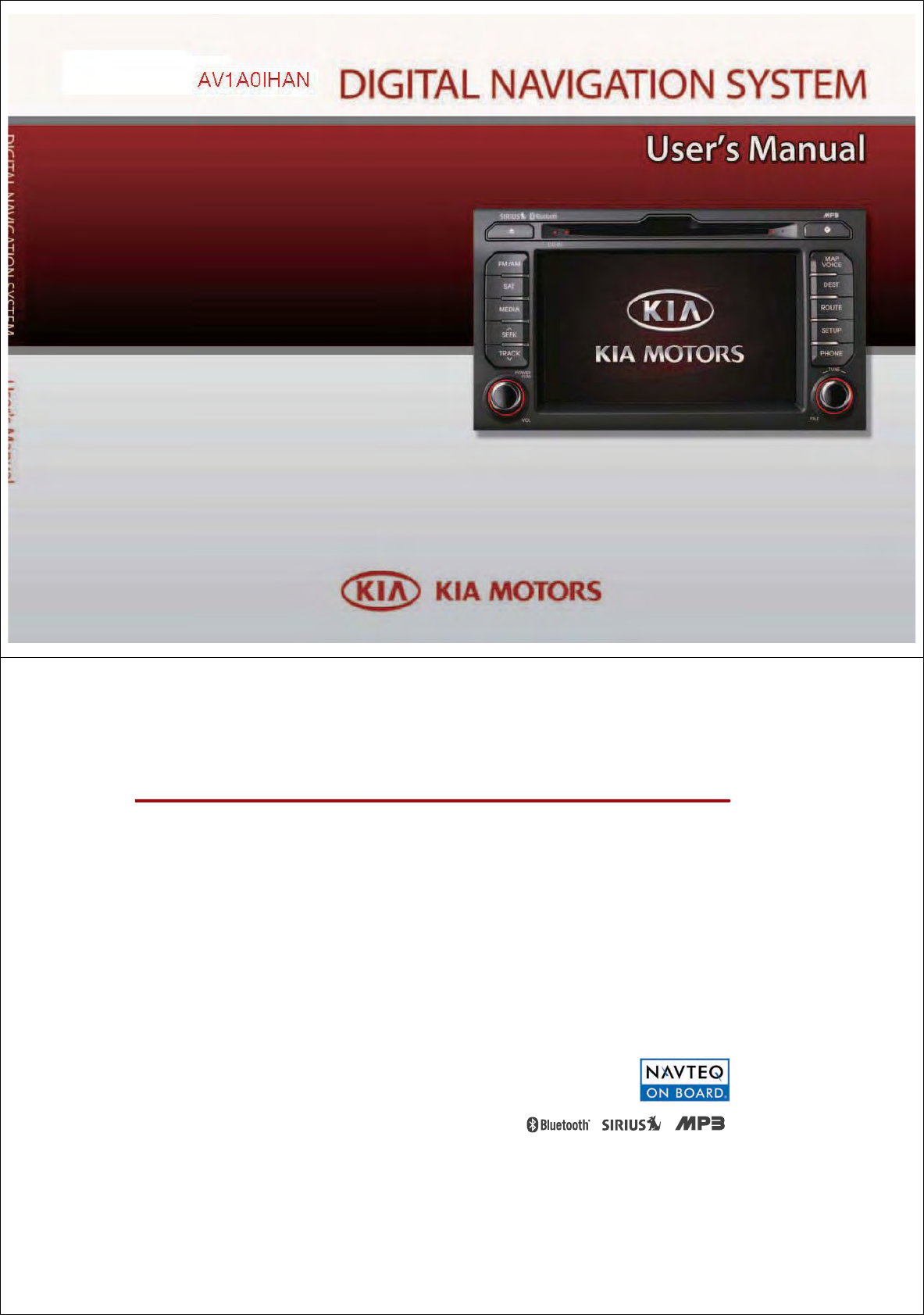
Thank you for purchasing this Audio
Navigation System.
This user manual explains how to use
the KIA Motor Audio Navigation
System.
Before using the product, read the
contents of this user's manual carefully
and use the product safely.
●
The screens shown in this manual
may differ with the actual screens of
the product.
●
The design and specification of this
product may change without prior
notification for product improvement.
●
When transferring the vehicle to
another individual, include this user's
manual so that the next driver can
continue its use.
iPod®
iPod® is a registered trademark of
Apple, Inc.
Bluetooth®
The Bluetooth® word mark and logos
are registered trademarks owned by
Bluetooth SIG, Inc. and any use of such
marks by Kia is under license. A
Bluetooth® enabled cell phone is
required to use Bluetooth® wireless
technology.
All Map Database cannot be copied without permission.
This is protected by U.S. copyright laws. All rights not expressly granted are reserved.
You may not otherwise reproduce, modify, and distribute the content without M&Soft, Inc's prior written consent.
Preface

PART 1
PRE-OVERVIEW
Introduction #䐙䐙䐙䐙䐙䐙䐙䐙 1-2
Important information about this
manual# 㾕㾕㾕㾕㾕㾕㾕㾕㾕㾕㾕 #1-2
Precaution for safe usage# 㾕㾕㾕㾕 #1-2
Controller and functions #䐙䐙
1-3
Control panel#㾕㾕㾕㾕㾕㾕㾕㾕㾕 #1-3
Steering wheel remote controller#㾕 #1-6
Basic operation and setting #䐙
1-7
Turning the power ON# 㾕㾕㾕㾕㾕 #1-7
Turning the power OFF#㾕㾕㾕㾕㾕 #1-7
Turning the audio ON/OFF#㾕㾕㾕㾕 #1-7
Adjusting audio volume#㾕㾕㾕㾕㾕 #1-7
How to operate the screen menu#㾕 #1-8
How to operate menu by voice command
#㾕#
1-10
Audio sound setting# 㾕㾕㾕㾕㾕㾕 #1-11
Display setting# 㾕㾕㾕㾕㾕㾕㾕㾕 #1-12
Setting Picture Frame#㾕㾕㾕㾕㾕㾕 #1-13
Viewing Current Time#㾕㾕㾕㾕㾕㾕 #1-14
Setting the Clock# 㾕㾕㾕㾕㾕㾕㾕 #1-14
PART 2
AUDIO SYSTEM
Operating the radio #䐙䐙䐙䐙䐙 2-2
FM/AM Radio #㾕㾕㾕㾕㾕㾕㾕㾕㾕 #2-2
SIRIUS Radio# 㾕㾕㾕㾕㾕㾕㾕㾕㾕 #2-6
Operating the CDP # 䐙䐙䐙䐙 2-11
About CDP#㾕㾕㾕㾕㾕㾕㾕㾕㾕㾕 #2-11
Inserting/Ejecting Disc# 㾕㾕㾕㾕㾕 #2-14
CD# 㾕㾕㾕㾕㾕㾕㾕㾕㾕㾕㾕㾕㾕 #2-15
MP3#㾕㾕㾕㾕㾕㾕㾕㾕㾕㾕㾕㾕㾕 #2-18
Operating the external devices
# 2-23
iPod#㾕㾕㾕㾕㾕㾕㾕㾕㾕㾕㾕㾕㾕 #2-23
USB#㾕㾕㾕㾕㾕㾕㾕㾕㾕㾕㾕㾕㾕 #2-28
AUX#㾕㾕㾕㾕㾕㾕㾕㾕㾕㾕㾕㾕㾕 #2-31
PART 3
NAVIGATION SYSTEM
Limitations of the navigation
system# 䐙䐙䐙䐙䐙䐙䐙䐙䐙䐙 3-2
GPS signal reception state#㾕㾕㾕㾕 #3-2
Vehicle position display#㾕㾕㾕㾕㾕 #3-3
Route guidance#㾕㾕㾕㾕㾕㾕㾕㾕 #3-4
Route Re-calculation#㾕㾕㾕㾕㾕㾕 #3-4
Starting navigation system
#㾕㾕 #
3-5
Map Functions# 䐙䐙䐙䐙䐙䐙䐙 3-5
Current position map screen
(without route)# 㾕㾕㾕㾕㾕㾕㾕㾕 #3-5
Switching map mode
(North up/Heading up)# 㾕㾕㾕㾕㾕 #3-6
Viewing GPS signal state# 㾕㾕㾕㾕 #3-7
Changing the map scale# 㾕㾕㾕㾕 #3-8
Displaying / Hiding POI icons
on the map#㾕㾕㾕㾕㾕㾕㾕㾕㾕㾕 #3-9
Displaying / Hiding Q.POI icons#㾕 #3-9
Displaying /Hiding icons other than
Q.POI icons#㾕㾕㾕㾕㾕㾕㾕㾕㾕 #3-9
Making a call to POI
#㾕㾕㾕㾕㾕㾕 #3-10
Scrolling map#㾕㾕㾕㾕㾕㾕㾕㾕㾕 #3-11
Tables of contents
Setting a Destination# 䐙䐙䐙 3-12
Destination menu screen and functions
##
3-12
Searching a Destination#㾕㾕㾕㾕㾕 #3-13
Searching an Address # 㾕㾕㾕㾕 #3-13
Searching a Previous Destination
#㾕#
3-17
Searching an Intersection #㾕㾕㾕 #3-17
Searching a POI# 㾕㾕㾕㾕㾕㾕㾕 #3-20
Searching from Address book#㾕#3-24
Searching for Emergency facilities
##
3-25
Searching your Home#㾕㾕㾕㾕㾕 #3-25
Searching favorite places# 㾕㾕㾕 #3-26
Searching from MAP# 㾕㾕㾕㾕㾕 #3-26
Searching POI by local POI list#㾕#3-26
Operating after searching a
destination #㾕㾕㾕㾕㾕㾕㾕㾕㾕㾕 #3-27
Changing destination position#㾕 #3-27
Setting as Destination/waypoint# #3-27
Adding to address book#㾕㾕㾕㾕 #3-27
Operating after setting
a destination # 䐙䐙䐙䐙䐙䐙 3-28
Starting Route Guidance# 㾕㾕㾕㾕 #3-28
Route guidance screen# 㾕㾕㾕㾕㾕 #3-28
Selecting other route#㾕㾕㾕㾕㾕㾕 #3-29
Route guidance#䐙䐙䐙䐙䐙䐙 3-30
Route menu screen and functions#㾕 #3-30
Finishing route guidance
(Delete Destination)# 㾕㾕㾕㾕㾕㾕 #3-30
Route overview(View Entire Route)# #3-31
Changing Route option#㾕㾕㾕㾕㾕 #3-32
Editing waypoints# 㾕㾕㾕㾕㾕㾕㾕 #3-32
Adding waypoints# 㾕㾕㾕㾕㾕㾕 #3-32
Deleting waypoints# 㾕㾕㾕㾕㾕 #3-34
Re-ordering waypoints# 㾕㾕㾕㾕 #3-34
Setting detour distance#㾕㾕㾕㾕㾕 #3-35
Setting avoid streets on route#㾕㾕#3-35
Setup and Information#䐙䐙 3-36
Setup menu screen and functions#㾕 #3-36
Main setting# 㾕㾕㾕㾕㾕㾕㾕㾕㾕 #3-36
Setting keyboard for inputting
letter# 㾕㾕㾕㾕㾕㾕㾕㾕㾕㾕㾕 #3-36
Setting voice command feedback
ON/OFF# 㾕㾕㾕㾕㾕㾕㾕㾕㾕㾕 #3-37
Setting Language# 㾕㾕㾕㾕㾕㾕 #3-37
Initializing system# 㾕㾕㾕㾕㾕㾕# 3-37
Navigation setting#㾕㾕㾕㾕㾕㾕㾕 #3-38
Setting units (mile/km)# 㾕㾕㾕㾕 #3-38
Setting arrival time and distance
display#㾕㾕㾕㾕㾕㾕㾕㾕㾕㾕㾕 #3-38
Registering avoid area# 㾕㾕㾕㾕 #3-38
Editing avoid area# 㾕㾕㾕㾕㾕㾕 #3-40
Deleting avoid area# 㾕㾕㾕㾕㾕 #3-41
Deleting all avoid areas#㾕㾕㾕㾕 #3-41
Setting Q.POI icons#㾕㾕㾕㾕㾕㾕 3-42
Setting estimate travel time#㾕㾕# 3-42
My places setting# 㾕㾕㾕㾕㾕㾕㾕 #3-43
Registering new address in
address book# 㾕㾕㾕㾕㾕㾕㾕㾕 3-43
Editing an address of
address book #㾕㾕㾕㾕㾕㾕㾕㾕 3-45
Deleting an address of address
book# 㾕㾕㾕㾕㾕㾕㾕㾕㾕㾕㾕 3-46
Deleting an address book#㾕㾕㾕 3-47
Registering home address#㾕㾕㾕 3-48
Deleting home address#㾕㾕㾕㾕 3-48
Registering favorite place# 㾕㾕㾕 3-49
Deleting favorite place# 㾕㾕㾕㾕 3-50
Voice guidance volume setting#㾕 㾕 #3-51
Voice guidance volume control#㾕 #3-51
Adaptive volume control ON/OFF
#㾕#
3-52
Traffic Setup# 㾕㾕㾕㾕㾕㾕㾕㾕㾕 #3-52
Traffic Information#㾕㾕㾕㾕㾕㾕㾕 #3-52
Help#㾕㾕㾕㾕㾕㾕㾕㾕㾕㾕㾕㾕㾕 #3-54
Tables of contents

PART 4
VOICE COMMAND SYSTEM
Operating voice command #䐙 #4-2
Condition for voice command system
##
4-2
Basic operation for voice
command control# 㾕㾕㾕㾕㾕㾕㾕 #4-2
Voice command help#㾕㾕㾕㾕㾕㾕 #4-3
Setting up the voice command sys-
tem #䐙䐙䐙䐙䐙䐙䐙䐙䐙䐙䐙䐙 4-4
Setting voice Prompt ON/OFF#㾕㾕 #4-4
Speaker adaptation# 㾕㾕㾕㾕㾕㾕 #4-4
Voice command list #䐙䐙䐙䐙䐙 4-6
Command list of Help# 㾕㾕㾕㾕㾕 #4-6
Command list of Audio system
#㾕㾕 #
4-7
Command list of Phone
# 㾕㾕㾕㾕㾕 #4-13
Command list of Navigation system
##
4-14
Searching a destination by
voice command#㾕㾕㾕㾕㾕㾕㾕㾕 #4-19
PART 5
BLUETOOTH® HANDSFREE
Before using the Bluetooth®
Handsfree
# 䐙䐙䐙䐙䐙䐙䐙䐙 #5-2
What is Bluetooth® ?# 㾕㾕㾕㾕㾕㾕㾕 #5-2
Functions supported by Bluetooth
Ⓡ
Handsfree# 㾕㾕㾕㾕㾕㾕㾕㾕㾕㾕㾕 #5-2
Converting Bluetooth® Handsfree
mode
# 䐙䐙䐙䐙䐙䐙䐙䐙䐙䐙 #5-2
Converting from Audio/Navigation mode to
Bluetooth® Handsfree mode#㾕㾕㾕㾕 #5-2
Converting from Bluetooth® Handsfree mode
to Audio/Navigation mode# 㾕㾕㾕㾕 #5-3
Pairing and connecting a Bluetooth®
phone
#䐙䐙䐙䐙䐙䐙䐙䐙䐙䐙 #5-4
Pairing a mobile phone#㾕㾕㾕㾕㾕㾕 #5-4
Deleting a paired phone# 㾕㾕㾕㾕㾕 #5-6
Connecting a mobile phone#㾕㾕㾕㾕 #5-7
Disconnecting a mobile phone#㾕㾕㾕 #5-8
Bluetooth® Handsfree screen
layout
#䐙䐙䐙䐙䐙䐙䐙䐙䐙䐙 #5-9
Bluetooth® Handsfree screen and
functions#㾕㾕㾕㾕㾕㾕㾕㾕㾕㾕㾕㾕 #5-9
When there is no mobile phone
connected
#㾕㾕㾕㾕㾕㾕㾕㾕㾕㾕㾕 #5-9
When a mobile phone is connected#㾕 #5-9
When receiving an incoming call#㾕㾕#5-10
When already on a call# 㾕㾕㾕㾕㾕㾕 #5-10
When there is a call waiting# 㾕㾕㾕㾕 #5-10
Making a call
# 䐙䐙䐙䐙䐙䐙䐙 #5-11
Making a call by dialing a phone
number# 㾕㾕㾕㾕㾕㾕㾕㾕㾕㾕㾕㾕 #5-11
Making a call from Speed Dial # 㾕㾕㾕 #5-11
Making a call by redialing#㾕㾕㾕㾕㾕 #5-12
Answering a call
#䐙䐙䐙䐙䐙䐙 #5-13
Answering an incoming call #㾕㾕㾕㾕 #5-13
Rejecting an incoming #㾕㾕㾕㾕㾕㾕 #5-13
Operating menus during a call
#䐙 5-14
Switching call to the mobile phone#㾕#5-14
Activating Call waiting# 㾕㾕㾕㾕㾕㾕 #5-14
Ending a call# 㾕㾕㾕㾕㾕㾕㾕㾕㾕㾕 #5-15
Tables of contents
Phone Book
#䐙䐙䐙䐙䐙䐙䐙䐙 #5-16
Making a call from the Phone book#㾕#5-16
Searching the Phone Book#㾕㾕㾕㾕㾕 #5-17
Searching by name # 㾕㾕㾕㾕㾕㾕㾕 #5-17
Searching by number # 㾕㾕㾕㾕㾕㾕 #5-18
Call History List
# 䐙䐙䐙䐙䐙䐙 #5-19
Making a call from Call history #㾕㾕㾕 #5-19
Sorting call history #㾕㾕㾕㾕㾕㾕㾕㾕 #5-19
Phone Music
# 䐙䐙䐙䐙䐙䐙䐙 #5-21
Before playing Phone Music#㾕㾕㾕㾕 #5-21
Starting Phone Music#㾕㾕㾕㾕㾕㾕㾕 #5-21
Phone Music screen layout# 㾕㾕㾕㾕 #5-22
Selecting Phone Music files# 㾕㾕㾕㾕 #5-23
Bluetooth® settings
#䐙䐙䐙䐙䐙 #5-24
Pairing and connecting a mobile phone
#㾕 # 5-24
Setting mobile phone auto connect
priority# 㾕㾕㾕㾕㾕㾕㾕㾕㾕㾕㾕㾕 #5-24
Setting Handsfree volume#㾕㾕㾕㾕㾕 #5-25
Setting Audio streaming# 㾕㾕㾕㾕㾕 #5-26
Advanced settings#㾕㾕㾕㾕㾕㾕㾕㾕 #5-26
Searching and modifying
my device properties#㾕㾕㾕㾕㾕㾕㾕 #5-27
Changing passkey #㾕㾕㾕㾕㾕㾕㾕㾕 #5-28
Deleting all paired phones# 㾕㾕㾕㾕 #5-28
Initializing Bluetooth
®
handsfree#㾕㾕#5-29
Important information
# 䐙䐙䐙 #5-30
About pairing mobile phones # 㾕㾕㾕 #5-30
About making/answering phone calls
㾕㾕㾕㾕㾕㾕㾕㾕㾕㾕㾕㾕㾕㾕㾕㾕 #5-31
About Bluetooth® device environment
㾕㾕㾕㾕㾕㾕㾕㾕㾕㾕㾕㾕㾕㾕㾕㾕 #5-31
PART 6
APPENDIX
Troubleshooting guide #䐙䐙 #6-2
Before thinking the product has
malfunctioned# 㾕㾕㾕㾕㾕㾕㾕㾕 #6-2
Troubleshooting # 㾕㾕㾕㾕㾕㾕㾕 #6-3
Map legend # 䐙䐙䐙䐙䐙䐙䐙 #6-5
Road color# 㾕㾕㾕㾕㾕㾕㾕㾕㾕㾕 #6-5
Landmark icons#㾕㾕㾕㾕㾕㾕㾕㾕 #6-8
POI icons#㾕㾕㾕㾕㾕㾕㾕㾕㾕㾕㾕 #6-5
INDEX#䐙䐙䐙䐙䐙䐙䐙䐙䐙䐙 #6-8
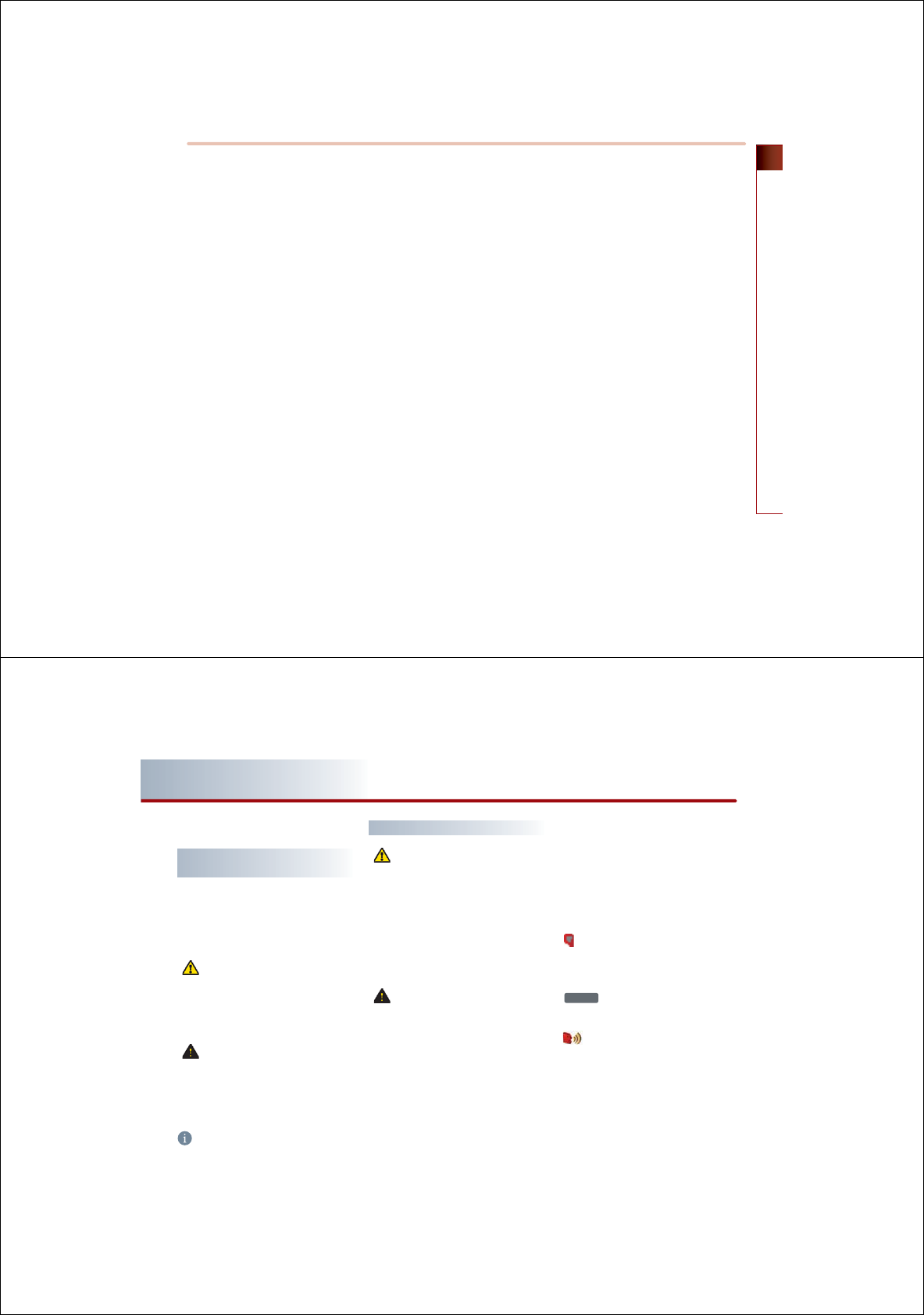
PRE-OVERVIEW 1-1
PRE-OVERVIEW
PART 1 PRE-OVERVIEW
PART 1
PRE-OVERVIEW
Introduction
# 䐙䐙䐙䐙䐙䐙䐙䐙 1-2
Important information about this
manual# 㾕㾕㾕㾕㾕㾕㾕㾕㾕㾕㾕 #1-2
Precaution for safe usage# 㾕㾕㾕㾕 #1-2
Controller and functions
# 䐙䐙䐙 1-3
Control panel#㾕㾕㾕㾕㾕㾕㾕㾕㾕 #1-3
Steering wheel remote controller#㾕 #1-6
Basic operation and setting
#䐙 䐙 1-7
Turning the power ON# 㾕㾕㾕㾕㾕 #1-7
Turning the power OFF#㾕㾕㾕㾕㾕 #1-7
Turning the audio ON/OFF#㾕㾕㾕㾕 #1-7
Adjusting audio volume#㾕㾕㾕㾕㾕 #1-8
How to operate the screen menu#㾕 #1-8
Operating typical screen menu#㾕 #1-8
Inputting letters by using screen
keyboard#㾕㾕㾕㾕㾕㾕㾕㾕㾕㾕 #1-8
Displaying the list# 㾕㾕㾕㾕㾕㾕 #1-9
Selecting an item in a list# 㾕㾕㾕 #1-9
Sorting items from the list#㾕㾕㾕 #1-9
How to operate a menu by
voice command#㾕㾕㾕㾕㾕㾕㾕㾕 #1-10
Condition for voice recognition
system#㾕㾕㾕㾕㾕㾕㾕㾕㾕㾕㾕 #1-10
Giving voice command# 㾕㾕㾕㾕 #1-10
Audio sound setting# 㾕㾕㾕㾕㾕㾕 #1-11
FAD/BAL#㾕㾕㾕㾕㾕㾕㾕㾕㾕㾕 #1-11
BASS/MID/TREB#㾕㾕㾕㾕㾕㾕㾕 #1-11
Auto volume control ON/OFF#㾕#1-11
Touch screen beep ON/OFF#㾕㾕#1-11
Display setting# 㾕㾕㾕㾕㾕㾕㾕㾕 #1-12
Display mode#㾕㾕㾕㾕㾕㾕㾕㾕 #1-12
Brightness# 㾕㾕㾕㾕㾕㾕㾕㾕㾕 #1-12
Display OFF#㾕㾕㾕㾕㾕㾕㾕㾕㾕 #1-12
Display ON#㾕㾕㾕㾕㾕㾕㾕㾕㾕 #1-12
Setting Picture Frame#㾕㾕㾕㾕㾕㾕 #1-13
Display Picture Frame#㾕㾕㾕㾕㾕 #1-13
Viewing Current Time#㾕㾕㾕㾕㾕㾕 #1-14
Setting the Clock# 㾕㾕㾕㾕㾕㾕㾕 #1-14
1-2 PRE-OVERVIEW
PART 1 PRE-OVERVIEW
Introduction
Important information about this
manual
This user manual contains instructions related
to safety. Closely observe and comply with all
of the safety instructions found within this
manual.
WARNING !
Disobeying the warnings listed within this
user's manual may cause fatal or serious
injuries. Warnings indicate matters which may
directly lead to accidents.
CAUTION!
Disobeying the cautions listed within this user
manual may lead to accidents or cause injury.
Cautions indicate matters which may lead to
vehicle damage or malfunction.
INFORMATION
Information which the user must be aware or
allows for more convenient use of the device.
Precaution for safe usage
WARNING !
●
Do not operate the Audio/Video Navigation
system while driving.
●
Do not disassemble, assemble, or modify
the Audio/Video Navigation system.
●
Do not watch the screen for prolonged
periods of time while driving.
●
Set the volume to a level which allows the
driver to be aware of external conditions.
CAUTION!
●
Do not operate the Audio/Video Navigation
system for prolonged periods of time with
the vehicle ignition in ACC. Such operations
may lead to battery discharge.
●
Be cautious not to spill water or introduce
foreign objects into the device.
●
Do not cause severe shock to the device.
Direct pressure onto the front side of the
monitor may cause damage to the LCD or
touch panel.
In case of product malfunction, please
contact your place of purchase or service
center.
●
When cleaning the touch screen, make sure
to turn off the device and use a dry and
smooth cloth. Never use tough materials,
chemical cloths, or solvents (alcohol, ammo-
nia, benzene, thinners, etc.) as such mate-
rials may damage the device panel or cause
color and quality deterioration.
Page de référence
This indicates the title and page that you
should refer to.
This indicates a button on the control panel.
Voice Command
This indicates an operation by voice com-
mand.
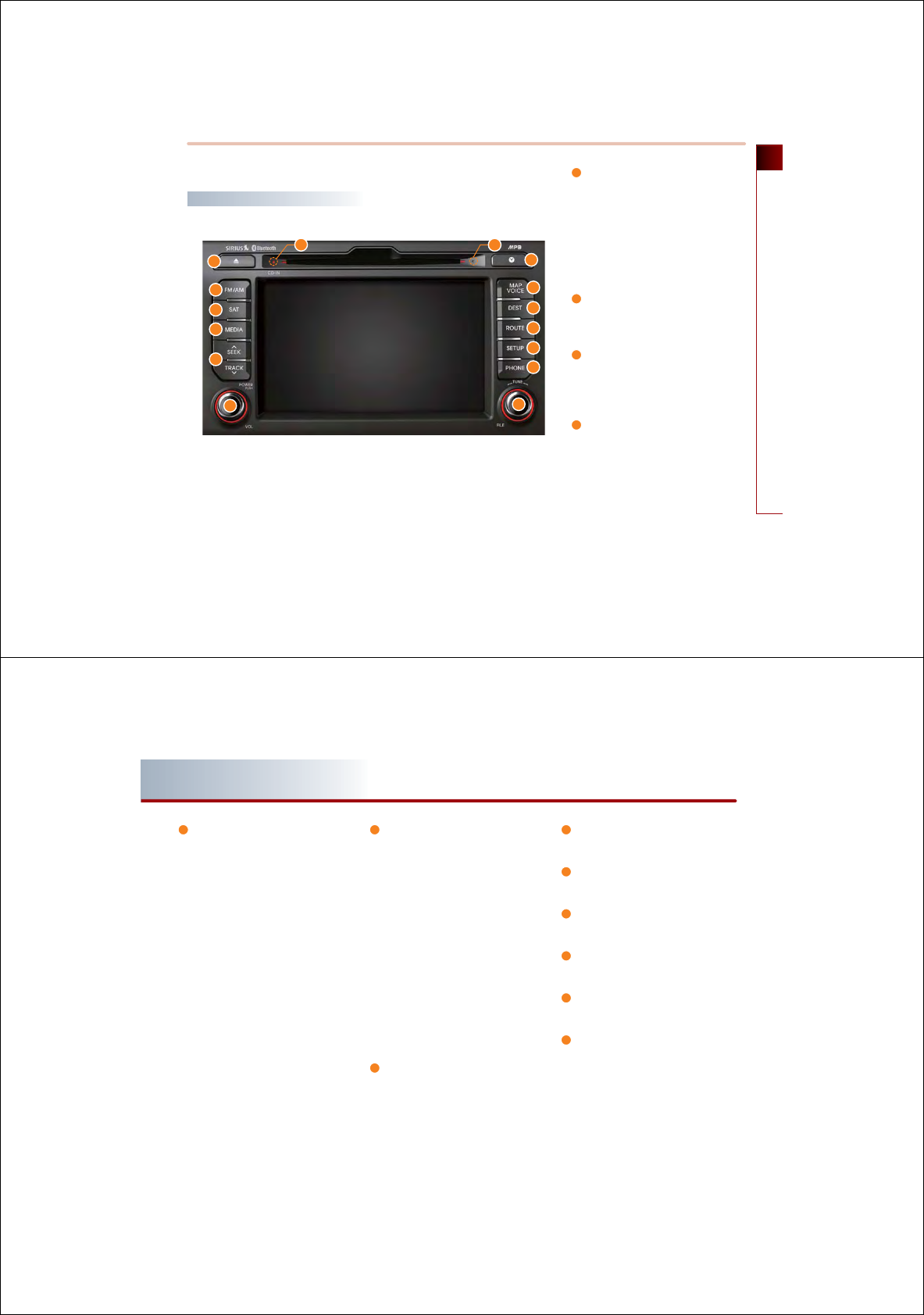
PRE-OVERVIEW 1-3
PRE-OVERVIEW
Controller and functions
Control panel
Power / Volume control
•
Push knob (over 0.8 second) : Turns the
power off.
•
Push knob (under 0.8 second) : Each time
the knob is pressed, the Audio is turned
on and off.
• Tune knob : The range of volume adjust-
ment is between 0 ~ 35.
FM/AM
Each press will change the bands in the fol-
lowing order: FM1
ĺ
FM2
ĺ
AM
ĺ
FM1
SAT
Each press will change the bands in the fol-
lowing order : SIRIUS1
ĺ
SIRIUS2
ĺ
SIRIUS3
ĺ
SIRIUS1
MEDIA
Each press will change the bands in the fol-
lowing order : DISC(CD, MP3)
ĺ
(USB or iPod)
ĺ
(AUX)
ĺ
DISC(CD, MP3)
48 47
5:
;
<
43
44
9
6
7
8
4
46
45
1-4 PRE-OVERVIEW
PART 1 PRE-OVERVIEW
SEEK/TRACK Up/Down
●
SHORT KEY(less than 0.8 second)
• FM/AM Mode : Automatically searches for
the previous or next broadcast frequency
and starts playing.
• SAT Mode : Receives the previous or next
channel.
• CD Mode : Plays the previous or next track.
• MP3, USB Mode : Plays the previous or next
file.
• iPod Mode : Plays the previous or next
song.
●
LONG KEY(over 0.8 second)
• FM/AM Mode : Quickly moves through the
frequencies while the button is pressed.
Once released, automatically searches for
broadcasts which can be received.
• SAT Mode : Quickly moves to the previous
or next channel.
• CD Mode : REW/FF the current playing
track.
• MP3, USB Mode : REW/FF the current
playing file.
• iPod Mode : REW/FF the current playing
song.
TUNE
• FM/AM Mode : Turn the knob to search for
the desired frequency. Press the knob to
receive the selected frequency.
• SAT Mode : Turn the knob to search for the
desired channel. Press the knob to receive
the selected channel.
• CD Mode : Turn the knob to search for the
desired track. Press the knob to play the
selected track.
• MP3, USB Mode : Turn the knob to search
for the desired file. Press the knob to play
the selected file.
• iPod Mode : Turn the knob to search for the
desired song. Press the knob to play the
selected song.
MAP VOICE
Displays the map screen for the current posi-
tion.
DEST
Displays the Destination menu screen.
ROUTE
Displays the Route menu screen.
SETUP
Displays the Setup menu screen.
PHONE button
Displays the Bluetooth handsfree screen.
DISC Eject button
Eject the inserted disc.
Clock
●
Short Key (under 0.8 second)
• When the screen is turned on : displays the
current time in the center of the screen.
• When the screen is turned off : turns the
full clock screen on and off.
●
Long Key (over 0.8 second)
• Displays the clock setting screen.
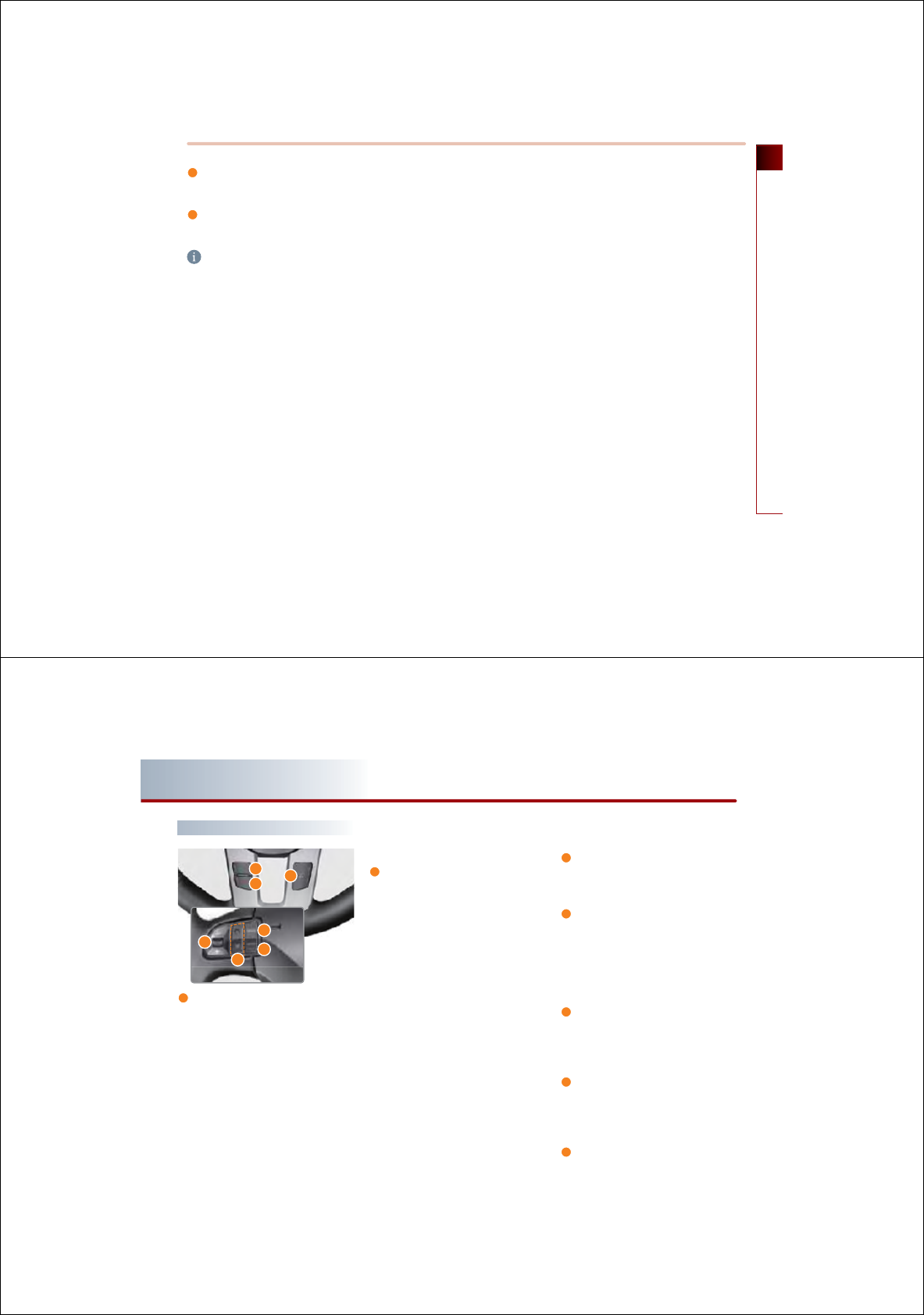
PRE-OVERVIEW 1-5
PRE-OVERVIEW
RESET
Resets the system - if software locks-up.
DISC insert indicator LED
Displays that a DISC has been inserted.
INFORMATION
If pressing the power off knob for over 0.8
second and the system does not shut down,
and carefully use insert a straightened paper
clip at the access hole shown next to the right
DISC indicator LED to reset the software.
The system power will shut-off and restart.
1-6 PRE-OVERVIEW
PART 1 PRE-OVERVIEW
Steering wheel remote controller
Mode
Each time the mode button is pressed, the
mode will convert in the following order:
FM1
ĺ
FM2
ĺ
AM
ĺ
SIRIUS1
ĺ
SIRIUS2
ĺ
SIRIUS3
ĺ
(DISC)
ĺ
(USB or iPod)
ĺ
(AUX)
ĺ
(Phone Music)
ĺ
(FM1).
If a not supported DISC has been inserted or
if the corresponding unit has not been
connected, the mode will not be recognized
and automatically switch to the next mode.
●
Press this button for over 0.8 second to turn
the Audio ON and OFF.
●
Press this button when the Power is turned
off to turn the power on.
Seek Up/ Down
●
SHORT KEY(less than 0.8 second)
• FM/AM : Receives the previous or next pre-
set frequency.
• SIRIUS Mode : Receives the previous or
next preset channel.
• CD Mode : Plays the previous or next track.
• MP3, USB Mode : Plays the previous or next
file.
• iPod Mode : Plays the previous or next
song.
●
LONG KEY(Over 0.8 second)
• FM/AM Mode : Quickly moves through the
frequencies while the button is pressed.
Once released, it automatically searches
for broadcasts which can be received.
• SIRIUS Mode : Quickly moves to the pre-
vious or next channel.
• CD Mode : REW/FF the current playing
track.
• MP3, USB Mode : REW/FF the current
playing file.
• iPod Mode : REW/FF the current playing song.
Volume Up/Down
Increases or decreases the speaker volume
within a range between 0 ~ 35.
MUTE
Turns the sound on and off. When the MUTE is
turned on, the MUTE icon will become dis-
played. When in the Navigation screen, the
MUTE icon at the top of the screen will disap-
pear after 3seconds.
CALL
Press this key to receive an incoming call. If
pressed while in AV/Navigation mode, the
Bluetooth handsfree screen will be displayed.
END
Press this key to reject an incoming call.
If pressed while on a call, then the call will be
ended.
Voice Recognition button
Starts Voice Recognition.
4
8
9:
7
5
6
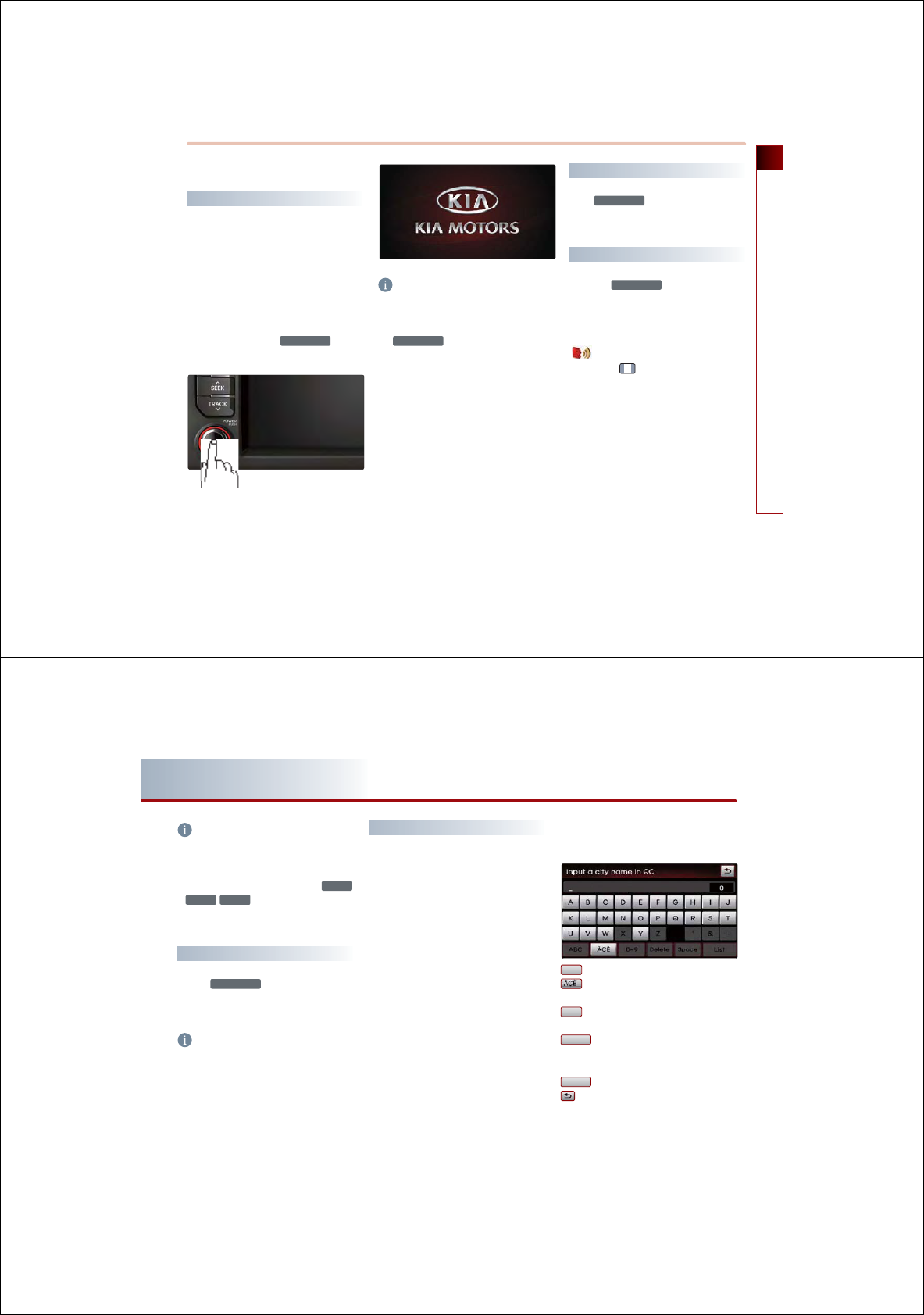
PRE-OVERVIEW 1-7
PRE-OVERVIEW
Basic operation and setting
Turning the power ON
1. Turn the ignition key onto ACC or ON. If the
system power had been on when the igni-
tion was turned off, the system will turn
back on automatically.
2. If the system power had been off when the
ignition was turned off, the system will
remain off.
In this case, press the
32:(592/
knob to
turn on the system power.
INFORMATION
As system booting starts from the point the
door lock is unlocked, the device may com-
plete booting before the ACC is turned on or
the
32:(592/
knob is pressed.
3. Once system booting is complete, the most
recent operated mode will be displayed. For
example, turning on the system will display
FM1 radio mode if the last operated mode
prior to turning off the system had been
FM1 radio mode.
Turning the power OFF
If the
32:(592/
knob is pressed for over
0.8 second, a beep will sound and the system
power will be turned off.
Turning the audio ON/OFF
Press the
32:(592/
#
knob for under 0.8
second with the system power on to turn the
Audio on and off.
Voice Command
1. Press the
key on the steering wheel
remote controller.
2. After the beep sound, say a command.
"Audio On"
"Audio Off"
1-8 PRE-OVERVIEW
PART 1 PRE-OVERVIEW
INFORMATION
Conducting the following operations while
the AUDIO is off will automatically turn on the
Audio system.
●
Pressing the audio related buttons (
)0$0
,
6$7
,
0(',$
).
●
Inserting a DISC or connecting an external
device.
Adjusting audio volume
Turn the
32:(592/
#
knob in clockwise direc-
tion to increase the volume and counter-
clockwise to decrease the volume.
INFORMATION
●
The range of volume adjustment is between
0 ~ 35.
●
Adjustments to the volume cannot be made
while the AUDIO is turned off.
How to operate the screen menu
● If a menu button on the screen is pressed,
the corresponding function will be opera-
ted.
● The same menu button may perform diffe-
rent functions depending on the length of
time the button is pressed (under 0.8
seconds or over 0.8 second).
For more information, refer to the specific
function within this user manual.
● The current operated button will be
highlighted upon display.
● Buttons which cannot be operated under
the current conditions will be displayed in
disabled state. Pressing a disabled button
will not perform any operation.
Inputting letters by using screen
keyboard
$%&
: Displays the English alphabet keypad.
: Displays the French alphabet keypad. (if
available)
: Displays the number and symbol key-
pad.
'HOHWH
#
: Deletes the previous inputted letter.
Pressing for over 0.8 second will delete
all content.
/LVW
: The input is completed.
: Restores to previous screen.
The inputted text will not be saved.
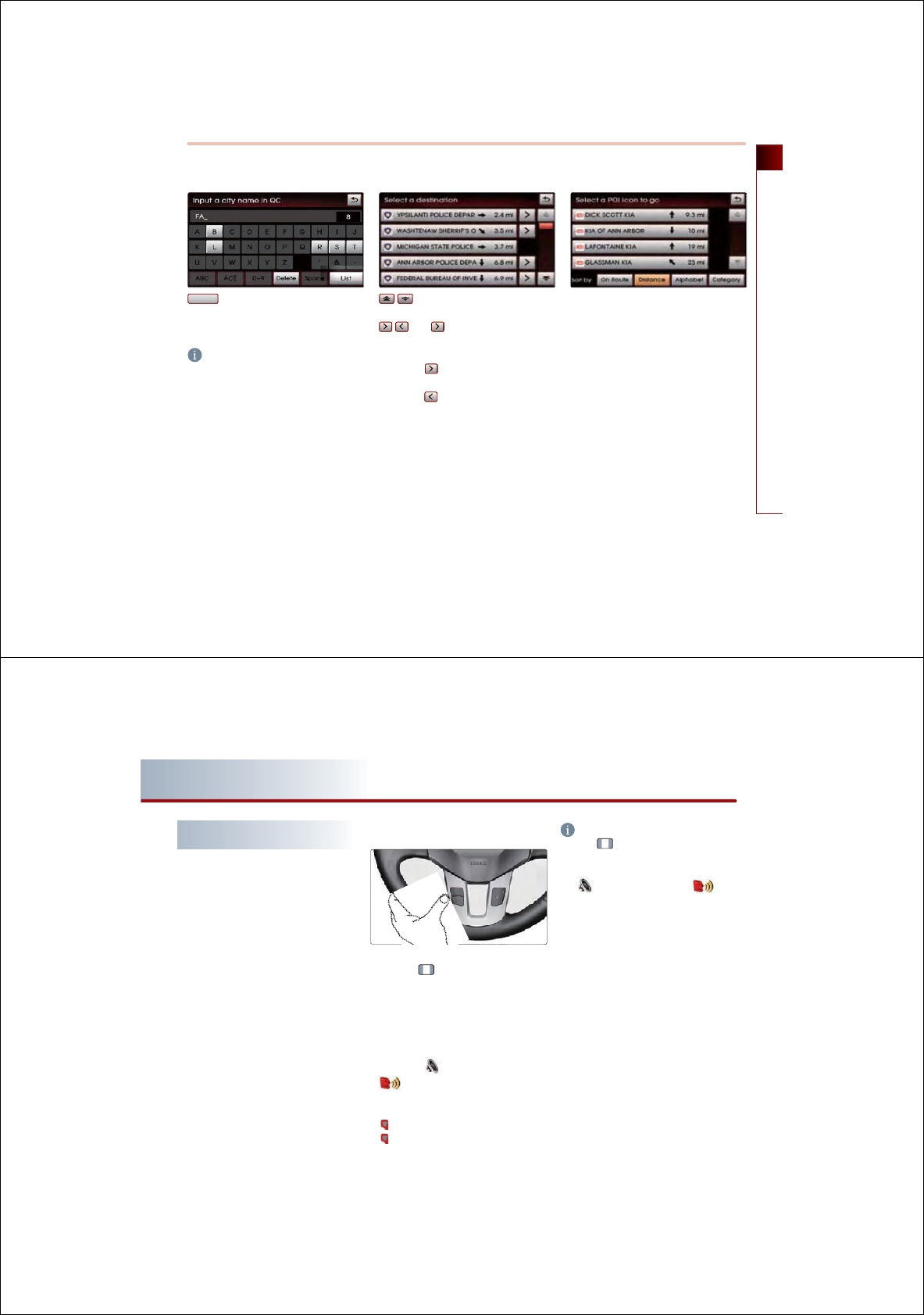
PRE-OVERVIEW 1-9
PRE-OVERVIEW
Displaying the list
㾐㾐㾐㾐
/LVW
: Even if input is not completed, the
current matching items from the data-
base will be displayed.
INFORMATION
The number at the upper-right side of the
screen displays the number of current
matches.
Selecting an item in a list
㾐㾐㾐㾐
# #
: Moves to the next page or previous
page.
#
: The
#
button will be displayed if
the text is too long to be displayed in
one button.
●
Press the button to move the cursor to
the end of the text.
●
Press the
#
button to move the cursor to
the front of the text.
Sorting items from the list
Select the desired sorting method to reorga-
nize the list in accordance to the selected
method.
1-10 PRE-OVERVIEW
PART 1 PRE-OVERVIEW
How to operate menu by voice
command
Condition for voice recognition system
Most of the functions within the AUDIO
and Navigation system can be operated by
voice.
Please follow the instructions below for
optimal voice recognition performance.
㾐㾐
●
Close all windows and sunroof.
The performance of the voice recognition
can be improved in quiet environment.
●
Press the voice recognition button and
say the desired voice command after
the sound of the beep.
●
The microphone is positioned above the
driver so that voice commands can be
said while maintaining a proper posture.
●
Pronounce the voice commands natu-
rally and clearly as if in normal conver-
sation.
Giving voice command
㾐㾐
1. Press the
#
key on the steering wheel
remote controller.
A voice command window will be dis-
played on the lower side of the screen fol-
lowed by a "Command please" voice com-
ment.
2. Once the icon changes into the
icon on the pop-up screen with a
beep sound, say the desired voice com-
mand.
[Voice command list], page 4-6.
[ Searching a destination by voice
command], page 4-20.
INFORMATION
Press the
#
key
shortly to input the desired
voice command. The system voice instruction
comment will immediately terminate. When
the icon changes into the icon
with a beep sound, it is possible to input voice
commands.
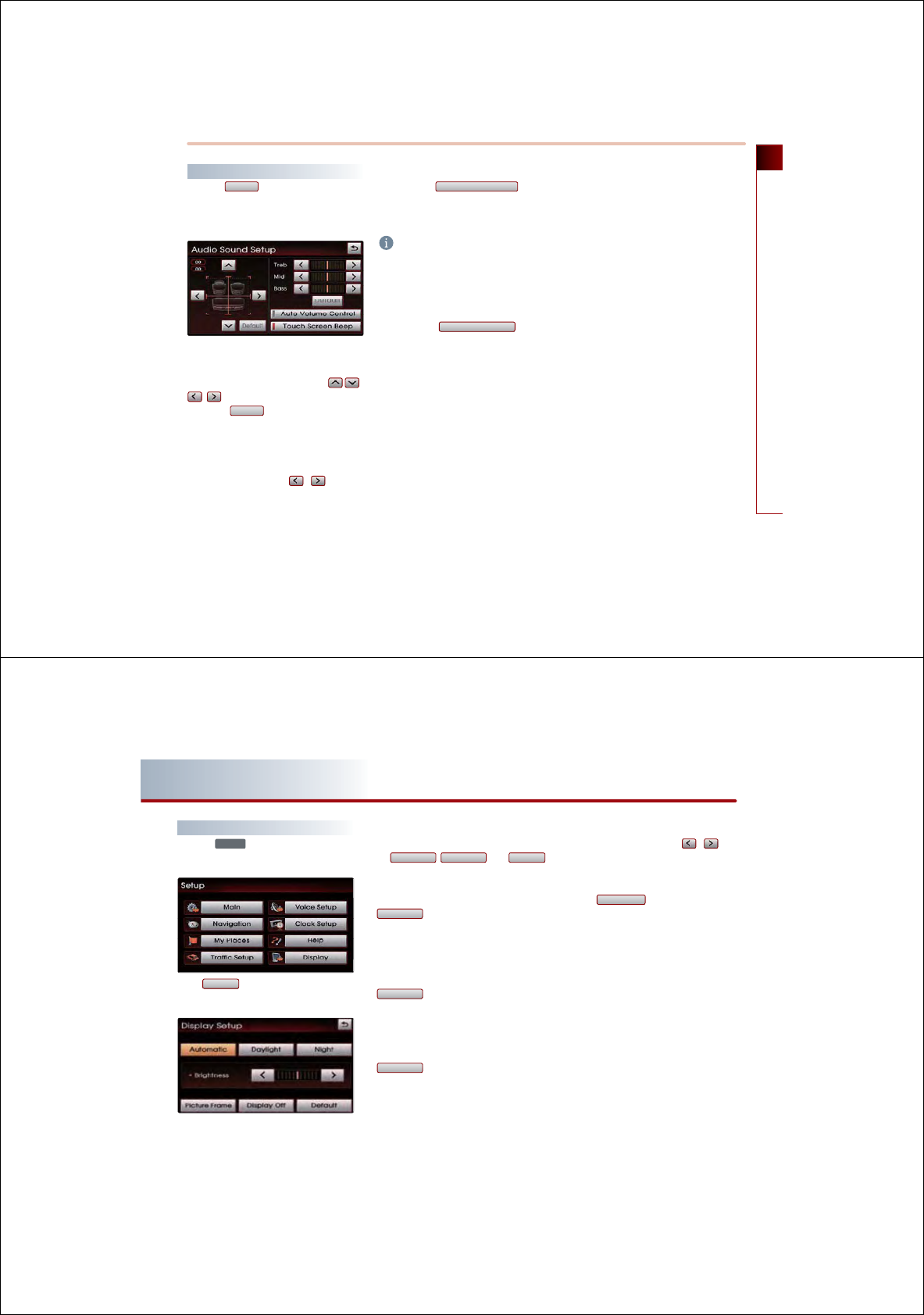
PRE-OVERVIEW 1-11
PRE-OVERVIEW
Audio sound setting
Press the
6RXQG
button on the main screen
of each AV mode (FM/AM, SIRIUS, CD, MP3,
USB, iPod, and AUX) to display the Audio
sound setup screen.
FAD/BAL
The position of the sound can be adjusted by
using the up-down and left-right (
#
,
/#
) buttons on the left side of the screen.
Press the
'HIDXOW
button to position the
sound in the center of the vehicle.
BASS/MID/TREB
The BASS/MID/TREB can be adjusted by using
the left/right buttons (
/#
) of each
control.
Auto volume control ON/OFF
Each time the
$XWRYROXPHFRQWURO
button is
pressed, the Auto volume control function is
turned on or off.
INFORMATION
The Auto volume control is a function which
automatically adjusts the volume level in
accordance to changes in vehicle speed.
Touch screen Beep ON/OFF
Each time the
7RXFKVFUHHQEHHS
button is
pressed, the beeping sound that follows each
press on the screen will turn on or off.
1-12 PRE-OVERVIEW
PART 1 PRE-OVERVIEW
Display setting
Press the
6(783
key on the control panel to
display the Setup menu screen.
Press
'LVSOD\
button to display the Display
Setup screen.
Display mode
Press the button for the desired display mode
from
$XWRPDWLF
,
'D\OLJKW
, and
1LJKW
modes. The current selected mode is highligh-
ted.
●
$XWRPDWLF
The display is automatically converted
between Daylight and Night modes in accor-
dance to the on/off state of the vehicle
taillights.
●
'D\OLJKW
The bright screen is always maintained
regardless of the on/off state of the vehicle
taillights.
●
1LJKW
The dark screen is always maintained
regardless of the on/off state of the vehicle
taillights.
Brightness
Use the left/right buttons (
/#
) for
control to make adjustments.
Display OFF
Press the
'LVSOD\RII
button.
Display ON
Press anywhere on the black screen.
The screen prior to display setting will be dis-
played.
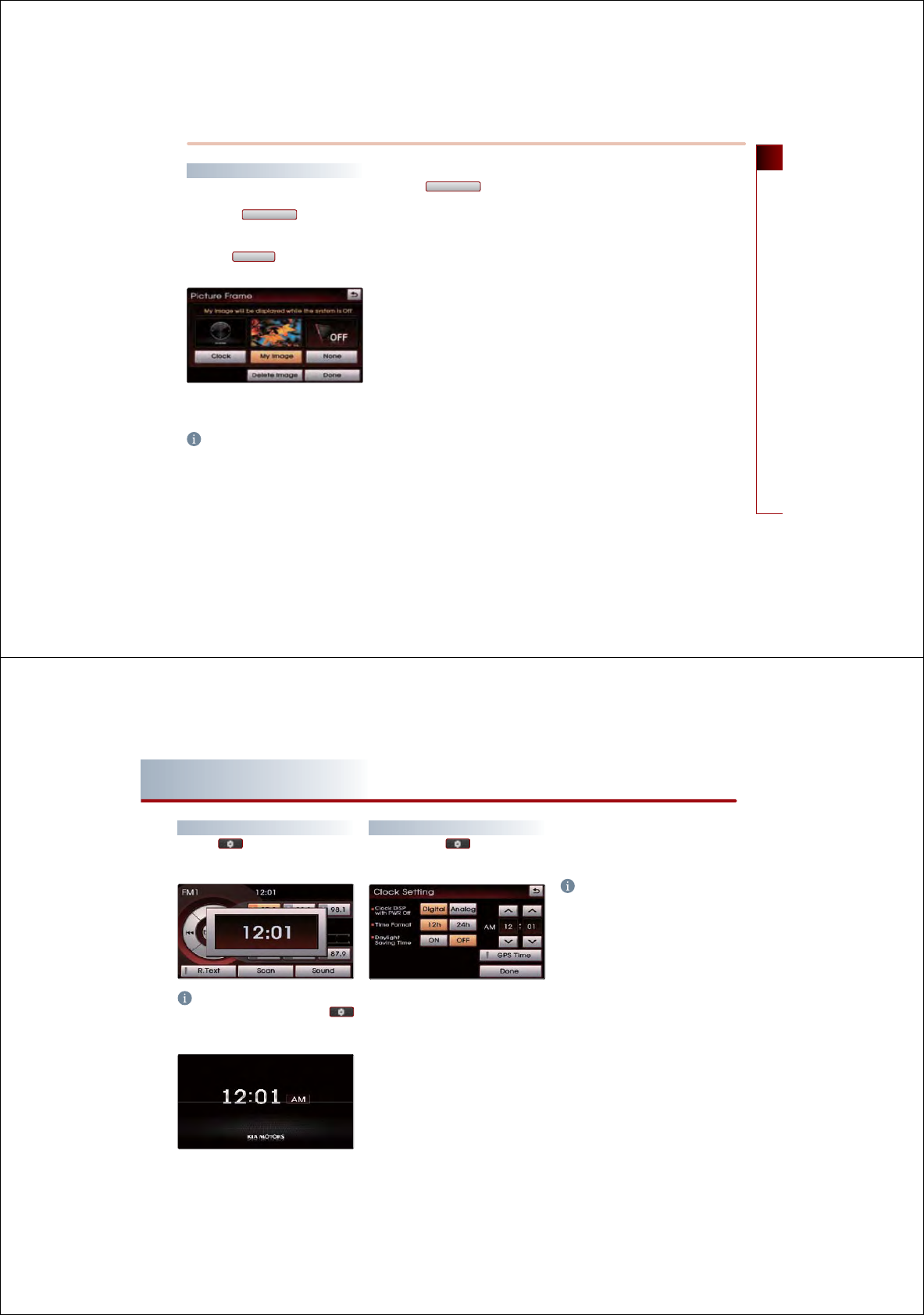
PRE-OVERVIEW 1-13
PRE-OVERVIEW
Setting Picture Frame
Display Picture Frame
1. Press the
3LFWXUH)UDPH
button in the
DISPLAY Setup screen.
2. Press the
0\,PDJH
button in the <Setting
Display off> Setup screen.
3. The registered image will be displayed once
power is turned off.
INFORMATION
For Picture Frame setup, the frame must be
set in USB Image mode. (For details on setting
the Picture Frame, refer to the USB IMAGE
page.)
4. To delete an image registered as a frame,
press the
'HOHWH,PDJH
button.
1-14 PRE-OVERVIEW
PART 1 PRE-OVERVIEW
Viewing Current Time
Press the on the front panel shortly
(under 0.8 second) to display the current time
at the center of the screen.
INFORMATION
If the screen is turned off, selecting the
will display the current time on the entire
screen.
Setting the Clock
Press and hold the on the front panel
(over 0.8 second) to display the Clock setting
screen.
●
GPS Time
The time received from the GPS will be dis-
played automatically.
●
Clock Type
Selects the clock type shown as the entire
screen when the system power is turned off.
●Time Format
When the clock type is digital, this button is
used to convert the time between 12 hour/ 24
hour systems.
●Daylight Saving Time
Turns the Daylight Saving Time function on or
off.
INFORMATION
Clock setting mode can be displayed while
the clock is displayed on the screen even
when the system is turned off.

PRE-OVERVIEW 1-15
PRE-OVERVIEW
PART 2 AUDIO SYSTEM
PART 2
AUDIO SYSTEM
Operating the radio
#䐙䐙䐙䐙䐙 2-2
FM/AM Radio #㾕㾕㾕㾕㾕㾕㾕㾕㾕 #2-2
Listening to the FM/AM radio#㾕 #2-2
FM/AM screen and functions#㾕 㾕 #2-2
Selecting FM/AM broadcast
frequency# 㾕㾕㾕㾕㾕㾕㾕㾕㾕 #2-4
Storing FM/AM presets#㾕㾕㾕㾕 #2-5
Scanning FM/AM broadcast
frequency# 㾕㾕㾕㾕㾕㾕㾕㾕㾕 #2-5
SIRIUS Radio# 㾕㾕㾕㾕㾕㾕㾕㾕㾕 #2-6
Listening to the SIRIUS radio#㾕㾕 #2-6
SIRIUS screen and functions#㾕㾕 #2-6
Switching the SIRIUS modes
(Channel/Category)# 㾕㾕㾕㾕㾕 #2-7
Selecting SIRIUS broadcast
channel# 㾕㾕㾕㾕㾕㾕㾕㾕㾕㾕 #2-7
Storing SIRIUS presets# 㾕㾕㾕㾕 #2-9
Scanning SIRIUS broadcast channel
##
2-10
Browsing detailed information
about the SIRIUS channel# 㾕㾕㾕 #2-10
Operating the CDP # 䐙䐙䐙䐙 2-11
About CDP#㾕㾕㾕㾕㾕㾕㾕㾕㾕㾕 #2-11
Precautions upon handling discs
#㾕 # 2-11
For safe and efficient operation#㾕 #2-11
Supported disc formats#㾕㾕㾕㾕 #2-12
Disc/Content format compatibility
#㾕 # 2-13
Inserting/Ejecting disc# 㾕㾕㾕㾕㾕 #2-14
CD# 㾕㾕㾕㾕㾕㾕㾕㾕㾕㾕㾕㾕㾕 #2-15
Listening to CD music㾕㾕㾕㾕㾕 #2-15
CD screen and functions# 㾕㾕㾕 #2-15
Selecting the CD track# 㾕㾕㾕㾕 #2-16
REW/FF CD track#㾕㾕㾕㾕㾕㾕㾕 #2-16
Setting Random function for
CD music#㾕㾕㾕㾕㾕㾕㾕㾕㾕㾕 #2-16
Setting Repeat function for
CD music#㾕㾕㾕㾕㾕㾕㾕㾕㾕㾕 #2-17
Scanning CD track#㾕㾕㾕㾕㾕㾕 #2-17
MP3#㾕㾕㾕㾕㾕㾕㾕㾕㾕㾕㾕㾕㾕 #2-18
MP3 disc related information and
precaution #㾕㾕㾕㾕㾕㾕㾕㾕㾕 #2-18
Listening to MP3 music #㾕㾕㾕㾕 #2-19
MP3 screen and functions #㾕㾕㾕 #2-19
Selecting the MP3 file # 㾕㾕㾕㾕 #2-20
REW/FF MP3 file #㾕㾕㾕㾕㾕㾕㾕 #2-21
Browsing detailed information
about the MP3 file#㾕㾕㾕㾕㾕㾕 #2-21
Setting Random function for
MP3 file# 㾕㾕㾕㾕㾕㾕㾕㾕㾕㾕 #2-21
Setting Repeat function for MP3
file# 㾕㾕㾕㾕㾕㾕㾕㾕㾕㾕㾕㾕 2-22
Scanning MP3 file# 㾕㾕㾕㾕㾕㾕 #2-22
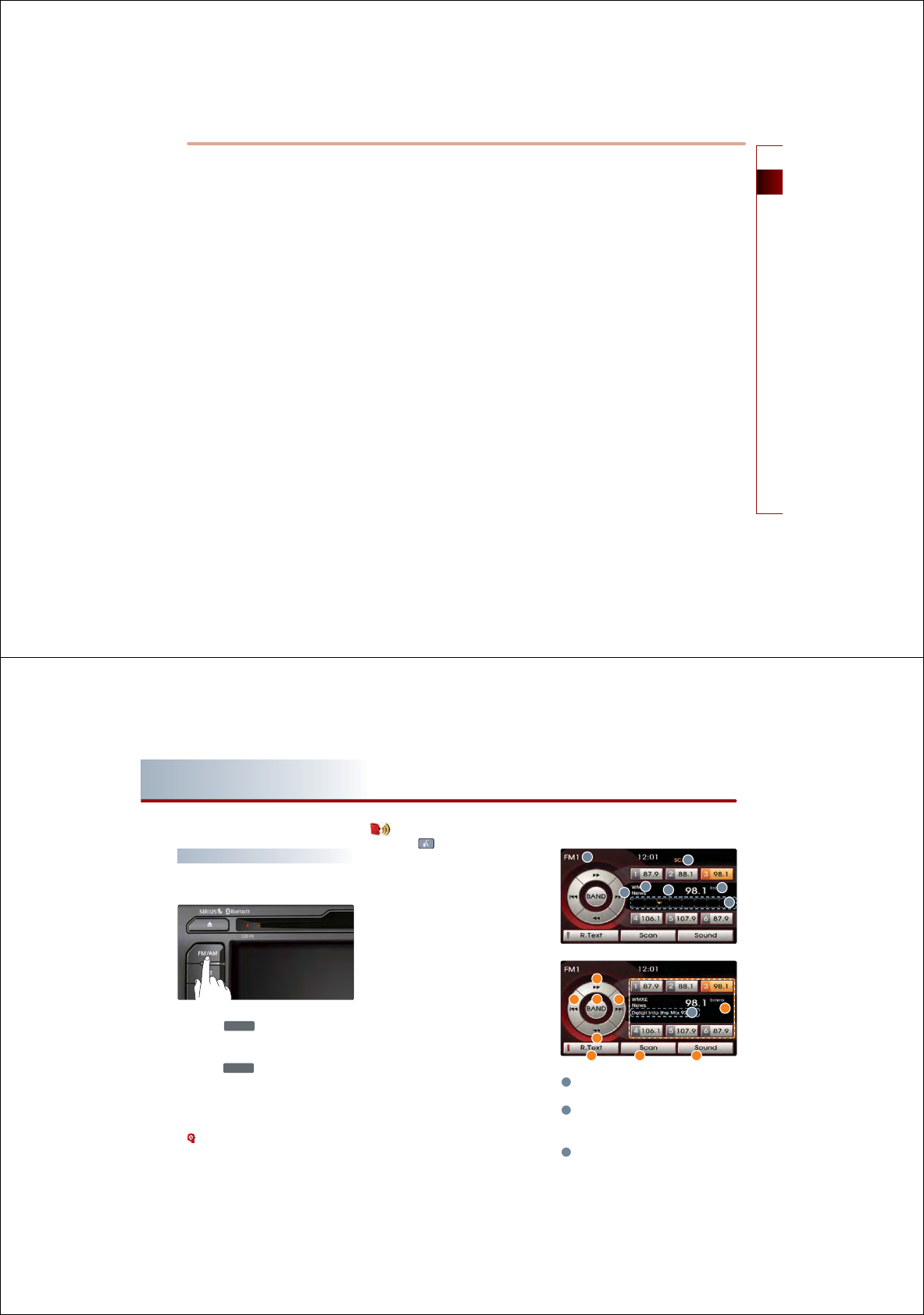
AUDIO SYSTEM 2-1
AUDIO SYSTEM
Operating the external devices
# 2-23
iPod#㾕㾕㾕㾕㾕㾕㾕㾕㾕㾕㾕㾕㾕 #2-23
Connecting iPod devices # 㾕㾕㾕 #2-23
Listening to music from iPod#㾕 㾕 #2-23
iPod screen and functions #㾕㾕㾕 #2-24
Selecting music from iPod#㾕㾕㾕 #2-25
REW/FF iPod music # 㾕㾕㾕㾕㾕 #2-26
Setting Random function for
iPod music #㾕㾕㾕㾕㾕㾕㾕㾕㾕 #2-26
Setting Repeat function for
iPod music #㾕㾕㾕㾕㾕㾕㾕㾕㾕 #2-27
Browsing detailed information
about the iPod music#㾕㾕㾕㾕㾕 #2-27
USB#㾕㾕㾕㾕㾕㾕㾕㾕㾕㾕㾕㾕㾕 #2-28
USB MP3 related information and
precaution #㾕㾕㾕㾕㾕㾕㾕㾕㾕 #2-28
Precautions upon handling USB# #2-28
Connecting the USB devices#㾕㾕 #2-30
Listening to USB music# 㾕㾕㾕㾕 #2-30
Starting USB IMAGE Mode#㾕㾕㾕㾕 #2-31
Starting USB IMAGE Mode#㾕㾕㾕 #2-31
USB IMAGE mode menu screen
configuration#㾕㾕㾕㾕㾕㾕㾕㾕 #2-31
Operating USB IMAGE Mode#㾕㾕 #2-32
AUX#㾕㾕㾕㾕㾕㾕㾕㾕㾕㾕㾕㾕㾕 #2-31
Connecting AUX#㾕㾕㾕㾕㾕㾕㾕 #2-31
Playing AUX# 㾕㾕㾕㾕㾕㾕㾕㾕 #2-31
AUX screen#㾕㾕㾕㾕㾕㾕㾕㾕㾕 #2-32
PART 2
AUDIO SYSTEM
2-2 AUDIO SYSTEM
PART 2 AUDIO SYSTEM
Operating the radio
FM/AM Radio
Listening to the FM/AM radio
1. Press the
)0$0
key on the control panel.
The FM/AM radio band of the most recent
listened station will be displayed.
2. Press the
)0$0
key to change the desired
radio band. Each press will change the
bands in the following order: FM1
ĺ
FM2
ĺ
AM
ĺ
FM1
3. Select the desired broadcast frequency.
[Selecting FM/AM broadcast frequency],
page 2-5.
Voice Command
1. Press the
#
key on the steering wheel
remote controller.
2. After the beep sound, say a command.
" Radio"
"(Radio) AM"
"(Radio) FM"
"FM <1 or 2>"
"AM Frequency <530 to 1710>"
"FM Frequency <87.5 to 107.9>"
"AM Preset <1 to 6>"
"FM <1 or 2> Preset <1 to 6>"
FM/AM screen and functions
Mode display : Displays the FM1/FM2/ AM
modes.
SEEK/SCAN/PRESET SCAN : If SEEK/SCAN /
PRESET SCAN is operating, the switch is
displayed.
Frequency : Displays the current playing
frequency.
I
D
E
JK L
GH
F
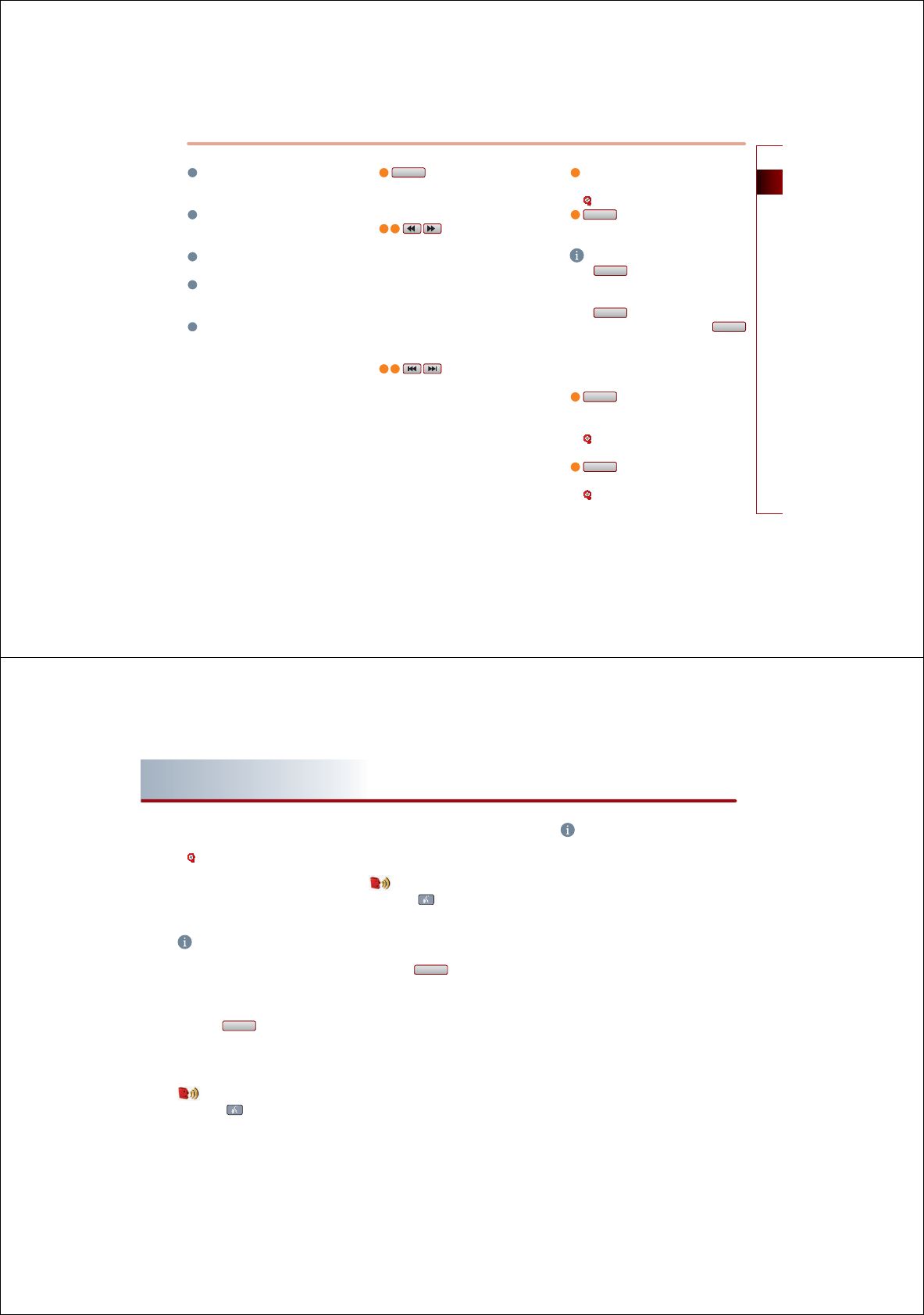
AUDIO SYSTEM 2-3
Operating the radio
STEREO indicator : If the current frequency
is a stereo broadcast, the indicator is dis-
played.
Program Service name: Displays the pro-
gram service name if data is being broad-
casted.
Program Type name: Displays the program
type name if data is being broadcasted.
Frequency bar : Displays the position of
the current frequency within the total fre-
quency range.
Radio Text: Displays the radio text informa-
tion if data is being broadcasted.
D
%$1'
button : Changes the desired
radio band. Each press will change the
bands in the following order: FM1
ĺ
FM2
ĺ
FM1
EF TUNE Up/Down button
●
SHORT KEY(less than 0.8 second)
• The frequency is increased or decreased by
1-step increments (FM : 0.2MHz, AM :
10kHz).
●
LONG KEY(over 0.8 second)
• The frequency is rapidly increased or
decreased by 1-step increments (FM :
0.2MHz, AM : 10kHz) and stops operation
upon KEY RELEASE.
GH SEEK Up/Down button
●
SHORT KEY(less than 0.8 second)
• Automatically searches for the previous or
next broadcast frequency and starts
playing.
●
LONG KEY(over 0.8 second)
• Quickly moves through the frequencies
while the button is pressed. Once released,
it automatically searches for broadcasts
which can be received.
I Preset buttons : The desired frequency can
be preset and selected.
[Storing FM/AM presets], page 2-5.
J
57H[W
button : Turns the Radio Text
information on and off.
INFORMATION
If the
57H[W
is on OFF state, text will not be
displayed even if there is text being transmit-
ted from the broadcast station.
If the
57H[W
is on ON state, the frequency
bar will not be displayed. Even if the
57H[W
is on ON state, text may not be displayed if
text is not being received from the broadcast
station.
K
6FDQ
button : Scans all frequencies or
just the preset frequencies for 5 seconds
each.
[Scanning FM/AM broadcast frequency],
page 2-5.
L
6RXQG
button : Adjusts the FAD/BAL,
BASS/MID/TREB controls.
[Audio sound setting], page 1-11.
2-4 AUDIO SYSTEM
PART 2 AUDIO SYSTEM
Storing FM/AM presets
1. Select the desired frequency.
[Selecting FM/AM broadcast frequency],
page 2-4.
2. Press the preset button to store for over 0.8
second. The frequency will become stored
along with a beep sound.
INFORMATION
Six preset frequencies each for FM1/FM2/AM
modes can be stored using the above instruc-
tions.
Scanning FM/AM broadcast frequency
1. Press the
6FDQ
button.
● SCAN (less than 0.8 second) : Scans all fre-
quencies and plays only frequencies with
superior reception for 5 seconds each.
Voice Command
1. Press the
#
key on the steering wheel
remote controller.
2. After the beep sound, say a command.
"Scan"
● PRESET SCAN (over 0.8 second): Scans the 6
frequencies stored as preset frequencies in
the current band for 5 seconds each.
Voice Command
1. Press the
#
key on the steering wheel
remote controller.
2. After the beep sound, say a command.
"Preset Scan"
2. Press the
6FDQ
button again to continue
listening to a frequency. The scan will be
terminated and the current frequency will
continue to be played.
INFORMATION
When scanning has completed an entire revo-
lution, the scan function will be terminated
automatically and the previous played frequen-
cy will be restored.
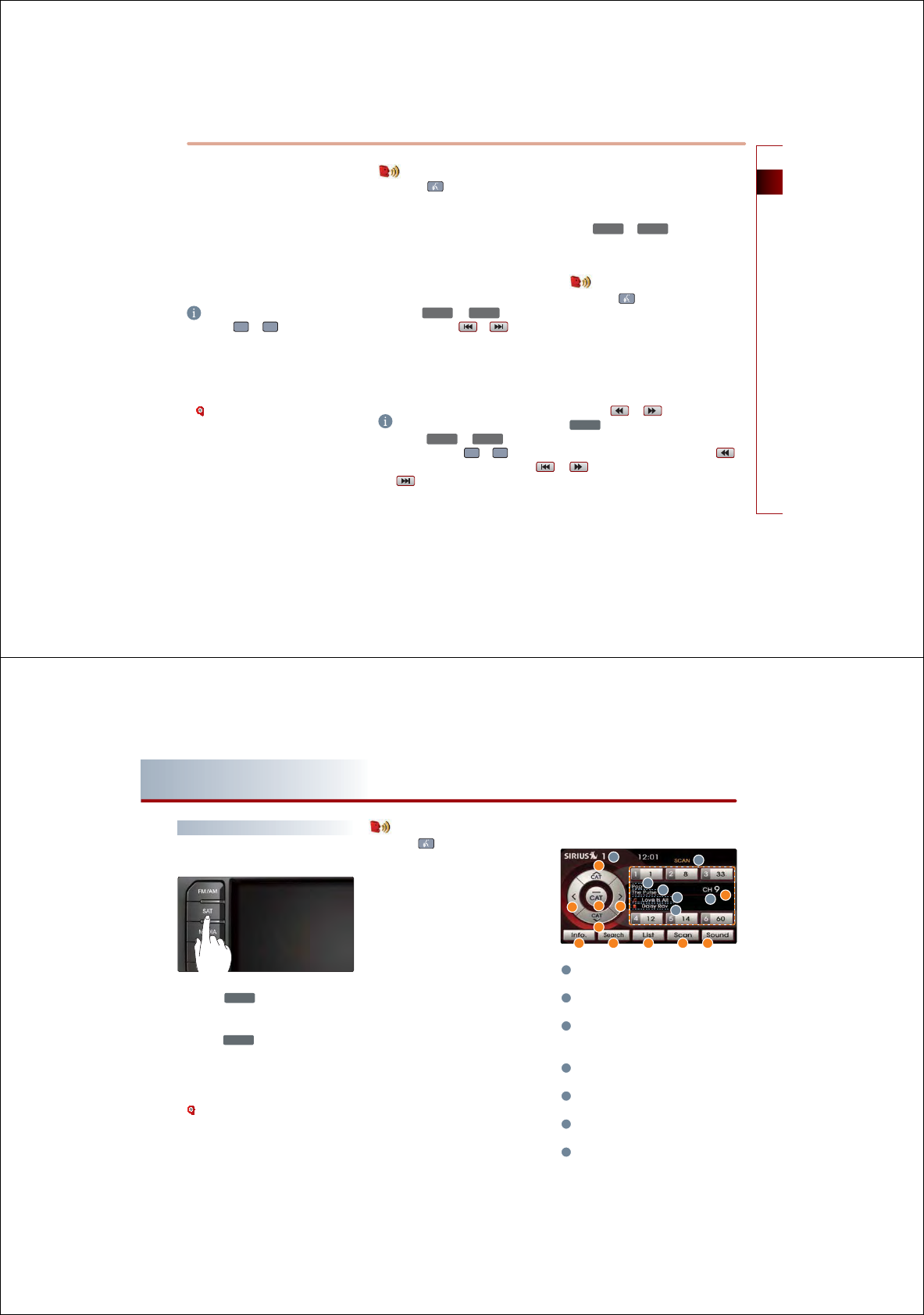
AUDIO SYSTEM 2-5
Operating the radio
Selecting FM/AM broadcast frequency
There are 3 ways to select the broadcast
frequency - (a) selecting through presets,
(b) selecting through SEEK, (c) selecting
through manual search.
(a) Selecting a frequency through presets
Press the preset button of the desired
broadcast frequency.
INFORMATION
●
Press the
A
or
keys for a short time
on the steering wheel remote controller.
The preset frequencies of the current band
will be selected in order.
●
There are 6 different preset frequencies
each for FM1, FM2, and AM modes.
[Storing FM/AM preset], page 2-5.
Voice Command
1. Press the
#
key on the steering wheel
remote controller.
2. After the beep sound, say a command.
"Preset <1 to 6>"
"Preset Up"
"Preset Down"
(b) Selecting a Broadcast frequency through
SEEK
Press the
6((.
A
or
75$&.
keys on the
control panel or the or buttons on
FM1, FM2, and AM mode screens for less than
0.8 second. Once the SEEK function is opera-
ting (SEEK indicator blinking), the next or pre-
vious broadcast frequency with superior
reception will be searched automatically.
INFORMATION
●
Press the
6((.
A
or
75$&.
keys on the
control panel or the
A
or
keys on the
steering wheel remote controller or the
or buttons on FM1, FM2, and AM mode
screens for more than 0.8 second to quickly
move to the nearest desired frequency. Once
the button is released, the next frequency
with superior reception will be searched
automatically.
●
While the SEEK function is operating, pressing
the
6((.
A
or
75$&.
keys on the control
panel again will terminate SEEK operation
and select the current frequency.
Voice Command
1. Press the
#
key on the steering wheel
remote controller.
2. After the beep sound, say a command.
"Seek Up"
"Seek Down"
(c) Selecting a broadcast frequency through
manual search
Press the or buttons or turn the
781(
knob on the control panel in
clockwise or counter-clockwise direction.
Each click on the tune knob or the or
buttons will increase or decrease the fre-
quency by 1 step (FM: 0.2 MHz, AM: 10 kHz).
2-6 AUDIO SYSTEM
PART 2 AUDIO SYSTEM
SIRIUS radio
Listening to the SIRIUS radio
1. Press the
6$7
key on the control panel.
The Sirius radio band screen of the most
recent listened station will be displayed.
2. Press the
6$7
key to change the desired
radio band. Each press will change the
bands in the following order: SIRIUS1
ĺ
SIRIUS2
ĺ
SIRIUS3
ĺ
SIRIUS1
3. Select the desired broadcast channel.
[Selecting SIRIUS broadcast channel],
page 2-7.
Voice Command
1. Press the
#
key on the steering wheel
remote controller.
2. After the beep sound, say a command.
"SIRIUS"
"SIRIUS <1 or 2 or 3>"
"SIRIUS Channel <0 to 223>"
"SIRIUS <1 or 2 or 3> Preset <1 to 6>"
SIRIUS screen and functions
Mode display: Displays the SIRIUS1/
SIRIUS2/SIRIUS 3 modes.
Channel number: Displays the current
playing channel.
SCAN/PRESET SCAN indicator: If SCAN/
PRESET SCAN is operating, the switch is
displayed.
Category name: Displays the category
name.
Channel name: Displays the channel
name.
Song/Program title: Display the song or
program title.
Artist name: Displays the artist or other
related information.
D
E
F
G
I
K
JL M N
H
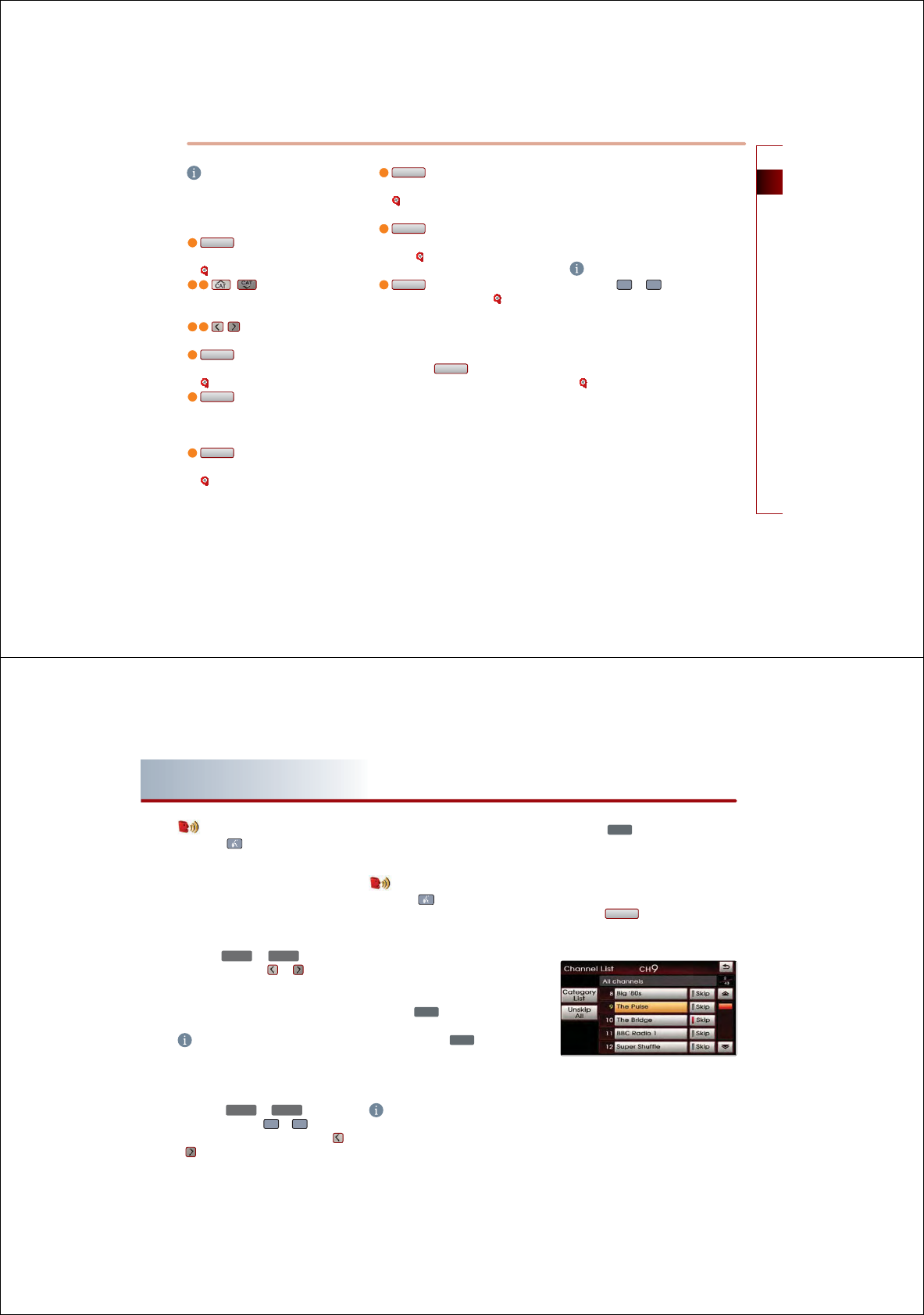
AUDIO SYSTEM 2-7
Operating the radio
INFORMATION
The Song title display may be delayed in
accordance to the reception quality of the
Sirius broadcast.
D
&$7
button : Switches between chan-
nel mode and category mode.
[Switching the SIRIUS modes], page 2-7.
E F , : Moves to the next or pre-
vious category, and automatically plays the
first channel within the selected category.
G H, : Moves to the next or previous
channel.
I
3UHVHW
buttons : The desired channel
can be preset and selected.
[Storing SIRIUS presets], page 2-9.
J
,QIR
button : Displays the Title, Artist,
Composer, and other information for the
current received channel if the informa-
tion exists.
K
6HDUFK
button: Selects the channel by
directly inputting the channel number.
[Selecting SIRIUS broadcast channel],
page 2-7.
L
/LVW
button: Displays the channel or
category list.
[Selecting SIRIUS broadcast channel],
page 2-7.
M
6FDQ
button: Scans all frequencies or
just the preset frequencies for 5 seconds
each. [Scanning SIRIUS broadcast chan-
nel], page 2-10.
N
6RXQG
button : Adjusts the FAD/BAL,
BASS/MID/TREB controls. [Audio sound
setting], page 1-11.
Switching the SIRIUS modes (Channel /
Category)
Each time the
&$7
button is pressed, the
mode will switch between channel mode and
category mode.
Category mode will begin operating when the
orange light is turned ON.
Selecting SIRIUS broadcast channel
There are 5 ways to select a broadcast channel
- (a) selecting through presets, (b) selecting
with channel Up/Down, (c) Selecting a chan-
nel through manual search, (d) selecting
through channel/category list, (e) selecting by
directly inputting the channel number.
(a) Selecting a channel through presets
Press the preset button of the desired chan-
nel.
INFORMATION
●
Press the
A
or
keys on the steering
wheel remote controller for less than 0.8
second.
The preset channels of the current band will
be selected in order.
●
There are 6 preset channels each for
SIRIUS1, SIRIUS2, and SIRIUS3.
[Storing SIRIUS presets], page 2-9.
2-8 AUDIO SYSTEM
PART 2 AUDIO SYSTEM
Voice Command
1. Press the
#
key on the steering wheel
remote controller.
2. After the beep sound, say a command.
"Preset <1 to 6>"
"Preset Up"
"Preset Down"
(b) Selecting with Channel Up/Down
Press the
6((.
A
or
75$&.
keys on the
control panel or the or buttons on
SIRIUS1, SIRIUS2, or SIRIUS3 mode screens for
less than 0.8 second.
The previous or next channel will be selected.
INFORMATION
●
If in Channel mode, the channel is selected
from all channels. If in Category mode, the
previous or next channel of each category is
selected.
●
Press the
6((.
A
or
75$&.
keys on the
control panel or the
A
or
keys on the
steering wheel remote controller or the
or
buttons on SIRIUS1, SIRIUS2, and SIRIUS3
mode screens for more than 0.8 second to
quickly move to the nearest desired channel.
Once the button is released, the current chan-
nel will be selected.
Voice Command
1. Press the
#
key on the steering wheel
remote controller.
2. After the beep sound, say a command.
"Channel Up"
"Channel Down"
(c) Selecting a channel through manual
search
1. Turn the
781(
knob on the control panel
in clockwise or counterclockwise direction.
Each click on the
781(
knob will display
the channel information of the previous or
next channel. The current playing channel
will continue to be played.
INFORMATION
If in Channel mode, the channel is selected
from all channels. If in Category mode, the
first channel of each category is selected.
2. Press the
781(
knob at the desired chan-
nel. The selected channel will begin
playing.
(d) Selecting channel through channel/
category list
1. Press the
/LVW
button.
●
If in channel mode, the Channel list screen
will be displayed.
●
If in category mode, the Category list screen
will be displayed.
Select the desired category button to dis-
play the channel list screen for the corres-
ponding category.
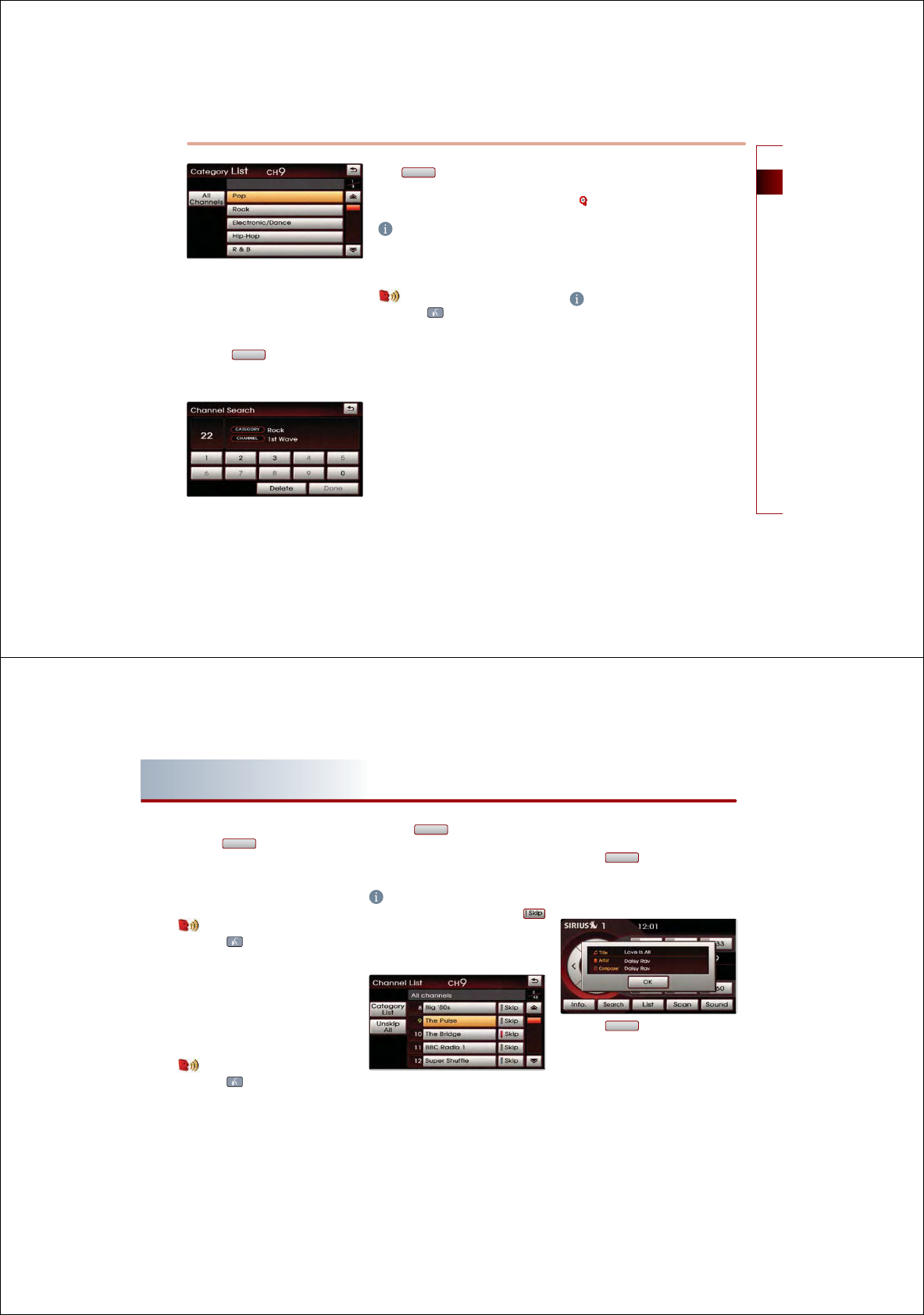
AUDIO SYSTEM 2-9
Operating the radio
2. Select the desired channel button.
The previous screen will be restored and
the selected channel will begin playing.
(e) Selecting channel by directly inputting
the channel number
1. Press the
6HDUFK
button.
The Channel search screen will be dis-
played.
2. Input desired channel number, and press
the
'RQH
button.
The previous screen will be restored and
the selected channel will begin playing.
INFORMATION
To prevent inputting a channel which exceeds
the channel range, numbers which cannot be
inputted are set to disabled state.
Voice Command
1. Press the
#
key on the steering wheel
remote controller.
2. After the beep sound, say a command.
"Channel<0 to 223>"
Storing SIRIUS presets
1. Select the desired channel.
[Selecting SIRIUS broadcast channel],
page 2-7.
2. Press the preset button for over 0.8 second.
The frequency will be saved along with
beep sound.
INFORMATION
Six preset frequencies each for SIRIUS1/
SIRIUS2/ SIRIUS3 modes can be stored using
the above instructions.
2-10 AUDIO SYSTEM
PART 2 AUDIO SYSTEM
Scanning SIRIUS broadcast channel
1. Press the
6FDQ
button.
●
SCAN (under 0.8 second): Scans all channels
for 5 seconds each if in channel mode. If in
category mode, scans all channels within
the current category for 5 seconds each.
Voice Command
1. Press the
#
key on the steering wheel
remote controller.
2. After the beep sound, say a command.
"Scan"
●
PRESET SCAN (over 0.8 second): Scans the 6
preset channels within the current band for
5 seconds each.
Voice Command
1. Press the
#
key on the steering wheel
remote controller.
2. After the beep sound, say a command.
"Preset Scan"
2. Press the
6FDQ
button again to continue
playing the channel.
The scan will be terminated and the current
channel will continue to play.
INFORMATION
●
Within the Channel list screen, if the
button next to each channel name is
pressed, the selected channel will be
excluded from SCAN operation.
●
When scanning has completed an entire
revolution, the scan function is automatical-
ly terminated and the previous played chan-
nel will be restored.
●
Channel 0 is the radio ID and contains infor-
mation required for SIRIUS activation.
Browsing detailed information about the
SIRIUS channel
1. Press the
,QIR
button.
The detailed information (Title, Artist and
Composer) for the current channel will be
displayed.
2. Press the
2.
button.
The detailed information will be turned off.
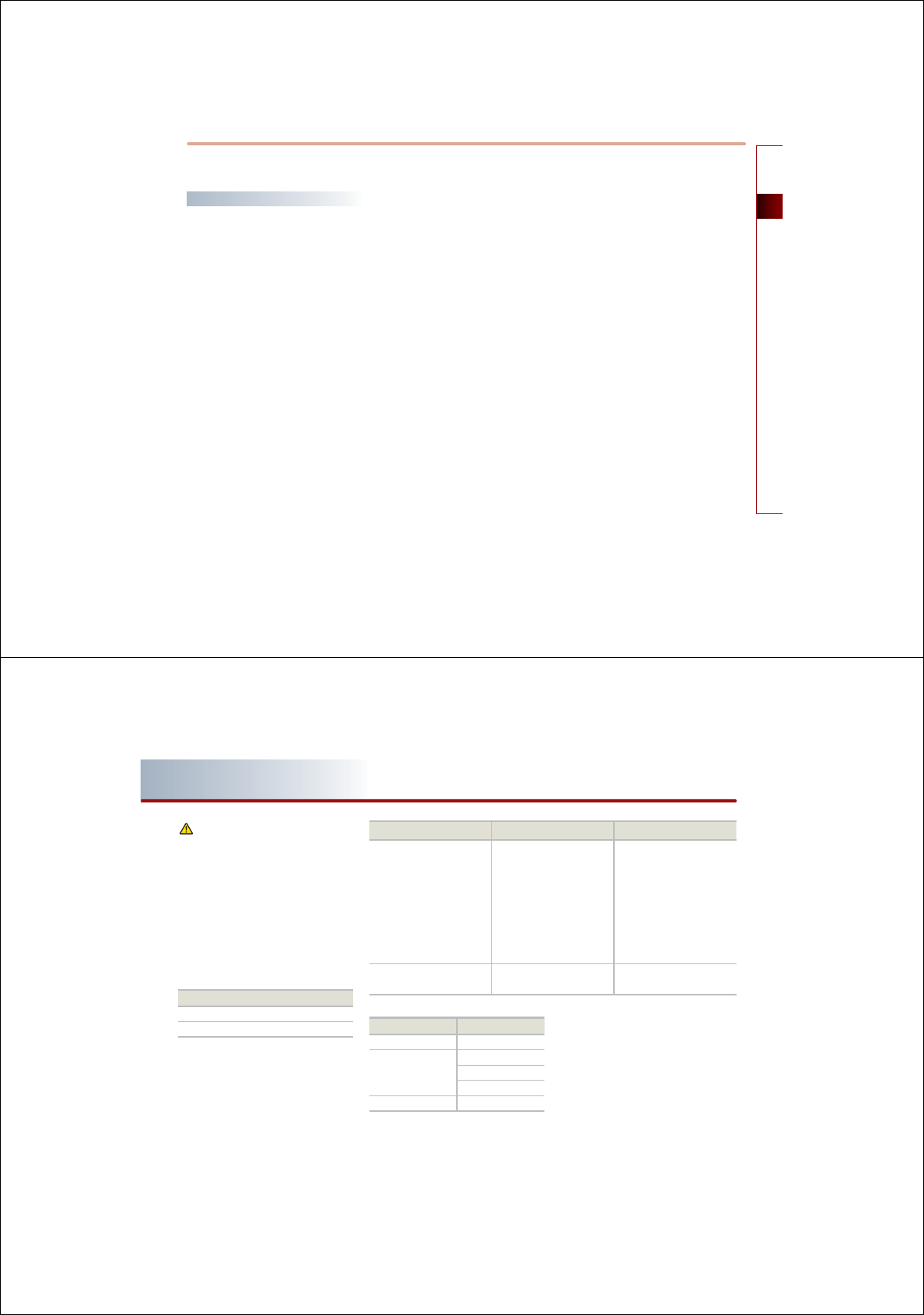
AUDIO SYSTEM 2-11
Operating the CDP
Operating the CDP
About CDP
Precautions upon handling discs
● After using a disc, keep it in the original case
to prevent it from becoming scratched,
which may cause the CD to make popping
sounds.
● Do not use heart-shaped discs, octagon-sha-
ped discs, or any other abnormally shaped
disc. Such discs may be the cause of mal-
functions.
● Do not clean discs with chemical solutions
such as record sprays, antistatic sprays, antis-
tatic liquids, benzene, or thinners. Such
materials may cause the surface of DISC to
be unrecoverable.
● Do not expose the disc to direct sunlight for
prolonged periods of time. Such exposure
may lead to disc deformation.
● Dust, scratch, and other substances may
cause popping sound while playing as well
as sound deterioration.
● Never place paper on either side of the disc
or write on disc surfaces. Sharp writing
utensils and inks used in felt-tip pens may
cause damage to disc surfaces
● Clean fingerprints and dust off the signal
surface (coated side) of the disc with a soft
cloth.
Only soft cloths should be used as there are
no grooves for dust to get in as is the case
with LPs.
● Copy-protected CDs such as S-type CDs
may not function in the device.
● DATA CDs are not supported by the device.
(However, such discs may operate abnor-
mally.)
For safe and efficient operation
● Do not disassemble the CDP for repair
purposes. Contact your place of purchase in
the case of malfunction. (Complete service
assistance will not be provided if the user
disassembles the device.)
● Do not use water to clean the device.
Exposure to water may cause damage to
the device.
● Be cautious not to introduce foreign subs-
tances into the disc insert slot.
Foreign substances may cause damage to
the interior of the device.
● The device may fail to operate properly in
extremely hot or cold temperatures.
Discontinue the use of the device unless
normal temperature is maintained.
( The operational temperature range is:
-10㾸 ~ 65㾸).
● Steam can be condensed on the fiberoptic
lens due to rain, wet conditions, or upon
operating the heating system.
● Skipping may occur to the audio when dri-
ving on bumpy roads for prolonged periods
of time or upon severe shock to the vehicle.
● Do not use chemical solvent to clean the
device. Such solvents may cause damage to
the surfaces of the device.
Always use a clean and dry cloth.
2-12 AUDIO SYSTEM
PART 2 AUDIO SYSTEM
WARNING !
Always give your full attention to driving.
Avoid operating your system in such a way
that you can be distracted driving vehicle
operation.
Supported disc formats
● The disc types supported by this device are
as shown below.
● CD-R or CD-RW DISC burned with a bulk CD
without quality guarantees may not be
recognized by the device.
● Inserting an abnormal disc may result in
faulty operation or recognition.
Disc Size
3-inch (7.6 cm)
5-inch (12.7cm)
Disc format Audio format
CD LPCM
MP3
MPEG1, Layer3
MPEG2, Layer3
MPEG2.5
WMA Ver9
Disc Type Disc Media DIsc Format
CD CD-DA
CD-R MP3
CD-RW WMA
Multisession-CD DTS-CD
CD CD-ROM
CD-G
CD-EXTRA
CD-TEXT
SACD SACD
SACD(Hybrid)

AUDIO SYSTEM 2-13
Operating the CDP
Disc/Content format compatibility
● Ordinary disc compatibility
• This device has been designed/ manufactu-
red to be compatible with software bearing
the following logo marks.
• CD-R/RW discs (Audio CD and MP3 CD)
created with CD-writing devices or perso-
nal computers may not properly function
in the device. This may be caused by
damaged recording method, contamina-
tion by dirt and other foreign substance on
the disc surfaces or play lens, and various
other reasons.
● Special formats or special features regar-
ding software
• CD-R/RW Compatibility.
• This device operates as a CD-ROM including
CD-R and CD-RW DISC written in CD Audio
or MP3 CD Format.
• However, other contents may cause abnor-
mal disc operation such noise.
• The writing of CD-R and CD-RW discs with
this device is not supported.
• Although CD-R/RW discs burned as audio
CDs which have not been finalized are not
supported by the device, some information
such as play time may be displayed.
• PC-created DISC compatibility.
• When recording a disc with a personal com-
puter, even discs recorded in a "format com-
patible" with the formats described above
may not operate on the device caused by
software settings of the recording applica-
tion.
• In such cases, contact the software develo-
per.
• Additional information regarding compati-
bility can be found on the CD-R/ RW
software disc box.
• DVD-R/RW are not supported by the device.
●Compressed audio compatibility
This device plays audio files compressed by
MPEG-1 audio stream layer 3(MP3) using 32,
44.1 and 48kHz fixed bit rates. Incompatible
files are not supported.
• Variable bit rate files may operate, but the
play time information may not be properly
displayed.
• Physical formats of CD : Model 1, Model 2 XA
format 1.
• This device only supports tracks with file
extension of ".MP3" or ".WMA".
• This device does not support multi-session
discs.
• This device supports a maximum of 256 fol-
ders and maximum 512 files.
• Folders and files which exceed this limit will
not be supported.
• There are various bit rates which can be
encoded onto a MP3 file.
• his device has been designed to be compa-
tible with various bit rates.
• Audio which has been encoded at 128kbps
will sound similar to CD audio sound quality.
Audio-CD CD-R CD-RW
2-14 AUDIO SYSTEM
PART 2 AUDIO SYSTEM
Although this device supports low bit rate
MP3 tracks, such tracks may only provide
low quality sound.
• For stable operation, the use of files in
95kbps ~ 192kbps bit rate range and
44.1kHz SAMPLING frequency is recom-
mended.
Inserting/Ejecting Disc
Inserting a Disc
Insert the disc into the slot.
The disc will begin playing automatically after
it has been inserted.
INFORMATION
If the operation mode had been Audio mode
before inserting the disc, the device will
convert to the DISC mode screen and begin
playing.
If the operation mode had been Navigation
mode, then Navigation mode screen will
remain and the disc play status will be dis-
played through the Audio bar.
Ejecting a Disc
Press the key.
The disc will immediately be stopped and
ejected.
INFORMATION
●
If the operation mode had been in Audio
mode before ejecting the disc, the device
will be converted back to Audio mode.
If the operation mode had been in
Navigation mode, then Navigation mode
screen will remain.
●
If the disc is straddled on the slot without
removing for approximately 10 seconds, the
disc will be re-inserted automatically into
the disc player.
In such a case, the disc will not begin
playing automatically.
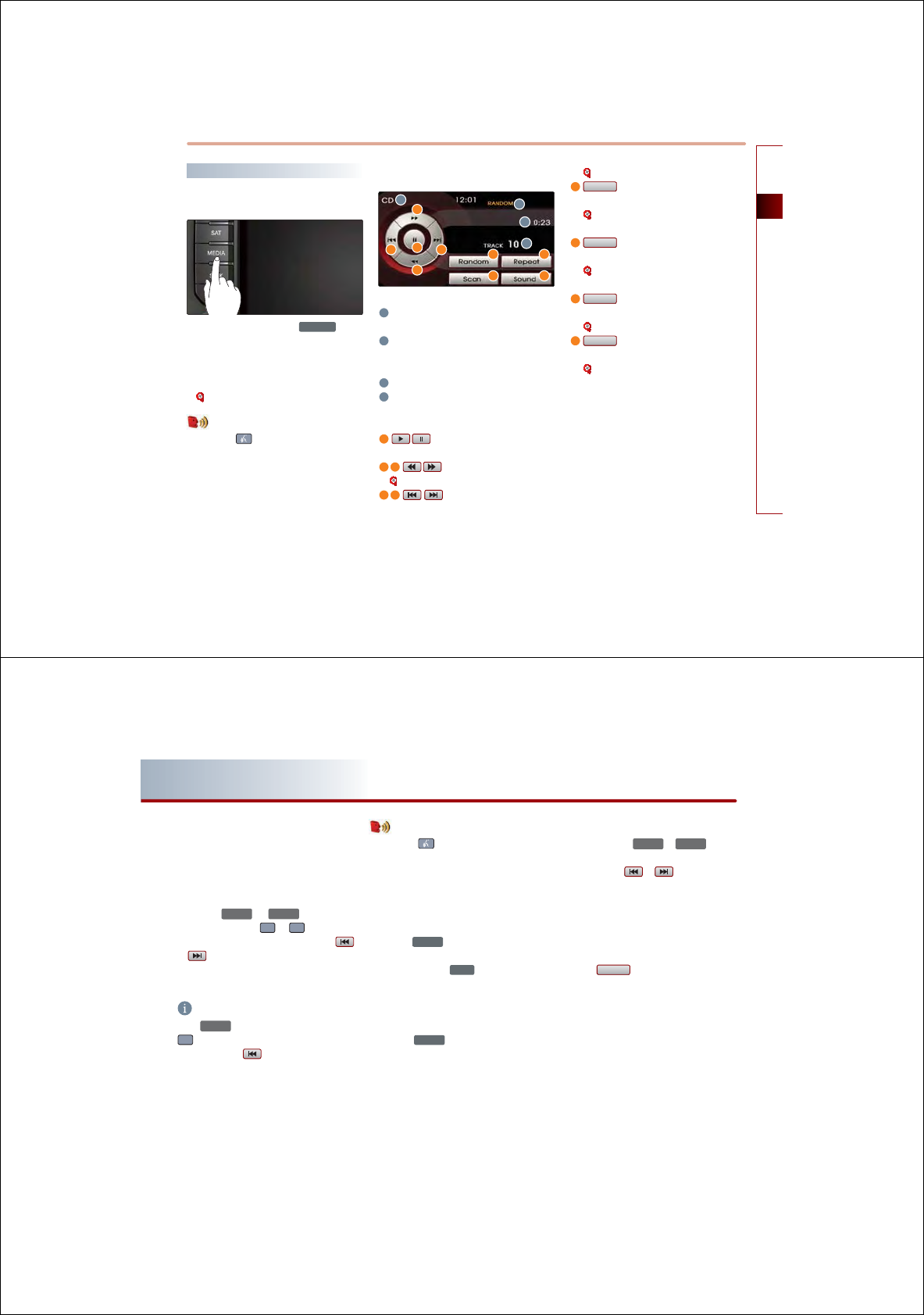
AUDIO SYSTEM 2-15
Operating the CDP
CD
Listening to CD music
1. Insert the CD or press the
0(',$
key on
the control panel if the CD is already inser-
ted.
2. Select the desired track.
[Selecting the CD track], page 2-16.
Voice Command
1. Press the
#
key on the steering wheel
remote controller.
2. After the beep sound, say a command.
"DISC"
"CD"
"CD Track <1 to 665>"
CD screen and functions
Mode display : Displays that the current
mode is CD mode.
RANDOM/REPEAT/SCAN indicator : If
RANDOM/REPEAT/SCAN is operating, the
switch is displayed.
Play time : Displays the play time.
Track number : Displays the current
playing track number.
D button : Plays or pauses the cur-
rent track.
E F button : REW or FF
[Selecting the CD track], page 2-17.
G H button : Previous or next-
track.
[REW/FF CD track], page 2-17.
I
5DQGRP
button : Plays the tracks on the
disc in random order.
[Setting Random function for CD music]
, page 2-17.
J
5HSHDW
button : Repeats the current
playing track.
[Setting Repeat function for CD music],
page 2-18.
K
6FDQ
button : Scans all tracks on the
disc for 10 seconds each.
[Scanning CD track], page 2-18.
L
6RXQG
button : Adjusts the FAD/BAL,
BASS/MID/TREB controls.
[Audio sound setting], page 1-11.
D
F
E
G H IJ
K L
2-16 AUDIO SYSTEM
PART 2 AUDIO SYSTEM
Selecting the CD track
There are 2 ways to select a CD Track - (a)
selecting through Track Up/Down, (b) selec-
ting through searching Track.
(a) Selecting through Track Up / Down
Press the
6((.
A
or
75$&.
keys on the
control panel or the
A
or
keys on the
steering wheel remote controller or the
or buttons on the screen for less than 0.8
second.
The next or previous track will begin playing.
INFORMATION
If the
6((.
A
key on the control panel or the
A
key on the steering wheel remote
controller or the
button on the screen is
pressed shortly while the track has played for
more than 3 seconds, the start of the current
track will begin playing.
If the track has been playing for less than 2
seconds, the start of the previous track will
begin playing.
Voice Command
1. Press the
#
key on the steering wheel
remote controller.
2. After the beep sound, say a command.
"Next Track"
"Previous Track"
(b) Selecting track through search
1. Turn the
781(
knob on the control panel
in clockwise or counter-clockwise direction.
Each click on the
781(
knob will display
the information of the next or previous
track. The current playing track will conti-
nue to be played.
2. Press the
781(
knob at the desired track.
The searched track will begin playing.
REW/FF CD track
Press and hold the
6((.
A
or
75$&.
keys on
the control panel or steering wheel remote
controller or the or buttons for over
0.8 second.
The track will play 20 times faster while hol-
ding the button and return to normal play
when the button is released.
Setting Random function for CD music
Press the
5DQGRP
button.
Each press will change the function in the fol-
lowing order: RANDOM
ĺ
RANDOM OFF
ĺ
RANDOM
● RANDOM : plays all tracks in the disc in ran-
dom order.

AUDIO SYSTEM 2-17
Operating the CDP
Voice Command
1. Press the
#
key on the steering wheel
remote controller.
2. After the beep sound, say a command.
"Random"
Say "Normal Play" in order to terminate the
set Random function.
Setting Repeat function for CD music
Press the
5HSHDW
button. Each press will
change the function in the following order:
REPEAT
ĺ
REPEAT OFF
ĺ
REPEAT
* REPEAT : repeats the current playing track.
Voice Command
1. Press the
#
key on the steering wheel
remote controller.
2. After the beep sound, say a command.
"Repeat Track"
Say "Normal Play" in order to terminate the
set Repeat.
Scanning CD track
1. Press the
6FDQ
button. Each press will
change the function in the following order :
SCAN
ĺ
SCAN OFF
ĺ
SCAN.
● SCAN : Scans all tracks in the disc for 10
seconds each.
Voice Command
1. Press the
#
key on the steering wheel
remote controller.
2. After the beep sound, say a command.
"Scan"
Say "Normal Play" in order to terminate the
set Scan function.
3. Press the
6FDQ
button again to continue
listening to the track.
The scan will be terminated and the current
track will continue to be played.
INFORMATION
When scanning has completed an entire revo-
lution, the scan function is automatically ter-
minated and the previous played track will be
restored.
2-18 AUDIO SYSTEM
PART 2 AUDIO SYSTEM
MP3
MP3 disc related information and
precaution
●
Information
•
The MP3 file standards supported by the
device are as follows.
•
Accept able standard: MPEG1 AUDIO LAYER 3
•
Acceptable sampling frequency: 32, 44.1,
48 (KHz)
•
Acceptable bit rate: 32, 40, 48, 56, 64, 80, 96,
112, 128, 160, 192, 224, 256, 320 (kbps)
•
Recommended bit rate & reference sam-
pling frequency: 96,128, 192 kbps fixed bit
rate /44.1KHz
•
ID3 tag
This device supports ID3v1.0, ID3v1.1,
ID3v2.2, ID3v2.3, and ID3v2.4 ID3 tags.
•
Supported media
• The MP3 media supported by the device
are CD-ROM and USB.
•
Supported media formats
• This device supports ISO9660 LEVEL1 and
LEVEL2. Detailed specification is as below.
•
Maximum directory layers: 8 layers
•
Maximum folder length: 64 Bytes, file name
length: 64 Bytes
•
Supported characters for folder name/ file
name: Alphanumeric characters, Korean
standard character set 2350 characters,
Simplified Chinese 4888 characters
•
Maximum number of folders which can be
stored onto one disc: 256 folders (including
ROOT directory)
•
Maximum number of files which can be
stored onto one disc: 512 files
•
Precautions upon burning MP3 files
•
The use of ISO 9660 LEVEL 2 JULIET format
is recommended when burning MP3 files.
Burning in other formats may abnormally
display the file names.
•
It is possible to display up to 32 characters for
file and folder names in case of UNICODE, and
up to 64 characters in case of ASCII.
• Although the full length of the file name can
be displayed by using the scroll function, the
full length of folder names may not be dis-
played as the scroll function does not operate
when displaying folder names.
●
Precaution
Please use an MP3 bit rate which is less than
128 kbps.
The sound quality cannot be guaranteed for
MP3s exceeding 128kbps.
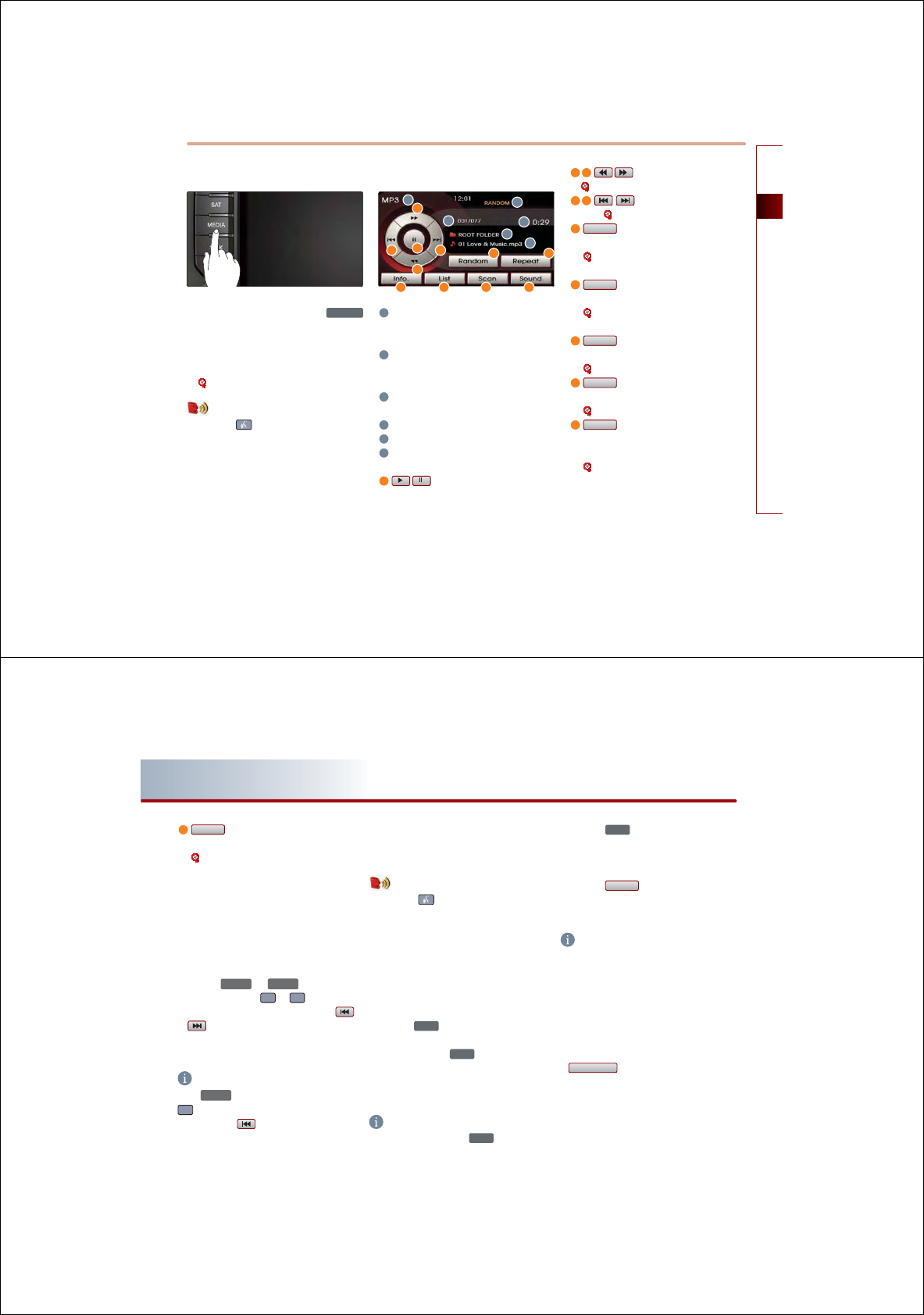
AUDIO SYSTEM 2-19
Operating the CDP
Listening to MP3 music
1. Insert the MP3 disc or press the
0(',$
key on the control panel if the MP3 disc is
already inserted.
2. Select the desired file.
[Selecting the MP3 file], page 2-21.
Voice Command
1. Press the
#
key on the steering wheel
remote controller.
2. After the beep sound, say a command.
"DISC"
"CD"
"MP3"
MP3 screen and functions
Mode display: Displays that the current
mode is MP3 disc mode. (MP3 files on
DVDs are not supported.)
REPEAT/RANDOM/SCAN indicator: If
REPEAT/RANDOM/SCAN is operating, the
switch is displayed.
Play file position : Current playing file /
total files
Play time: Displays the play time.
Folder name: Displays the folder name.
File name: Displays the file name.
D button: Plays or pauses the cur-
rent file.
E F button : REW or FF.
[REW/FF MP3 file], page 2-22.
G H button : Previous or next
track. [Selecting the MP3 file], page 2-21.
I
5DQGRP
button : Plays all files on the disc
or folder in random order.
[Setting Random function for MP3 file] ,
page 2-22.
J
5HSHDW
button : Repeats the current
playing folder or file.
[Setting Repeat function for MP3 file],
page 2-23.
K
6FDQ
button : Scans all files on the disc
or folder for 10 seconds each.
[Scanning MP3 file], page 2-23.
L
/LVW
button : Displays the MP3 folders
and file lists for the disc.
[Selecting the MP3 file], page 2-21.
M
,QIR
button : Displays or hides the
detailed file information for the current
playing file.
[Browsing detailed information about
the MP3 file], page 2-22.
D
F
E
G H I
L MK
J
N
2-20 AUDIO SYSTEM
PART 2 AUDIO SYSTEM
.
6RXQG
button : Adjusts the FAD/BAL,
BASS/MID/TREB controls.
[Audio sound setting], page 1-11.
Selecting the MP3 file
There are 3 ways to select an MP3 file - (a)
selecting through file up/down, (b) selecting
through searching files, (c) selecting through
MP3 list.
(a) Selecting through File Up / Down
Press the
6((.
A
or
75$&.
keys on the
control panel or the
A
or
keys on the
steering wheel remote controller or the
or buttons on the screen for less than 0.8
second.
The next or previous file will begin playing.
INFORMATION
If the
6((.
A
key on the control panel or the
A
key
on the steering wheel remote
controller
the
button on the screen is
pressed shortly while the file has played for
more than 3 seconds, the start of the current
file will begin playing.
If the file has been playing for less than 2
seconds, the start of the previous file will
begin playing.
Voice Command
1. Press the
#
key on the steering wheel
remote controller.
2. After the beep sound, say a command.
"Next File"
"Previous File"
"Next Folder"
"Previous Folder"
(b) Selecting through search
1. Turn the
781(
knob on the control panel
in clockwise or counter-clockwise direction.
Each click on the
781(
knob will display
the information of the next or previous file.
The current playing file will continue to be
played.
INFORMATION
If the operation of the
781(
knob is too
rapid, there may be a delay in displaying the
file information.
2. Press the
781(
knob at the desired file. The
searched file will begin playing.
(c) Selecting through MP3 List
1. Press the
/LVW
button.
The file list of the folder for the current
playing file will be displayed.
INFORMATION
●
If many songs and folders are recorded onto
a DISC, file loading time may be longer and
cause the play list to be improperly displayed
or song search through TUNE operation to
operate improperly.
In such cases, wait until file loading is com-
plete and try again.
●
Within the MP3 list screen, if the
1RZSOD\LQJ
button is pressed while sear-
ching for files within a folder or a page, the
current playing file list will become dis-
played.
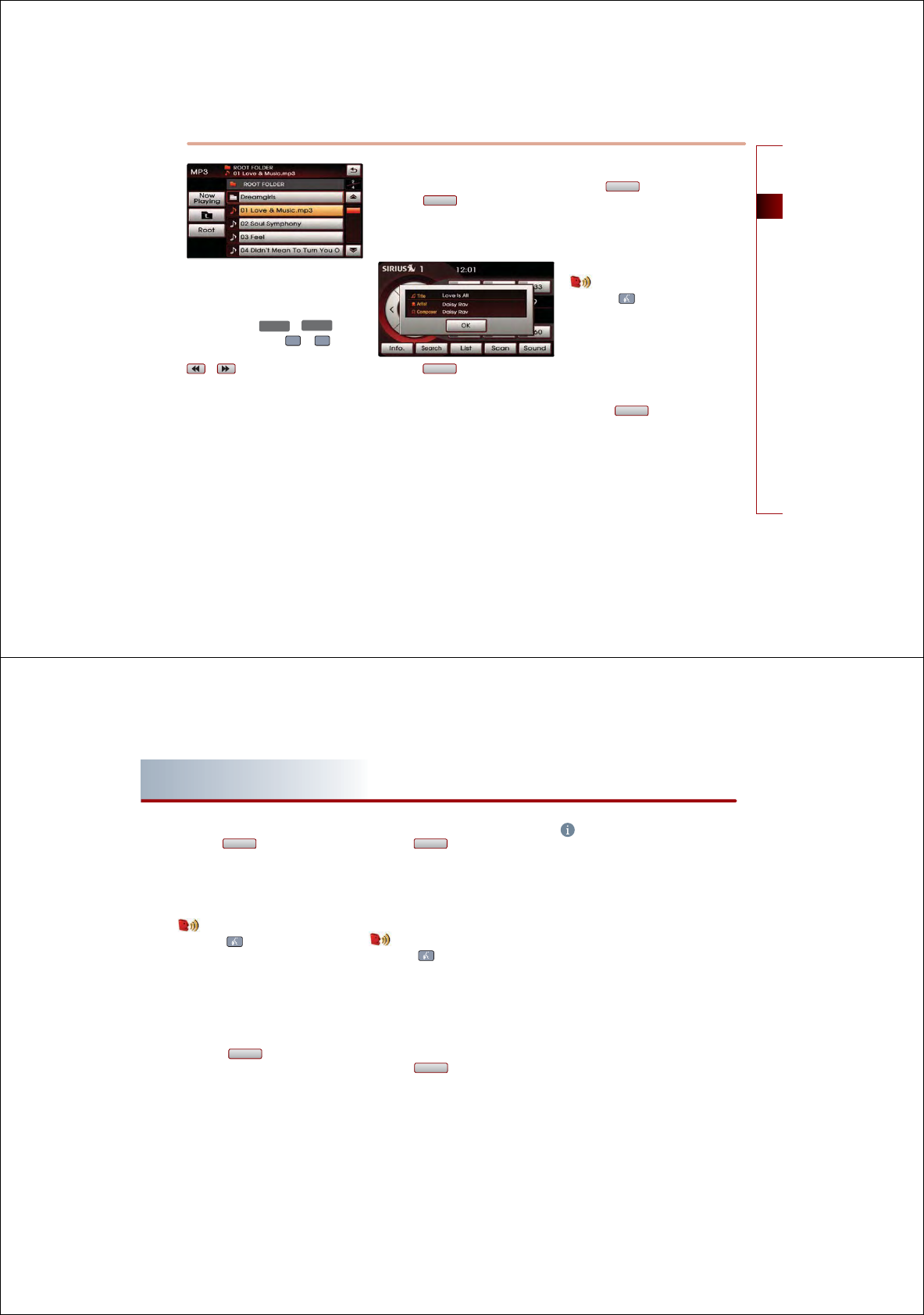
AUDIO SYSTEM 2-21
Operating the CDP
2. Press the desired menu to return to the
main screen and play the selected file.
REW/FF MP3 file
Press and hold the
6((.
A
or
75$&.
keys on
the control panel or the
A
or
keys on
the steering wheel remote controller or the
or buttons for over 0.8 second.
The file will play 20 times faster while holding
the button and return to normal play when
the button is released.
Browsing detailed information about
the MP3 file
1. Press the
,QIR
button.
The detailed information (Title, Album,
Artist) for the current playing MP3 will be
displayed.
2. Press the
2.
button.
The detailed information will be turned off.
Setting Random function for MP3 file
Press the
5DQGRP
button.
● RANDOM (less than 0.8 second) : Plays all
files in the disc in random order
● FOLDER RANDOM (over 0.8 second) : Plays
the files in the current folder in random
order.
Voice Command
1. Press the
#
key on the steering wheel
remote controller.
2. After the beep sound, say a command.
"Random"
"Random Folder"
Say "Normal Play" in order to terminate the
set Random function.
3. Press the
5DQGRP
button again to continue
listening to the current file.
The random selection will be terminated
and the current file will continue to play.
2-22 AUDIO SYSTEM
PART 2 AUDIO SYSTEM
Setting Repeat function for MP3 file
1. Press the
5HSHDW
button.
● REPEAT (less than 0.8 second) : Repeats the
current playing file
● FOLDER REPEAT (over 0.8 second) : Repeats
the files in the current folder
Voice Command
1. Press the
#
key on the steering wheel
remote controller.
2. After the beep sound, say a command.
"Repeat File"
"Repeat Folder"
Say "Normal Play" in order to terminate the
set Repeat function.
2. Press the
5HSHDW
button again to stop
repeating the current file.
The repeat selection will be terminated and
the current file will continue to play once
until the next file starts to play.
Scanning MP3 file
1. Press the
6FDQ
button.
● SCAN (less than 0.8 second) : Scans all files
in the disc and plays for 10 seconds each.
● FOLDER SCAN (over 0.8 second) : Scans all
files in the current folder for 10 seconds
each.
Voice Command
1. Press the
#
key on the steering wheel
remote controller.
2. After the beep sound, say a command.
"Scan"
"Folder Scan"
Say "Normal Play" in order to terminate the
set Scan function.
2. Press the
6FDQ
button again to continue
listening to the file.
The scan selection will be terminated and
the current file will continue to play.
INFORMATION
When scanning has completed an entire revo-
lution, the scan function is automatically ter-
minated and the previous played file will be
restored.
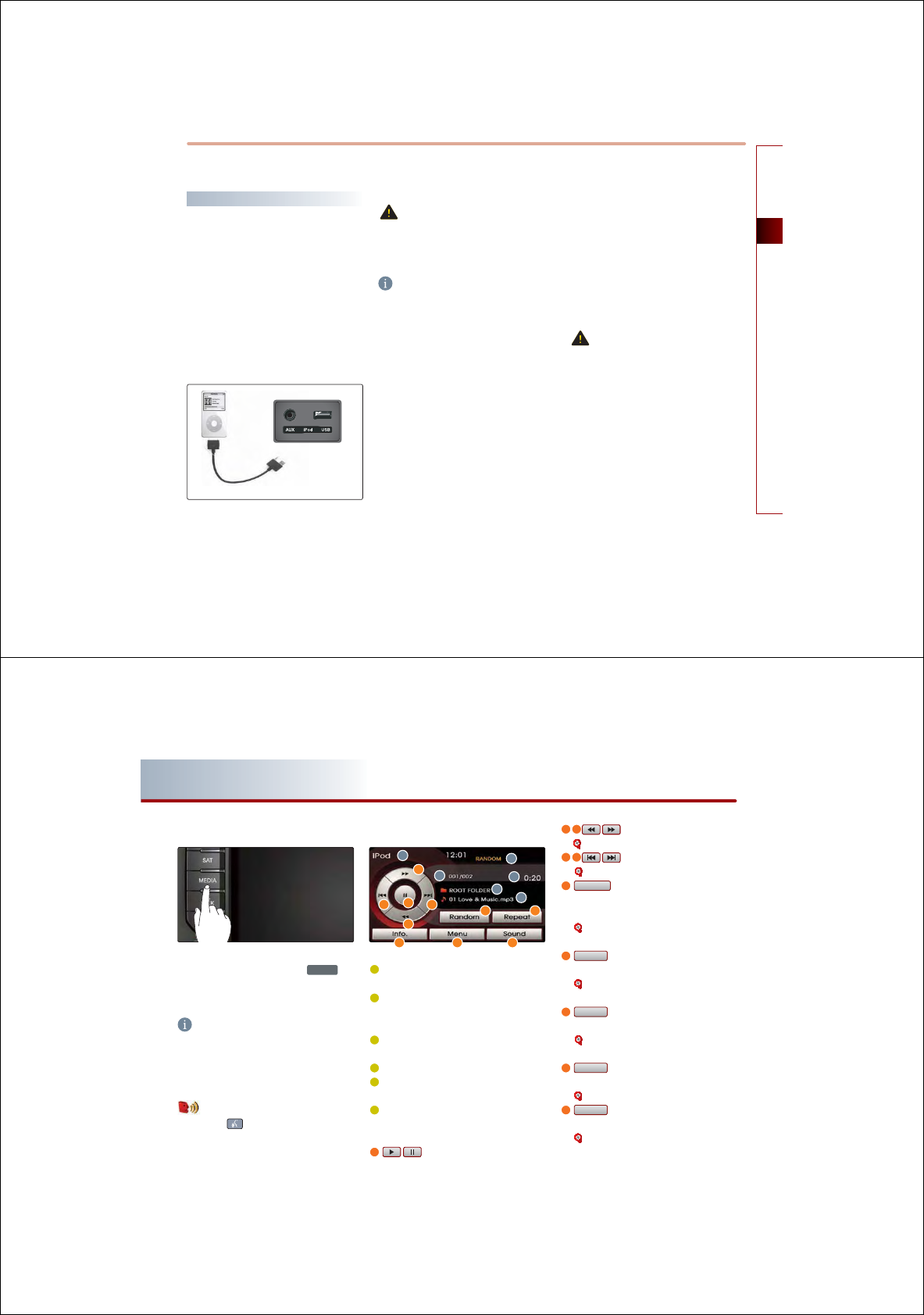
AUDIO SYSTEM 2-23
Operating the external devices
Operating the external devices
MP3
iPod® is a registered trademark of Apple Inc.
Connecting iPod devices
Connect the iPod device as shown in the pic-
ture.
The Kia iPod Power cable is needed in order to
operate iPod with the audio buttons on the
audio system. The USB cable provided by
Apple may cause malfunction and should not
be used for Kia vehicles.
The Kia iPod Power cable maybe purchased
through your Kia dealership.
●
Unsupported iPod devices : iPod genera-
tions before iPod 3G, iPod Shuffle, and iPad.
CAUTION!
Some functions may not operate properly
depending on the firmware version in some
iPod or iPhone devices.
INFORMATION
In order to prevent such malfunction, check
the following before connecting your iPod or
iPhone device with the Kia iPod Cable.
●
If the battery has been completed dischar-
ged, charge the device for at least 10 minutes
before connecting.
●
Turn on the device before connecting.
●
If the device is set to lock, release the lock
before connecting.
●
For iPhones, audio will not play if the audio
system and BT are paired. Disconnect the
pairing before connecting.
When there are no songs in the iPod or
iPhone or if there is no response from the
device after connecting with the Kia Cable, a
“No Media Connected” pop-up message will
be displayed for 5 seconds and the previous
mode will automatically be restored.
In such cases, disconnect the iPod or iPhone
and try connecting again.
If the message continues even after reconnec-
ting the iPod, check to see if there are any pro-
blems with the iPod device.
CAUTION!
If a playing iPod is connected to the audio sys-
tem, a high-pitched tone may occur for
approximately 1-2 seconds.
Please turn the iPod device to pause/stop
prior to connecting it to the vehicle.
2-24 AUDIO SYSTEM
PART 2 AUDIO SYSTEM
Listening to music from iPod
1. Connect the iPod or press the
0(',$
key
on the control panel if the iPod is already
connected.
INFORMATION
Even if the iPod is connected, the 'No Media
Connected' message may be displayed if an
error has occurred. In such a case, reconnect
the iPod.
Voice Command
1. Press the key on the steering wheel
remote controller.
2. After the beep sound, say a command.
"iPod"
iPod screen and functions
Mode display: displays that the current
mode is iPod mode.
RANDOM/REPEAT indicator: if RANDOM/
REPEAT is operating, the switch is dis-
played.
Play file position: current playing file / total
files
Play time: displays the play time.
Category name: displays the category
name of the playing file.
Title name: displays the title name of the
playing file.
D button: plays or pauses the cur-
rent file.
E F button : REW or FF.
[REW/FF iPod song], page 2-27.
G H button : previous or next file.
[Selcting an iPod song], page 2-25.
I
5DQGRP
button : plays all songs in the
current playing list in random order or ran-
domly in album unit.
[Setting random function for iPod
song], page 2-26.
J
5HSHDW
buttons : repeats the current
playing song.
[Setting repeat function for iPod song],
page 2-27.
K
,QIR
button : converts to the search
menu screen.
[
Viewing detailed information for iPod
song], page 2-27.
L
0HQX
button : converts to the search
menu screen.
[Selecting an iPod song], page 2-25.
M
6RXQG
button : adjusts the FAD/BAL,
BASS/MID/TREB controls.
[Audio Sound setting], page 1-10.
D
F
E
G H I J
K L M
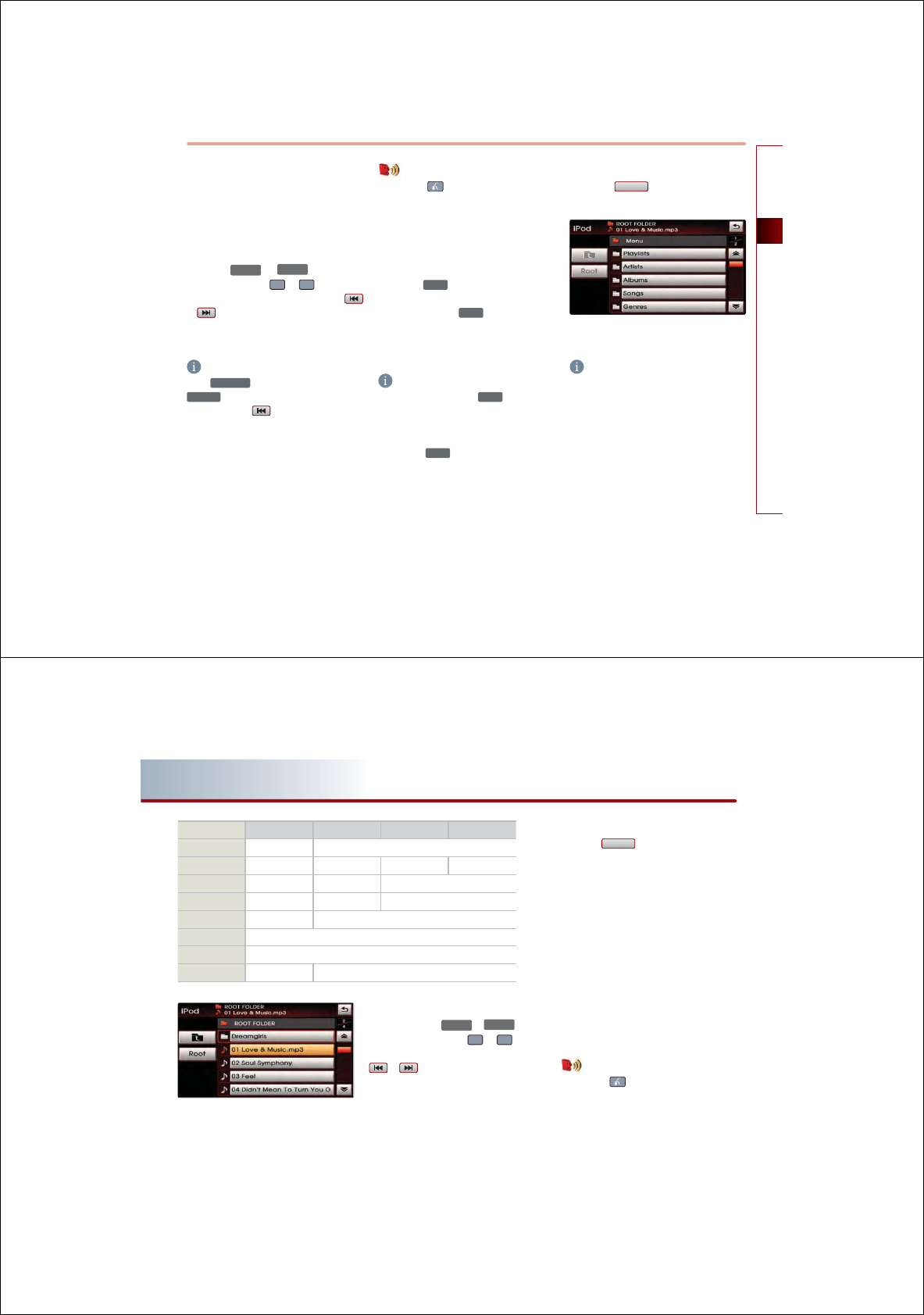
AUDIO SYSTEM 2-25
Operating the external devices
Selecting music from iPod
There are 3 ways to select songs from the iPod
device - (a) selecting song through Up/Down,
(b) selecting song through sequential search,
(c) selecting song through menu.
(a) Selecting song through Up / Down
Press the
6((.
A
or
75$&.
keys on the
control panel or the
A
or
keys on the
steering wheel remote controller or the
or buttons on the screen for less than 0.8
second. The next or previous song will begin
playing.
INFORMATION
If the
75$&.
䑰
key the control panel or the
6((.
䑰
key
on the steering wheel remote
controller or the
button on the screen is
pressed shortly while the song is playing for
more than 3 seconds, the start of the current
song will begin playing. If the song has been
playing for less than 2 seconds, the start of the
previous song will begin playing.
Voice Command
1. Press the
#
key on the steering wheel
remote controller.
2. After the beep sound, say a command.
"Next Song"
"Previous Song"
(b) Selecting song through search
1. Turn the
781(
knob on the control panel
in clockwise or counter-clockwise direction.
Each click on the
781(
knob will display
the information of the next or previous
song. The current playing song will conti-
nue to be played.
INFORMATION
If the operation of the
781(
knob is too
rapid, there may be a delay in displaying the
song information.
2. Press the
781(
knob at the desired song.
The searched song will begin playing.
(c) Selecting song through Menu
1. Press the
0HQX
button.
The iPod menu screen will be displayed.
2. Press the button for the desired search
method.
INFORMATION
If the search mode is accessed while playing a
song, the most recent searched step will be
displayed.
The search steps upon initial connection are
listed below.
2-26 AUDIO SYSTEM
PART 2 AUDIO SYSTEM
3. Press the desired song button to return to
the main screen and play the selected song.
REW/FF iPod music
Press and hold the
6((.
A
or
75$&.
keys on
the control panel or the
A
or
keys on
the steering wheel remote controller or the
or buttons for over 0.8 second.
The song will play 20 times faster while hol-
ding the button and return to normal play
when the button is released.
Setting Random function for iPod music
Press the
5DQGRP
button. Each press will
change the function in the following order :
Random
ĺ
Album Random
ĺ
Random Off
ĺ
Random...
● Album Random : plays the song in the cur-
rent play list randomly in album units.
However, songs within the same album will
be played sequentially.
e.g.) Album1(Music1
ĺ
Music2
ĺ
Music3
ĺ
...
ĺ
Music10)
ĺ
Album5 ( Music1
ĺ
Music2)
ĺ
Album4 (Music1
ĺ
Music2
ĺ
Music3) ...
● RANDOM : Plays all files in the current play
list in (All Songs, certain albums, or user
designated iPod Playists) randomly
regardless of album.
Voice Command
1. Press the
#
key on the steering wheel
remote controller.
2. After the beep sound, say a command.
"Random"
"Random Album"
Say "Normal Play" in order to terminate the
set Random.
1 Step 2 Step 3 Step 4 Step
Playlist Playlist Song
Genre Genre Artist Album Song
Artist Artist Album Song
Composer composer Album Song
Album Album Song
Audiobooks Song
Songs Song
Podcasts Program Episode

AUDIO SYSTEM 2-27
Operating the external devices
Setting Repeat function for iPod music
1. Press the
5HSHDW
button.
Each press will change the function in the fol-
lowing order: REPEAT
ĺ
REPEAT OFF
ĺ
REPEAT
● REPEAT : Repeats the current playing song.
Voice Command
1. Press the
#
key on the steering wheel
remote controller.
2. After the beep sound, say a command.
"Repeat Song"
Say "Normal Play" in order to terminate the
set Repeat function.
Browsing detailed information about the
iPod music
1. Press the
,QIR
button.
The detailed information (Title, Album and
Artist) for the current channel will be dis-
played.
2. Press the
2.
button.
The detailed information will be turned off.
2-28 AUDIO SYSTEM
PART 2 AUDIO SYSTEM
USB MP3
USB MP3 related information and
precaution
● Information
•
The MP3 file standards supported by the
device are as follows.
•
Acceptable standard: MPEG1 AUDIO LAYER 3.
•
Acceptable sampling frequency: 32, 44.1,
48 (kHz)
• Acceptable bit rate : 32, 40, 48, 56, 64, 80,
96, 112, 128, 160, 192, 224, 256, 320 (kbps)
• Recommended bit rate & reference sam-
pling frequency: 96,128, 192 kbps fixed bit
rate /44.1kHz
• ID3 tag
This device supports ID3v1.0, ID3v1.1,
ID3v2.2, ID3v2.3, and ID3v2.4 ID3 tags.
• Supported media
The MP3 media supported by the device
are CD-ROM and USB.
• Supported media formats
This device supports ISO9660 LEVEL1 and
LEVEL2. Detailed specification is as below.
• Maximum directory layers: 20 layers
• Maximum length of folder name/file name:
250Bytes
• Supported characters for folder name/ file
name: Alphanumeric characters, Korean
standard character set 2350 characters,
Simplified Chinese 4888 characters
• Maximum number of folders which can be
stored onto one USB: 2000 folders (inclu-
ding ROOT directory)
• Maximum number of files which can be
stored onto one USB: 6000 files
• Precautions upon formatting USB & down-
loading MP3 files
• The device only supports FAT type USB file
system. The device will not play USB media
content if the USB is NTFS type.
● Precaution
Please use an MP3 bit rate which is less than
192kbps and a fixed bit rate.
The sound quality cannot be guaranteed for
MP3s exceeding 192Kbps and operation of
specific functions (limited to FF/REW func-
tions) may be abnormal with variable bit rates.
Precautions upon handling USB
● When using the external USB device, make
sure to keep the device disconnected and
connect only some time after turning on the
vehicle ignition. The USB device may be
damaged if the USB device already connec-
ted when the ignition is turned on. (USB
device is not an electronic automotive com-
ponent)
● The external USB device may not operate if
the USB device already connected when
vehicle ignition is turned on or off.
● The device will not operate when playing a
format which is not MP3 or WMA file for-
mats.
1. Only MP3 files with compression rates
between 8kbps~320kbps are supported.
2. Only WMA files with compression rates
between 8kbps~320kbps are supported.
● Be cautious of static electricity when
connecting/disconnecting the external USB
device.
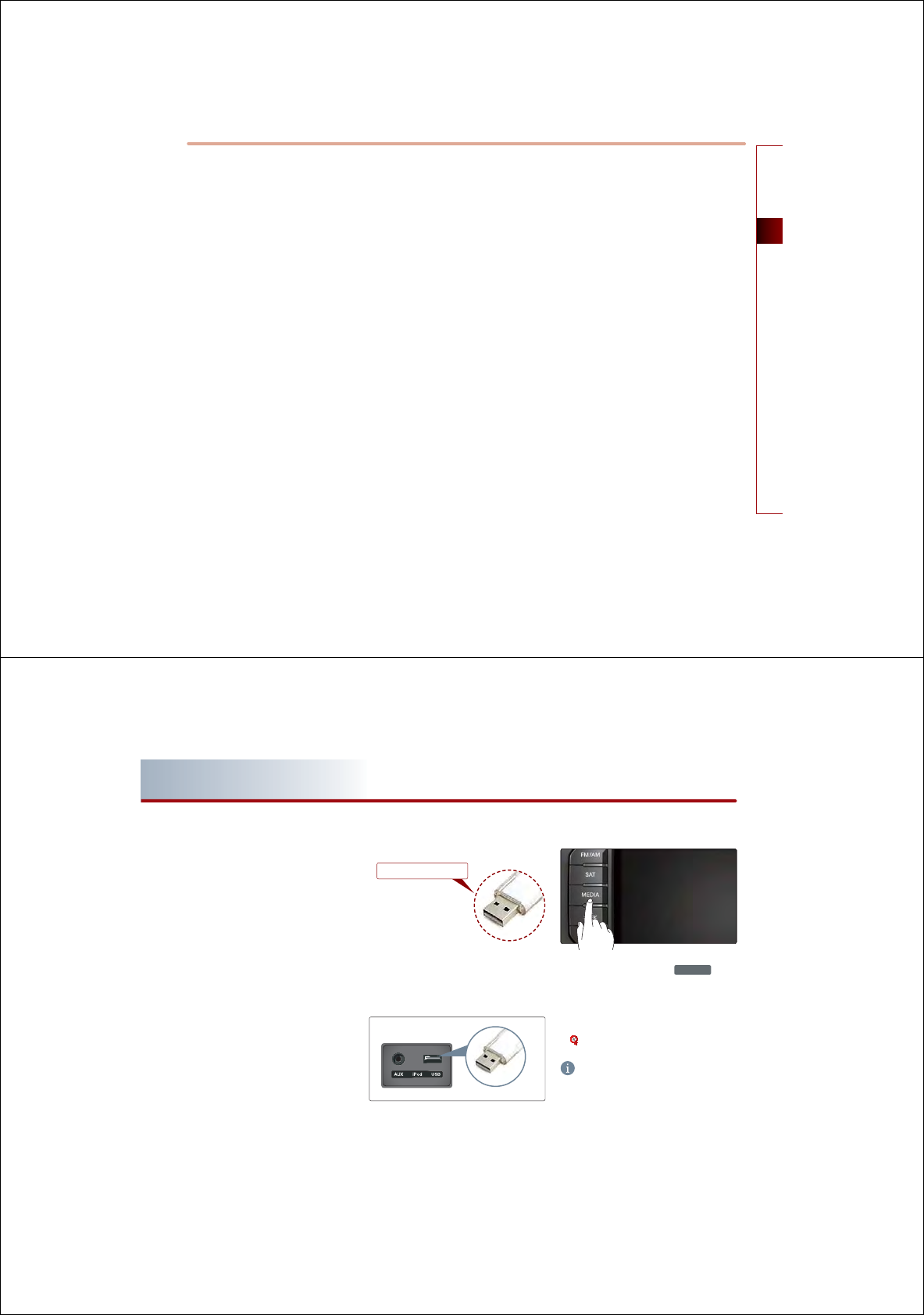
AUDIO SYSTEM 2-29
Operating the external devices
● Encoded MP3 Players will not be recognized
when connected as the external device.
● When connecting an external USB device,
the device may not properly recognize the
USB when the USB is in some states.
● When formatting the external USB device,
the device may not properly be properly
recognize a Byte/Sector selection other
than 512Byte or 2048Byte.
● The device will only recognize USB devices
formatted in FAT 12/16/32.
● Some USB devices may not operate properly
because of compatibility issues. Verify that
the external device is supported by the
device before starting use.
● Avoid contact between the USB connector
with bodily parts and foreign substances.
● Repeatedly connecting/disconnecting the
USB in a short period of time may cause
damage to the device.
● When disconnecting the USB, an abnormal
sound may occur occasionally.
● Abruptly disconnecting the external USB
device while the USB is operating may
cause the device to be damaged or function
abnormally.
Make sure to disconnect the USB device
only after the audio power is turned off or
when the audio is operating in a different
mode.
● The amount of time required to recognize
the external USB device may differ depen-
ding on the type, size, or file formats stored
on the USB.
Such differences in the required time are
not indications of malfunction.
Please wait for the required period of time
to recognize the device.
● The device supports only USB devices used
to play music files.
● Do not use the USB I/F to charge batteries
or USB accessories which generate heat.
Such acts may lead to deteriorated perfor-
mance or damage to the device.
● The device may not recognize the USB
device if separately purchased USB hubs
and extension cables are being used.
Connect the USB directly to the multimedia
terminal of the vehicle.
● In the case of high capacity USB devices,
there are instances where the logical drives
are partitioned for user convenience.
In this case, only the USB music in the top-
level logical drive will be possible to play.
When using partitioned drives, save the
desired songs to play on the device only in
the top-level logical drive.
In addition, certain USB devices are confi-
gured with a separate drive used to install
application programs and songs from such
drives may not be possible to play for the
reasons as described above.
● The device may not support normal opera-
tion if MP3 Players, cellular phones, digital
cameras, or other electronic devices (USB
devices not recognized as portable disk
drives) are connected to the device.
2-30 AUDIO SYSTEM
PART 2 AUDIO SYSTEM
● The device may not support normal opera-
tion when using a USB memory type
besides the Metal Cover Type USB Memory.
● The device may not support normal opera-
tion when using formats such as HDD Type,
CF, or SD Memory.
● The device will not support files locked by
DRM (Digital Rights Management).
● The device may not support. Please make
sure to use normal operation if the proper
connection with the USB memory fails due
to vibrations caused by the vehicle. (i-stick
type, etc.)
●
Please avoid using USB memory products
which can be used as key chains or cellu-
lar phone accessories as they could cause
damage to the USB jack.
Please make certain only to use plug type
connector products as shown below.
Connecting the USB devices
Connect the USB as shown in the picture.
㾐㾐㾐㾐
Listening to USB music
1. Connect a USB or press the
0(',$
key on
the control panel if the USB is already
connected.
2. Select the desired file.
[Selecting the MP3 file], page 2-21.
INFORMATION
The USB screen and operation method is the
same with MP3 mode.
Please refer to the MP3 mode section for more
information.
Plug Type Connector
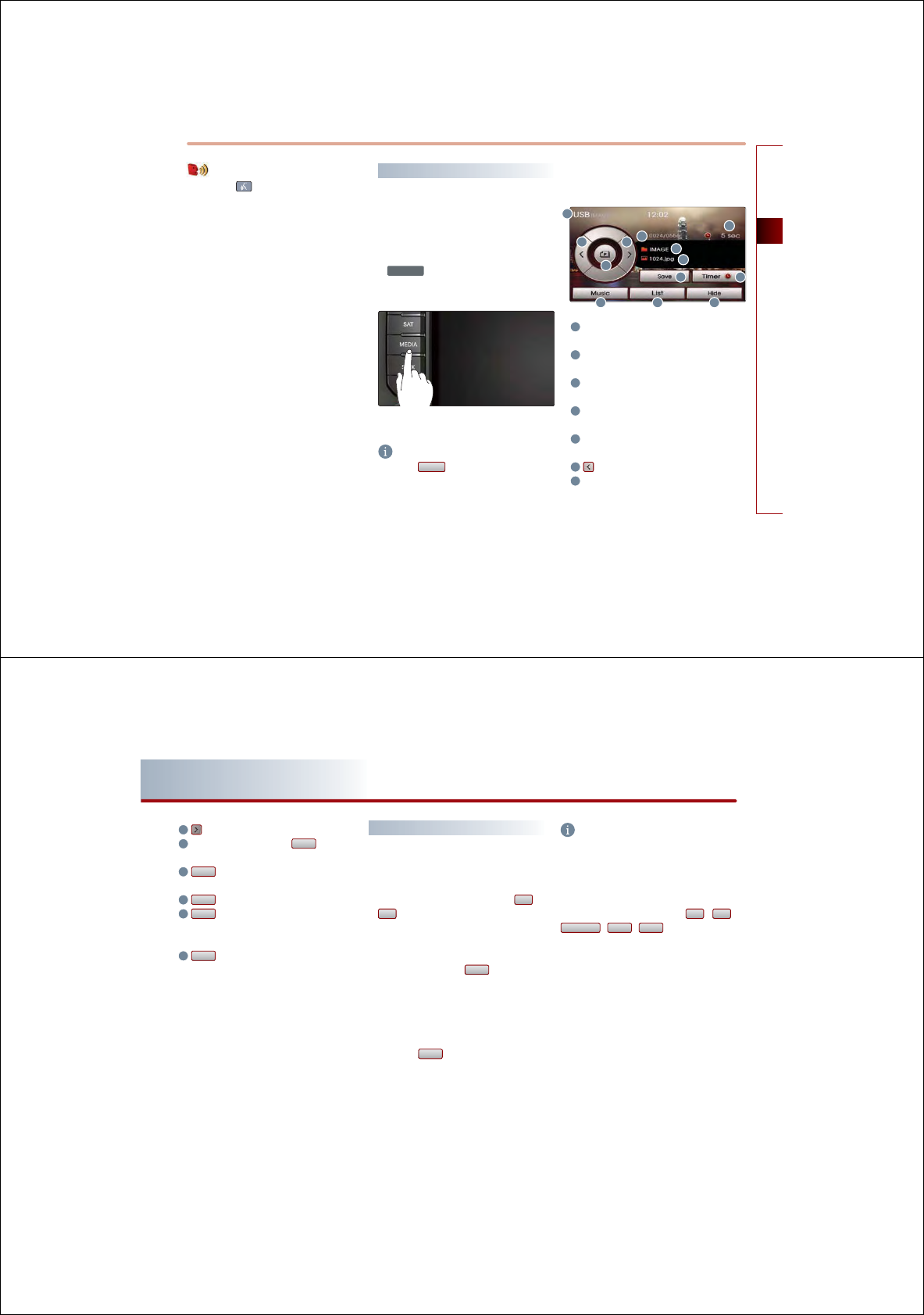
AUDIO SYSTEM 2-31
Operating the external devices
Voice Command
1. Press the
#
key on the steering wheel
remote controller.
2. After the beep sound, say a command.
"USB"
Starting USB IMAGE Mode
Starting USB IMAGE Mode
1. The USB mode will automatically start
when the USB is inserted. When in a
different mode, repeatedly press the
0(',$
key to convert to USB mode.
(Each press will change in order of AUX
ĺ
DISC
ĺ
USB)
2. The image will be displayed on the screen.
INFORMATION
Press the
0XVLF
button on the bottom left
side to enter either mode. (Supported only
when compatible files exist within the USB)
USB IMAGE mode menu screen
configuration
Mode display : display that the current
mode is <USB Image> mode.
Folder name : displays the name of the fol-
der where photo files are located.
File name : displays the file name of the
current photo.
File index : displays the number of Image
files within the USB (current file / all files)
Slide Show Interval : displays intervals of 5,
10, and 20 seconds.
button : displays the previous photo.
Slide Show View : displays photos in inter-
vals of 5, 10, and 20 seconds.
2-32 AUDIO SYSTEM
PART 2 AUDIO SYSTEM
button : displays the next photo.
USB music(MP3) mode
0XVLF
button :
converts to <USB Music> mode.
/LVW
button : displays the <Image List>
screen.
+LGH
button : hides the button display.
6DYH
button : upon turning off power,
saves the current image as the frame
screen image.
7LPHU
button : allows changes to slide
show interval.
Operating USB IMAGE Mode
(a) Moving to next IMAGE
1. Press the screen.
2. Within the Image screen, press the
Ԧ
or
Ԣ
button to flip through each file.
(b) Displaying USB IMAGE Slideshow
Interval
1. Repeatedly press the
7LPHU
button at the
bottom to change the slideshow interval
(converts in time intervals of 5 seconds
ĺ
10 seconds
ĺ
20 seconds
ĺ
5 seconds).
(c) Registering Frame
1. Press the
6DYH
button at the bottom of
the <Image> screen. The currently dis-
played image will be registered as the
frame.
INFORMATION
For details on setting up the frame, refer to
the frame setup page within Screen setup.
Restrictions while driving-Image Play related
buttons cannot be used while the vehicle is in
motion.
There are five buttons such as <
Ԧ
/
Ԣ
/
3OD\,FRQ
/
6DYH
/
+LGH
>.
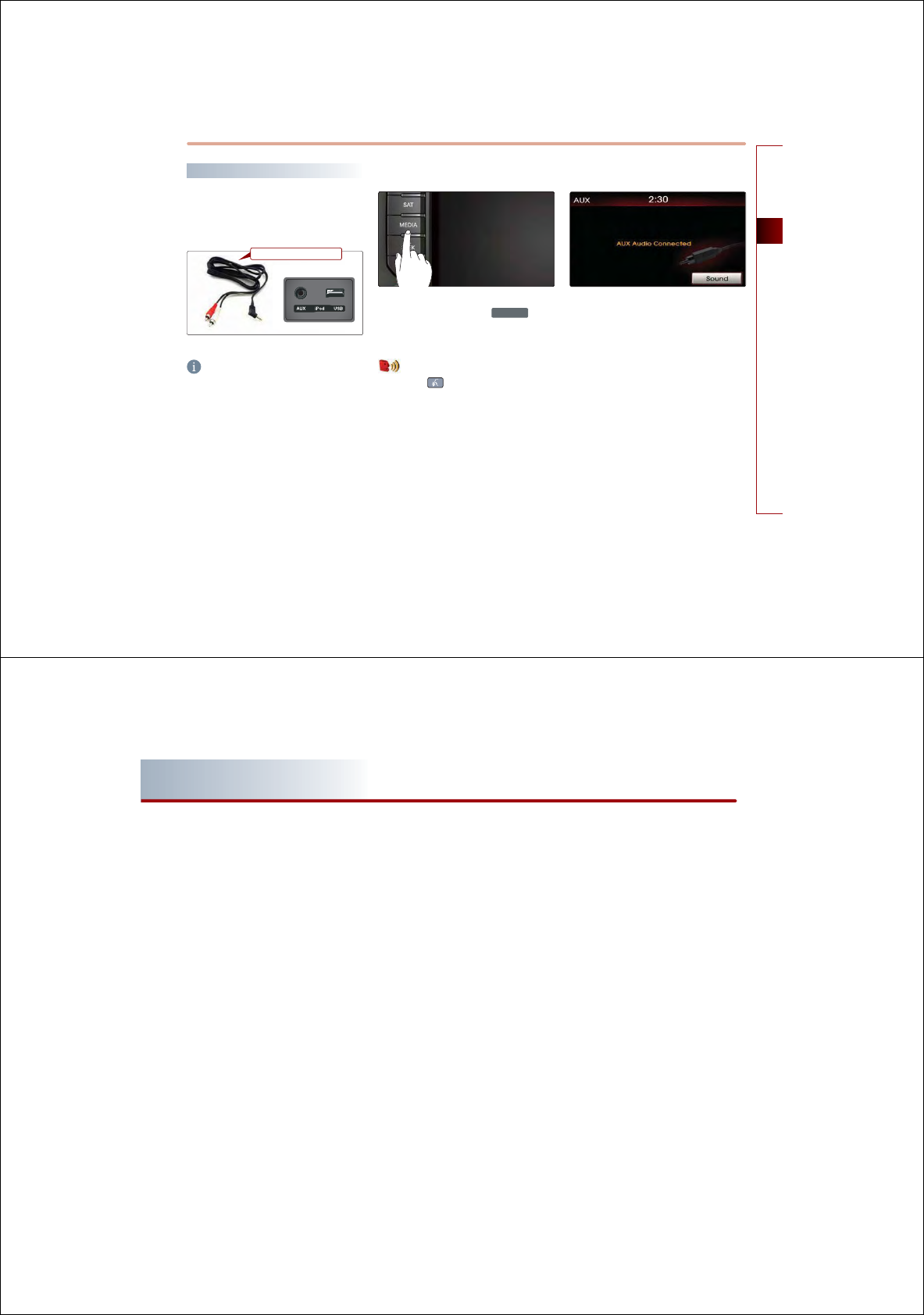
AUDIO SYSTEM 2-33
Operating the external devices
AUX
Connecting AUX
Connect the external Audio player as shown
in the picture.
INFORMATION
Connect only by using AUX terminals.
Playing AUX
Connect an AUX or press the
0(',$
key on
the control panel if the AUX is already connec-
ted.
Voice Command
1. Press the
#
key on the steering wheel
remote controller.
2. After the beep sound, say a command.
"Line In"
AUX screen
Audio AUX screen
External Audio Device
PART 3 NAVIGATION SYSTEM
PART 3
NAVIGATION SYSTEM
Limitations of the navigation
system ……………………………… 3-2
GPS signal reception state ………………3-2
Vehicle position display …………………3-3
Route Guidance …………………………3-4
Route Re-calculation ……………………3-4
Starting navigation system ……………3-5
Map Functions ……………………… 3-5
Current position map screen
(without route) …………………………3-5
Switching map mode
(North Up / Heading Up) ………………3-6
Viewing GPS signal state ………………3-7
Changing the map scale ………………3-8
Displaying / Hiding POI icons on the
map ………………………………………3-9
Displaying/Hiding Q.POI icons ……… 3-9
Displaying / Hiding icons other than
Q.POI icons …………………………… 3-9
Making a call to POI ………………… 3-10
Scrolling map ………………………… 3-11
Setting a destination ……………… 3-12
Destination menu screen and functions
… 3-12
Searching a Destination ……………… 3-13
Searching an Address………………… 3-13
Searching a Previous Destination …… 3-17
Searching an Intersection …………… 3-17
Searching a POI ……………………… 3-20
Searching from Address book ……… 3-24
Searching for Emergency facilities … 3-25
Searching your Home ……………… 3-25
Searching favorite places …………… 3-26
Searching from MAP ………………… 3-26
Searching POI by local POI list ……… 3-26
Operating after searching a destination … 3-27
Changing destination position ……… 3-27
Setting as Destination / waypoint …… 3-27
Adding to address book …………… 3-27
Operating after setting a destination … 3-28
Starting Route Guideance …………… 3-28
Route guidance screen ……………… 3-28
Selecting other route ………………… 3-29
Route guidance ……………………… 3-30
Route menu screen and functions …… 3-30
Finishing route guidance
(Delete Destination) ………………… 3-30
Route overview (View Entire Route) … 3-31
Changing Route option ……………… 3-32
Editing waypoints …………………… 3-32
Deleting waypoints ………………… 3-34
Re-ordering waypoints ……………… 3-34
Setting detour distance ……………… 3-35
Setting avoid streets on route ……… 3-35
Setup and Information …………… 3-36
Setup menu screen and functions …… 3-36
Main setting ………………………… 3-37
Setting keyboard for inputting letter … 3-37
Setting voice command feedback
ON/OFF ……………………………… 3-37
Setting Language …………………… 3-37
System information and update …… 3-37
Initializing system …………………… 3-37
Navigation setting …………………… 3-38
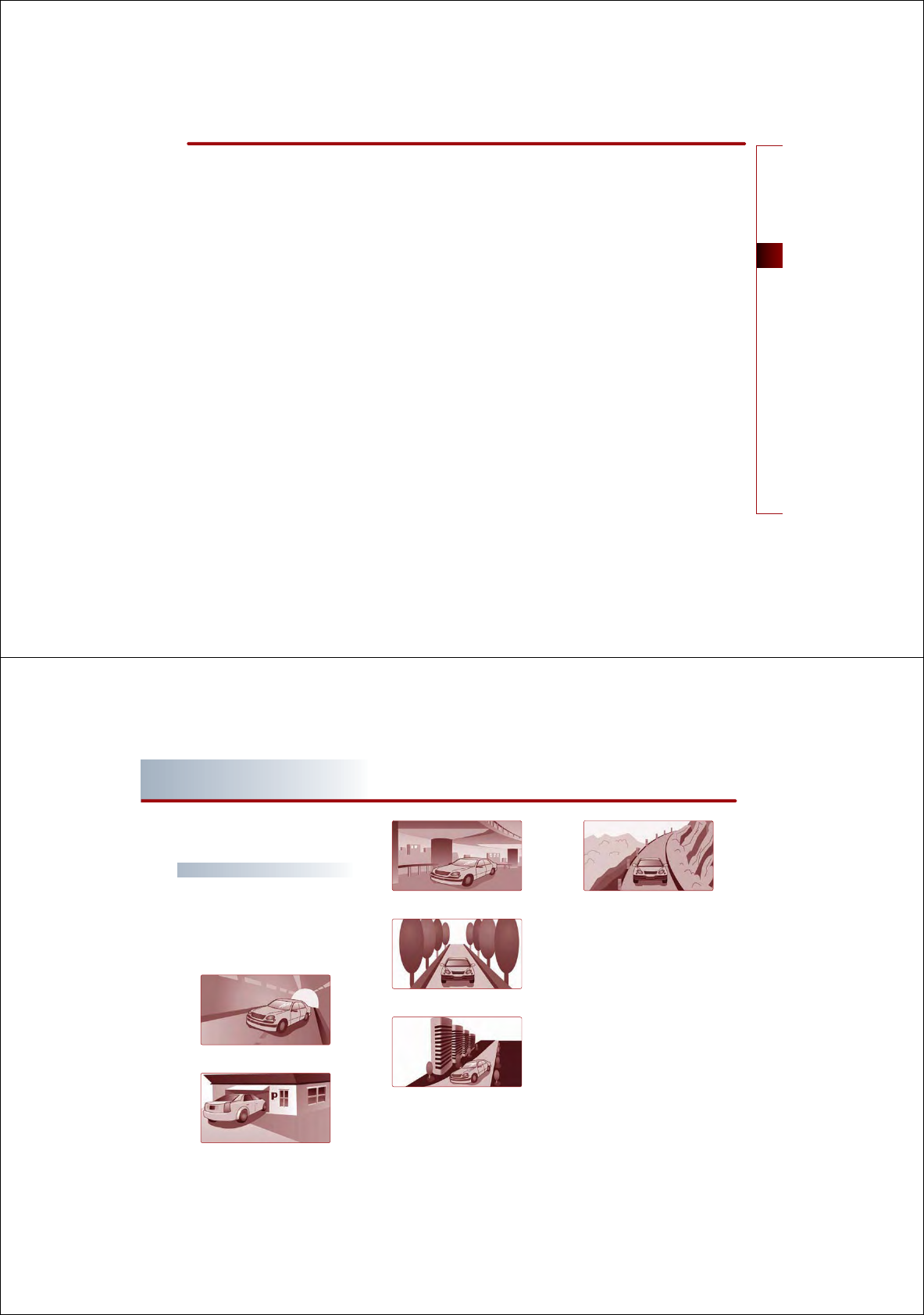
NAVIGATION SYSTEM 3-1
NAVIGATION SYSTEM
PART 3
NAVIGATION SYSTEM
Setting units (mile / km) …………… 3-38
Setting arrival time and distance
display ………………………………… 3-38
Registering avoid area ……………… 3-38
Editing avoid area …………………… 3-40
Deleting avoid area ………………… 3-41
Deleting all avoid areas ……………… 3-41
Setting Q.POI icons …………………… 3-42
Setting estimate travel time ………… 3-42
My places setting …………………… 3-43
Registering new address in
address book ………………………… 3-43
Editing an address of address book … 3-45
Deleting an address of address book 3-46
Deleting an address book …………… 3-47
Registering home address …………… 3-48
Deleting home address ……………… 3-48
Registering favorite place …………… 3-49
Deleting favorite place ……………… 3-50
Voice guidance volume setting ……… 3-51
Voice guidance volume control ……… 3-51
Adaptive volume control ON/OFF …… 3-52
Traffic Setup ………………………… 3-52
Traffic Information …………………… 3-52
Help …………………………………… 3-54
3-2 NAVIGATION SYSTEM
PART 3 NAVIGATION SYSTEM
Limitations of the navigation
system
GPS signal reception state
●
As the GPS satellite frequency is received /
transmitted in straight lines, reception may
not work if devices are placed on or near
the GPS antenna or when traveling through
the following locations.
•Tunnels
•Basement parking structures
•Underneath an overpass
•Roads within forested areas
•Areas near high rise buildings
•Roads within canyons

NAVIGATION SYSTEM 3-3
NAVIGATION SYSTEM
Vehicle position display
●
If multipass errors occur due to reflections
from buildings or related causes, the current
position mark on the navigation may differ
from the actual position of the vehicle.
● The position of the vehicle on the naviga-
tion may be different from the actual posi-
tion if the vehicle is under the following
conditions. If such differences occur, driving
for a short period of time will automatically
correct the position of the vehicle through
map matching or GPS information (several
minutes may be necessary in certain cases).
•
When driving on a Y-shaped road with a
narrow angle, the current position may be
displayed in the opposite direction.
• If the vehicle is loaded onto a ferry or a car
transport vehicle, the current position mark
may be stalled on the last position prior to
loading.
•When driving on a spiral-shaped road.
• When driving in mountain regions with
sharp turns or sudden brakes.
• When entering a road after having been in
an underground parking structure, building
parking structure, or turntable with many
rotations.
• When the tires have recently been replaced
(Especially upon use of spare or studless
tires)
• If the battery terminal is removed.
• When driving in city streets, the current
position may be displayed on the opposite
side or on an off-road position.
• When changing the zoom level from the
maximum zoom in level to a different zoom
level, the current position mark may be dis-
played on a different road.
• When driving in heavy traffic with frequent
go
・
stops in traffic or intersections.
• When driving under slippery conditions,
such as heavy sand, snow, etc.
• When driving with the tire chain in place.
• When using a tire with an incorrect size
specification.
• When the tire pressure for the 4 tires are dif-
ferent.
• When the replacement tire is a worn or
used tire (Especially studless tires having
passed a 2nd seasons, etc.)
• When driving near high-rise buildings
• If a roof carrier has been installed
• When driving under high speeds or having
calculated a long-distance route.
3-4 NAVIGATION SYSTEM
PART 3 NAVIGATION SYSTEM
Route Guidance
●
Suitable route guidance may not occur
caused by search conditions or the driving
position.
•
Guidance to go straight may be given while
driving on a straight road.
•
Guidance may not be given even when hav-
ing turned at an intersection.
•
There are certain intersections in which
guidance may not occur.
•
A route guidance signaling for a U-Turn in a
No U-Turn location may occur.
•
A route guidance signaling entrance into a
no enter zone may occur (No enter zone,
road under construction, etc.).
•
Guidance may be given to a position
removed from the actual destination if
roads to reach the actual destination do not
exist or are too narrow.
•
Faulty voice guidance may be given if the
vehicle breaks from the designated route
(ex: if a turn is made at an intersection while
the navigation provided guidance to go
straight).
•
Map Data may be missing or incorrect caus-
ing route guidance to not be given.
Route Re-calculation
● The following phenomena may occur after
conducting route recalculation.
•
Guidance may be given to a position differ-
ing from the current position when turning
at an intersection.
•
Route Recalculation may take a longer peri-
od of time when driving under high speeds.
•
A route guidance signaling for a U-Turn in a
No U-Turn location may occur.
•
A route guidance signaling entrance into a no
enter zone may occur (No enter zone, road
under construction, etc).
•
Guidance may be given to a position
removed from the actual destination if
roads to reach the actual destination do not
exist or are too narrow.
•
Faulty voice guidance may be given if the
vehicle breaks from the designated route
(ex: if a turn is made at an intersection while
the navigation provided guidance to go
straight)
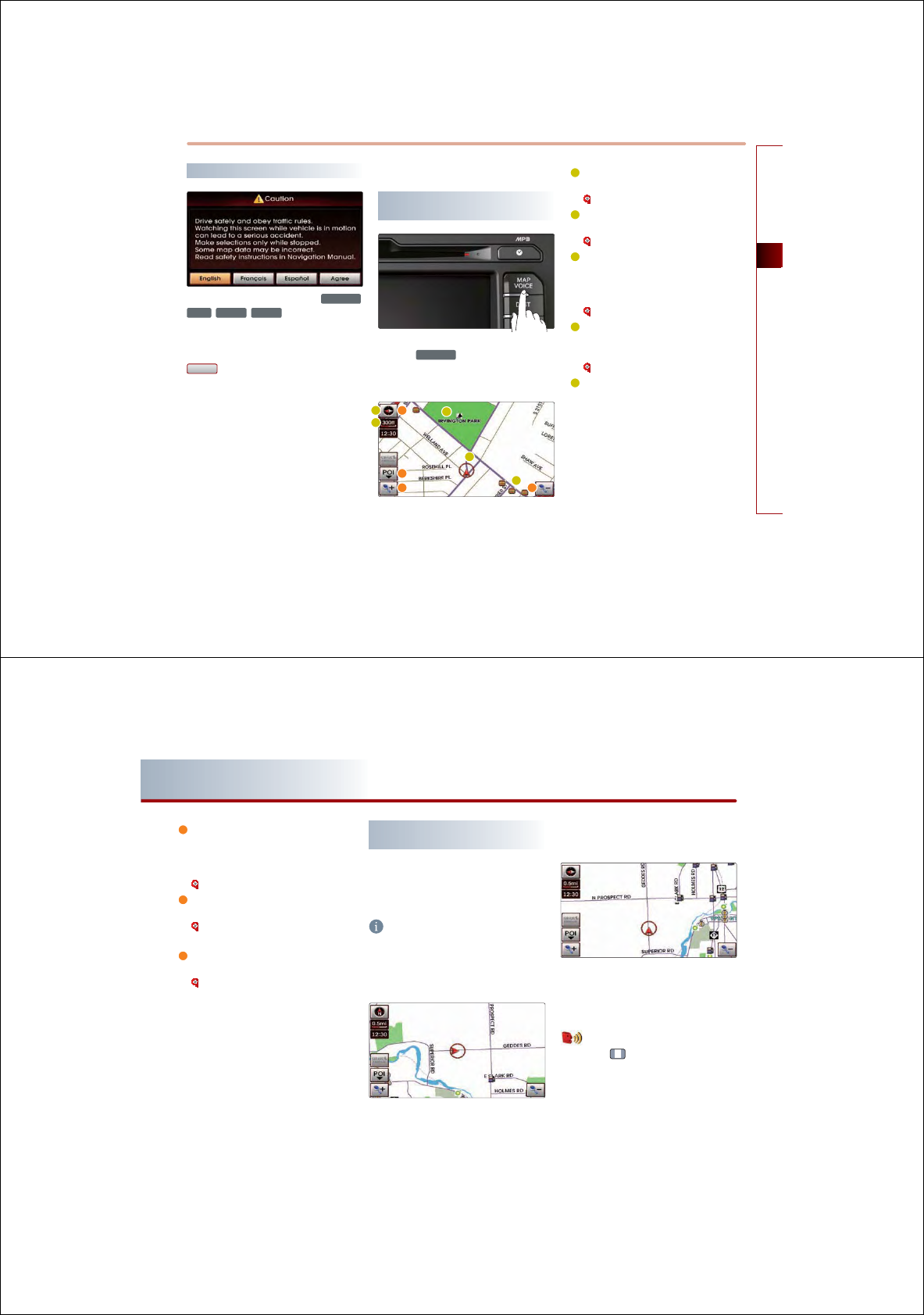
NAVIGATION SYSTEM 3-5
NAVIGATION SYSTEM
Starting navigation system
Press the Navigation mode key (
0$392,&(
,
'(67
,
5287(
,
6(783
). The Caution screen
will always be displayed when first entering
into Navigation mode. Read the contents of
the caution screen carefully and press the
$JUHH
button.
Map Functions
Current position map screen
(without route)
Press the
0$392,&(
key on the control panel
to display the map of current position and the
neighboring area.
GPS signal state indicator : displays the
state of GPS signal reception.
[Viewing GPS signal state], page 3-7.
Map scale level indicator : displays the cur-
rent map scale.
[Changing the map scale], page 3-8.
Landmark icons : landmark icons are dis-
played on the map when the map scale
level is set to under 300 ft (100m depend-
ing on map data)
[Appendix : landmark icons], page 6-5.
POI icons : POI icons are displayed on the
map when the map scale level is set to
under 0.5 mi (800m).
[Appendix : POI icons], page 6-5.
Current vehicle position icon : displays the
current position of the vehicle.
D
E
F F
3-6 NAVIGATION SYSTEM
PART 3 NAVIGATION SYSTEM
D
North Up / Heading Up switch : displays
the current map mode and the map mode
can be switched between North Up and
Heading Up.
[Switching map mode], page 3-6.
E
POI : displays or hides the POI icon on the
map.
[Displaying/Hiding POI icons on the
map], page 3-9.
F
Map scale : increases or decreases the map
scale.
[Changing the map scale], page 3-8.
Switching map mode (North Up /
Heading Up)
Each time the compass button is pressed, the
screen will switch in the order shown below.
Heading Up
ĺ
North Up
ĺ
Heading Up ...
INFORMATION
All map screens (map screen after setting des-
tination & whole route display screen) except
the current position screen will always be dis-
played in North Up mode.
● North Up : displays the map always facing
the North direction regardless of the direc-
tion which the vehicle is traveling.
The vehicle icon is displayed in the center
position of the map.
●
Heading Up : displays the map always fac-
ing the direction which the vehicle is travel-
ing. The vehicle icon is displayed in the
lower center position of the map.
Voice Command
1. Press the key on the steering wheel
remote controller.
2. After the beep sound, say a command.
"North Up"
"Heading Up"
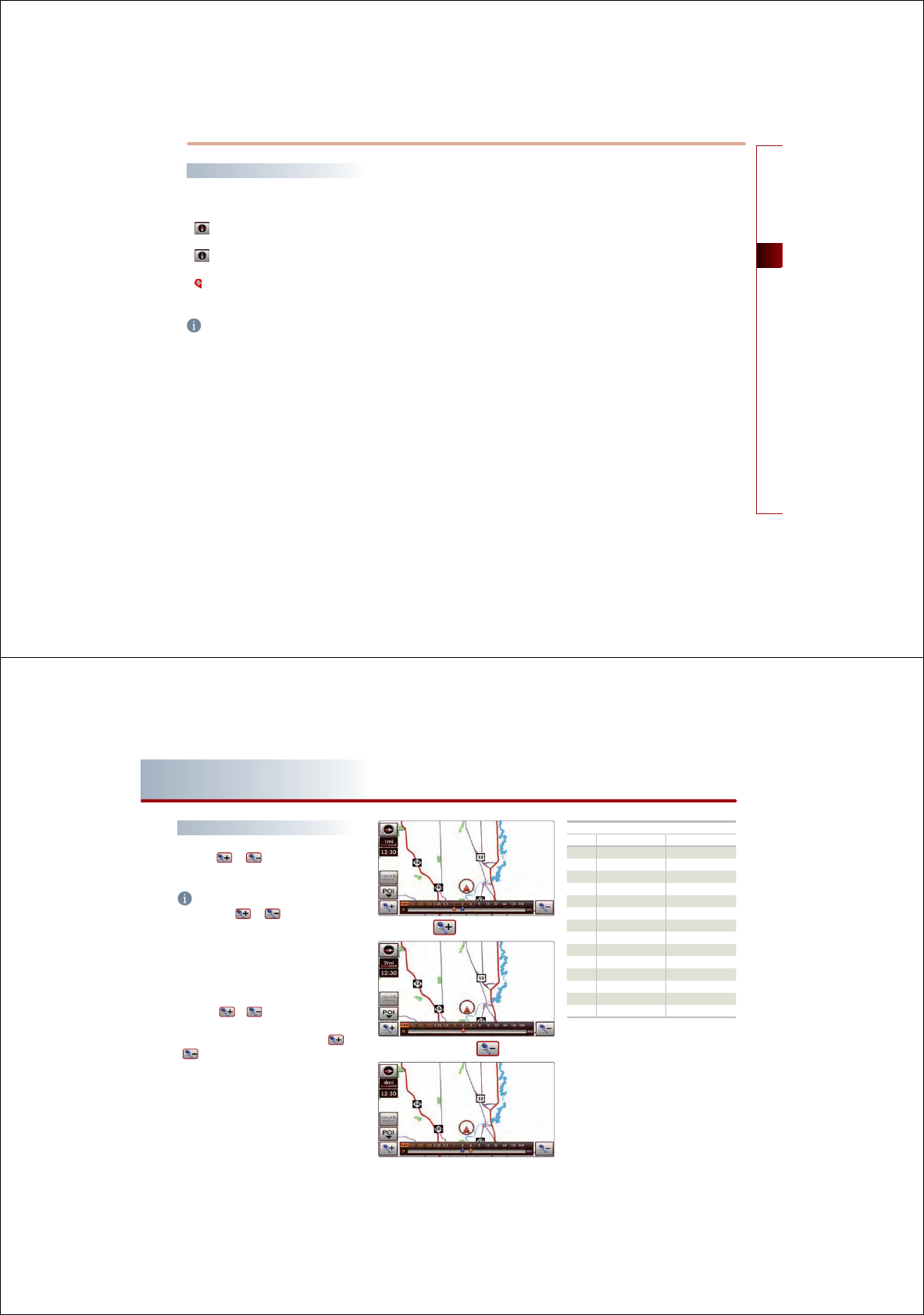
NAVIGATION SYSTEM 3-7
NAVIGATION SYSTEM
Viewing GPS signal state
The state of GPS signal reception is displayed
as shown below.
● (active) :
GPS reception is satisfactory.
● (inactive) :
GPS reception is unsatisfactory.
[System information and update], page
3-51.
INFORMATION
●
GPS (Global Position System) : GPS is a sys-
tem developed and operated by the United
States which determines the current loca-
tion of the user (longitude, latitude, etc.) by
generally using 4 or more satellites. This
system is used with related GPS informa-
tion, various sensors, road map data, and
other navigation related information.
●
GPS information may not operate under the
following conditions.
• When buildings, tunnels, or other obstruc-
tions block satellite signals.
• When materials are placed above the GPS
antenna and block satellite signals.
• When the satellite does not transmit sig-
nals (signal transmission is controlled by
the satellite control center in the United
States and may not transmit when under
repair, modification, etc).
• When a digital cellular phone (1.5GHz) is
placed near the GPS antenna.
●
This system uses GPS information, various
sensors, road map data, and other related
information to display the current position.
Errors may occur if the satellite is transmit-
ting inaccurate signals or only two or less
satellite signals can be received.
Errors which occur in such conditions can-
not be corrected.
3-8 NAVIGATION SYSTEM
PART 3 NAVIGATION SYSTEM
Changing the map scale
Press the or button. The map scale
will be increased or decreased by one level.
INFORMATION
Each time the or button is pressed,
the scale bar will be displayed.
The scale can be changed by directly pressing
the scale level on the scale bar.
The green color on the scale bar indicates the
current scale level while the orange color indi-
cates the selected scale level.
Ɣ
Press the or button for over 0.8 sec-
ond. The scale will continuously change.
Ɣ
If the scale range limit is reached, the or
button will be disabled.
Ɣ The map scale range is between 1 and 14:
10,240,000 ~ 1 : 5,000.
Actual distance
Level
mi / ft km / m
1 150 ft 50 m
2 300 ft 100 m
3 700 ft 200 m
4 0.25 mi 400 m
5 0.5 mi 800 m
6 1 mi 1.6 km
7 2 mi 3.2 km
8 4 mi 6.4 km
9 8 mi 12 km
10 16 mi 25 km
11 32 mi 50 km
12 64 mi 100 km
13 130 mi 200 km
14 250 mi 400 km
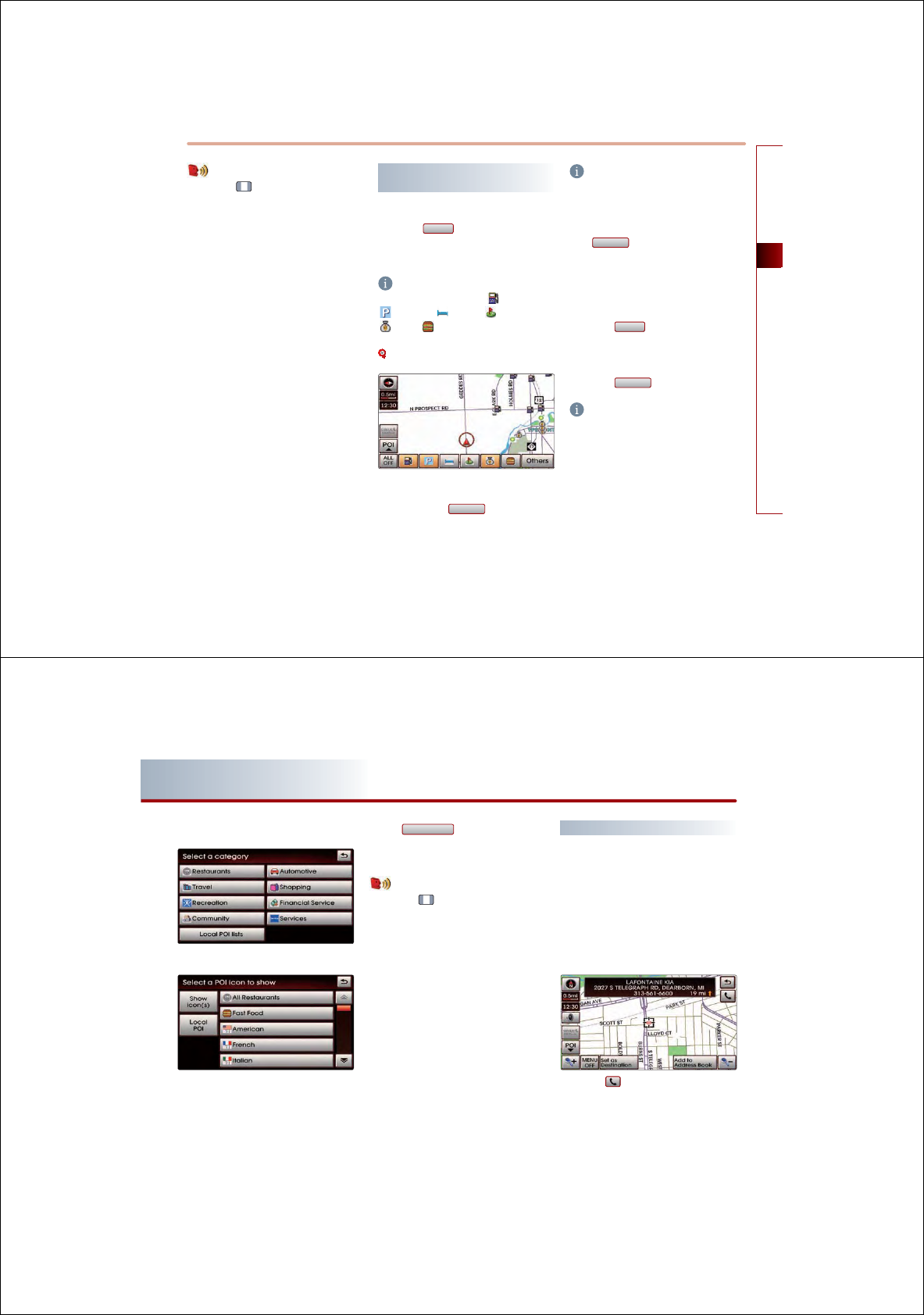
NAVIGATION SYSTEM 3-9
NAVIGATION SYSTEM
Voice Command
1. Press the
key on the steering wheel
remote controller.
2. After the beep sound, say a command.
"Zoom In"
"Zoom Out"
"Zoom Maximum"
"Zoom Minimum"
"Zoom level <1 to 14>"
"Zoom <actual distance>"
" (ex. Zoom 700ft)"
Displaying / Hiding POI icons on
the map
Displaying/Hiding Q.POI icons
1
.
Press the
32,Ԥ
button.
Related menu buttons will be displayed at
the bottom of the screen.
INFORMATION
The Q.POI icons are set to - Gas Station,
- Parking, - Hotel, - Golf Course,
- Bank, - Fast Food (6 icons) by default.
This setting can be changed in SETUP.
[Setting Q.POI icons], page 3-42.
2
.
Press the icon buttons to display or hide.
To turn off all POI icons displayed on the
map, press the
$//2))
button.
INFORMATION
●
The current displayed POI icons are high-
lighted while the icons not being displayed
are shown as normal buttons.
●
If there are no POI icons being displayed,
the
$//2))
button will be disabled.
●
POI icons are displayed when the scale is
under 0.5 mi (800m).
Displaying / Hiding icons other than
Q.POI icons
1
.
Press the
32,
▼
button.
Related menu buttons will be displayed at
the bottom of the screen.
2
.
Press the
2WKHUV
button.
INFORMATION
Q.POI stands for Quick POI and refers to the
function which turns POI icon display on or off
on the map.
3-10 NAVIGATION SYSTEM
PART 3 NAVIGATION SYSTEM
(a) by category list
3
.
Press the desired main category button.
4
.
Select the desired sub category menu to
display or hide (Multiple selections are pos-
sible).
Press the selected menu again to cancel the
selection.
5
.
If the
6KRZ,FRQV
button is pressed, the
selected menus will be displayed or hidden
on the map screen.
Voice Command
1. Press the key on the steering wheel
remote controller.
2. After the beep sound, say a command.
"Show <POI name>" (ex. Show ATM)
"Hide <POI name>" (ex. Hide ATM)
"Hide All"
Making a call to POI
After searching a POI, the POI phone number
information can be used to make a call to the
POI facility.
1
.
Use the various search methods, such as the
map scroll function, Q.POI search function,
and destination search function to search
for a POI.
2
.
Press the button.
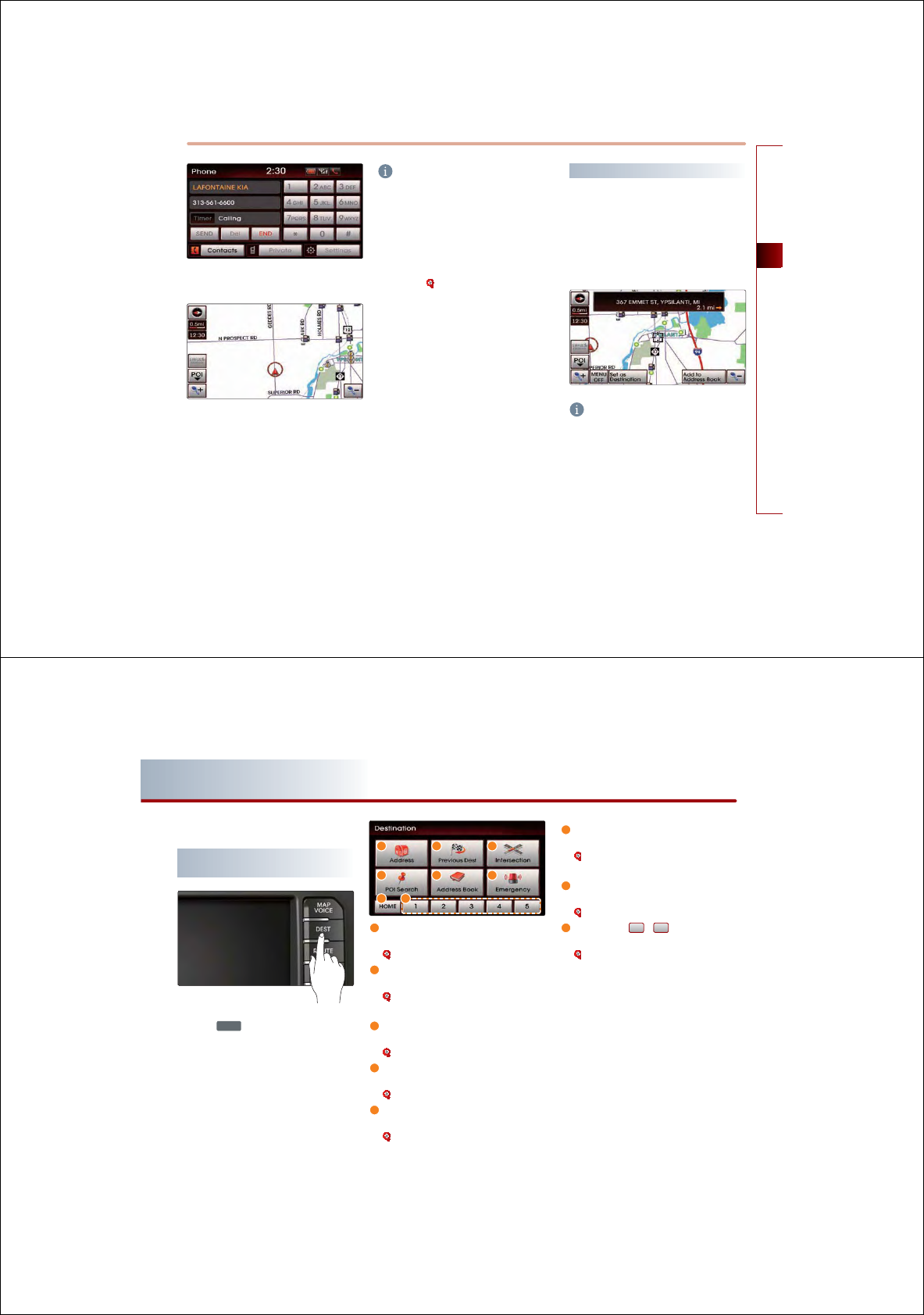
NAVIGATION SYSTEM 3-11
NAVIGATION SYSTEM
3
.
Bluetooth is used to make a call to the POI
facility.
4
.
Once the call is ended, the map is restored
to the current vehicle location.
INFORMATION
●
Making a call is not possible if there is no
telephone information for a POI or if there is
no mobile phone connected through
Bluetooth.
●
For more information of mobile phone
authentication through Bluetooth or
detailed information on conducting search,
refer to [Pairing and connecting
a Bluetooth phone], page 5-4.
Scrolling map
Press the map area on the map screen.
The selected point will be centered on the
screen and the scroll mark will be displayed.
Information about the marked point and
straight line distance from the current posi-
tion will be displayed at the top of the screen.
INFORMATION
If a map area on the map screen is pressed,
the map will continuously scroll in the corre-
sponding direction until the pressing is
released.
3-12 NAVIGATION SYSTEM
PART 3 NAVIGATION SYSTEM
Setting a destination
Destination menu screen and
functions
Press the
'(67
key on the control panel to
display the destination menu screen.
D
Address : sets the destination through
address search.
[Searching an Address], page 3-13.
E
Previous Dest : sets the destination
through the previous destination list.
[Searching a Previous Destination],
page 3-17 .
F
Intersection : sets the destination through
intersection search.
[Searching an Intersection], page 3-17.
G
POI Search : sets the destination through
POI Category search.
[Searching a POI], page 3-20 .
H
Address Book : sets the destination
through address book search.
[Searching from Address book], page
3-24 .
I
Emergency : sets the destination through
emergency facilities search.
[Searching for Emergency facilities],
page 3-25 .
J
HOME : sets the stored HOME as the desti-
nation.
[Searching your Home], page 3-25 .
K Favorite place
~
: sets the destina-
tion with one of the stored favorite places.
[Searching favorite places], page 3-26 .
D
G
JK
E
H
F
I
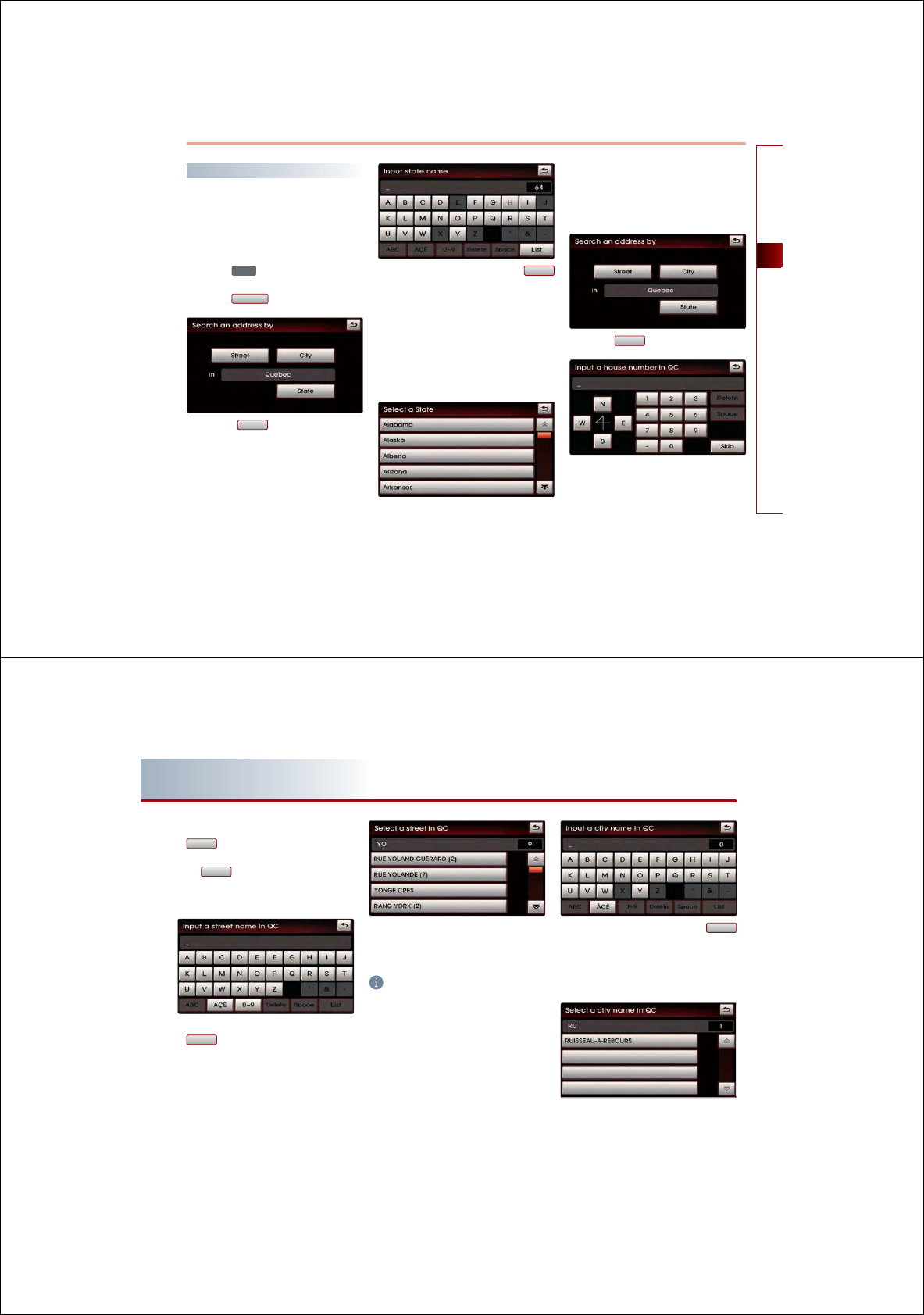
NAVIGATION SYSTEM 3-13
NAVIGATION SYSTEM
Searching a Destination
Searching an Address
There are 2 ways to set the destination
through address search-(a) by street, (b) by
city.
1
.
Press the
'(67
key.
2
.
Press the
$GGUHVV
button.
3
.
Press the
6WDWH
button to change the
state.
4
.
Input the State name and press the
/LVW
button.
If the number of matches with the input is
less than 4 results, then the state list screen
will be displayed automatically.
If the number of matches is only one result,
then the state will automatically be
changed without having to manually select
the state.
5
.
Select the desired state from the list to
change the state.
(a) by street
6
.
Press the
6WUHHW
button.
3-14 NAVIGATION SYSTEM
PART 3 NAVIGATION SYSTEM
7
.
Input the House number and Press the
'RQH
button to complete.
If the House number is not recognized, press
the
6NLS
button.
In this case, the range of house numbers
will be displayed during the last step.
8
.
Input the Street name and press the
/LVW
button.
If the number of matches with the input is
less than 4 results, then the street list screen
will be displayed automatically.
9
.
If the desired street from the list is selected,
the corresponding position will be dis-
played on the map.
INFORMATION
If more than 30 cities exist with the selected
street, then the city input screen will be dis-
played. If less than 30 cities exist, then the city
selection screen will be displayed.
10
.
Input the city name and press the
/LVW
button to complete. If the number of
matches with the input is less than 4
results, then the list screen will be dis-
played automatically.
11.Select the desired city from the list.
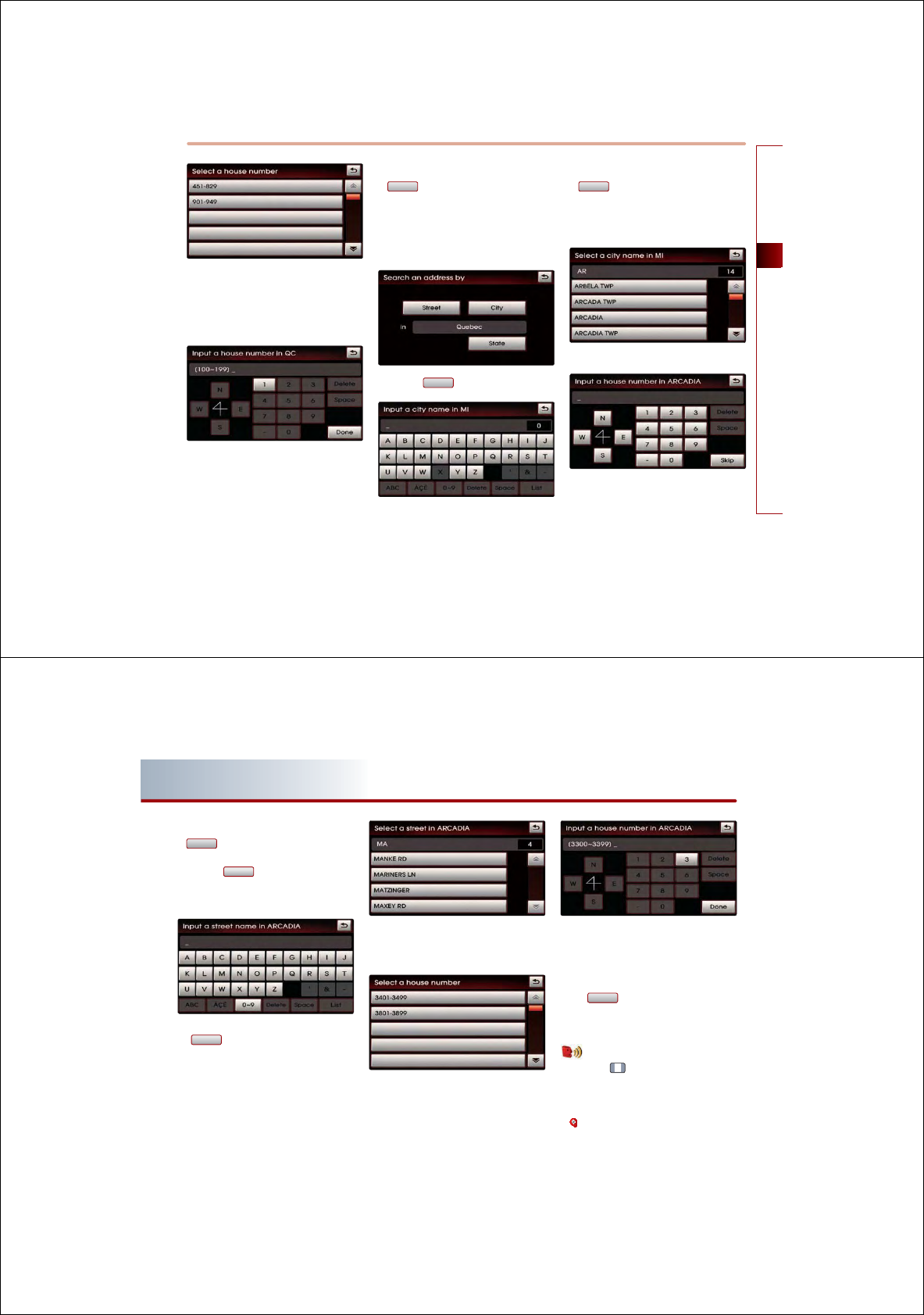
NAVIGATION SYSTEM 3-15
NAVIGATION SYSTEM
12
.
This screen will be displayed if the House
number had not been inputted during
step 6 and more than 2 house numbers
ranges exist.
Select the desired House number range.
13
.
This screen will be displayed if the House
number had not been inputted and only
one house numbers range exists.
Input the House number and press the
'RQH
button to complete.
The corresponding position will be dis-
played on the map.
(b) by city
6
.
Press the
&LW\
button.
7
.
Input the city name and press and press the
/LVW
button.
If the number of matches with the input is
less than 4 results, then the city list screen
will be displayed automatically.
8
.
Select the desired city from the list.
3-16 NAVIGATION SYSTEM
PART 3 NAVIGATION SYSTEM
9
.
Input the house number and press the
'RQH
button to complete.
If the House number is not recognized,
press the
6NLS
button.
In this case, the range of house numbers
will be displayed during the last step.
10
.
Input the Street name and press the
/LVW
button to complete.
If the number of matches with the input is
less than 4 results, then the street list screen
will be displayed automatically.
11
.
Select the desired street from the list and
the corresponding position will be dis-
played on the map.
12
.
This screen will be displayed if the House
number had not been inputted during
step 8 and more than 2 House number
ranges exist.
Select the desired House number range.
13
.
This screen will be displayed if the House
number had not been inputted during
step
H
and only one House number
range exists.
Select the house number range and Press
the
'RQH
button to complete.
The corresponding position will be dis-
played on the map.
Voice Command
1. Press the
key on the steering wheel
remote controller.
2. After the beep sound, say a command.
"Find address"
[Find address], page 5-19.
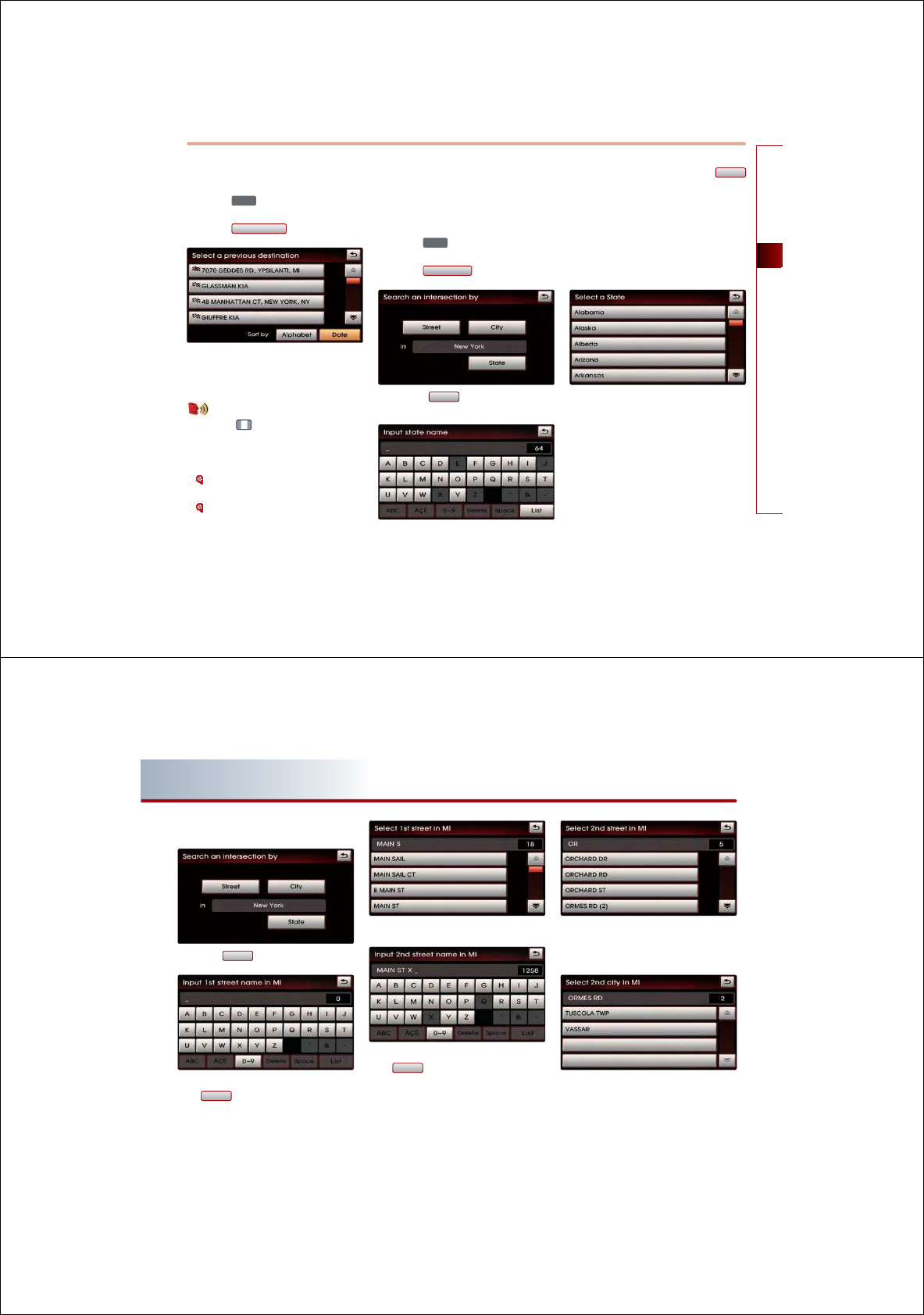
NAVIGATION SYSTEM 3-17
NAVIGATION SYSTEM
Searching a Previous Destination
1
.
Press the
'(67
key.
2
.
Press the
3UHYLRXV'HVW
button.
3
.
Select the desired previous destination. The
corresponding position will be displayed on
the map.
Voice Command
1. Press the
key on the steering wheel
remote controller.
2. After the beep sound, say a command.
"Previous destination"
[Previous destination], page 5-24.
"Previous start point"
[Previous start point], page 5-25.
Searching an Intersection
There are two ways to set the destination
through intersection search-(a) by street, (b)
by city.
1
.
Press the
'(67
key.
2
.
Press the
,QWHUVHFWLRQ
button.
3
.
Press the
6WDWH
button to change the
state.
4
.
Input the state name and press the
/LVW
button. If the number of matches with the
input is less than 4 results, then the state
list screen will be displayed automatically.
If the number of matches is only one result,
then the state will automatically be
changed without having to manually select
the state.
5
.
Select the desired state from the list to
change the state.
3-18 NAVIGATION SYSTEM
PART 3 NAVIGATION SYSTEM
(a) by street
6
.
Press the
6WUHHW
button.
7
.
Input the name of the 1st street and press
the
/LVW
button.
If the number of matches with the input is
less than 4 results, then the street list screen
will be displayed automatically.
8
.
Select the desired 1st street from the list.
9
.
Input the name of the 2nd street and press
the
/LVW
button.
If the number of matches with the input is
less than 4 results, then the street list screen
will be displayed automatically.
10
.
Select the desired 2nd street menu from
the list. The corresponding position will be
displayed on the map.
11
.
If the selected 2nd street is within more
than 2 cities, then the city list screen will
be displayed.
Select the desired city menu from the list.
The corresponding position will be dis-
played on the map.
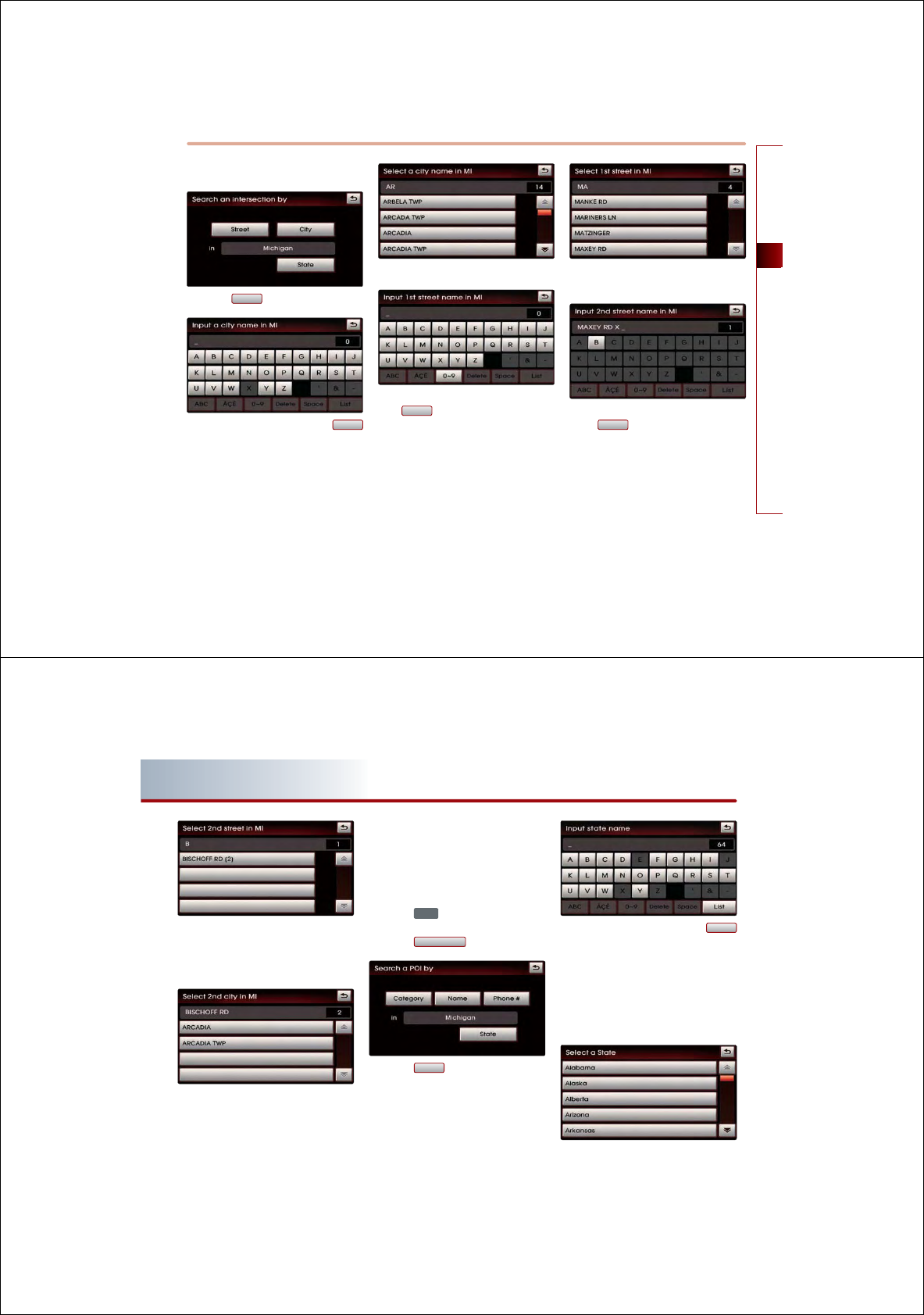
NAVIGATION SYSTEM 3-19
NAVIGATION SYSTEM
(b) by city
6
.
Press the
&LW\
button.
7
.
Input the city name and press the
/LVW
button.
If the number of matches with the input is
less than 4 results, then the city list screen
will be displayed automatically.
8
.
Select the desired city name.
9
.
Input the name of the 1st street and press
the
/LVW
button.
If the number of matches with the input is
less than 4 results, then the street list screen
will be displayed automatically.
10
.
Select the desired 1st street menu from
the list.
11
.
Input the name of the 2nd street and press
the
/LVW
button.
If the number of matches with the input is
less than 4 results, then the street list
screen will be displayed automatically.
3-20 NAVIGATION SYSTEM
PART 3 NAVIGATION SYSTEM
12
.
Select the desired 2nd street menu from
the list.
The corresponding position will be dis-
played on the map.
13
.
If the selected 2nd street is within more
than 2 cities, then the city list screen will
be displayed. Select the desired city menu
from the list. The corresponding position
will be displayed on the map.
Searching a POI
There are 3 ways to set the destination
through POI search - (a) by category, (b) by
name, (c) by phone number.
1
.
Press the
'(67
key.
2
.
Press the
32,6HDUFK
button.
3
.
Press the
6WDWH
button.
4
.
Input the state name and press the
/LVW
button. If the number of matches with the
input is less than 4 results, then the state list
screen will be displayed automatically.
If there is only one matching result, then
the state will automatically be changed
without having to manually select the state.
5
.
Select the desired state from the list to
change the state.
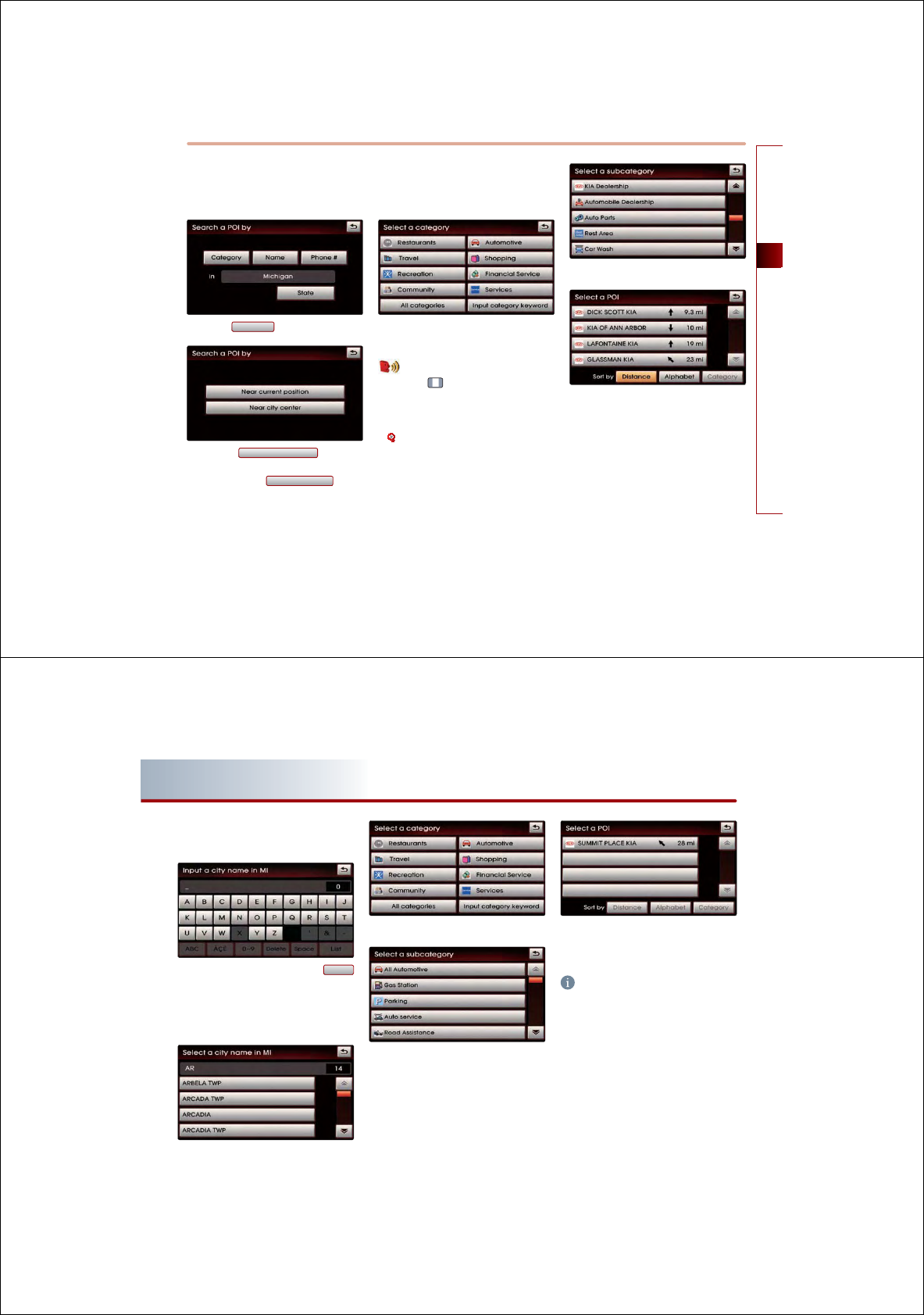
NAVIGATION SYSTEM 3-21
NAVIGATION SYSTEM
(a) By category
Searches for facilities nearby the current posi-
tion or from the city center.
6
.
Press the
&DWHJRU\
button.
7
.
Press the
1HDUFXUUHQWSRVLWLRQ
button to
search for facilities nearby the current posi-
tion, or press the
1HDUFLW\FHQWHU
button
to search for facilities in the near city center.
(a-1) Near current position
Searches for facilities within a 50 mi (80Km)
radius of the current position.
8
.
Press the desired main category menu.
Voice Command
1. Press the
key on the steering wheel
remote controller.
2. After the beep sound, say a command.
"Find nearest POI"
[Find nearest POI], page 5-20.
9
.
Press the desired sub category menu.
10
.
Select the desired menu button.
The corresponding position will be dis-
played on the map.
3-22 NAVIGATION SYSTEM
PART 3 NAVIGATION SYSTEM
(a-2) Near city center
Searches for facilities from the city center.
8
.
Input the city name and press the
/LVW
button.
If the number of matches with the input is
less than 4 results, then the city list screen
will be displayed automatically.
9
.
Press the desired city menu.
10
.
Press the desired main category.
11
.
Press the desired sub category.
12
.
Select the desired menu button.
The corresponding position will be dis-
played on the map.
INFORMATION
The distance on each POI item button refers
to the distance from the city center.
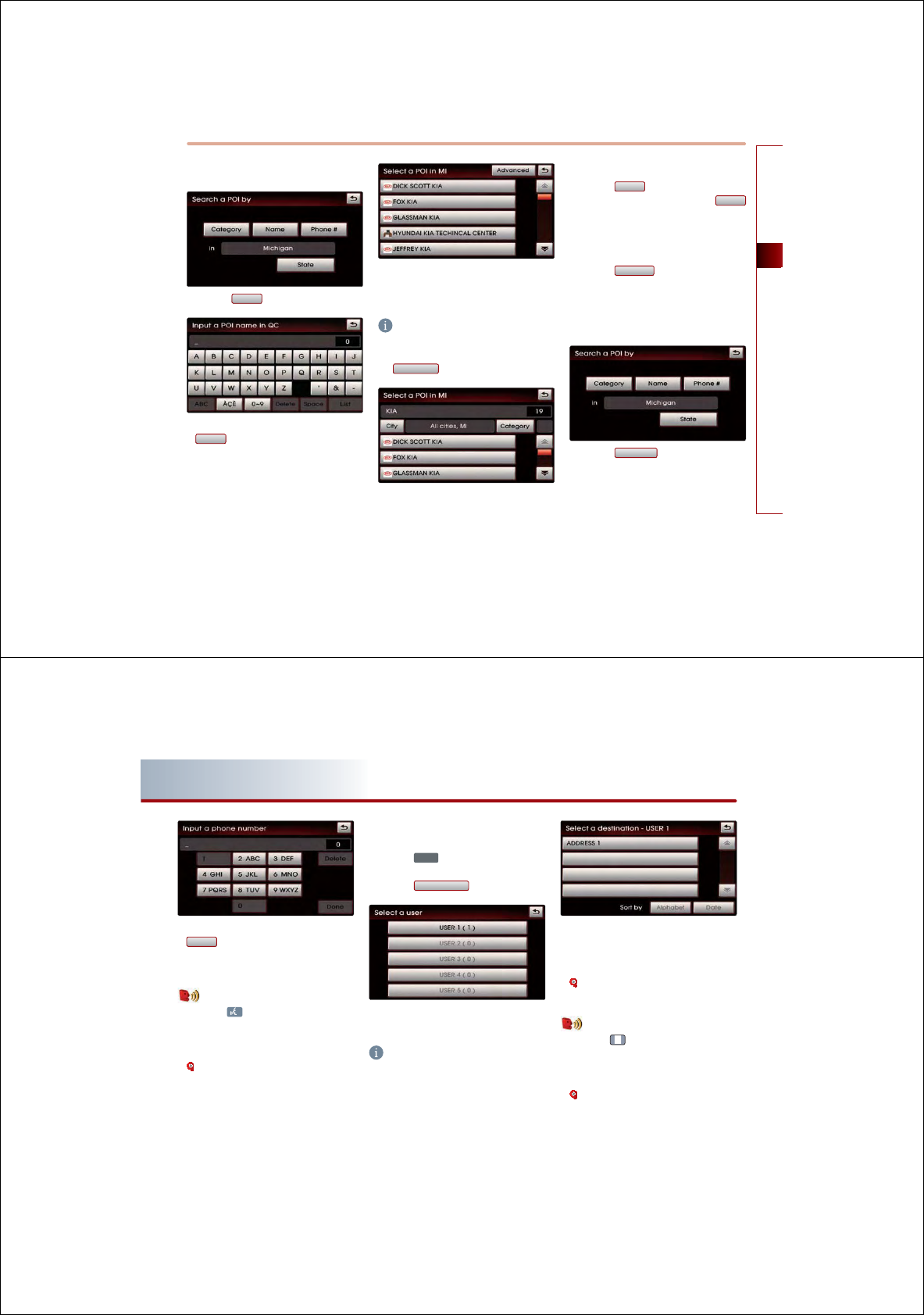
NAVIGATION SYSTEM 3-23
NAVIGATION SYSTEM
(b) By name
6
.
Press the
1DPH
button.
7
.
Input the name of the POI and press the
/LVW
button.
If the number of matches with the input is
less than 4 results, then the facilities list
screen will be displayed automatically.
8
.
Select the desired POI menu.
The corresponding position will be dis-
played on the map.
INFORMATION
When necessary, the search conditions for the
city and category can be changed by pressing
the
$GYDQFHG
button.
●Changing City
1
.
Press the
&LW\
button.
2
.
Input the city name and press the
/LVW
button.
3
.
Select the desired city name.
●Changing Category
1
.
Press the
&DWHJRU\
button.
2
.
Select the desired main category menu.
3
.
Select the desired sub category menu.
(c) By phone number
6
.
Press the
3KRQH
button.
3-24 NAVIGATION SYSTEM
PART 3 NAVIGATION SYSTEM
7
.
Input the phone number and Press the
'RQH
button to complete.
The corresponding position will be dis-
played on the map.
Voice Command
1. Press the
key on the steering wheel
remote controller.
2. After the beep sound, say a command.
"Destination POI by Phone Number"
[Destination POI by phone number],
page 5-22.
Searching from Address book
1
.
Press the
'(67
key.
2
.
Press the
$GGUHVVERRN
button.
3
.
Select the desired address book (user)
menu.
INFORMATION
This system provides 5 address books. Each
addresses book can hold up to 200 entries.
4
.
Select the desired address name from the
list.
The corresponding position will be
displayed on the map.
[Registering new address in address
book], page 3-43.
Voice Command
1. Press the
key on the steering wheel
remote controller.
2. After the beep sound, say a command.
"Destination by address book"
[Destination by address book], page
5-24.
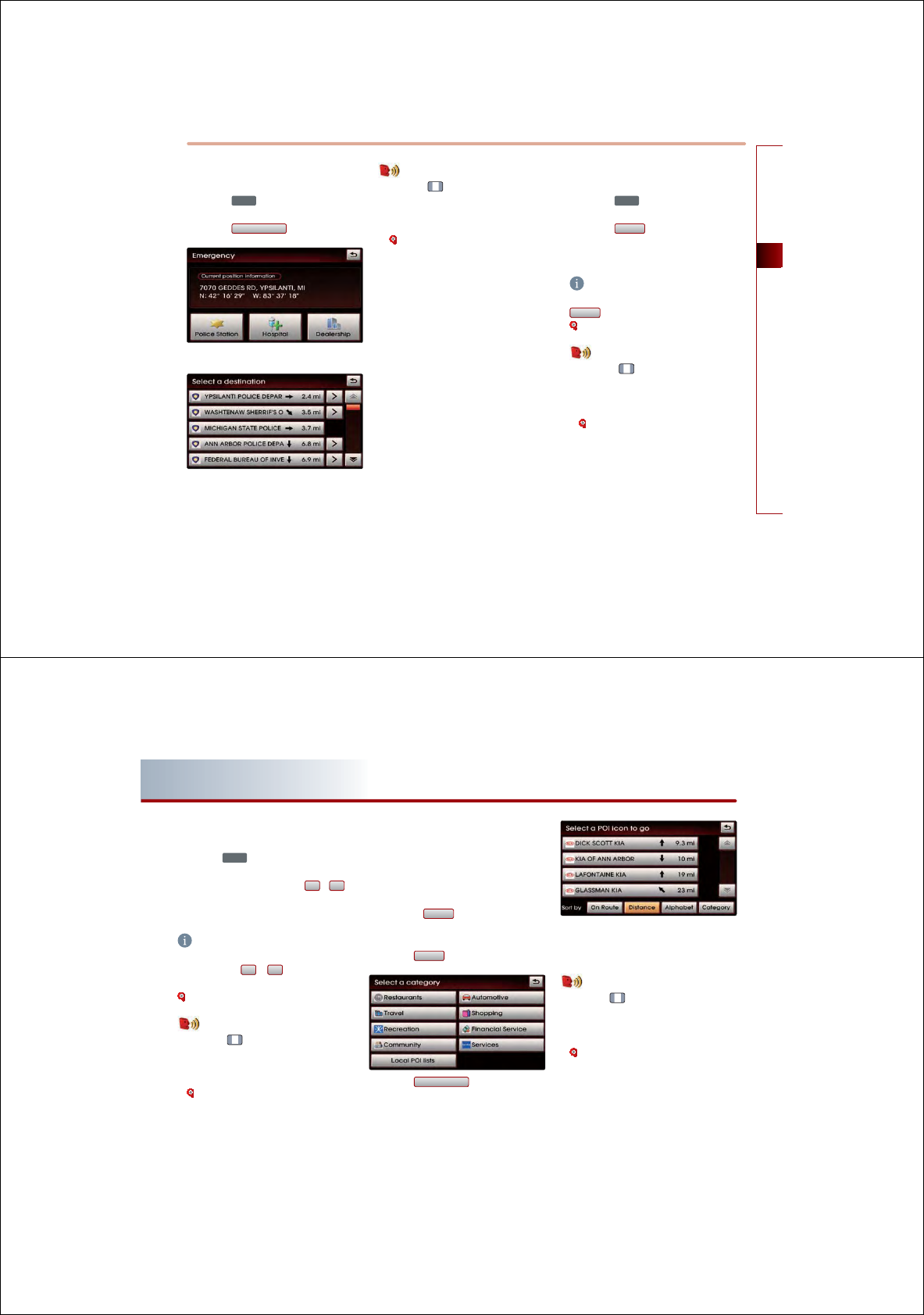
NAVIGATION SYSTEM 3-25
NAVIGATION SYSTEM
Searching for Emergency facilities
1
.
Press the
'(67
key.
2
.
Press the
(PHUJHQF\
button.
3
.
Select the desired facility category.
4
.
Select the desired facility.
The corresponding position will be dis-
played on the map.
Voice Command
1. Press the key on the steering wheel
remote controller.
2. After the beep sound, say a command.
"Find emergency <Category>"
[Find emergency <Category>], page
5-23.
Searching your Home
1
.
Press the
'(67
key.
2
.
Press the
+20(
button.
The Home position will be displayed on
the map.
INFORMATION
If the Home address is not registered, then the
+20(
button will not be displayed.
[Registering home address], page 3-48.
Voice Command
1. Press the key on the steering wheel
remote controller.
2. After the beep sound, say a command.
"Go home"
[Go home], page 5-25.
3-26 NAVIGATION SYSTEM
PART 3 NAVIGATION SYSTEM
Searching favorite places
1
.
Press the
'(67
key.
2.
Select the desired button from
~
.
The corresponding position will be dis-
played on the map.
INFORMATION
If the address of the Favorite place is not regis-
tered, then the
~
buttons without
registered addresses will be disabled.
[Registering favorite place], page 3-49.
Voice Command
1. Press the key on the steering wheel
remote controller.
2. After the beep sound, say a command.
"Destination by memory point <1 to 5>"
[Destination by memory point <1 to 5>],
page 5-25.
Searching from MAP
Position the scroll mark at the destination by
scrolling the map on the map screen.
Searching POI by local POI list
1
.
Press the
32,
▼ button on the map
screen.
2
.
Press the
2WKHUV
button.
3
.
Press the
/RFDO32,OLVWV
button.
4
.
Select the desired POI menu.
The corresponding position will be dis-
played on the map.
Voice Command
1. Press the key on the steering wheel
remote controller.
2. After the beep sound, say a command.
"Find nearest <POI name>"
[Find nearest <POI name>], page 5-21.
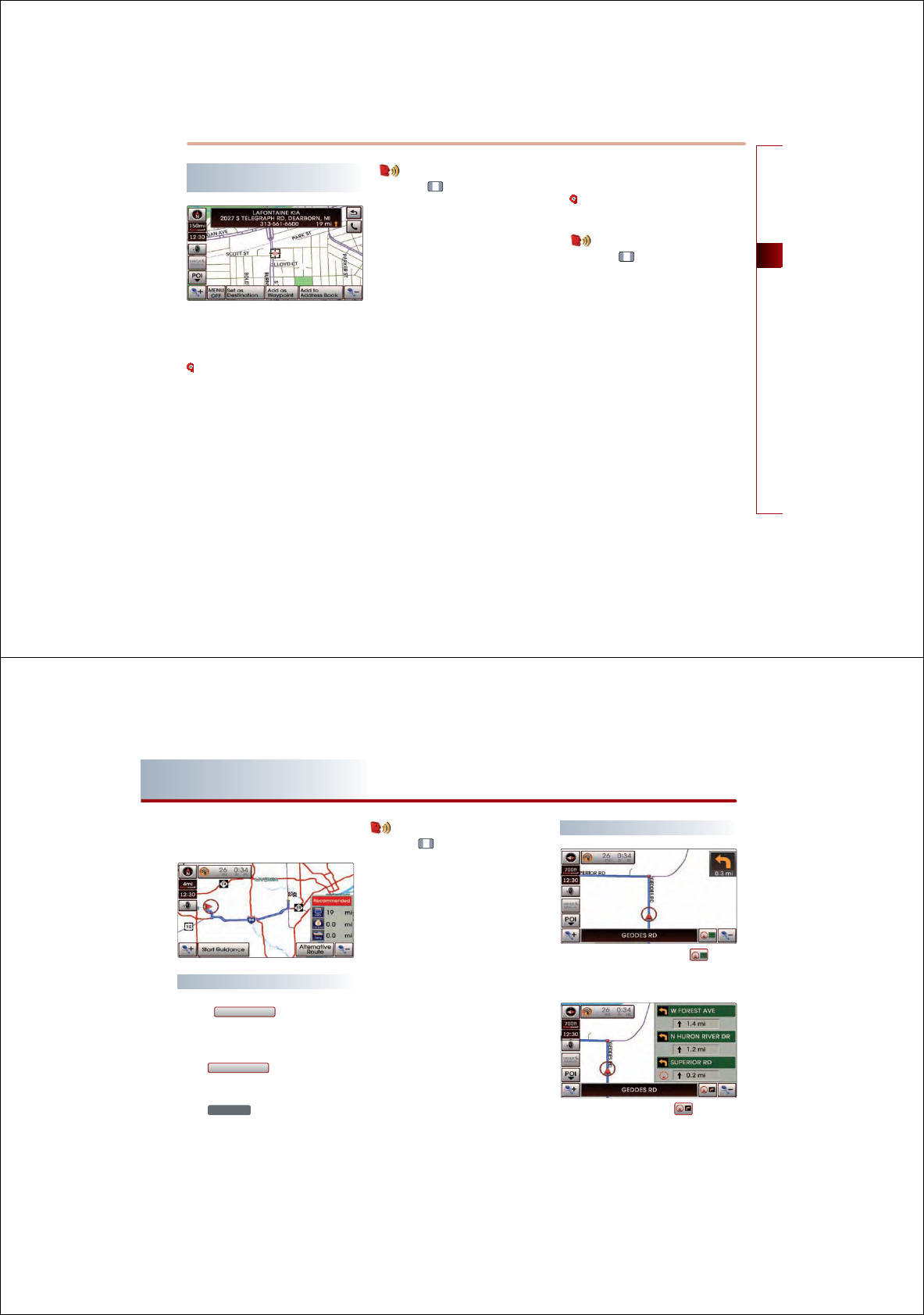
NAVIGATION SYSTEM 3-27
NAVIGATION SYSTEM
Operating after searching a
destination
Changing destination position :
Changes the position of the destination by
scrolling the map.
[Scrolling map], page 3-11.
Setting as Destination / waypoint :
Sets the position as the destination or way-
point.
Voice Command
1. Press the key on the steering wheel
remote controller.
2. After the beep sound, say a command.
"Start guidance"
(Sets the position of the scroll mark as the
destination and begins route guidance.)
Adding to address book :
Saves the position in the address book.
[Registering new address in address book],
page 3-43.
Voice Command
1. Press the key on the steering wheel
remote controller.
2. After the beep sound, say a command.
"Store Marked Location to <text tag>"
3-28 NAVIGATION SYSTEM
PART 3 NAVIGATION SYSTEM
Operating after setting a
destination
Starting Route Guidance
Press the
6WDUW*XLGDQFH
button. Route Guid-
ance will start.
●Route simulation
• If the
6WDUW*XLGDQFH
button is pressed and
held for over 0.8 second, then the route
simulation will start.
• If the
0$392,&(
key on the control panel is
pressed during route simulation, then route
simulation will be terminated.
Voice Command
1. Press the key on the steering wheel
remote controller.
2. After the beep sound, say a command.
"Time to destination"
"Distance to destination"
Route guidance screen
● Symbol guidance mode : if the button
is pressed, then the following route guid-
ance screen will be displayed.
● Turn-List mode : if the button is
pressed, then the following route guidance
screen will be displayed.
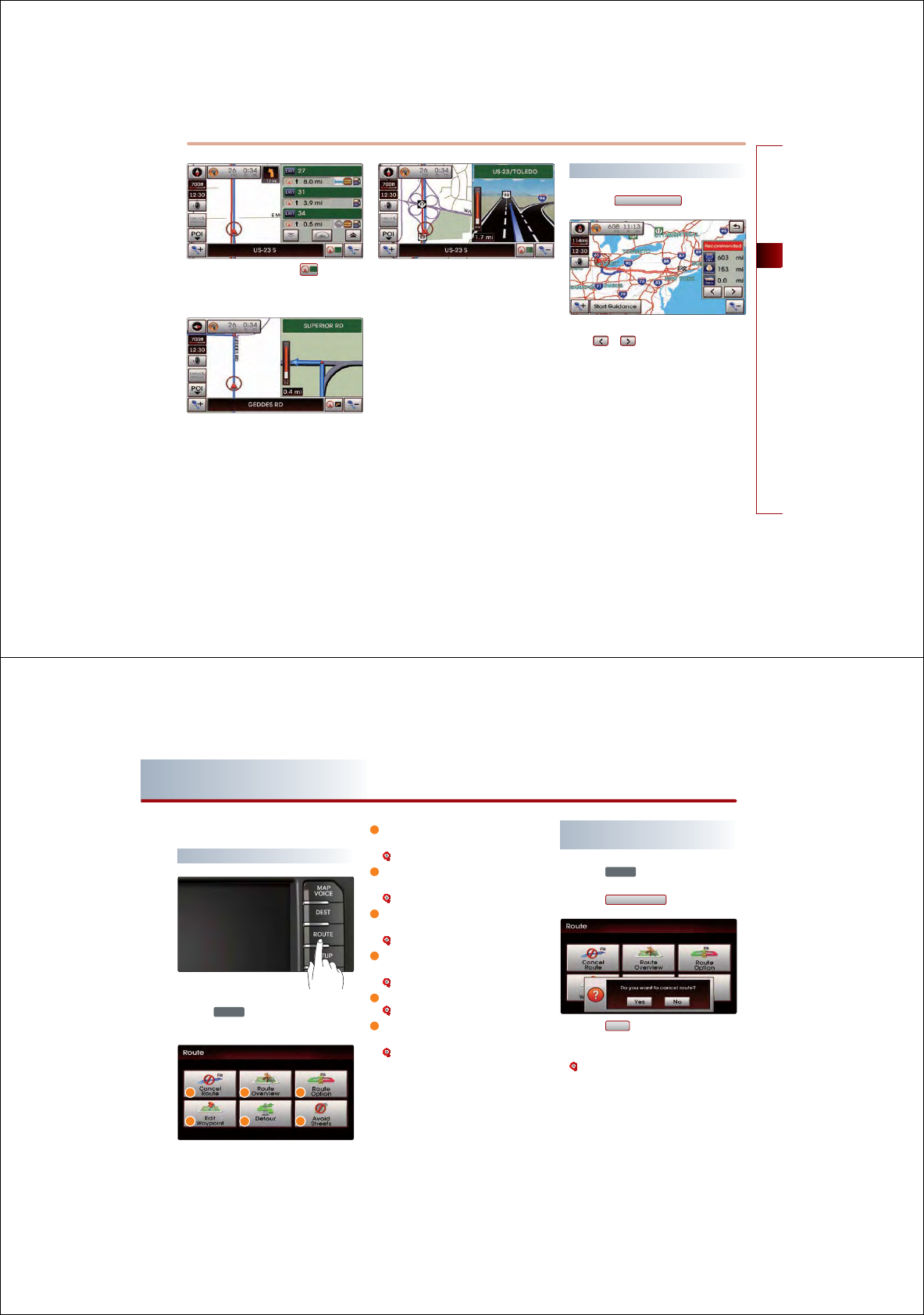
NAVIGATION SYSTEM 3-29
NAVIGATION SYSTEM
● Highway mode : if the button is
pressed, then the following route guidance
screen will be displayed.
● Intersection zoom mode : this route guidance
screen is automatically displayed during
guidance at an intersection.
Once guidance at the intersection is com-
plete, the screen will automatically disappear
and the previous guidance screen will be
restored.
● Highway junction mode : this route guid-
ance screen is automatically displayed dur-
ing guidance at highway junctions.
Once guidance at a highway junction is
complete, this screen will automatically dis-
appear and the previous guidance screen
will be restored.
Selecting other route
1
.
Press the
$OWUHQDWLYH5RXWH
button.
2
.
Other routes can be selected by pressing
the or buttons.
3-30 NAVIGATION SYSTEM
PART 3 NAVIGATION SYSTEM
Route guidance
Route menu screen and functions
Press the
5287(
key on the control panel.
The ROUTE menu screen will be displayed.
D
Cancel Route: deletes destination, way-
points and terminates route guidance.
[Finishing route guidance], page 3-30 .
E
Route Overview: displays the entire route
and route detailed.
[Route overview], page 3-31 .
F
Route Option: the route option can be
changed.
[Changing Route option], page 3-32 .
G
Edit Waypoint: waypoints can be added/
deleted and the order can be changed.
[Editing waypoints], page 3-32 .
H
Detour : searches detour routes.
[Setting detour distance], page 3-35 .
I
Avoid Streets: searches routes which avoid
the selected streets.
[Setting avoid streets on route], page
3-35.
Finishing route guidance (Delete
Destination)
1
.
Press the
5287(
key.
2
.
Press the
&DQFHO5RXWH
button.
3
.
Press the
<HV
button.
The destination and waypoints are deleted
and the route guidance is terminated.
[Finishing route guidance], page 3-30 .
D
G
E
H
F
I
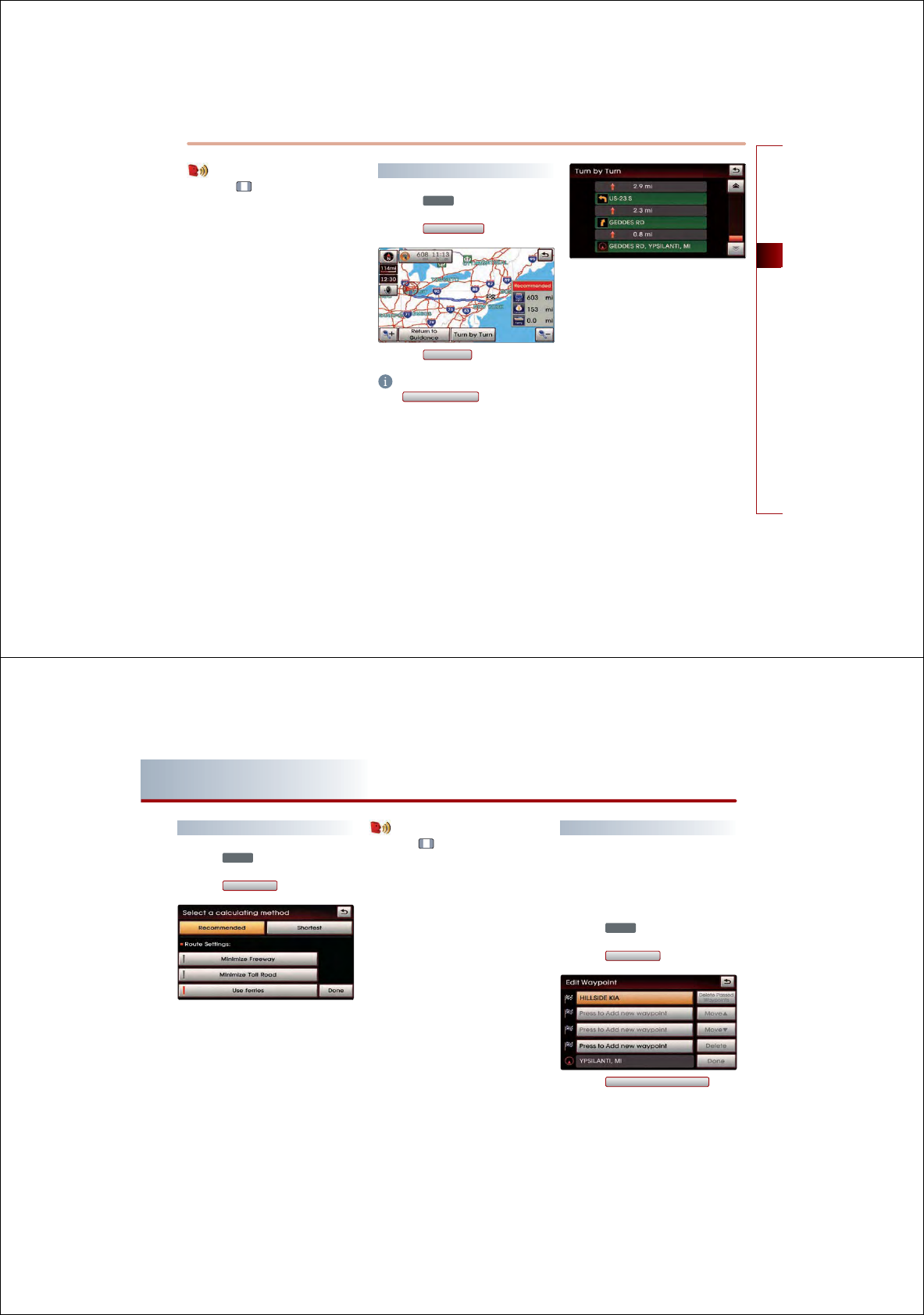
NAVIGATION SYSTEM 3-31
NAVIGATION SYSTEM
Voice Command
1. Press the key on the steering wheel
remote controller.
2. After the beep sound, say a command.
"Cancel route"
(Terminates route guidance and deletes the
set destination and waypoints.)
Route overview (View Entire Route)
1
.
Press the
5287(
key.
2
.
Press the
5RXWH2YHUYLHZ
button.
3
.
Press the
7XUQE\7XUQ
button.
INFORMATION
If the
5HWXUQWRJXLGDQFH
button is pressed,
route guidance screen is displayed.
4
.
The detailed route information can be
viewed
3-32 NAVIGATION SYSTEM
PART 3 NAVIGATION SYSTEM
Changing Route option
1
.
Press the
5287(
key.
2
.
Press the
5RXWH2SWLRQ
button.
3
.
Press the button for the desired route guid-
ance method.
Guidance will be restarted after recalculat-
ing the route with the selected guidance
method.
Voice Command
1. Press the key on the steering wheel
remote controller.
2. After the beep sound, say a command.
"Replan recommended route"
"Replan shortest route"
Editing waypoints
Adding waypoints
There are 2 ways to add waypoints - (a)
searching for POI nearest to the route, (b)
using advanced search.
1
.
Press the
5287(
key.
2
.
Press the
(GLW:D\SRLQW
button.
3
.
Press the
3UHVVWRDGGQHZZD\SRLQW
but-
ton.
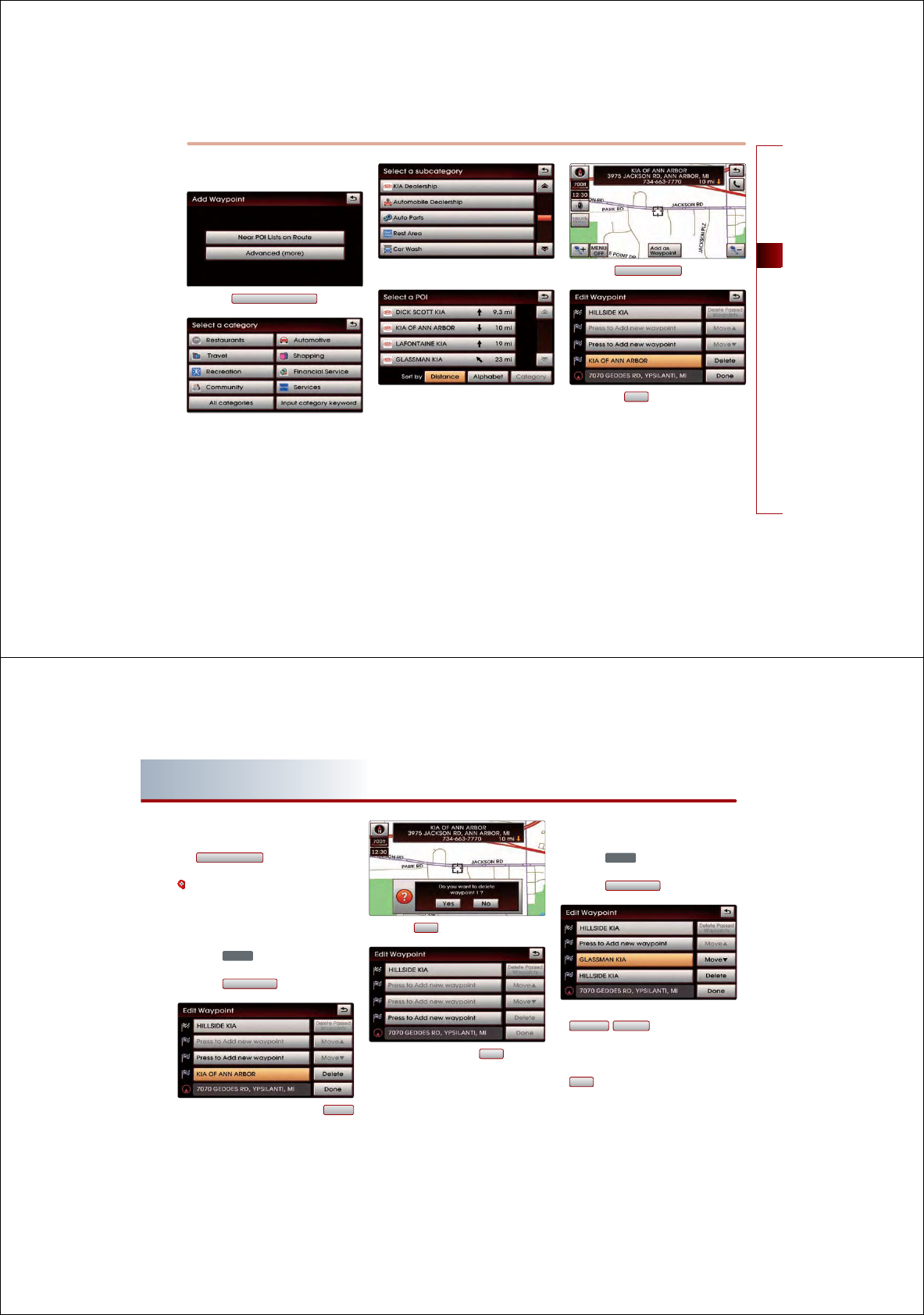
NAVIGATION SYSTEM 3-33
NAVIGATION SYSTEM
(a) Searching POI lists near route
4
.
Press the
1HDU32,/LVWVRQ5RXWH
button.
5
.
Select the desired category.
6
.
Select the desired sub category from list.
7
.
Select the desired POI from the list.
The corresponding position will be dis-
played on the map.
8
.
Press the
$GGDV:D\SRLQW
button.
9
.
Press the
'RQH
button to complete.
Guidance will restart after recalculating the
route.
3-34 NAVIGATION SYSTEM
PART 3 NAVIGATION SYSTEM
(b) Using advanced Search
The method for searching waypoints through
the
$GYDQFHGPRUH
button is the same
method as searching destination.
[Searching a Destination], page 3-13.
Deleting waypoints
1
.
Press the
5287(
key.
2
.
Press the
(GLWZD\SRLQW
button.
3
.
Select the waypoint and press the
'HOHWH
button.
4
.
Press the
<HV
button.
5
.
After deleting, press the
'RQH
button to
complete.
Guidance will be restart after recalculating
the route.
Re-ordering waypoints
1
.
Press the
5287(
key.
2
.
Press the
(GLWZD\SRLQW
button.
3
.
Select the desired waypoint and use the
0RYH
▲
,
0RYH
▼
buttons to change the
order.
4
.
Once re-ordering is complete, press the
'RQH
button to complete.
Guidance will restart after recalculating the
route.
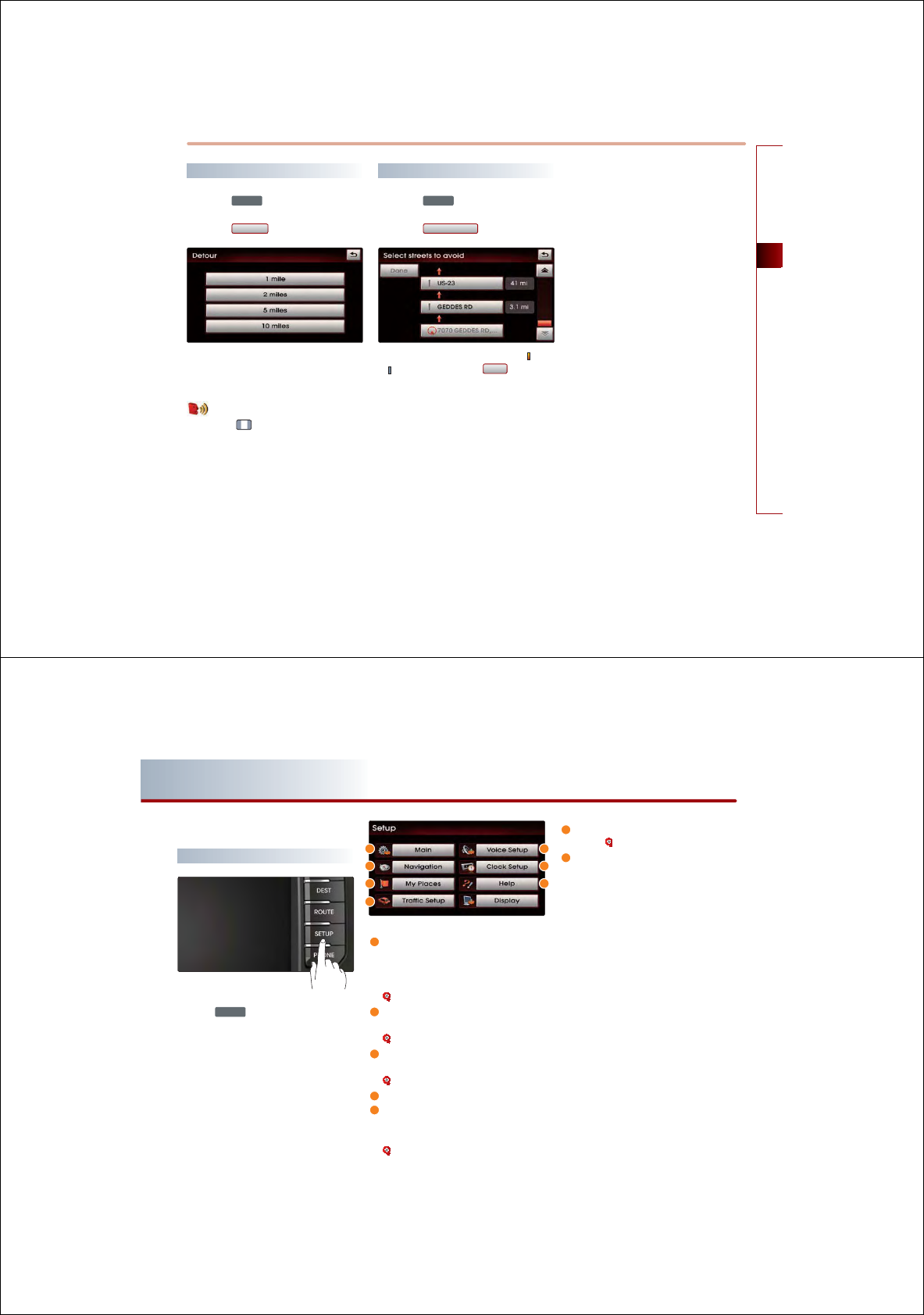
NAVIGATION SYSTEM 3-35
NAVIGATION SYSTEM
Setting detour distance
1
.
Press the
5287(
key.
2
.
Press the
'HWRXU
button.
3
.
Select the desired detour range.
Guidance will restart after recalculating the
detour route.
Voice Command
1. Press the key on the steering wheel
remote controller.
2. After the beep sound, say a command.
"Detour <1 or 2 or 5 or 10> miles"
"Detour <1 or 2 or 5 or 10> kilometers"
Setting avoid streets on route
1
.
Press the
5287(
key.
2
.
Press the
$YRLGVWUHHWV
button.
3
.
Select the desired streets to avoid( avoid,
allow) and press the
'RQH
button to
complete.
Guidance will restarted after recalculating
the route to avoid the selected streets.
3-36 NAVIGATION SYSTEM
PART 3 NAVIGATION SYSTEM
Setup and Information
Setup menu screen and functions
Press the
6(783
key on the control panel to
display the setup menu screen.
D
Main button : changes to the input key-
board type, voice command feedback ON/
OFF settings and system initialization can
be made.
[Main setting], page 3-36 .
E
Voice Setup button : adjusts the
Navigation guidance volume.
[Voice guidance volume setting], page 3-51.
F
Navigation button : navigation related set-
tings can be set.
[Navigation setting], page 3-38 .
G
Clock Setup button
H
My Places button : the Address book,
Home address, Favorite places, Previous
destination can be edited.
[My places setting], page 3-43 .
I
Help button : the help contents can be
viewed. [Help], page 3-54 .
J
Traffic Setup : sets to display traffic infor-
mation on map, or to provide upcoming
traffic information voice guidance, and or
to display the detour route popup show-
ing upcoming traffic information.
DE
FG
HI
J
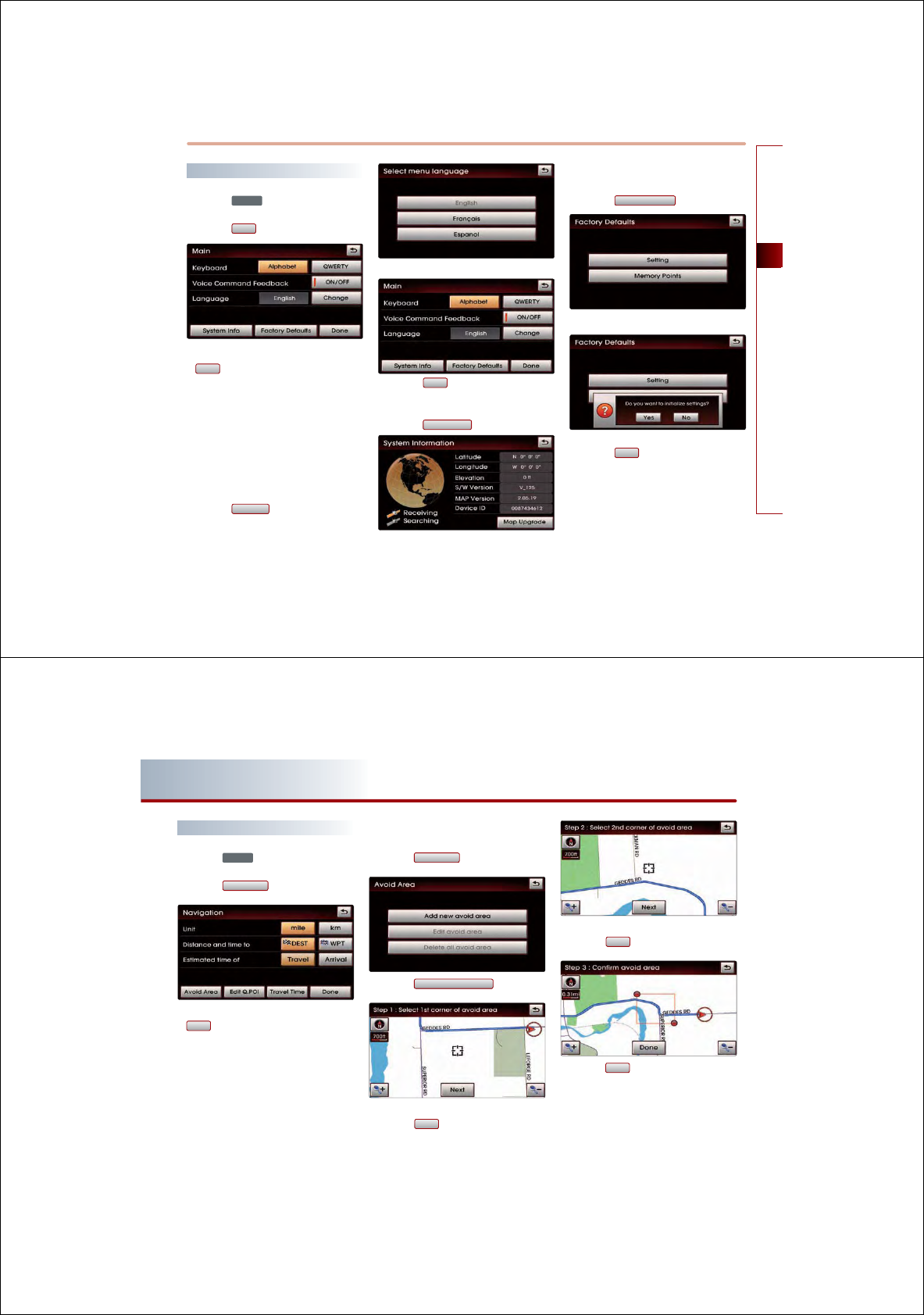
NAVIGATION SYSTEM 3-37
NAVIGATION SYSTEM
Main setting
1
.
Press the
6(783
key.
2
.
Press the
0DLQ
button.
3
.
Select the desired changes and press the
'RQH
button to complete.
Setting keyboard for inputting letter
Press the desired keyboard type button. The
selection will be highlighted.
Setting voice command feedback ON/OFF
Press the desired setting button.
Setting Language
1
.
Press the
&KDQJH
button.
2
.
Press the desired language.
3
.
Press the
'RQH
button to complete.
System information and update
1. Press the
6\VWHP,QIR
button.
Initializing system
1
.
Press the
)DFWRU\'HIDXOW
button.
2
.
Press the menu desired for initialization.
3
.
Press the
<HV
butto
3-38 NAVIGATION SYSTEM
PART 3 NAVIGATION SYSTEM
Navigation setting
1
.
Press the
6(783
key.
2
.
Press the
1DYLJDWLRQ
button.
3
.
Select the desired changes and press the
'RQH
button to complete.
Setting units (mile/ km)
Select the desired distance unit.
Setting arrival time and distance display
Select the desired setting button.
Registering avoid area
1
.
Press the
$YRLG$UHD
button.
2
.
Press the
$GGQHZDYRLGDUHD
button.
3
.
Set the start position of the avoid area and
press the
1H[W
button.
4
.
Set the end position of the avoid area and
press the
1H[W
button.
5
.
Press the
'RQH
button to complete.
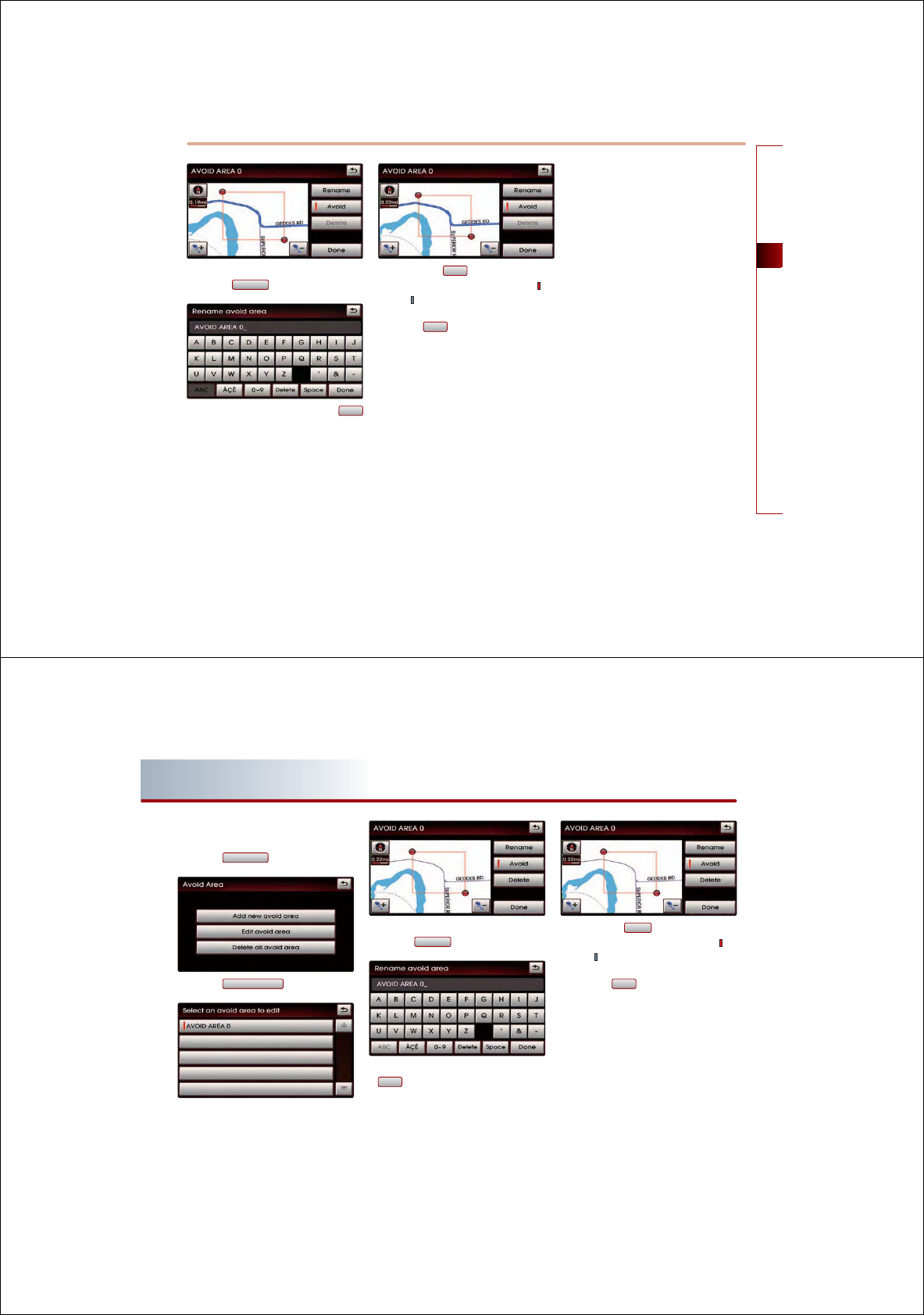
NAVIGATION SYSTEM 3-39
NAVIGATION SYSTEM
6
.
If the Avoid area needs to be renamed,
press the
5HQDPH
button.
7
.
Rename the Avoid area and Press the
'RQH
button to complete.
8
.
Each time the
$YRLG
button is pressed, the
function will switch between avoid ( )or
allow( ).
9
.
Press the
'RQH
button to complete the set-
ting.
3-40 NAVIGATION SYSTEM
PART 3 NAVIGATION SYSTEM
Editing avoid area
1
.
Press the
$YRLGDUHD
button.
2
.
Press the
(GLWDYRLGDUHD
button.
3
.
Select the Avoid area button to edit.
4
.
If the Avoid area needs to be renamed,
press the
5HQDPH
button.
5
.
Rename the Avoid area and press the
'RQH
button to complete.
6
.
Each time the
$YRLG
button is pressed, the
function will switch between avoid( )or
allow( ).
7
.
Press the
'RQH
button once editing is
complete.
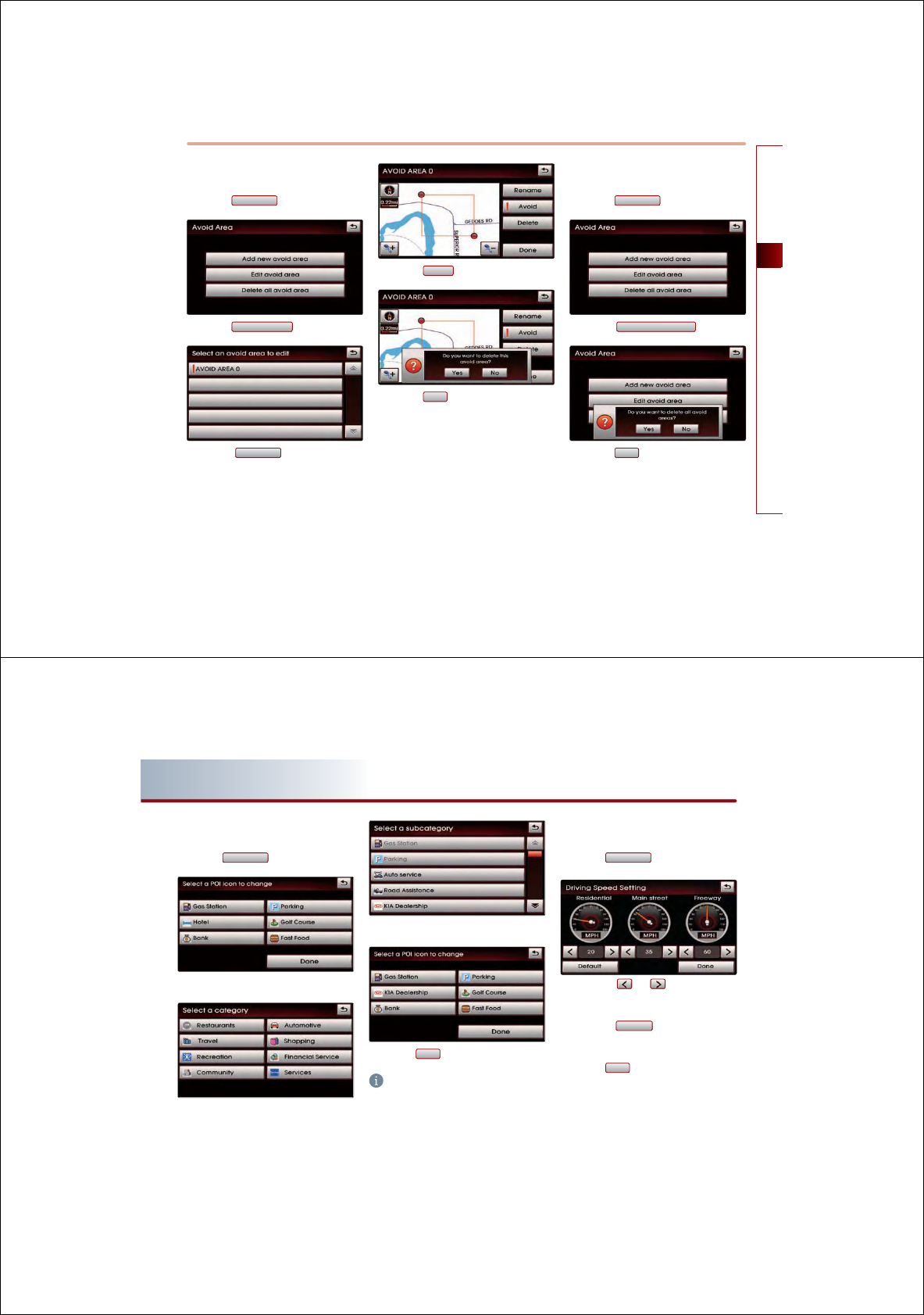
NAVIGATION SYSTEM 3-41
NAVIGATION SYSTEM
Deleting avoid area
1
.
Press the
$YRLGDUHD
button.
2
.
Press the
(GLWDYRLGDUHD
button.
3
.
Select the
$YRLGDUHD
button to delete.
4
.
Press the
'HOHWH
button.
5
.
Press the
<HV
button.
Deleting all avoid areas
1
.
Press the
$YRLGDUHD
button.
2.
Press the
'HOHWHDOODYRLGDUHD
button.
3
.
Press the
<HV
button.
3-42 NAVIGATION SYSTEM
PART 3 NAVIGATION SYSTEM
Setting Q.POI icons
1
.
Press the
(GLW432,
button.
2
.
Select the desired menu.
3
.
Select the desired category.
4
.
Select the desired sub category.
5
.
Press the
'RQH
button to complete.
INFORMATION
Q.POI stands for Quick POI and refers to the
function which turns POI icon display on or off
on the map.
Setting estimate travel time
1
.
Press the
7UDYHO7LPH
button.
2
.
Press the or button on the
Residential, Main street, and Freeway con-
trols to adjust the speed.
Press the
'HIDXOW
button to set the
speeds to the default settings.
3
.
Press the
'RQH
button to complete the set-
ting.
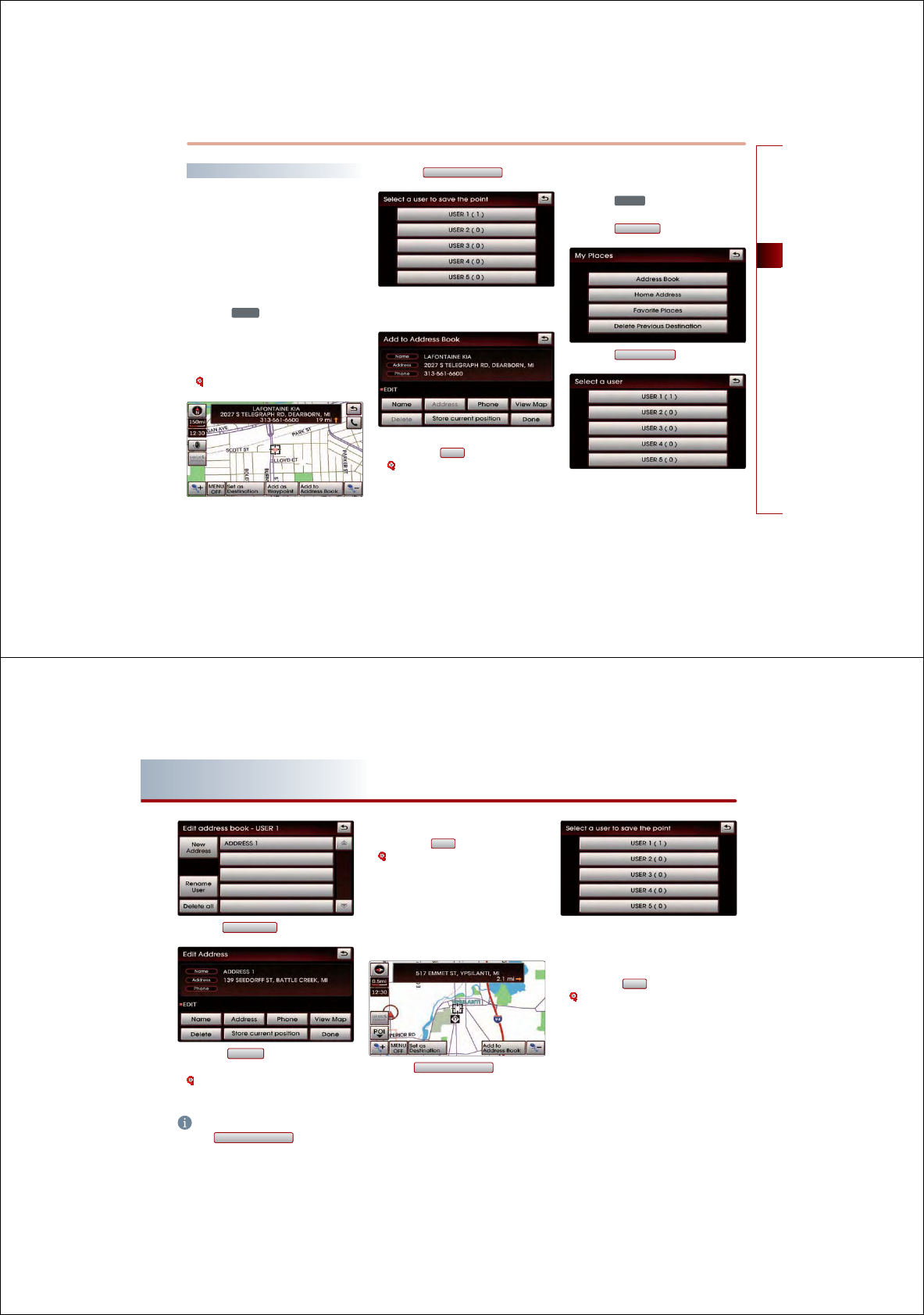
NAVIGATION SYSTEM 3-43
NAVIGATION SYSTEM
My places setting
Registering new address in address book
There are 3 ways to register a new address in
the address book - (a) by DEST menu, (b) by
registering address in address book, (c) from
map scroll.
(a) by DEST menu
1
.
Press the
'(67
key.
2
.
Search through the desired method.
The search process is the same as the meth-
od for destination search.
[Searching a destination], page 3-13.
3
.
Press the
$GGWR$GGUHVV%RRN
button.
4
.
Press the desired address book (user) but-
ton.
5
.
Input the name and telephone information
and press the
'RQH
button to complete.
[Editing an address of address book],
page 3-45.
(b) by registering in the address book
1
.
Press the
6(783
key.
2
.
Press the
0\3ODFHV
button.
3
.
Press the
$GGUHVV%RRN
button.
4
.
Press the desired address book (user) but-
ton.
3-44 NAVIGATION SYSTEM
PART 3 NAVIGATION SYSTEM
5
.
Press the
1HZ$GGUHVV
button.
6
.
Press the
$GGUHVV
button to search the
address.
[Searching an address], page 3-13.
INFORMATION
Press the
6WRUHFXUUHQWSRVLWLRQ
button to input
the address of the current position.
7
.
Input the name and telephone information
and press the
'RQH
button to complete.
[Editing an address of address book],
page 3-45.
(c) from map scroll
1
.
In the map screen, scroll the map to the
desired position.
2
.
Press the
$GGWR$GGUHVV%RRN
button.
3
.
Press the desired address book (user) but-
ton.
4
.
Input the name and telephone information
and press the
'RQH
button to complete.
[Editing an address of address book],
page 3-45.
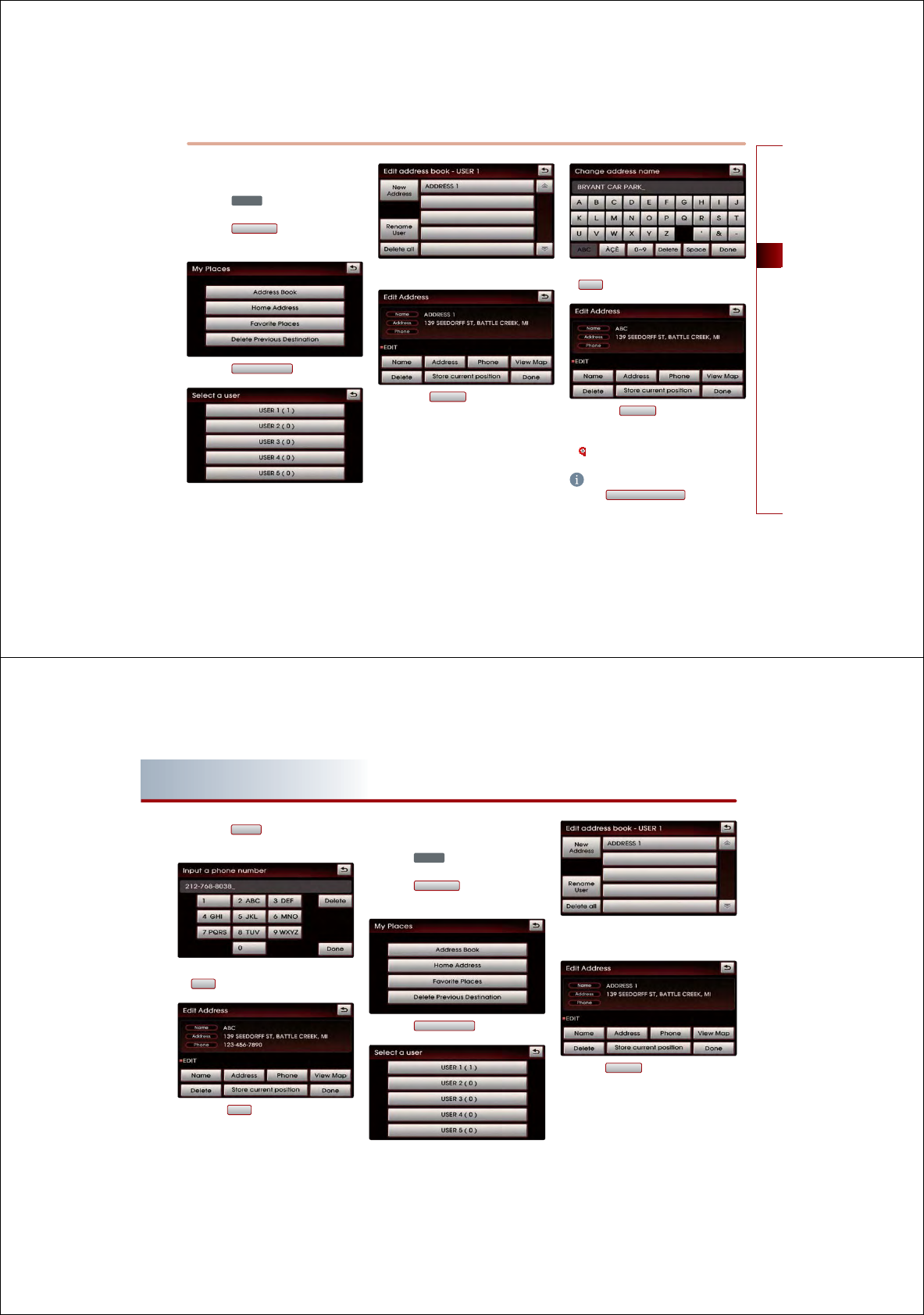
NAVIGATION SYSTEM 3-45
NAVIGATION SYSTEM
Editing an address of address book
1
.
Press the
6(783
key.
2
.
Press the
0\3ODFHV
button.
3
.
Press the
$GGUHVV%RRN
button.
4
.
Select the desired address book (user) but-
ton .
5
.
Select the desired address to edit.
6
.
Press the
1DPH
button to input the
address name.
7
.
Input the address name and press the
'RQH
button to complete.
8
.
Press the
$GGUHVV
button to search the
address. The process is the same as the
method for searching an address.
[Searching an Address] , page 3-13.
INFORMATION
Press the
6WRUHFXUUHQWSRVLWLRQ
button to input
the address of the current position.
3-46 NAVIGATION SYSTEM
PART 3 NAVIGATION SYSTEM
9
.
Press the
3KRQH
button to input the
phone number.
10
.
Input the phone number and press the
'RQH
button to complete.
11
.
Press the
'RQH
button to complete.
Deleting an address of address book
1
.
Press the
6(783
key.
2
.
Press the
0\3ODFHV
button.
3
.
Press the
$GGUHVV%RRN
button.
4
.
Select the desired address book (user) but-
ton.
5
.
Select the desired address button to
delete.
6
.
Press the
'HOHWH
button.
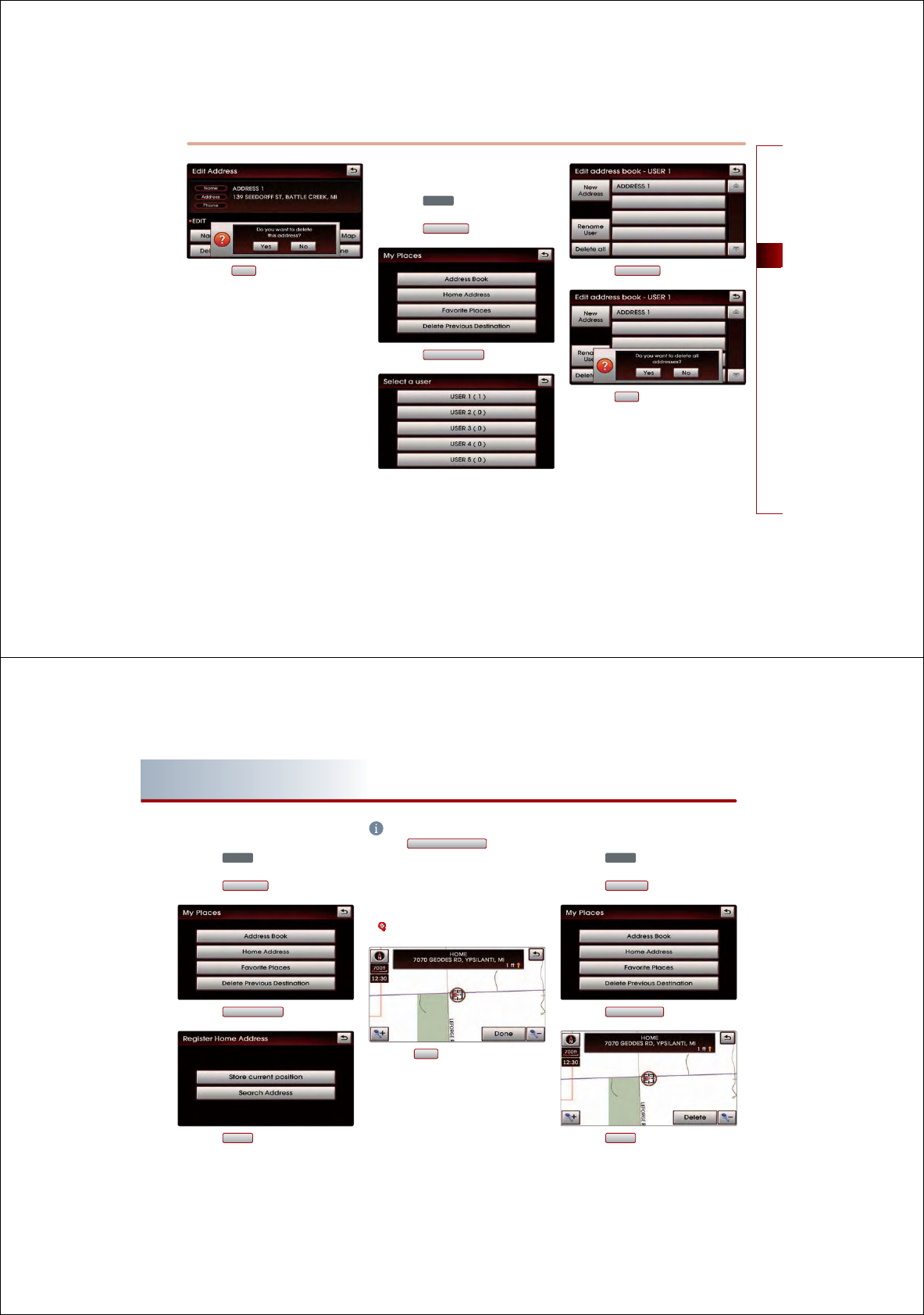
NAVIGATION SYSTEM 3-47
NAVIGATION SYSTEM
7
.
Press the
<HV
button.
Deleting an address book
1
.
Press the
6(783
key.
2
.
Press the
0\3ODFHV
button.
3
.
Press the
$GGUHVV%RRN
button.
4
.
Press the desired address book (user) but-
ton.
4
.
Press the
'HOHWHDOO
button.
5
.
Press the
<HV
button.
3-48 NAVIGATION SYSTEM
PART 3 NAVIGATION SYSTEM
Registering home address
1
.
Press the
6(783
key.
2
.
Press the
0\3ODFHV
button.
3
.
Press the
+RPH$GGUHVV
button.
4
.
Press the
6HDUFK
button.
INFORMATION
Press the
6WRUHFXUUHQWSRVLWLRQ
button to reg-
ister the current position as Home.
5
.
Search the address.
The process is the same method as search-
ing an address.
[Searching an Address], page 3-13.
6
.
Press the
'RQH
button to complete.
Deleting home address
1
.
Press the
6(783
key.
2
.
Press the
0\3ODFHV
button.
3
.
Press the
+RPH$GGUHVV
button.
4
.
Press the
'HOHWH
button.
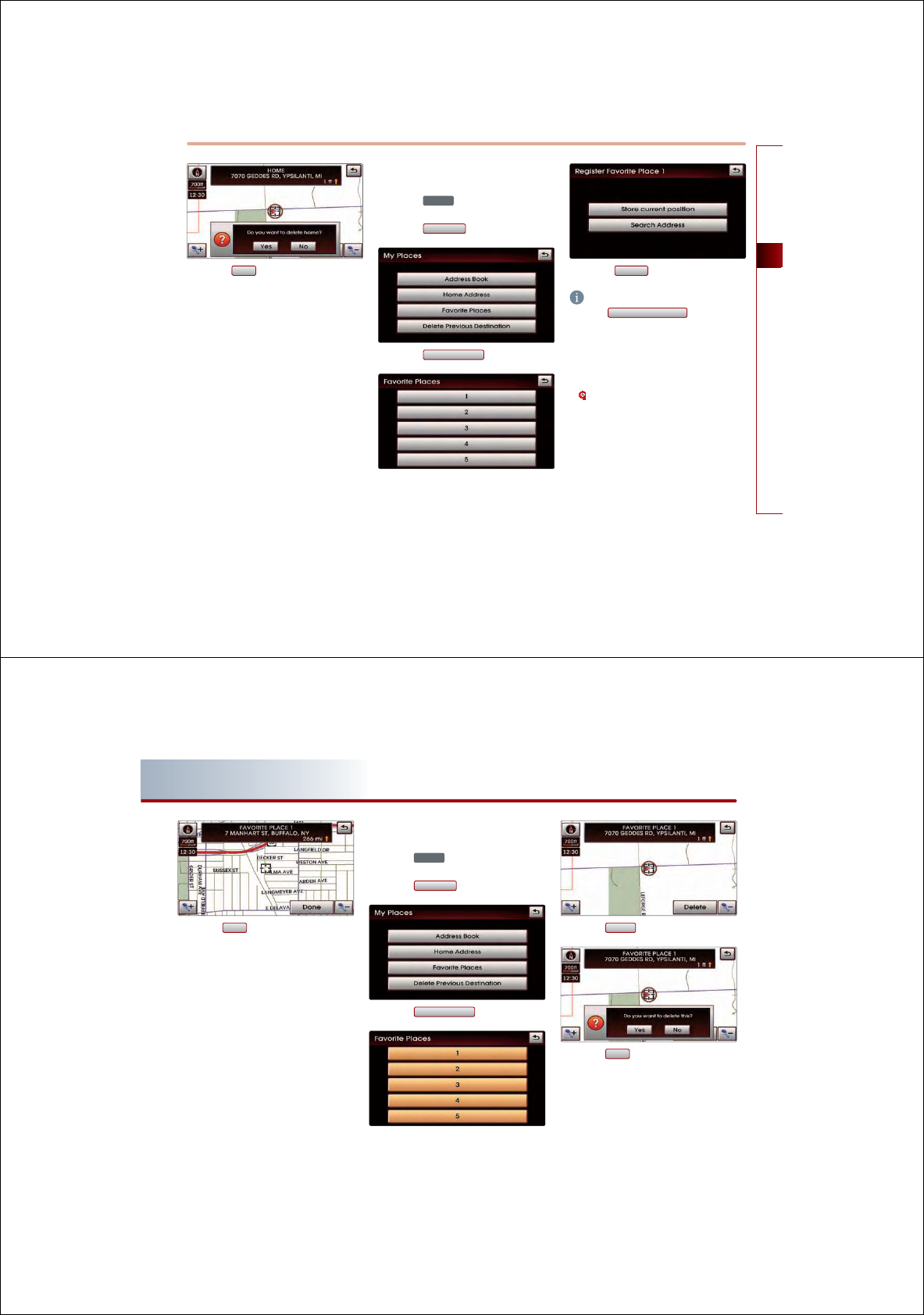
NAVIGATION SYSTEM 3-49
NAVIGATION SYSTEM
5
.
Press the
<HV
button.
Registering favorite place
1
.
Press the
6(783
key.
2
.
Press the
0\3ODFHV
button.
3
.
Press the
)DYRULWH3ODFHV
button.
4
.
Press the number of the Favorite Place to
register.
5
.
Press the
6HDUFK
button.
INFORMATION
Press the
6WRUHFXUUHQWSRVLWLRQ
button to reg-
ister the current position as a Favorite place.
6
.
Search the address.
The process is the same as the method for
searching an address.
[Searching an Address], page 3-13.
3-50 NAVIGATION SYSTEM
PART 3 NAVIGATION SYSTEM
7
.
Press the
'RQH
button to complete.
Deleting favorite place
1
.
Press the
6(783
key.
2
.
Press the
0\SODFHV
button.
3
.
Press the
)DYRULWH3ODFHV
button.
4
.
Select the desired favorite place button to
delete.
5
.
Press the
'HOHWH
button.
6
.
Press the
<HV
button.
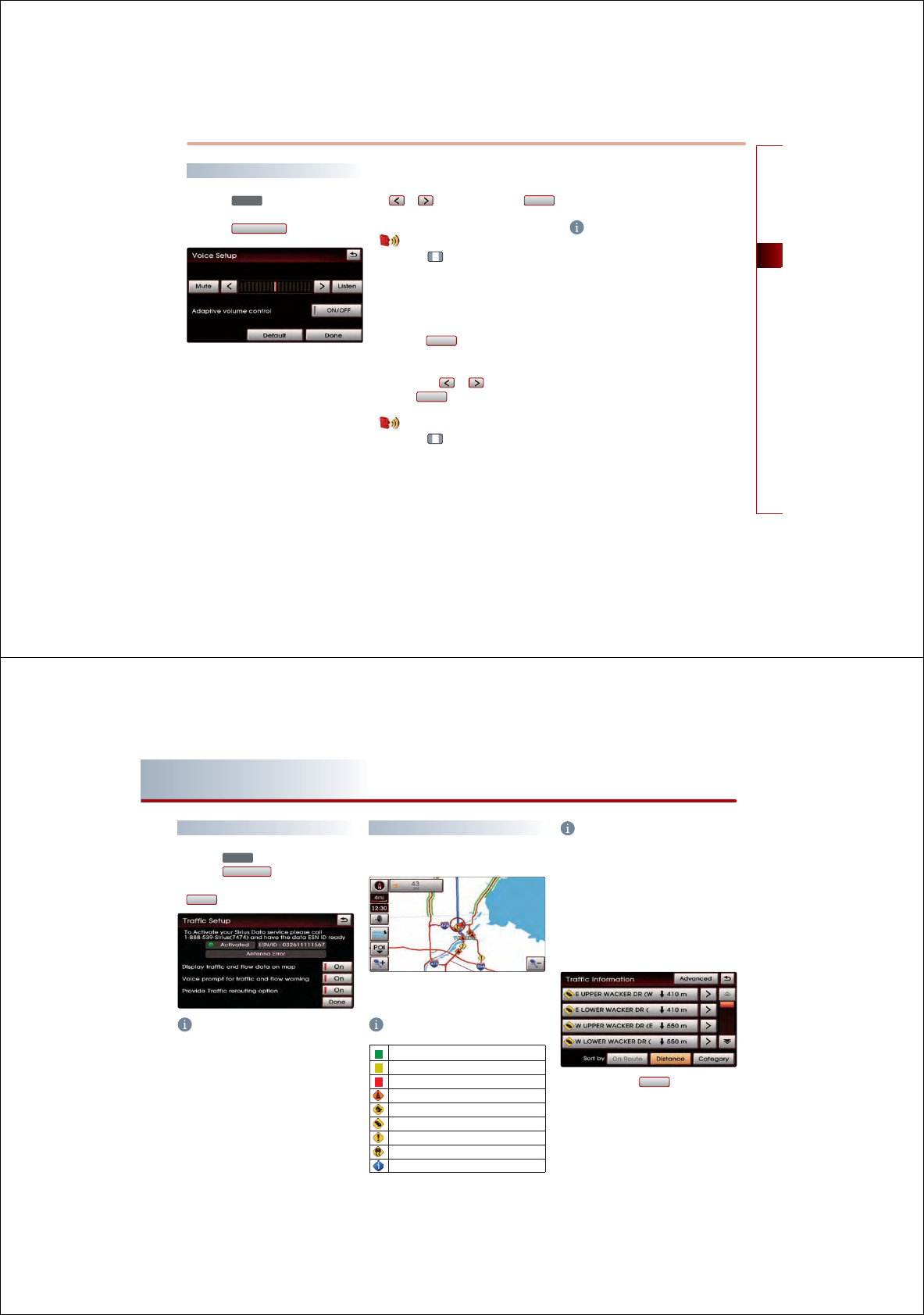
NAVIGATION SYSTEM 3-51
NAVIGATION SYSTEM
Voice guidance volume setting
1
.
Press the
6(783
key.
2
.
Press the
9RLFH6HWXS
button.
Voice guidance volume control
● Set the desired volume level by using the
or buttons and press the
/LVWHQ
button to verify the volume level.
Voice Command
1. Press the key on the steering wheel
remote controller.
2. After the beep sound, say a command.
"Voice Guidance Louder"
"Voice Guidance Softer"
●
Press the
0XWH
button when voice guid-
ance is unnecessary.
Voice guidance can be turned back on by
pressing the or buttons or press-
ing the
0XWH
button.
Voice Command
1. Press the key on the steering Wheel
remote controller.
2. After the beep sound, say a command.
"Voice Guidance On"
"Voice Guidance Of"
Adaptive volume control ON/OFF
● Press the desired setting button.
INFORMATION
Adaptive Volume Control
If the speed of the vehicle is over approxi-
mately 60 mi/h (100km/h), the volume level
can be increased one level higher than the
current level. If the speed of the vehicle falls
under 60 mi/h (100km/h), the volume level
will return to its original level.
3-52 NAVIGATION SYSTEM
PART 3 NAVIGATION SYSTEM
Traffic Setup
1
.
Press the
6(783
key.
2
.
Press the
7UDIILF6HWXS
button.
3
.
Select the desired changes and press the
'RQH
button.
INFORMATION
●
Display Traffic and Flow data on Map : select
whether to display traffic information on
the map.
●
Voice Prompt for traffic and flow warning :
select whether to provide voice guidance in
front of Traffic Information. (On route -
3mile)
●
Display Detour pop-up message : select
whether to display Detour pop up in front
of Traffic Information. (On route - 3mile)
Traffic Information
(a) Viewing Traffic Information
1
.
When the Traffic option is active, press the
button on the Map screen.
Traffic Flow INFORMATION
Normal, Free Flowing (46 mph ~)
Moderate Congestion (26 ~ 45 mph)
Heavy Traffic, Stop and Go (0 ~ 25 mph)
Road Construction
Accident
Congestion/Slow Traffic
Incient
Hazardous Road Conditions
Travel Information
INFORMATION
●
Traffic information will be shown on the
map up until the scale is ~4mile.
●
Displays the traffic information around vehi-
cle for up to a radius of 50 miles.
(Information exceeding 50 miles will not be
displayed)
●
The above list can be sorted by either
Distance (Default) or Category.
2
.
Select the desired
/LVW
button.
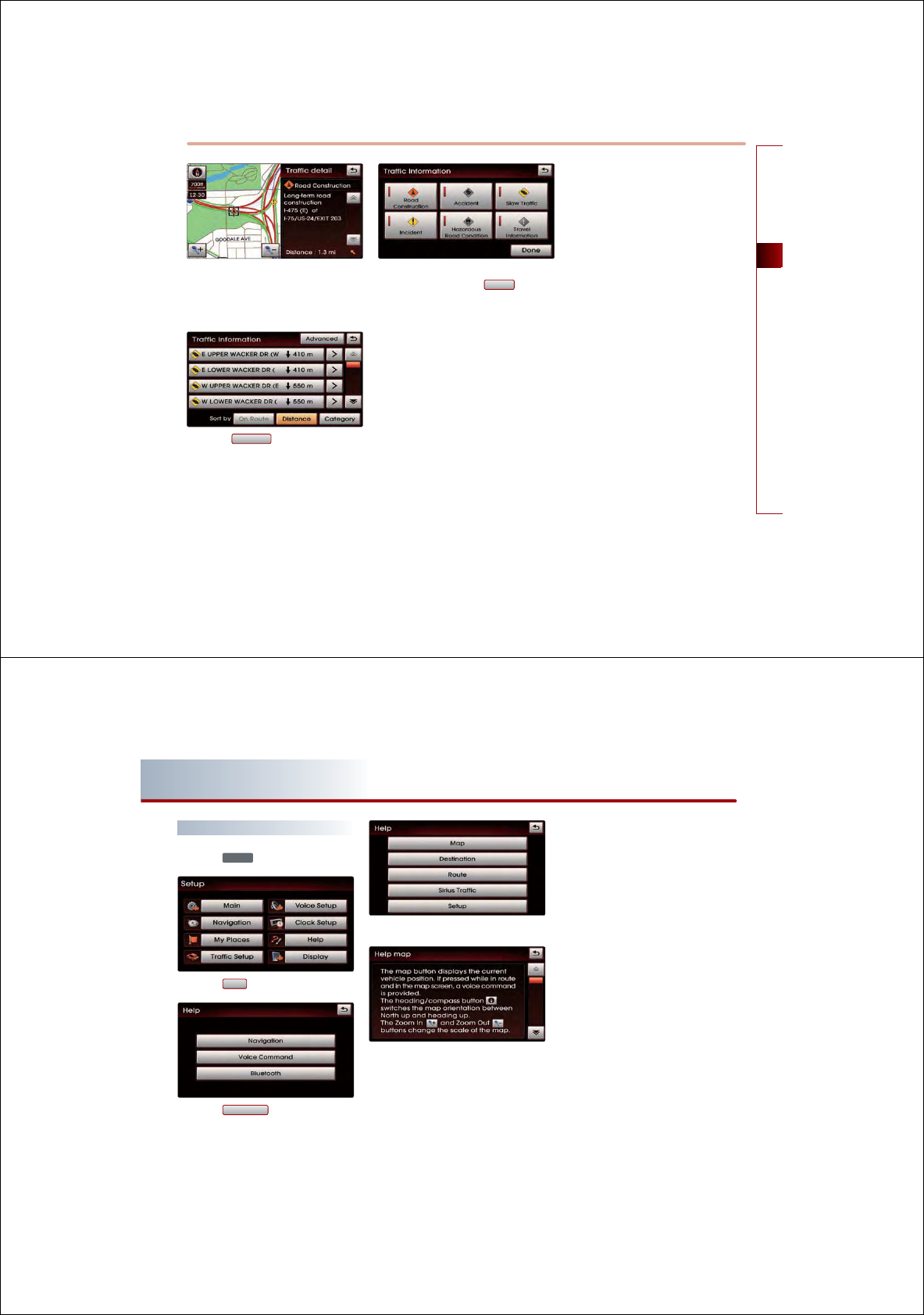
NAVIGATION SYSTEM 3-53
NAVIGATION SYSTEM
3
.
The user can check points of accidents and
traffic details.
(b) Changing Traffic Category
1
.
Press the
$GYDQFHG
button.
2
.
After selecting the desired menu among
the six menus, press the
'RQH
button to
save. Once returning to the previous List
screen, the corresponding Category list will
be shown and maintained until Category
information is changed.
3-54 NAVIGATION SYSTEM
PART 3 NAVIGATION SYSTEM
Help
1
.
Press the
6(783
key.
2
.
Press the
+HOS
button.
3
.
Press the
1DYLJDWLRQ
button.
4
.
Press the desired Help menu button.
5
.
The full content of the help section can be
viewed by using the top-down scroll but-
tons.
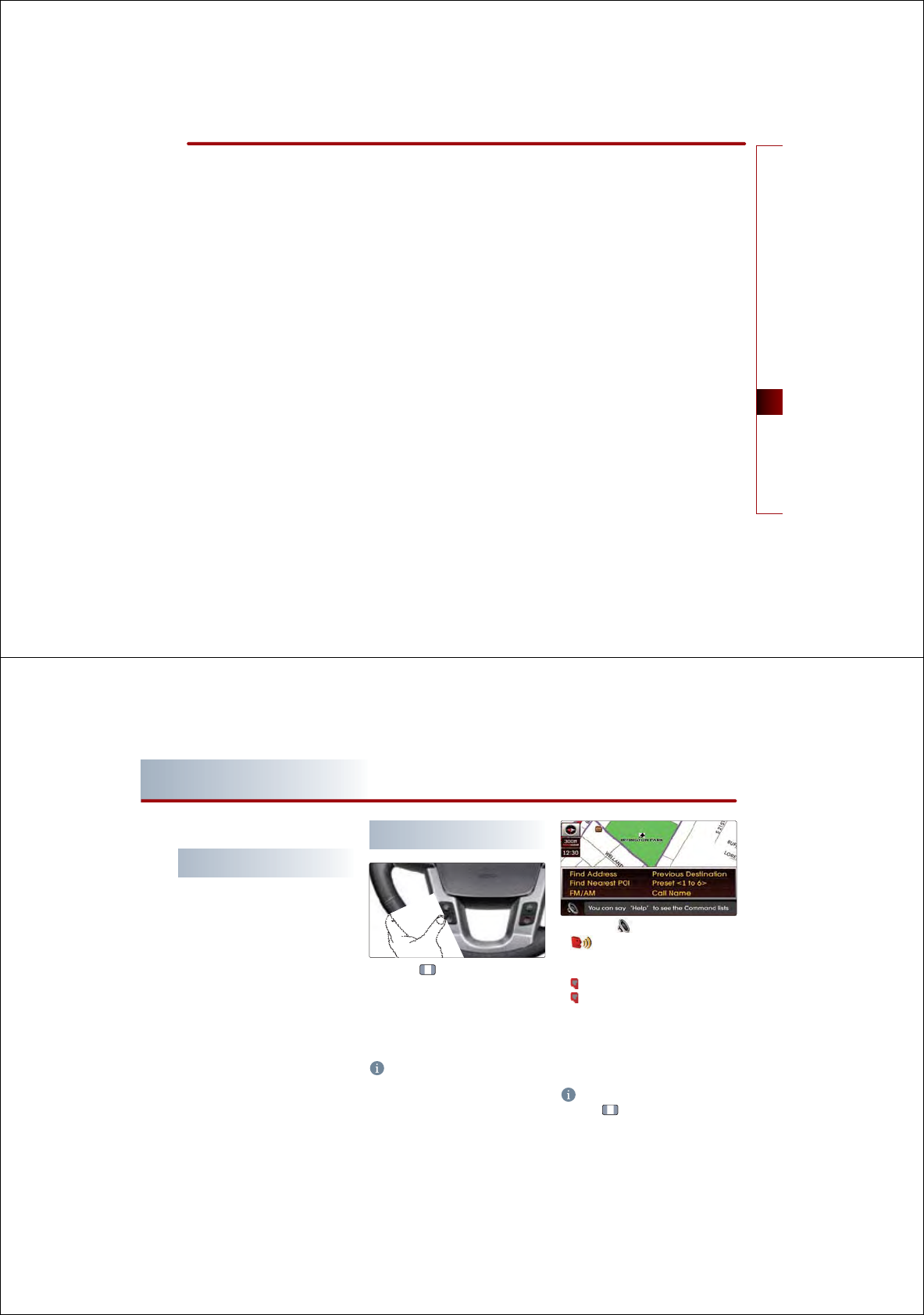
VOICE COMMAND SYSTEM 4-1
VOICE COMMAND SYSTEM
PART 4
VOICE COMMAND SYSTEM
Operating voice command #䐙䐙 4-2
Condition for voice command system
##
4-2
Basic operation for voice
command control# 㾕㾕㾕㾕㾕㾕㾕 #4-2
Voice command help#㾕㾕㾕㾕㾕㾕 #4-3
Setting up the voice command sys-
tem #䐙䐙䐙䐙䐙䐙䐙䐙䐙䐙䐙䐙 4-4
Setting voice Prompt ON/OFF#㾕㾕 #4-4
Speaker adaptation# 㾕㾕㾕㾕㾕㾕 #4-4
Voice command list #䐙䐙䐙䐙䐙 4-6
Command list of Help# 㾕㾕㾕㾕㾕 #4-6
Command list of Audio system
#㾕㾕 #
4-7
FM/AM Radio# 㾕㾕㾕㾕㾕㾕㾕 #4-7
SIRIUS Radio#㾕㾕㾕㾕㾕㾕㾕㾕 #4-8
CD#㾕㾕㾕㾕㾕㾕㾕㾕㾕㾕㾕㾕 #4-9
MP3# 㾕㾕㾕㾕㾕㾕㾕㾕㾕㾕㾕 #4-10
MP3 MP3# 㾕㾕㾕㾕㾕㾕㾕㾕㾕 #4-11
USB Image# 㾕㾕㾕㾕㾕㾕㾕㾕 #4-12
iPod# 㾕㾕㾕㾕㾕㾕㾕㾕㾕㾕㾕 #4-12
Others# 㾕㾕㾕㾕㾕㾕㾕㾕㾕㾕 #4-12
Command list of Phone
#㾕㾕㾕㾕 #4-13
Command list of Navigation system
##
4-14
Map# 㾕㾕㾕㾕㾕㾕㾕㾕㾕㾕㾕 #4-13
Destination# 㾕㾕㾕㾕㾕㾕㾕㾕 #4-15
Route# 㾕㾕㾕㾕㾕㾕㾕㾕㾕㾕 #4-16
Others# 㾕㾕㾕㾕㾕㾕㾕㾕㾕㾕 #4-17
POI Category list# 㾕㾕㾕㾕㾕㾕 #4-18
Searching a destination by
voice command#㾕㾕㾕㾕㾕㾕㾕㾕 #4-19
Find address#㾕㾕㾕㾕㾕㾕㾕㾕 #4-19
Find nearest POI#㾕㾕㾕㾕㾕㾕 #4-20
Find nearest <POI name>#㾕㾕
#4-21
Destination POI by phone
number#㾕㾕㾕㾕㾕㾕㾕㾕㾕㾕 #4-22
Find emergency <Category>#㾕 #4-23
Destination by address book#㾕#4-24
Previous destination# 㾕㾕㾕㾕 #4-24
Previous start point#㾕㾕㾕㾕㾕 #4-25
Go home# 㾕㾕㾕㾕㾕㾕㾕㾕㾕 #4-25
Destination by memory point
<1 to 5># 㾕㾕㾕㾕㾕㾕㾕㾕㾕 #4-25
4-2 VOICE COMMAND SYSTEM
PART 4 VOICE COMMAND SYSTEM
Operating voice command
Condition for voice command
system
Most of the functions within the AUDIO and
Navigation system can be operated by voice.
Please follow the following instructions for
optimal voice recognition performance.
●
Close all windows and the sunroof. The
performance of the voice recognition
can be improved if the environment of
the car interior is quiet.
●
Press the voice recognition button and
say the desired voice command after
the sound of the beep.
●
The microphone is positioned above
the driver so that voice commands can
be said while maintaining a proper pos-
ture.
●
Pronounce the voice commands natu-
rally and clearly as if in a normal conver-
sation.
Basic operation for voice
command control
1. Press the key on the steering wheel
remote controller.
A voice command window will be dis-
played on the lower side of the screen
followed by a "Command please" sys-
tem voice comment.
INFORMATION
The System voice comment "Command
Please" will not be provided when the Voice
prompt is turned OFF.
2. Once the icon changes into the
icon on the pop-up screen with a
beep sound, say the desired voice com-
mand (ex : previous destination)
[Voice command list], page 4-6.
[Searching a destination by voice com-
mand], page 4-19.
If the exact command is not known, use the
"Help" command to view the commands list in
detail.
INFORMATION
Press the
key
shortly to input a voice
command from among the system voice com-
ments. The system voice instruction comment
will immediately terminate.
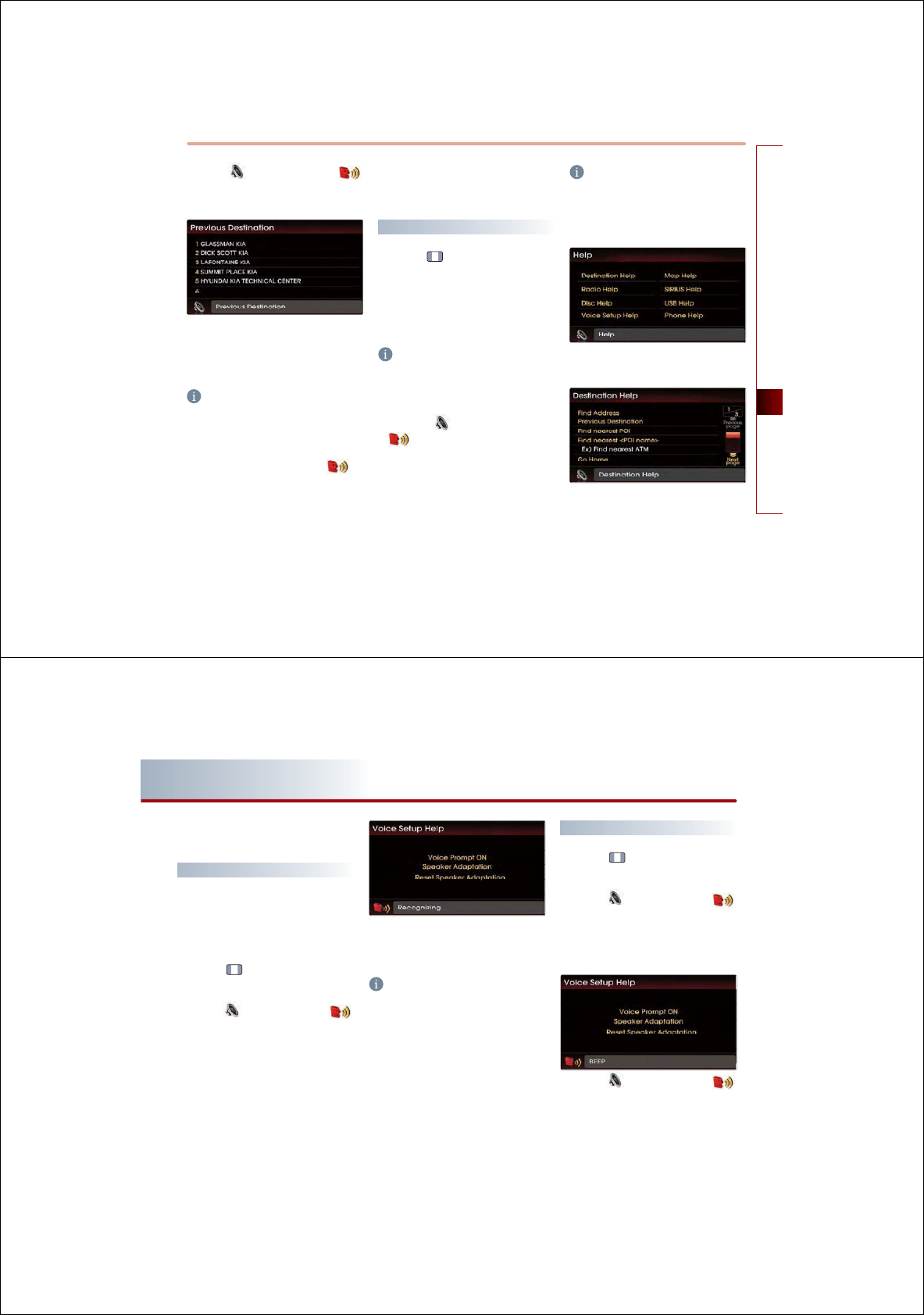
VOICE COMMAND SYSTEM 4-3
VOICE COMMAND SYSTEM
When the icon changes into the
icon with a beep sound, input the desired
voice command.
3. The inputted command is fed back to the
screen and voice system.
If the command was not recognized pro-
perly, say "Back".
INFORMATION
●
The commands which can currently be
inputted are displayed on the screen in yel-
low.
●
To terminate the voice recognition system,
either say "cancel" or press the for
over 0.8 second.
●
Be aware that during the operation of the
voice recognition system, pressing the hard
keys or the screen will terminate the voice
recognition system.
Voice command Help
1. Press the
key
on the Steering wheel
remote controller.
A voice command window will be dis-
played on the lower side of the screen
followed by a "Command please" sys-
tem voice comment.
INFORMATION
The System voice comment "Command
Please" will not be provided when the Voice
prompt is turned OFF.
2. Once the icon changes into the
icon on the pop-up screen with a
beep sound, say "Help".
If the proper Help menu is already
known, voice commands, such as "des-
tination help" can be inputted directly.
INFORMATION
The "help" command can be used even while
voice recognition dialogue is operating.
At such time, help instructions appropriate to
the state of the dialogue will be provided.
3. Say the name of the desired menu.
(ex : "Destination help")
4. Say the desired voice command.
4-4 VOICE COMMAND SYSTEM
PART 4 VOICE COMMAND SYSTEM
Setting up the voice command
system
Setting voice prompt ON/OFF
●
Voice prompt ON : All system prompts are
provided.
●
Voice prompt OFF : Most of the system
prompts are not provided.
1. Press the
key
on the Steering wheel
remote controller.
2. Once the icon changes into the
icon on the pop-up screen with a beep
sound, say "Voice setup." The "voice prompt
on" or "voice prompt off" can be directly
inputted if the current state is already
known.
3. Once the icon changes into the icon on the
pop-up screen with a beep sound, say
"Voice Prompt on".
INFORMATION
In the Voice Setup Help screen, the commands
possible for input within the current mode are
displayed. For example, if the Voice prompt is
currently in Off state, then the command Voice
prompt ON will be displayed on the screen.
Speaker adaptation
1. Press the
key
on the Steering wheel
remote controller.
2. Once the icon changes into the
icon on the pop-up screen with a beep
sound, say "Voice setup." Or the "Speaker
adaptation" command can be directly
inputted.
3. Once the icon changes into the
icon on the pop-up screen with a beep
sound, say "Speaker adaptation".
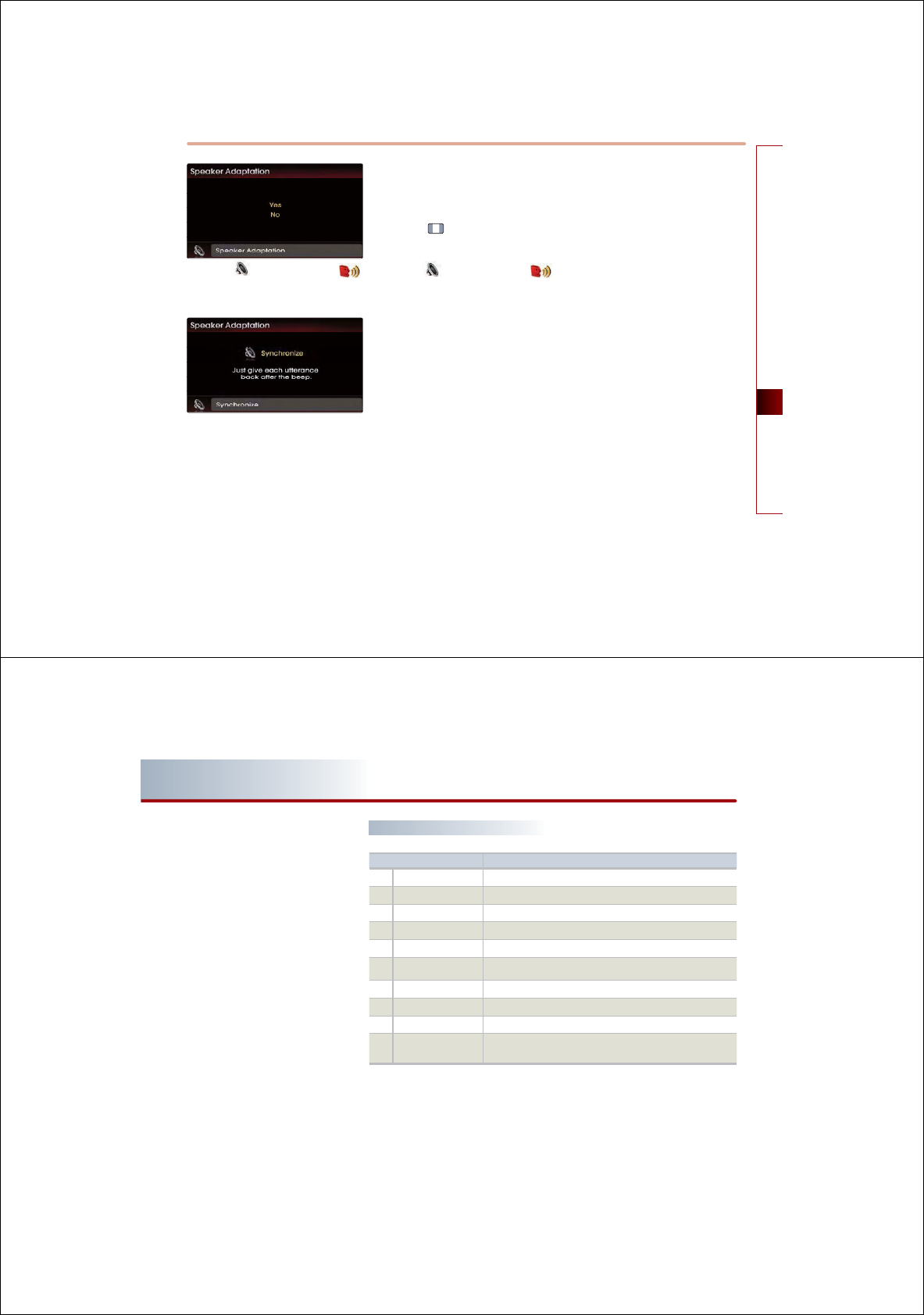
VOICE COMMAND SYSTEM 4-5
VOICE COMMAND SYSTEM
4. Once the icon changes into the
icon on the pop-up screen with a beep
sound, say "Yes".
5. Listen and repeat the 20 commands
(approximate) as instructed by the device.
●
Reset Speaker adaptation: Returns to
previous state prior to applying Speaker
adaptation.
1. Press the key on the Steering wheel
remote controller.
2. Once the icon changes into the
icon on the pop-up screen with a beep
sound, say "Reset Speaker adaptation".
4-6 VOICE COMMAND SYSTEM
PART 4 VOICE COMMAND SYSTEM
Voice command list
The voice commands for this system are divi-
ded into Global commands and Local com-
mands.
㾐㾐
●
Global command (㿋) : Commands which
operate in all operating modes.
●
Local command (㿊) : Commands which
operate only when the corresponding
mode is operating or when the mode
screen to the corresponding mode is dis-
played.
Command list of Help
Command Operation
㿋Help Displays the main Help screen.
㿋Destination Help Displays the Destination related command list.
㿋Map Help Displays the Map related command list.
㿋Radio Help Displays the FM/AM radio related command list.
㿋SIRIUS Help Displays the SIRIUS radio related command list.
㿋Disc Help Displays the DISC mode related command list for the disc
inserted in the CDP.
㿋iPod Help Displays the iPod related Command list.
㿋USB Help Displays the USB related command list.
㿋Phone Help Displays the Phone help screen.
㿋Voice setup Help Displays the Voice prompt settings and speaker-adaptive
commands on the screen.
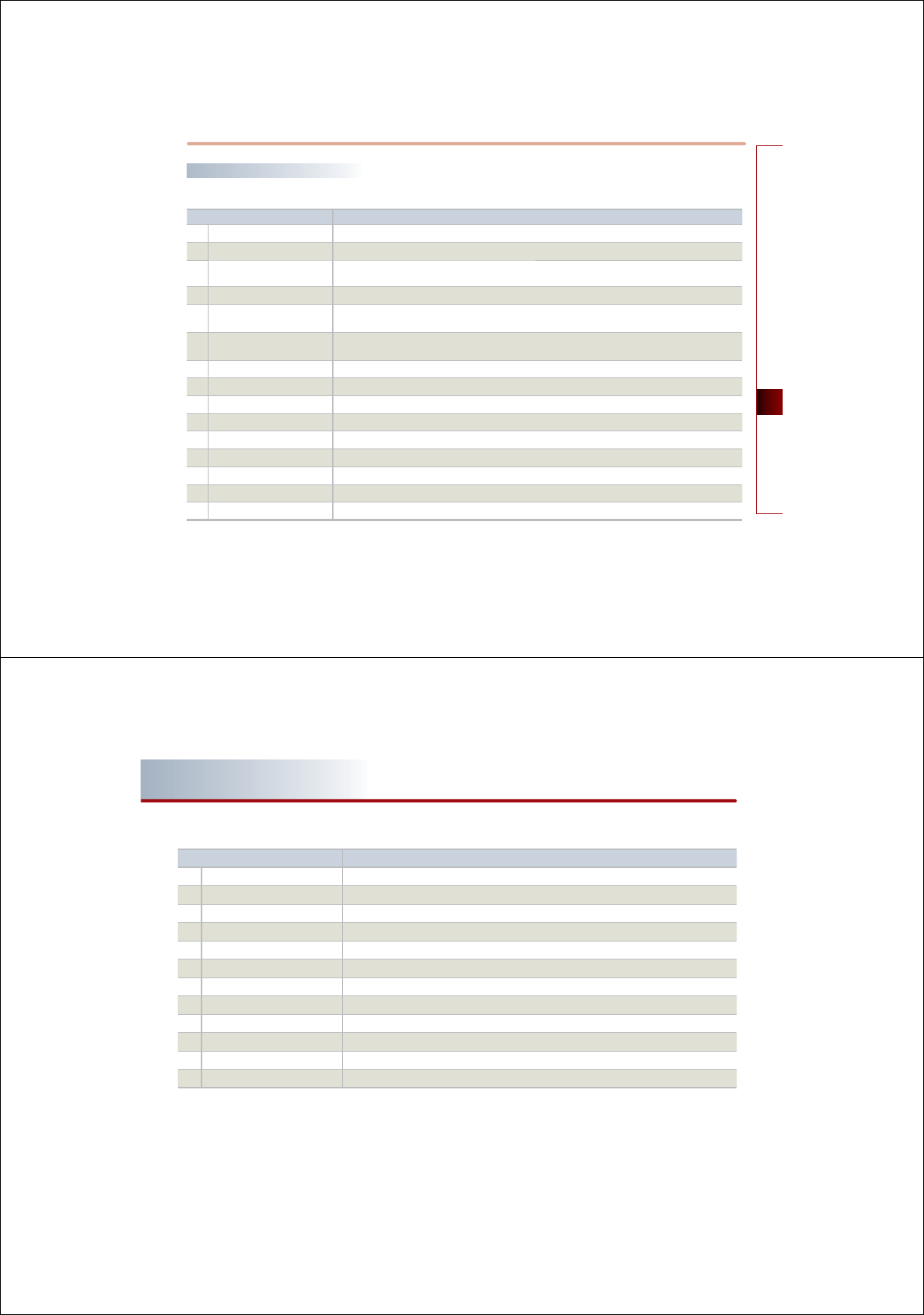
VOICE COMMAND SYSTEM 4-7
VOICE COMMAND SYSTEM
Command list of Audio system
FM/AM Radio
Command Operation
㿋 Radio Plays the most recent frequency for the most recently operated band.
㿋 (Radio) AM Plays the most recent frequency for the corresponding band.
㿋 (Radio) FM Plays the most recent frequency for the corresponding band. In the case of FM, the most recent
frequency within the most recently played FM1 or FM2 band is played.
㿋 FM <1 or 2> Plays the most recent frequency for the corresponding band.
㿋 AM frequency <530 to 1710>
(ex. AM frequency 1310) Plays the desired AM band frequency.
㿋
FM frequency <87.5 to 107.9>
(ex. FM frequency 99.1) Plays the desired FM band frequency.
㿋 AM Preset <1 to 6> Plays the desired AM band preset frequency.
㿋FM <1 or 2> Preset <1 to 6> Plays the desired preset frequency of FM1 or FM2 band.
㿊 Preset <1 to 6> Plays the desired preset frequency for the current band.
㿊 Seek Up Searches and plays the next frequency of the current band.
㿊 Seek Down Searches and plays the previous frequency of the current band.
㿊 Preset Up Plays the next preset frequency of the current band.
㿊 Preset Down Plays the previous preset frequency of the current.
㿊 Scan Scans all frequencies within the current band.
㿊 Preset Scan Scans the 6 preset frequencies of the current band.
4-8 VOICE COMMAND SYSTEM
PART 4 VOICE COMMAND SYSTEM
SIRIUS Radio
Command Operation
㿋# VLULXV Plays the last channel within the last band from SIRIUS1, SIRIUS2, and SIRIUS3.
㿋 SIRIUS <1 or 2 or 3> Plays the most recent channel for the corresponding Band.
㿋 SIRIUS Channel <0 to 223> Plays the desired SIRIUS band channel.
㿋
SIRIUS <1 or 2 or 3> Preset <1 to 6>
Plays the desired preset channel for SIRIUS1 or SIRIUS2 or SIRIUS3 band.
㿊 Channel < 0 to223 > Plays the desired channel of the current band.
㿊 Preset <1 to 6> Plays the desired preset channel of the current band.
㿊 Channel Up Plays the next channel of the current band.
㿊 Channel Down Plays the previous channel of the current band.
㿊 Preset Up Plays the next preset channel of the current band.
㿊 Preset Down Plays the previous preset channel of the current band.
㿊 Scan Scans all channels within the current band.
㿊 Preset Scan Scans all preset channels within the current band.
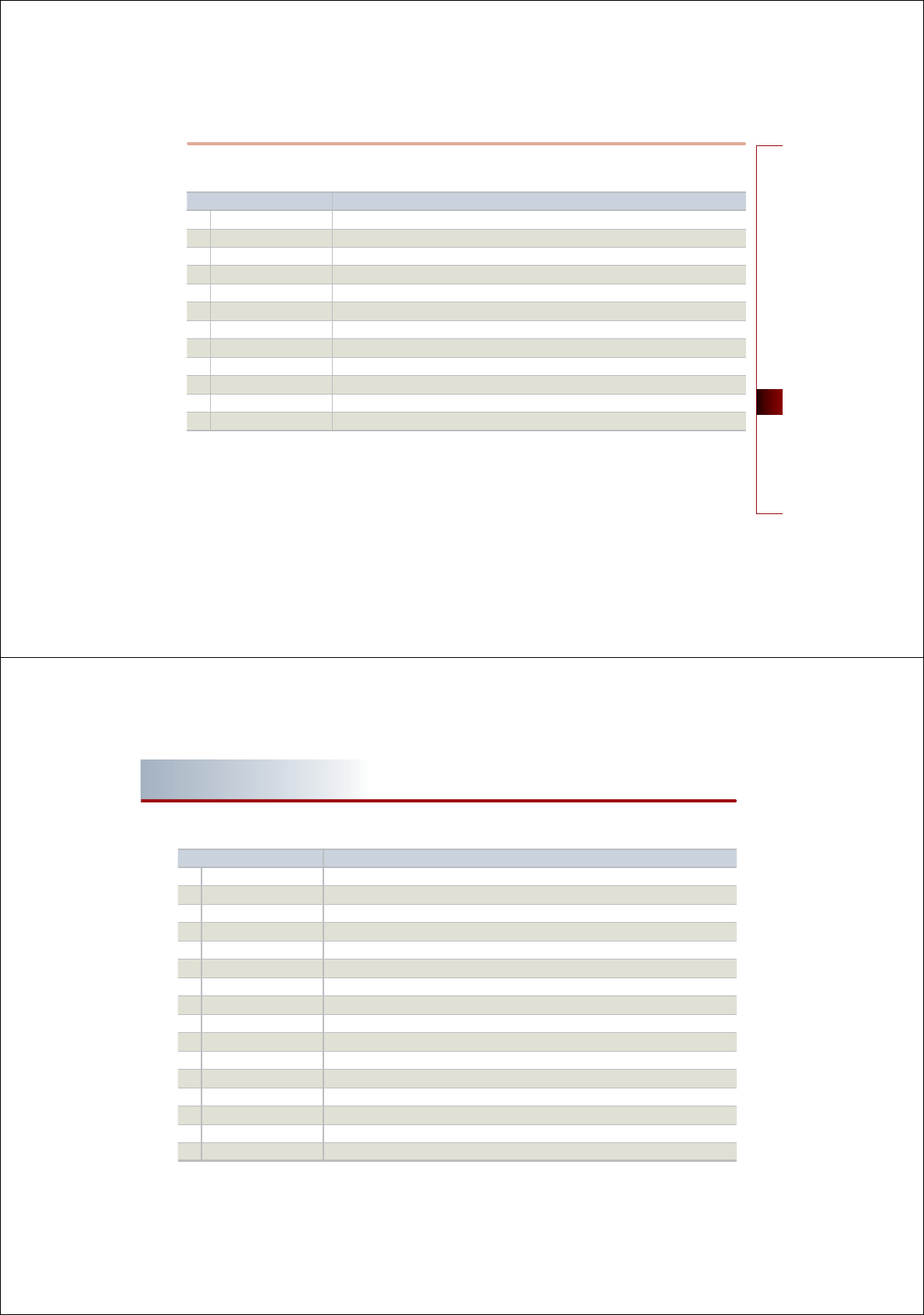
VOICE COMMAND SYSTEM 4-9
VOICE COMMAND SYSTEM
CD
Command Operation
㿋DISC Plays the DISC already inserted in the CD Player.
㿋CD If the DISC inserted in the CD Player is either a CD or MP3 DISC, then the CD or MP3 will be played.
㿋CD track <1 to 665> If the DISC inserted in the CD Player is a CD, then CD Mode will start and plays the desired track.
㿊Track <1 to 665> Plays the desired track.
㿊Next track Plays the next track.
㿊Previous track Plays the previous track.
㿊Scan Scans all tracks on the CD.
㿊Repeat track Repeats the current playing track.
㿊Random Plays the tracks of the CD in random order.
㿊Normal play Turns off the Scan, Repeat, and Random functions.
㿊Pause Pauses the CD.
㿊
Play
The command will only be enabled when the CD is paused.
4-10 VOICE COMMAND SYSTEM
PART 4 VOICE COMMAND SYSTEM
MP3
Command Operation
㿋 DISC Plays the DISC already inserted into the CDP.
㿋 CD If the DISC inserted in the CDP is either a CD or MP3 DISC, then the CD or MP3 will be played.
㿋 MP3 If the DISC inserted in the CDP is an MP3 DISC, then the MP3 will be played.
㿊 Next file Plays the next file.
㿊 Previous file Plays the previous file.
㿊 Next folder Plays the first file in the next folder.
㿊 Previous folder Plays the first file in the previous folder.
㿊 Scan Scans all files within the MP3 DISC.
㿊 Folder Scan Plays all songs in the folder in which the current playing file is located for 10 seconds each.
㿊 Repeat File Repeats the current playing file.
㿊 Repeat Folder Repeats all tracks within the current playing folder.
㿊 Random Plays all files within the MP3 DISC in random order.
㿊 Random Folder Plays all files within the current playing folder in random order.
㿊 Normal play Turns off the Scan, Repeat, and Random functions.
㿊
Pause
Pauses the MP3 DISC.
㿊
Play
The command will only be enabled when the MP3 DISC is paused.
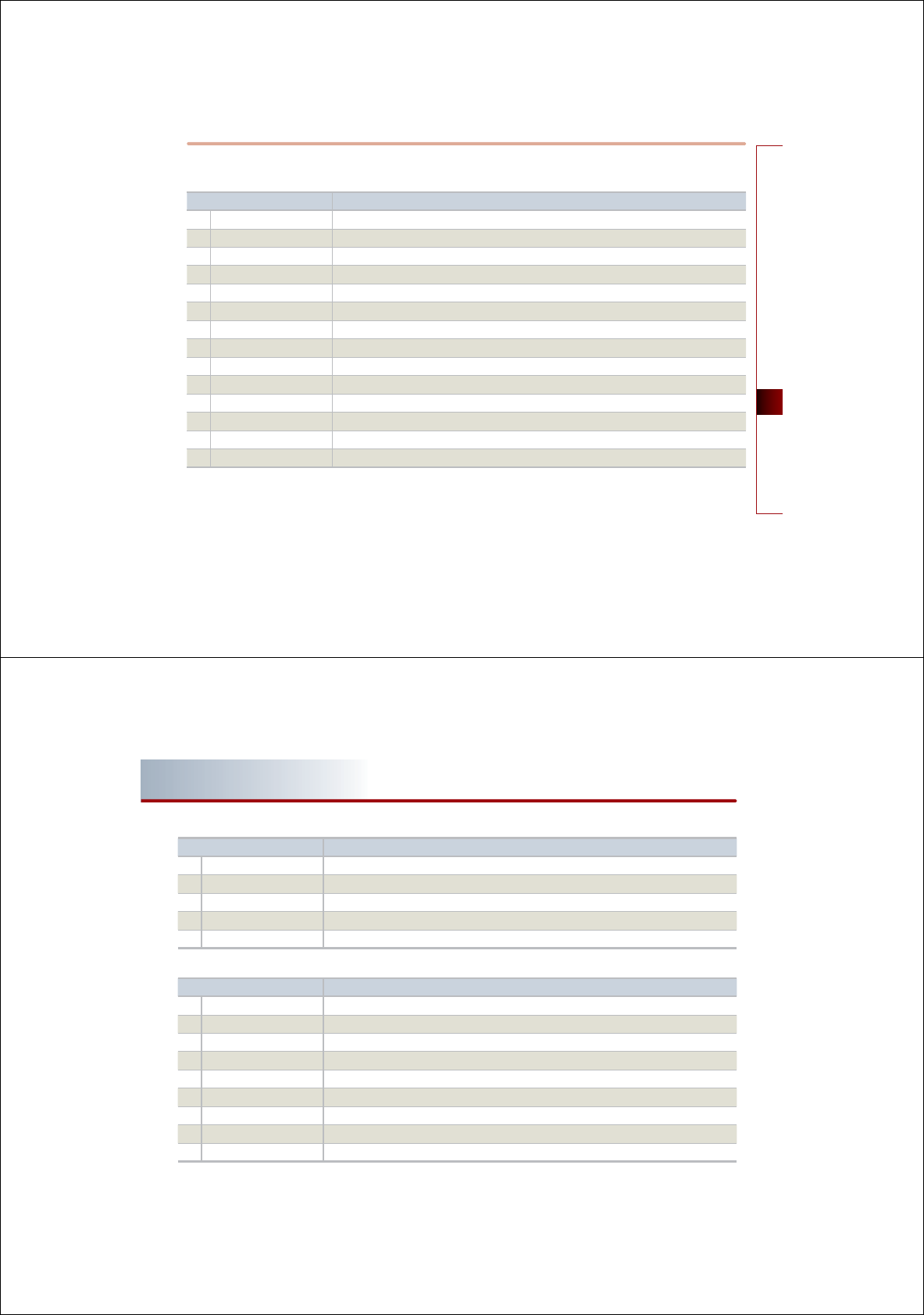
VOICE COMMAND SYSTEM 4-11
VOICE COMMAND SYSTEM
USB MP3
Command Operation
㿋 USB If the USB has been connected to the device, plays the MP3 files within the USB.
㿊 Next file Plays the next file.
㿊 Previous file Plays the previous file.
㿊 Next folder Plays the first chapter of the next folder.
㿊 Previous folder Plays the first chapter of the previous folder.
㿊 Scan Scans all files within the USB.
㿊 Folder Scan Plays all songs in the folder in which the current playing file is located for 10 seconds each.
㿊 Repeat File Repeats the current playing file.
㿊 Repeat Folder Repeats all songs within the current playing folder.
㿊 Random Plays all files within the USB in random order.
㿊 Random Folder Plays all files within the current playing folder in random order.
㿊 Normal play Turns off the Scan, Repeat, and Random functions.
㿊 Pause Pauses the USB.
㿊 Play The command will only be enabled when the USB is paused.
4-12 VOICE COMMAND SYSTEM
PART 4 VOICE COMMAND SYSTEM
iPod
USB Image
Command Operation
㿋 iPod Plays the songs within the iPod if the iPod has been connected to the device.
㿊 Next song Plays the next song.
㿊 Previous song Plays the previous song.
㿊 Repeat song Repeats the current playing song.
㿊 Random Plays all songs within the iPod in random order.
㿊 Random Album Plays all songs within the current playing album in random order.
㿊 Normal play Turns off the Repeat and Random functions.
㿊Pause Pauses the iPod.
㿊Play The command will only be enabled when the iPod is paused.
Command Operation
㿋 USB If the USB IMAGE has been connected to the device, plays the image files within the USB.
㿊Next Image Moves to the next Image.
㿊Previous Image Moves to the previous Image.
㿊Next folder Moves to the next folder.
㿊Previous folder Moves to the previous folder.
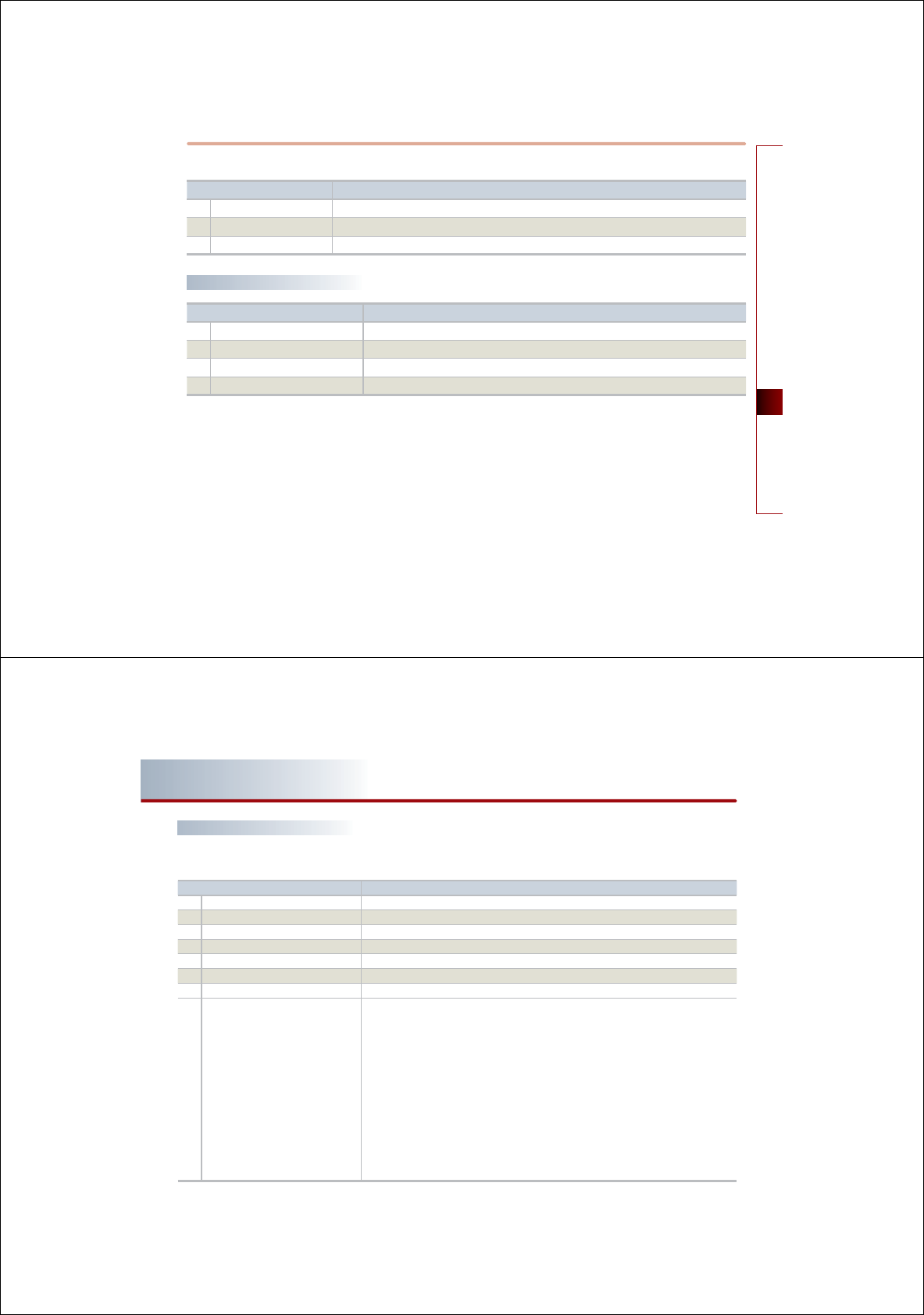
VOICE COMMAND SYSTEM 4-13
VOICE COMMAND SYSTEM
Others
Command list of Phone
Command Operation
㿋 Line in Plays the unit connected with the AUX terminal.
㿋 Audio on Turns on the Audio/Video.
㿋 Audio off Turns off the Audio/Video.
Command Operation
㿋Call Name Makes the call to the name.
㿋Dial Number makes the callto the number.
㿋Redial The recently called number is redialed.
㿋Recent Calls The user can select a number from the outgoing, incoming, and missed calls.
4-14 VOICE COMMAND SYSTEM
PART 4 VOICE COMMAND SYSTEM
Command list of navigation system
Navigation commands will operate only agreeing to the terms and conditions for the Navigation system.
Map
Command Operation
㿋Map Current location Displays the current position of the vehicle.
㿋Zoom In Decreases the map zoom by one level.
㿋Zoom Out Increases the map zoom by one level.
㿋Zoom minimum Displays the map screen in the maximum zoom level.
㿋Zoom maximum Displays the map screen in the minimum zoom level.
㿋Zoom level <1 to 14> Displays the map in the zoom level selected from the 14 levels.
㿋Zoom <scale factor> Displays the map in the corresponding zoom.
150 feet / 50 meters
300 feet /100 meters
700 feet / 200 meters
0.25 miles / 400 meters
0.5 miles / 800 meters
1 mile / 1.6 kilometers
2 miles / 3.2 kilometers
4 miles / 6.4 kilometers
8 miles / 12 kilometers
16 miles / 25 kilometers
32 miles / 50 kilometers
64 miles / 100 kilometers
130 miles / 200 kilometers
250 miles / 400 kilometers
(ex.Zoom 0.25 miles, zoom 400 meters)
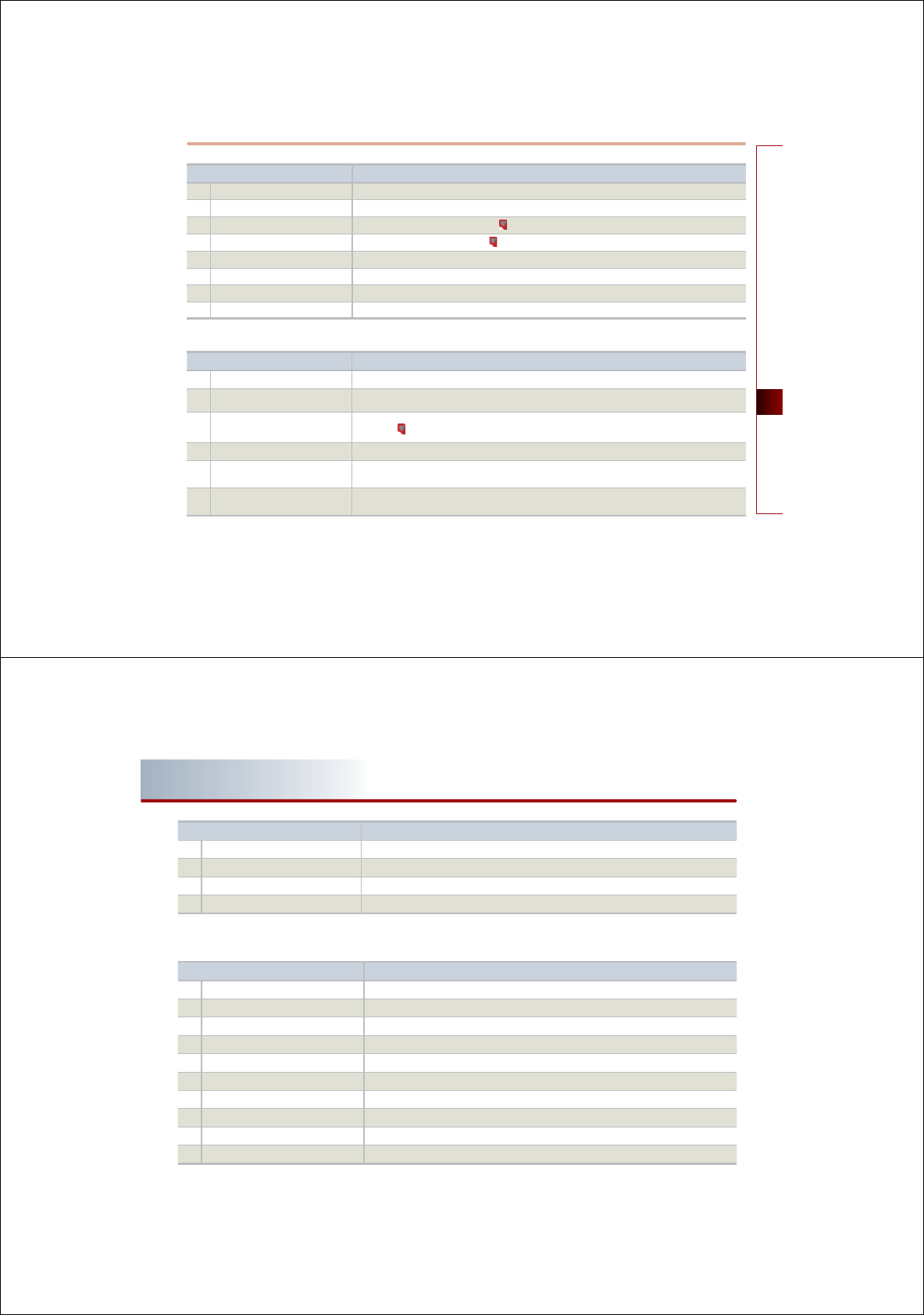
VOICE COMMAND SYSTEM 4-15
VOICE COMMAND SYSTEM
Command Operation
㿊 North up Displays the map in North Up mode.
㿊 Heading up Displays the map in Heading Up mode.
㿊
Show <POI name> (ex. Show ATM)
Displays the selected POI categories.
[POI Category list], page 4-18.
㿊 Hide <POI name> (ex. Hide ATM) Hides the selected POI categories.
[POI Category list], page 4-18.
㿊 Hide all Hides all POI categories.
㿊 Daylight mode Converts the map display into daylight mode.
㿊 Night mode Converts the map display into night mode.
㿊 Auto mode Converts the map display is between daylight/night modes automatically.
Destination
Command Operation
㿋Find address Sets the destination through address search for route guidance.
㿋Find nearest POI Sets a POI near the current position as the destination for route guidance through POI category
search.
㿋Find nearest <POI name>
Sets a POI near the current position as the destination by directly inputting the POI name for route
guidance.
[POI Category list], page 4-18.
㿋
Destination POI by phone number
Sets the destination by searching the phone number of the facility.
㿋Find Emergency <Category>
(ex. Find Emergency Hospital)
Searches for an emergency facility which is nearby the current position and sets it as the destination
for route guidance. Emergency facilities are police stations, hospitals, and dealerships.
㿋Destination by address book Sets one of the list of previously registered addresses in the address book for the user as the
destination.
4-16 VOICE COMMAND SYSTEM
PART 4 VOICE COMMAND SYSTEM
Route
Command Operation
㿋Previous destination Sets one of the previous destination as the current destination.
㿋Previous start point Sets the previous start point as the current destination.
㿋Go home Sets the previously registered home address as the destination for route guidance.
㿋Destination by memory point <1 to 5> Sets a previously registered memory point as the destination for route guidance
Command Operation
㿋Cancel route Deletes the designated destination and terminates the route guidance.
㿋Repeat voice guidance Repeats the route guidance.
㿋Detour <1 or 2 or 5 or 10> miles Searches detour routes within a <1|2|5|10> mile radius.
㿋Detour <1 or 2 or 5 or 10> kilometers Searches detour routes within a <1|2|5|10> kilometer radius.
㿋Replan recommended route Recalculates the route with the recommended route.
㿋Replan shortest route Recalculates the route with the shortest route.
㿋Distance to destination Reports the remaining distance until destination by voice.
㿋Time to destination Reports the remaining time until destination by voice.
㿊 View route If the destination has been set, displays the whole route screen until the destination.
㿊Start guidance Sets the scroll mark displayed on the map as the destination and starts route guidance.
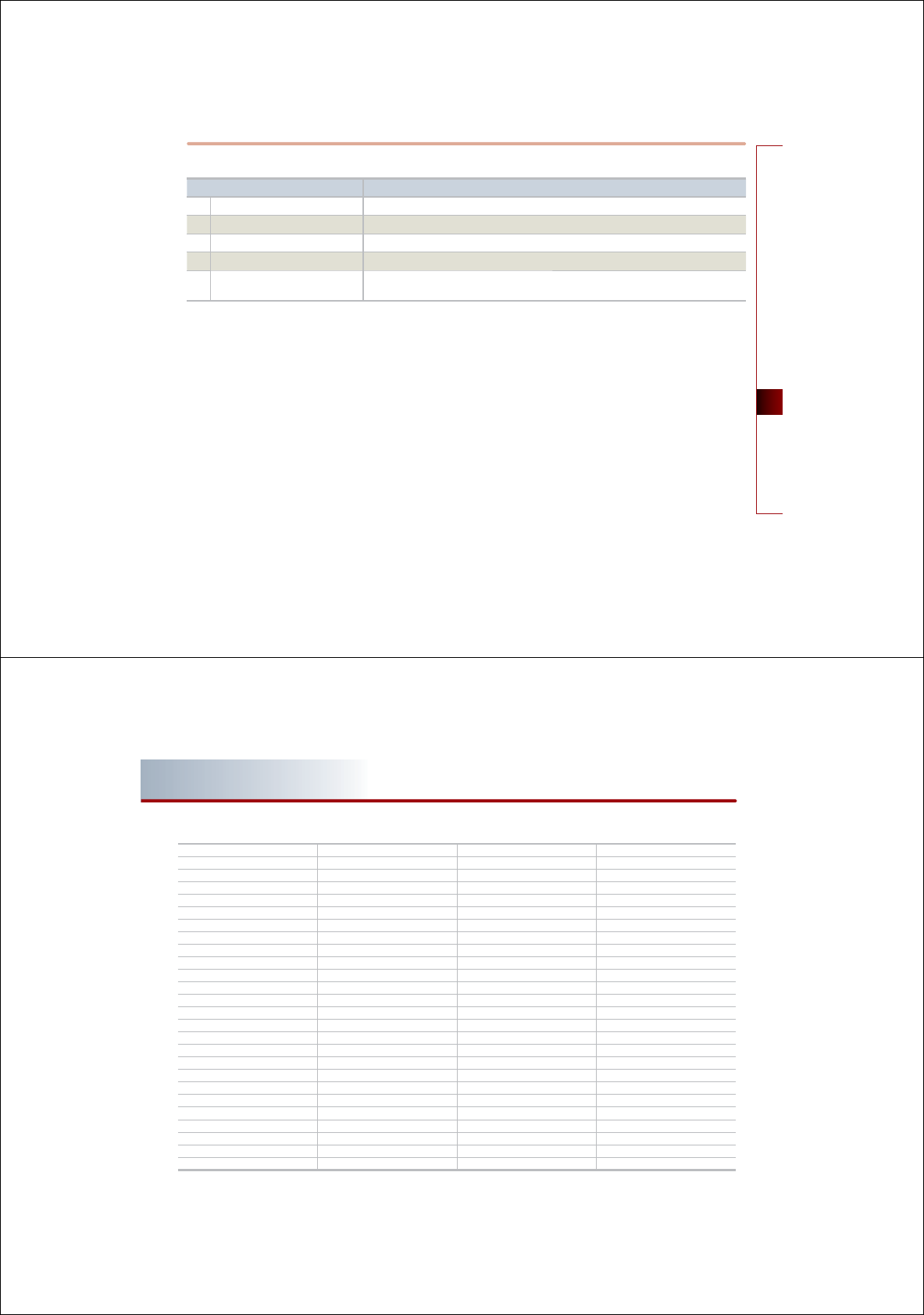
VOICE COMMAND SYSTEM 4-17
VOICE COMMAND SYSTEM
Others
Command Operation
㿋Voice guidance on Turns the Voice Guidance On.
㿋Voice guidance off Turns the Voice Guidance Off.
㿋Voice guidance louder Increases the Voice Guidance volume by 1 level.
㿋Voice guidance softer Decrease the Voice Guidance volume by 1 level.
㿋Store marked location to <text tag>
(ex. Store marked location to user 1) Registers the selected location into the selected Address book.
4-18 VOICE COMMAND SYSTEM
PART 4 VOICE COMMAND SYSTEM
㿋#POI Category list
All restaurants Car Wash Home Specialty Store Court House
Fast Food restaurant Motorcycle Dealership Clothing shop Fire Department
American restaurant All Travel Shoe Store Convention Center
French restaurant Airport Pharmacy City Hall
Italian restaurant Hotel All Recreation Civic Center
Continental restaurant Tourist Information Amusement Park School
Mexican restaurant Travel Agent Museum Government Offices
Japanese restaurant Tourist Attraction Cinema Waste & Sanitary
Chinese restaurant City Cnter Sports Activities Utilities
Korean restaurant Rental Car Agency Sports Complex All Services
Vegetarian Food restaurant Campground Golf Course Hospital
Seafood restaurant Ferry Terminal Winery Dentist
Latin American restaurant Bus Station Video & Game Rental Photography
Asian restaurant Local Transit Ski Resort Tax Service
African restaurant Train Station Recreation Area Medical Service
Coffee Shop All Shopping Other Recreation Attorney
Other restaurants Department Store All Financial Service Funeral Director
All Automotive Convenience Store Bank Hair & Beauty
Gas Station Shopping Center ATM Cleaning & Laundry
Parking Music Store Check Cashing Service Social Service
Auto service Grocery Store Money Transfer Physician
Road Assistance Bookstore Business Facility Communication services
KIA Dealership Electronics Store All Community Tailor & Alteration
Automobile Dealership Hardware Store Police Station Mover services
Auto Parts Gifts shop Post Office
Rest Area Sporting Goods store Library
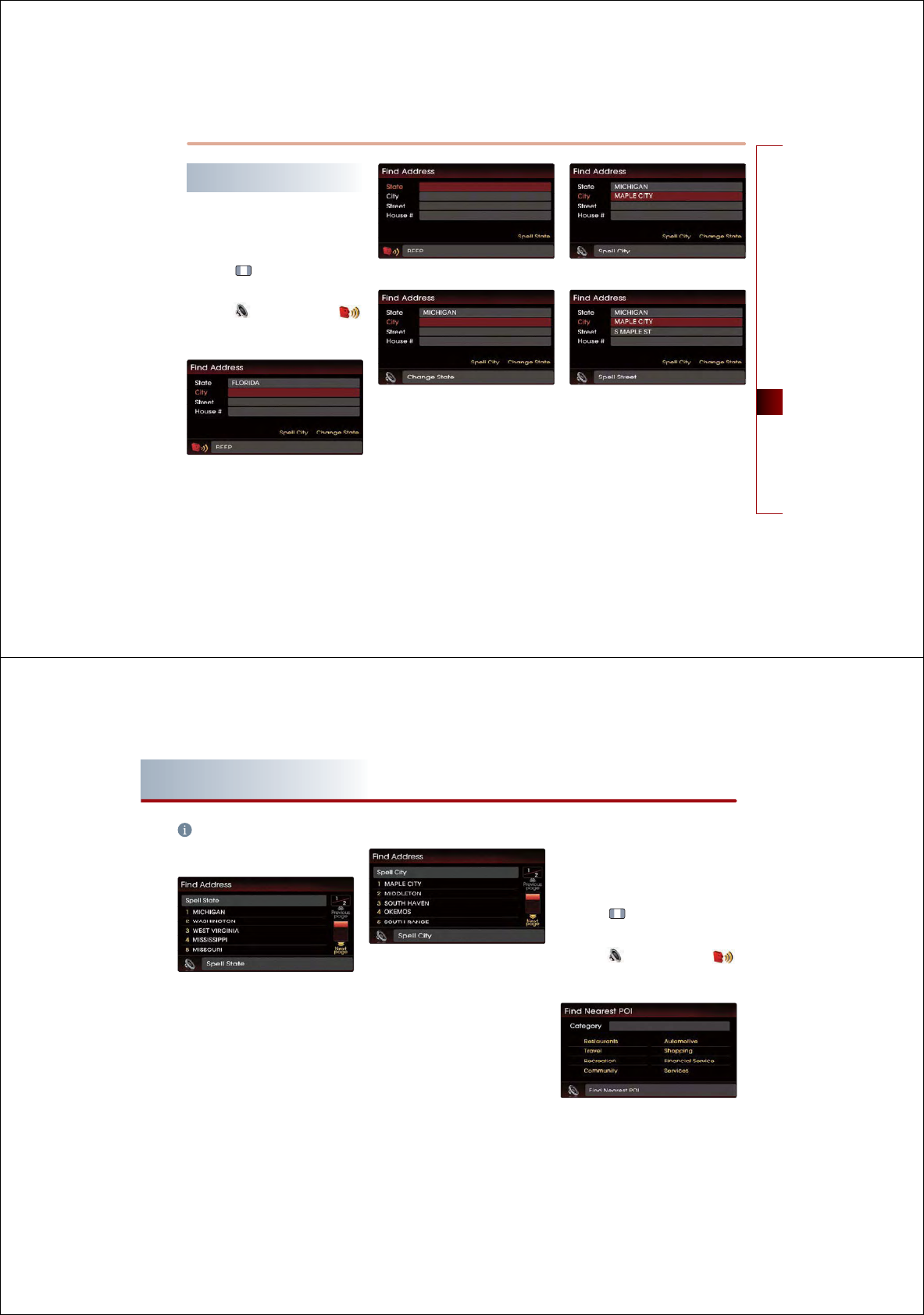
VOICE COMMAND SYSTEM 4-19
VOICE COMMAND SYSTEM
Searching a destination by voice
command
#
Find address
Sets the destination through address
search for route guidance.
1. Press the
key
on the Steering wheel
remote controller.
2. Once the icon changes into the
icon on the pop-up screen with a beep
sound, say "Find address".
3
.
Say "Change state" to change the state.
4
.
Say the state name.
5
.
Say the city name.
6
.
Say the street name.
7
.
Say the House number.
Here, the range which can be inputted
will be displayed.
8
.
Say "Start guidance" if guidance to the
selected position is desired, or say
"Show map" to verify the location of the
selected position on the map.
4-20 VOICE COMMAND SYSTEM
PART 4 VOICE COMMAND SYSTEM
INFORMATION
Spell recognition
●
It is possible to search the state, city, street
names through the text line inputted by the
user.
●
To enter spell search mode, say the "Spell
state, city, street names" command as
displayed on the screen.
●
Text lines can be inputted continuously.
Pick-List(n-best list)
●
If there are more than one voice result, then
a pick-list which can be selected by the user
will be displayed.
●
There may be more than one list page. The
desired page can be viewed by using
commands such as "next page" or "previous
page".
●
Here, the "Line + number" voice command
can be used to select the desired result,
such as "Line one". Pressing the desired
result is not supported.
●
Also, selectable areas will be highlighted in
yellow, allowing the user to easily see which
results can be selected.
Find nearest POI
Sets a POI near the current position as the
destination for route guidance through POI
category search.
1. Press the
key
on the Steering wheel
remote controller.
2. Once the icon changes into the
icon on the pop-up screen with a beep
sound, say "find nearest POI".
3. Select the desired main category.
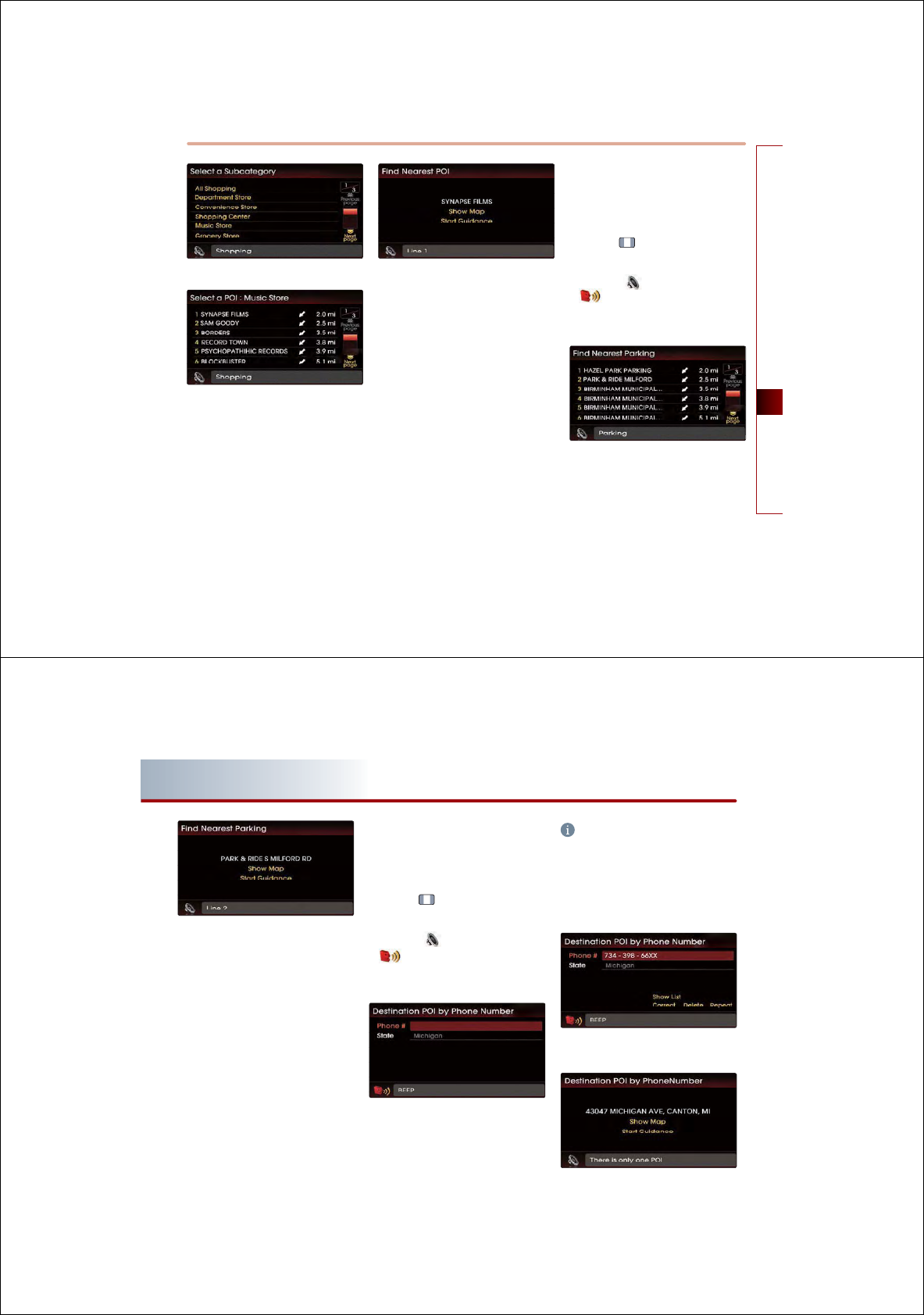
VOICE COMMAND SYSTEM 4-21
VOICE COMMAND SYSTEM
4. Select the desired sub category.
5. Select the desired POI from the list and say
the line number for the corresponding
menu. Ex) "Line 1".
6. Say "Start guidance" if guidance to the
selected position is desired, or say "Show
map" to verify the location of the selected
position on the map.
Find nearest <POI name>
Sets a POI near the current position as the
destination by directly inputting the POI
name for route guidance.
1. Press the key on the Steering wheel
remote controller.
2. Once the icon changes into the
icon on the pop-up screen with a
beep sound, say "Find nearest Parking".
3. Select the desired POI from the list and
say the line number for the correspond-
ing menu.
e.g) "Line 2".
4-22 VOICE COMMAND SYSTEM
PART 4 VOICE COMMAND SYSTEM
4. Say "Start guidance" if guidance to the
selected position is desired, or say
"Show map" to verify the location of
the selected position on the map.
Destination POI by phone number
Sets the destination by searching the
phone number of the facility.
1. Press the key on the Steering wheel
remote controller.
2. Once the icon changes into the
icon on the pop-up screen with a
beep sound, say "Destination POI by
Phone number".
3. Input the 10 numbers for the phone
number.
INFORMATION
Continuous recognition of phone numbers is
possible, and the recognized result will be
displayed in block units. To correct a block
unit, say "correct". To delete the entire result,
say "delete". To have the input read back, say
"repeat".
4.
Say "Show list" to view the resulting search
list.
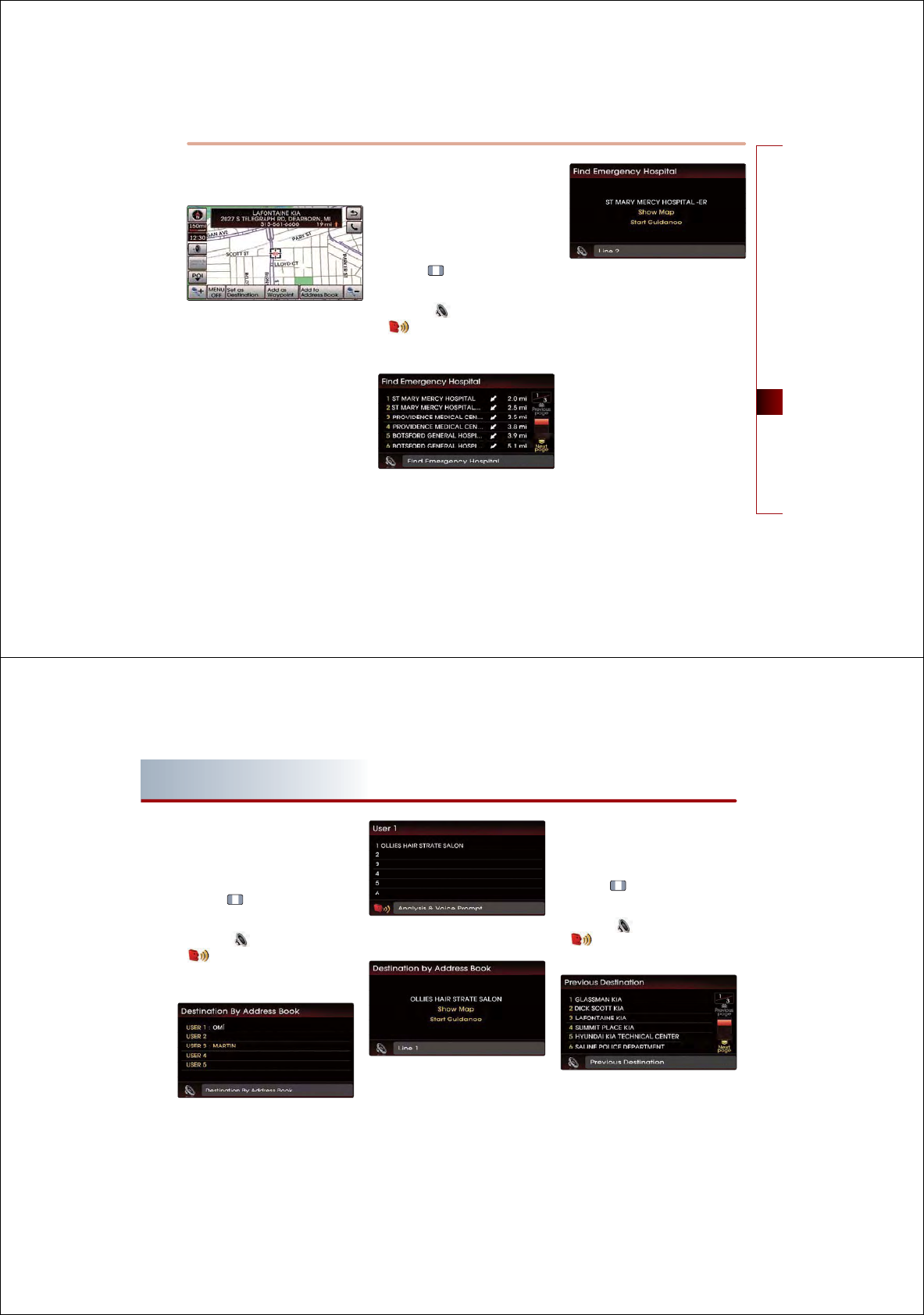
VOICE COMMAND SYSTEM 4-23
VOICE COMMAND SYSTEM
5. Select the desired location from the list
and say the line command.
6. Say "Start guidance" if guidance to the
selected position is desired, or say
"Show map" to verify the location of
the selected position on the map.
Find emergency <Category> :
Searches for an emergency facility which
is nearby the current position and sets it
as the destination for route guidance.
Emergency facilities are police stations,
hospitals, and dealerships.
1. Press the key on the Steering wheel
remote controller.
2. Once the icon changes into the
icon on the pop-up screen with a
beep sound, say the voice command.
Ex)㾟Find emergency hospital㾠
3. Select the desired location from the list
and say the line command.
4. Say "Start guidance" if guidance to the
selected position is desired, or say
"Show map" to verify the location of
the selected position on the map.
4-24 VOICE COMMAND SYSTEM
PART 4 VOICE COMMAND SYSTEM
Destination by address book
Sets one of the list of previously registe-
red addresses in the address book for the
user as the destination.
1. Press the key on the Steering wheel
remote controller.
2. Once the icon changes into the
icon on the pop-up screen with a
beep sound, say "Destination by
address book".
3. Select the desired user name(Address book
name).
4. Select the desired location from the list and
say the line command.
5. Say "Start guidance" if guidance to the
selected position is desired, or say "Show
map" to verify the location of the selected
position on the map.
Previous destination
Sets one of the previous destination as
the current destination.
1. Press the key on the Steering wheel
remote controller.
2. Once the icon changes into the
icon on the pop-up screen with a
beep sound, say "Previous destination".
3. Select the desired location from the list
and say the line command.
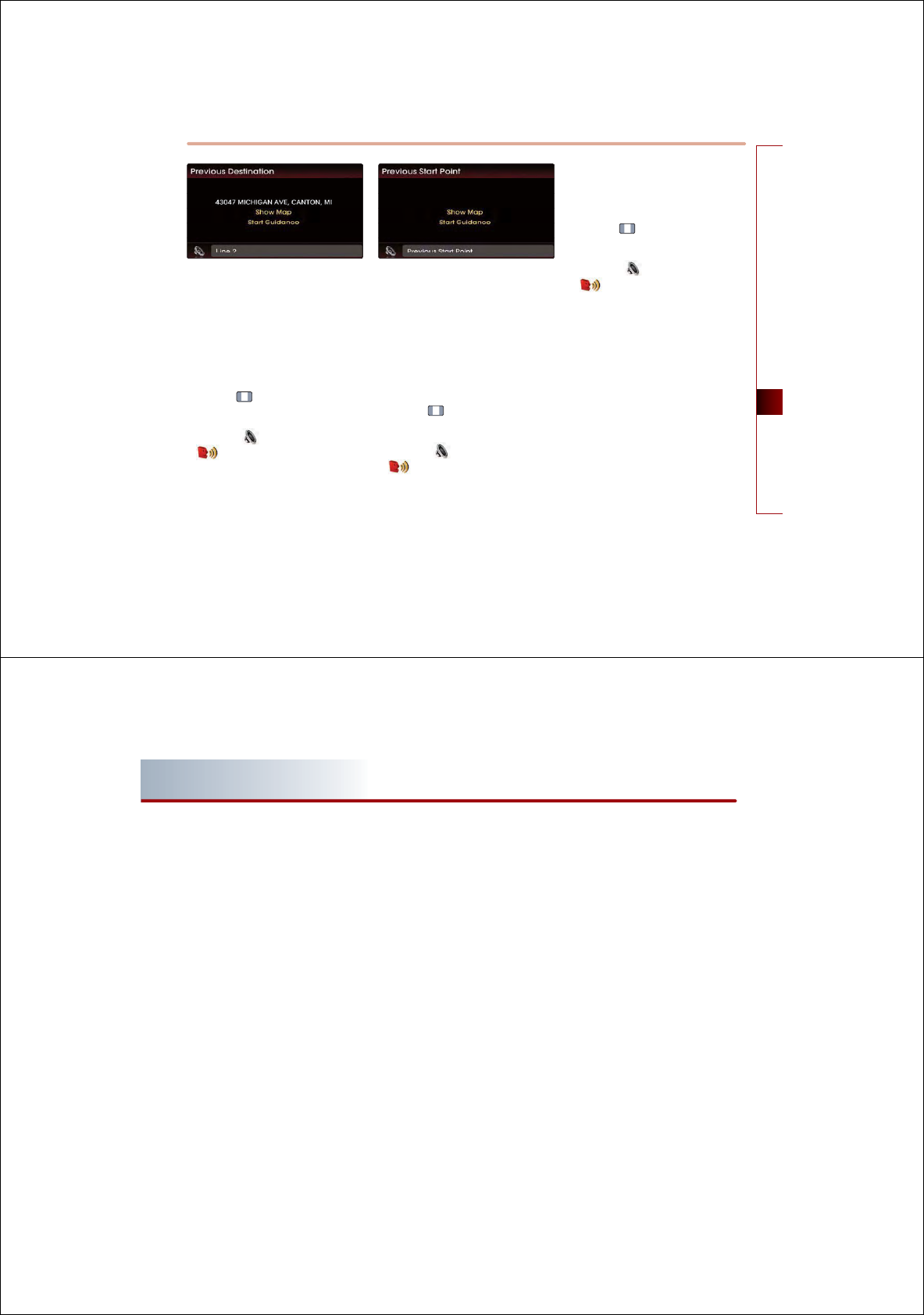
VOICE COMMAND SYSTEM 4-25
VOICE COMMAND SYSTEM
4. Say "Start guidance" if guidance to the
selected position is desired, or say "Show
map" to verify the location of the selected
position on the map.
Previous start point
Sets the previous start point as the cur-
rent destination.
1. Press the key on the Steering wheel
remote controller.
2. Once the icon changes into the
icon on the pop-up screen with a
beep sound, say "Previous start point".
3. Say "Start guidance" if guidance to the
selected position is desired, or say
"Show map" to verify the location of
the selected position on the map.
Go home
Sets the previously registered home
address as the destination for route gui-
dance.
1. Press the key on the Steering wheel
remote controller.
2. Once the icon changes into the
icon on the pop-up screen with a
beep sound, say "Go home".
Destination by memory point <1 to 5>
Sets a previously registered memory point
as the destination for route guidance.
1. Press the key on the Steering wheel
remote controller.
2. Once the icon changes into the
icon on the pop-up screen with a
beep sound, say "Destination by
memory point 1".
PART 5 BLUETOOTH® HANDSFREE
PART 5
BLUETOOTH® HANDSFREE
Before using the Bluetooth
®
Handsfree
# 䐙䐙䐙䐙䐙䐙䐙䐙 #5-2
What is Bluetooth
®
?# 㾕㾕㾕㾕㾕㾕 #5-2
Functions supported by Bluetooth
®
Handsfree# 㾕㾕㾕㾕㾕㾕㾕㾕㾕㾕 #5-2
Converting Bluetooth® Handsfree
mode
# 䐙䐙䐙䐙䐙䐙䐙䐙䐙䐙 #5-2
Converting from Audio/Navigation mode to
Bluetooth
®
Handsfree mode#㾕㾕㾕 #5-2
Converting from Bluetooth
®
Handsfree
mode to Audio/Navigation mode#㾕 #5-3
Pairing and connecting a Bluetooth®
phone
#䐙䐙䐙䐙䐙䐙䐙䐙䐙䐙 #5-4
Pairing a mobile phone#㾕㾕㾕㾕㾕 #5-4
Deleting a paired phone# 㾕㾕㾕㾕 #5-6
Connecting a mobile phone#㾕㾕㾕 #5-7
Disconnecting a mobile phone#㾕 㾕 #5-8
Bluetooth® Handsfree screen
layout
#䐙䐙䐙䐙䐙䐙䐙䐙䐙䐙 #5-9
Bluetooth
®
Handsfree screen and
functions#㾕㾕㾕㾕㾕㾕㾕㾕㾕㾕㾕 #5-9
When there is no mobile phone
connected# 㾕㾕㾕㾕㾕㾕㾕㾕㾕㾕㾕 #5-9
When a mobile phone is connected#㾕 #5-9
When receiving an incoming call#㾕㾕#5-10
When already on a call# 㾕㾕㾕㾕㾕㾕 #5-10
When there is a call waiting# 㾕㾕㾕㾕 #5-10
Making a call
# 䐙䐙䐙䐙䐙䐙䐙 #5-11
Making a call by dialing a phone
number# 㾕㾕㾕㾕㾕㾕㾕㾕㾕㾕㾕 #5-11
Making a call from Speed Dial #㾕㾕 #5-11
Making a call by redialing#㾕㾕㾕㾕 #5-12
Answering a call
#䐙䐙䐙䐙䐙䐙 #5-13
Answering an incoming call #㾕㾕㾕 #5-13
Rejecting an incoming #㾕㾕㾕㾕㾕 #5-13
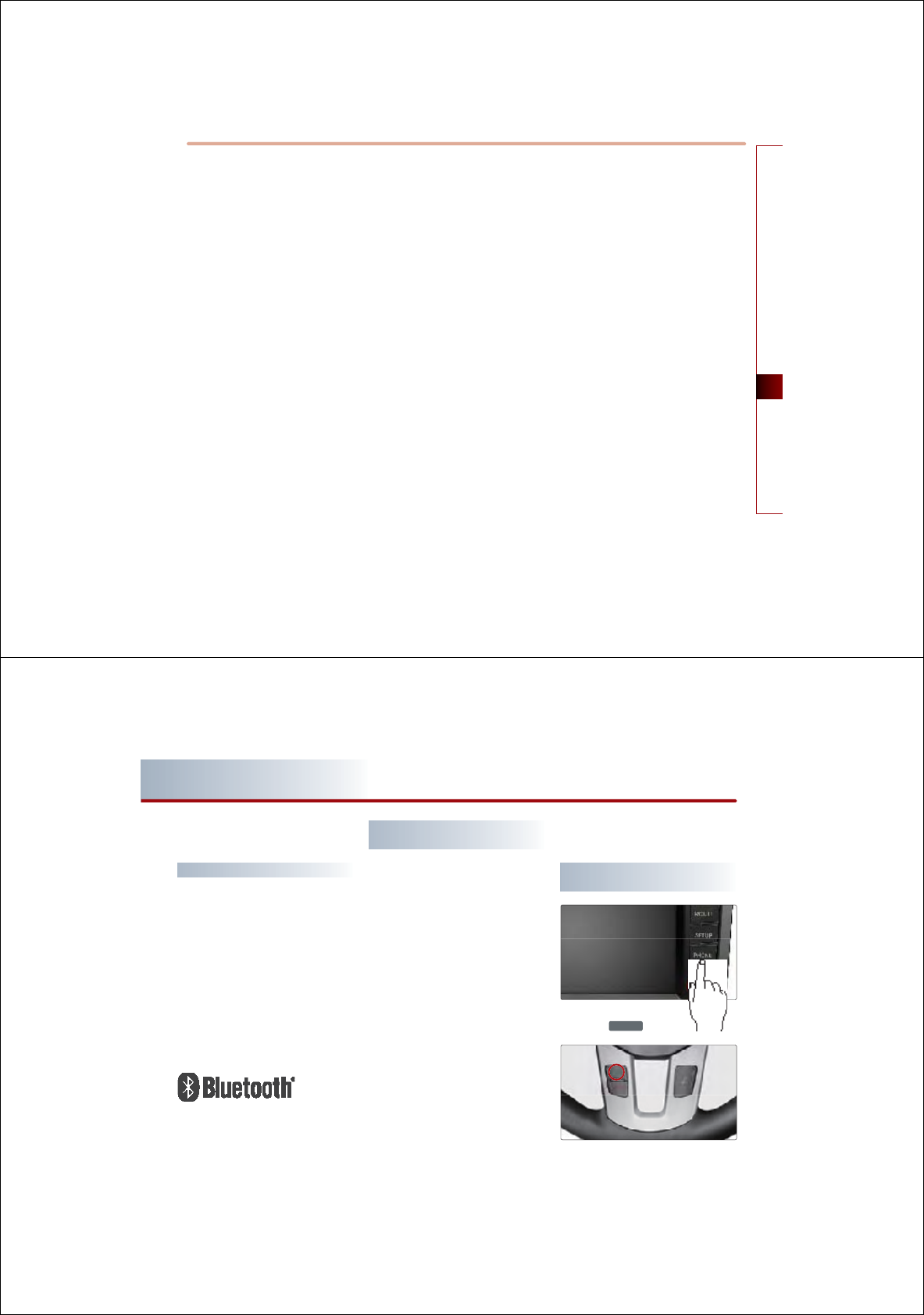
BLUETOOTH® HANDSFREE 5-1
BLUETOOTH
Ⓡ
HANDSFREE
PART 5
BLUETOOTH® HANDSFREE
Operating menus during a call
##
5-14
Switching call to the mobile phone# #5-14
Activating Call waiting# 㾕㾕㾕㾕㾕 #5-14
Ending a call# 㾕㾕㾕㾕㾕㾕㾕㾕㾕 #5-15
Phone Book
#䐙䐙䐙䐙䐙䐙䐙䐙 #5-16
Making a call from the Phone book# #5-16
Searching the Phone Book#㾕㾕㾕㾕 #5-17
Searching by name # 㾕㾕㾕㾕㾕㾕㾕 #5-17
Searching by number # 㾕㾕㾕㾕㾕㾕 #5-18
Call History List
# 䐙䐙䐙䐙䐙䐙 #5-19
Making a call from Call history #㾕㾕 #5-19
Sorting call history #㾕㾕㾕㾕㾕㾕㾕 #5-19
Phone Music
# 䐙䐙䐙䐙䐙䐙䐙 #5-21
Before playing Phone Music#㾕㾕㾕 #5-21
Starting Phone Music#㾕㾕㾕㾕㾕㾕 #5-21
Phone Music screen layout# 㾕㾕㾕 #5-22
Selecting Phone Music files# 㾕㾕㾕 #5-23
Bluetooth® settings
#䐙䐙䐙䐙䐙 #5-24
Pairing and connecting a mobile
phone#㾕㾕㾕㾕㾕㾕㾕㾕㾕㾕㾕㾕 #5-24
Setting mobile phone auto connect
priority# 㾕㾕㾕㾕㾕㾕㾕㾕㾕㾕㾕 #5-24
Setting Handsfree volume#㾕㾕㾕㾕 #5-25
Setting Audio streaming# 㾕㾕㾕㾕 #5-26
Advanced settings#㾕㾕㾕㾕㾕㾕㾕 #5-26
Searching and modifying
my device properties#㾕㾕㾕㾕㾕㾕㾕 #5-27
Changing passkey #㾕㾕㾕㾕㾕㾕㾕㾕 #5-28
Deleting all paired phones# 㾕㾕㾕㾕 #5-28
Initializing Bluetooth
®
handsfree#㾕㾕#5-29
Important information
# 䐙䐙䐙 #5-30
About pairing mobile phones …… 5-30
About making/answering
phone calls #㾕㾕㾕㾕㾕㾕㾕㾕㾕㾕 #5-31
About Bluetooth
®
device environment #㾕 #5-31
5-2 BLUETOOTH® HANDSFREE
PART 5 BLUETOOTH® HANDSFREE
Before using the Bluetooth®
Handsfree
What is Bluetooth® ?
●
Bluetooth® allows wireless transmission of
information between PC, mobile phones, head-
sets, PDAs, printers and other devices within
close ranges by using 2.45Ghz frequency short-
distance wireless telecommunication technolo-
gies.
●
Within this vehicle, users can make hands-
free calls, transmit mobile phone data, and
play audio streaming files by connecting a
mobile phone with the system.
Functions supported by
Bluetooth® Handsfree
●
Pairing mobile phones (Up to 5 phones)
●
Connecting/disconnecting mobile phones
●
Making/Answering phone calls
●
Downloading a Phone Book
●
Downloading a Call history list
●
Playing music saved in a Bluetooth phone in
the vehicle
Some functions may not be supported in
some mobile phone.
Converting Bluetooth®
Handsfree mode
Converting from Audio/Navigation
mode to Bluetooth® Handsfree mode
1. While in Audio mode or Navigation mode,
press the
3+21(
key or the key on
the steering wheel.
Bluetooth® is a trademark owned by
Bluetooth® SIG, Inc.
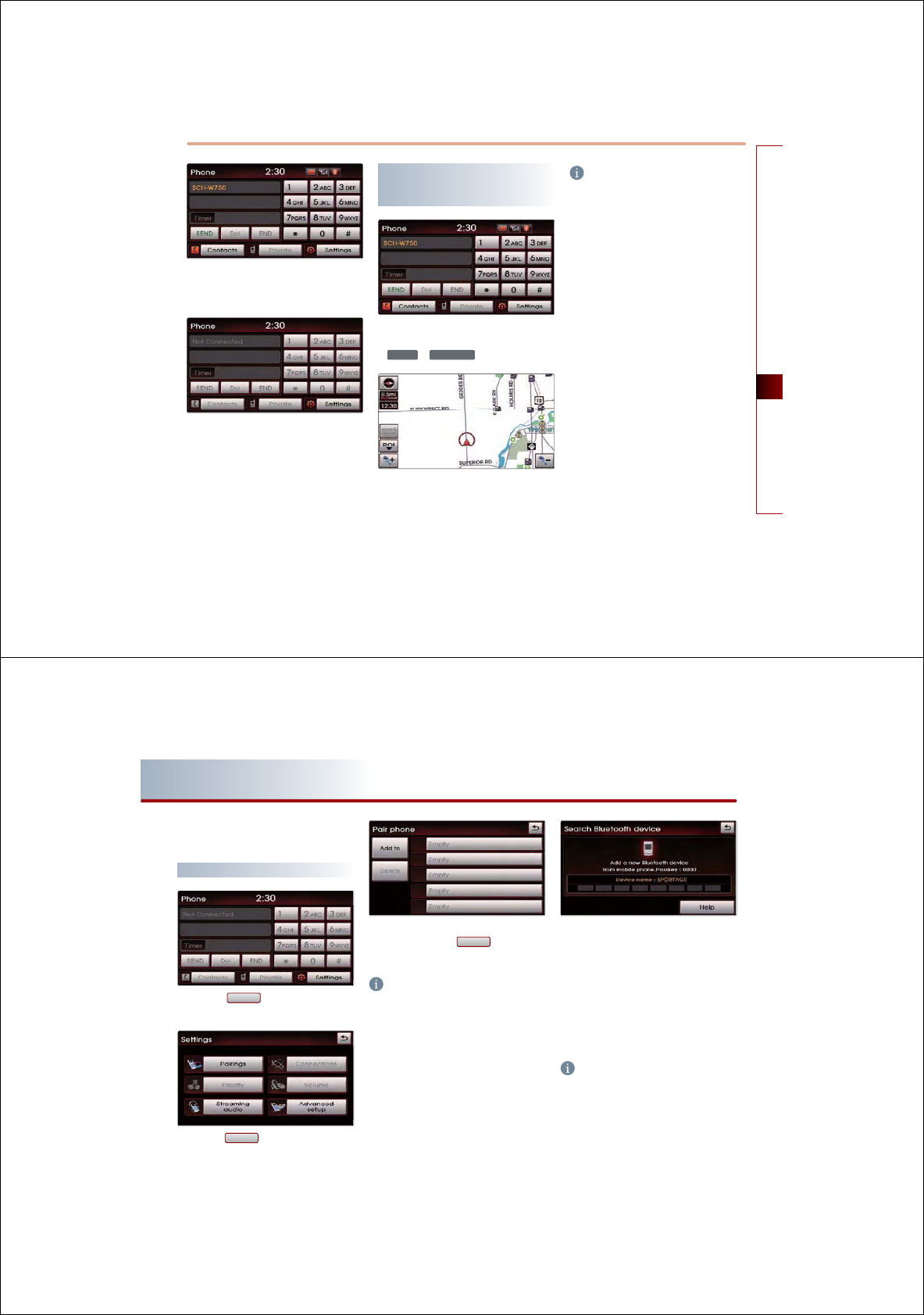
BLUETOOTH® HANDSFREE 5-3
BLUETOOTH
Ⓡ
HANDSFREE
2. The system will change to Bluetooth®
Handsfree mode and display the PHONE
screen.
3. The following screen will become displayed
if no mobile phone has been connected.
Converting from Bluetooth®
Handsfree mode to Audio/
Navigation mode
1. While in Bluetooth® Handsfree mode, press
an Audio/Navigation mode key, such as
)0$0
or
0$392,&(
.
2. The corresponding mode will be displayed.
INFORMATION
Most of the functions of the Audio or SETUP
modes are not supported while on a
Bluetooth® Handsfree call. The call volume
and Navigation (MAP VOICE, DEST, ROUTE)
screens can be operated.
5-4 BLUETOOTH® HANDSFREE
PART 5 BLUETOOTH® HANDSFREE
Pairing and connecting a
Bluetooth® phone
Pairing a mobile phone
1. Press the
6HWWLQJV
button on the PHONE
screen.
2. Press the
3DLULQJV
button on the Settings
screen.
3. The list of currently paired phones will be
displayed. Press the
$GGWR
button to pair
a new mobile phone.
INFORMATION
For safety reasons, pairing a Bluetooth
®
phone is not possible when the vehicle is in
motion.
Park the vehicle in a safe location to pair a
new phone. It is possible to pair up to five
mobile phones. In order to pair a new
phone when there are already five mobile
phones paired, you must first delete one of
the previously paired phones.
4. From the Bluetooth® device list within the
mobile phone, add the car handsfree.
The default name of the car system is
SPORTAGE.
For more information on registering
Bluetooth® devices from the mobile phone,
please refer to the mobile phone user's
manual.
INFORMATION
While conducting a Bluetooth
®
device
search from the mobile phone, operating to
another screen will prevent the car hands-
free from being found in the mobile phone.
Always conduct searches for Bluetooth
®
devices with the Search Bluetooth
®
device
screen displayed.
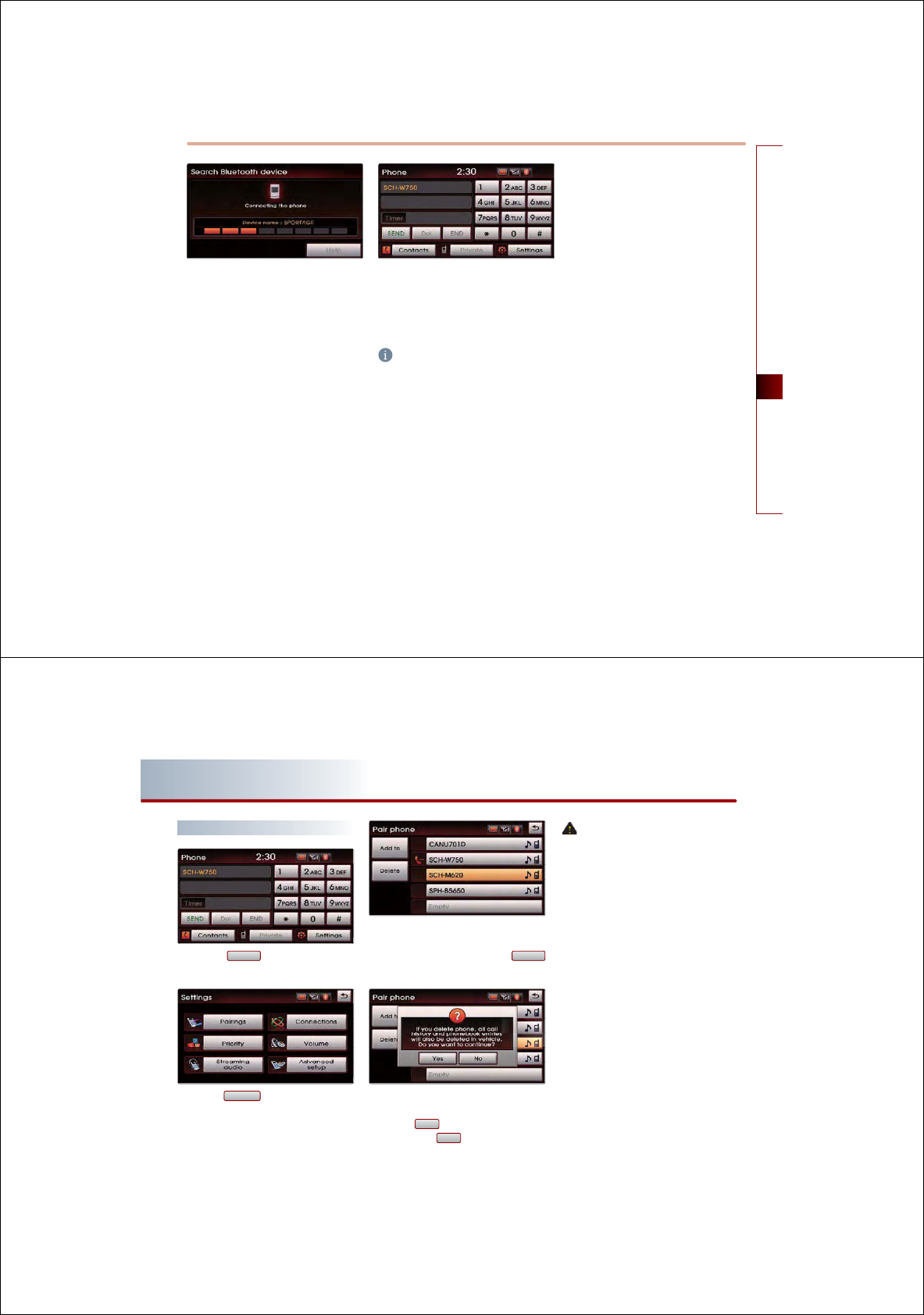
BLUETOOTH® HANDSFREE 5-5
BLUETOOTH
Ⓡ
HANDSFREE
5. When pairing the car handsfree from the
mobile phone, a passkey input window will
become displayed on the mobile phone
screen. Input the passkey set within the car
system into the mobile phone input win-
dow. (The factory state passkey is 0000.) As
shown in the figure, once the passkey
becomes successfully inputted, the
Bluetooth® connection between the car sys-
tem and mobile phone will start.
6. Once Bluetooth® connection is successful,
the name of the connected mobile phone
will become displayed on the PHONE
screen and Bluetooth® handsfree functions
will operate.
INFORMATION
Some functions may not be supported due
to limited Bluetooth
®
compatibility
between the car system and mobile phone.
5-6 BLUETOOTH® HANDSFREE
PART 5 BLUETOOTH® HANDSFREE
Deleting a paired phone
1. Press the
6HWWLQJV
button on the PHONE
screen.
2. Press the
3DLULQJV
button on the Settings
screen.
3. The list of currently paired phones will be
displayed. Select the phone you wish to
delete from the list and press the
'HOHWH
button.
4.
A pop-up asking whether you wish to
delete the paired phone will be displayed.
Press the
<HV
button to delete the paired
phone and the
1R
button to cancel.
CAUTION!
A mobile phone cannot be deleted if it is cur-
rently connected to the car system.
To delete the phone, first disconnect the
mobile phone and try again.
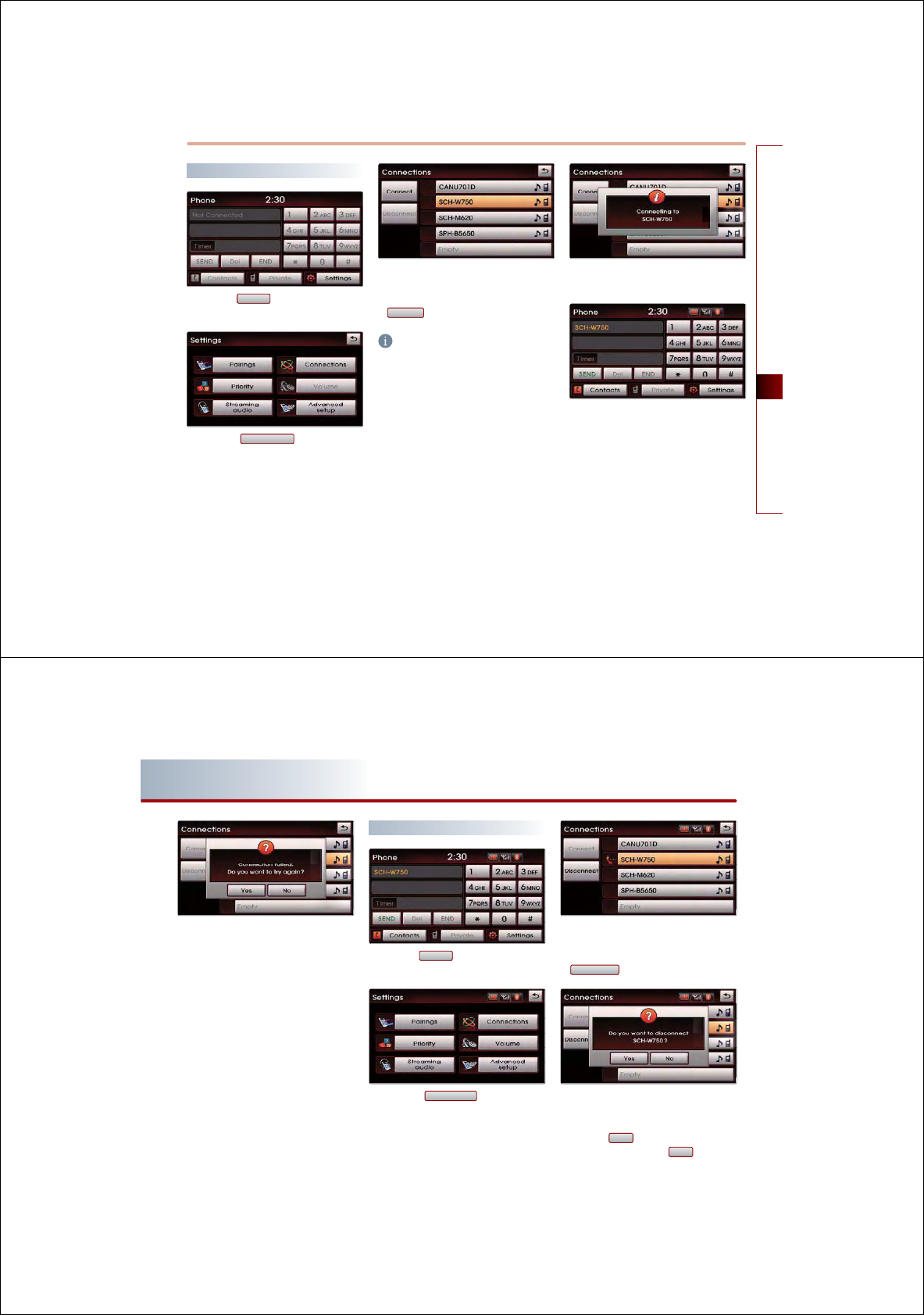
BLUETOOTH® HANDSFREE 5-7
BLUETOOTH
Ⓡ
HANDSFREE
Connecting a mobile phone
1.
Press the
6HWWLQJV
button on the PHONE
screen.
2.
Press the
&RQQHFWLRQV
button on the
Settings screen.
3. The list of currently paired phones will be
displayed. Select the phone you wish to
connect from the list and press the
&RQQHFW
button.
INFORMATION
When there are no paired phones, pair the
mobile phone through [Settings>Pairings>
Add to]. For more information on pairing
mobile phones, refer to the user's manual
[Pairing and Connecting a Bluetooth phone >
Pairing a mobile phone].
4.
The Bluetooth connection between the car
system and mobile phone will start.
5.
Once Bluetooth connection is successful,
the name of the connected mobile phone
will become displayed on the PHONE
screen and Bluetooth handsfree functions
will operate.
5-8 BLUETOOTH® HANDSFREE
PART 5 BLUETOOTH® HANDSFREE
6.
If the connection between the mobile
phone and Bluetooth® fails, the following
pop-up will be displayed. If problems occur
while connecting Bluetooth®, check for the
following conditions.
●
Whether the mobile phone you wish to
connect is in the vicinity of the car system
●
Whether the power of the mobile phone
Bluetooth® has been turned off
●
Whether the mobile phone Bluetooth® has
been set to hidden state
●
Whether there are Bluetooth® compatibility
issues between the car system and another
mobile phone
Disconnecting a mobile phone
1.
Press the
6HWWLQJV
button on the PHONE
screen.
2.
Press the
&RQQHFWLRQV
button on the
Settings screen.
3.
The list of currently paired phones will be
displayed. Select the phone you wish to
disconnect from the list and press the
'LVFRQQHFW
button.
4.
A pop-up asking whether you wish to dis-
connect the mobile phone will be dis-
played.
Press the
<HV
button to disconnect the
mobile phone and the
1R
button to
cancel.
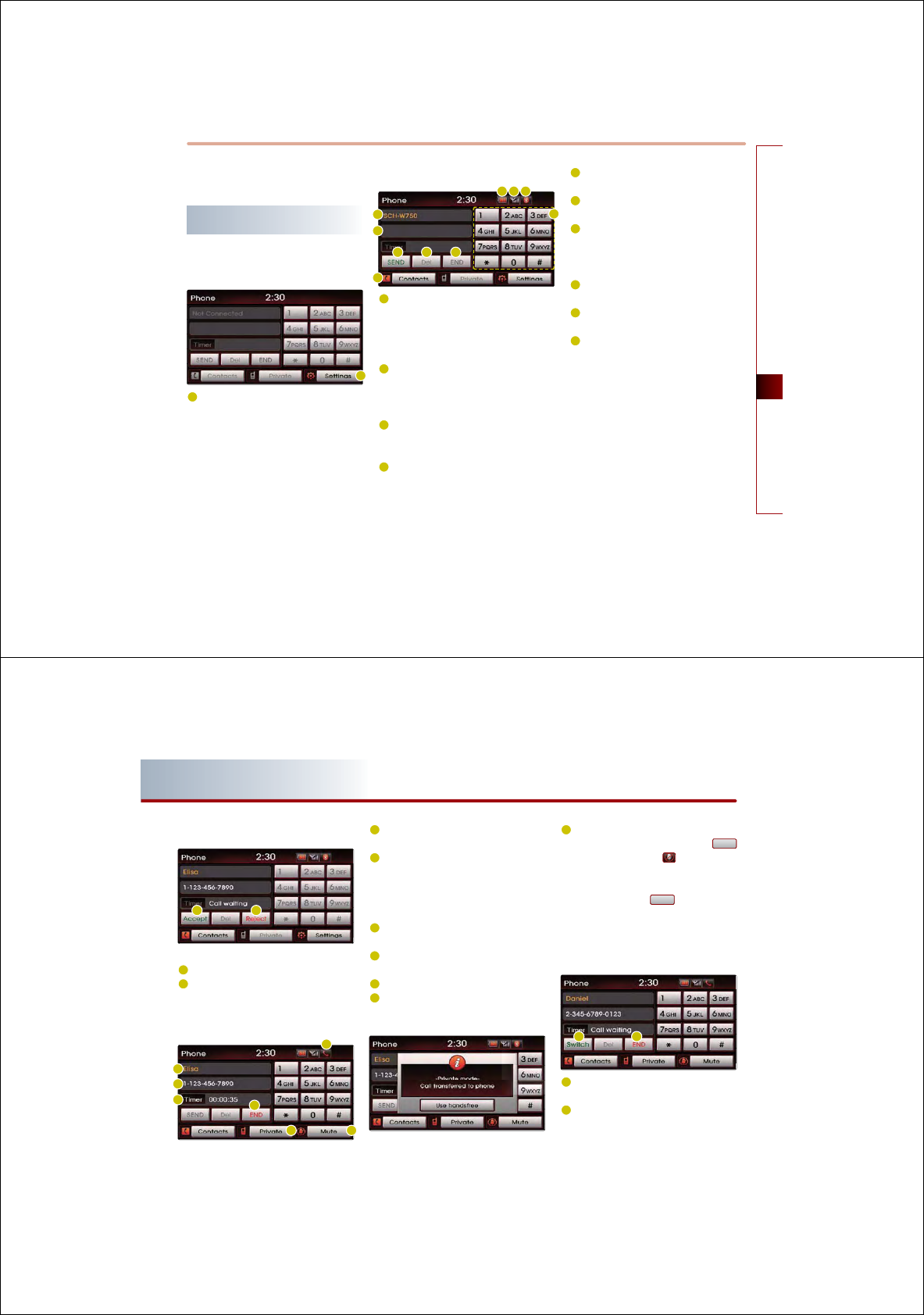
BLUETOOTH® HANDSFREE 5-9
BLUETOOTH
Ⓡ
HANDSFREE
Bluetooth® Handsfree screen
layout
Bluetooth® Handsfree screen and
functions
When there is no mobile phone
connected
Settings : The user can set desired settings
for the Bluetooth® handsfree, such as pair/
delete mobile phone, connect/ disconnect
mobile phone, set call volume, change
device name and change passkey.
When a mobile phone is connected
Phone battery charge status : Displays the
battery charge status of the connected
mobile phone. The battery charge status
may not be displayed in some mobile
phones.
Signal strength : Displays the mobile
phone signal strength. The signal strength
may not be displayed in some mobile
phones.
Bluetooth® connection state : Becomes
displayed when a Bluetooth® phone has
been connected with the car system.
Name of connected mobile phone :
Displays the name of the connected
mobile phone.
Phone number input window : Displays
the inputted phone number.
Dial : Input the phone number through
the dial pad.
SEND : If a number has not been entered
the phone number input window, pres-
sing the send button displays the call his-
tory list screen.
Del : Deletes the inputted number one
digit at a time.
END : If a number has been inputted, then
erases the entire number.
Contacts : Displays the phone book screen.
The user can search previously saved
phone numbers. The phone contact list
may not be displayed in some mobile
phones.
4
5
8
9
44
; <
43
6 7
:
5-10 BLUETOOTH® HANDSFREE
PART 5 BLUETOOTH® HANDSFREE
When receiving an incoming call
Accept : Accepts the incoming call.
Reject : Rejects the incoming call.
When already on a call
Busy icon : When already on a call, displays
an icon shaped like a receiver.
Name of incoming caller : Displays the
name of incoming caller. The name of the
incoming caller will not be displayed if the
caller's phone number has not been pre-
viously registered in the phone book.
Number of incoming caller : Displays the
number of the incoming caller.
Call state : Displays the call state, such as
talk time, phone connection, and end time.
END : Ends the call.
Private : When talking on the car hands-
free, use this function to switch the call to
the mobile phone.
Mute : Use this function to mute the
outgoing volume. Pressing the
0XWH
button will display the at the top right
side of the screen and the caller will not be
able to hear the conversation taking place
in the car. Press the
0XWH
button again to
release the Mute function.
When there is a call waiting
Switch : Use this button to switch between
callers when there are calls on call waiting.
END : Use this button to end the calls with
all callers.
45 46
47
48
49
4: 4;
54 55
4< 53
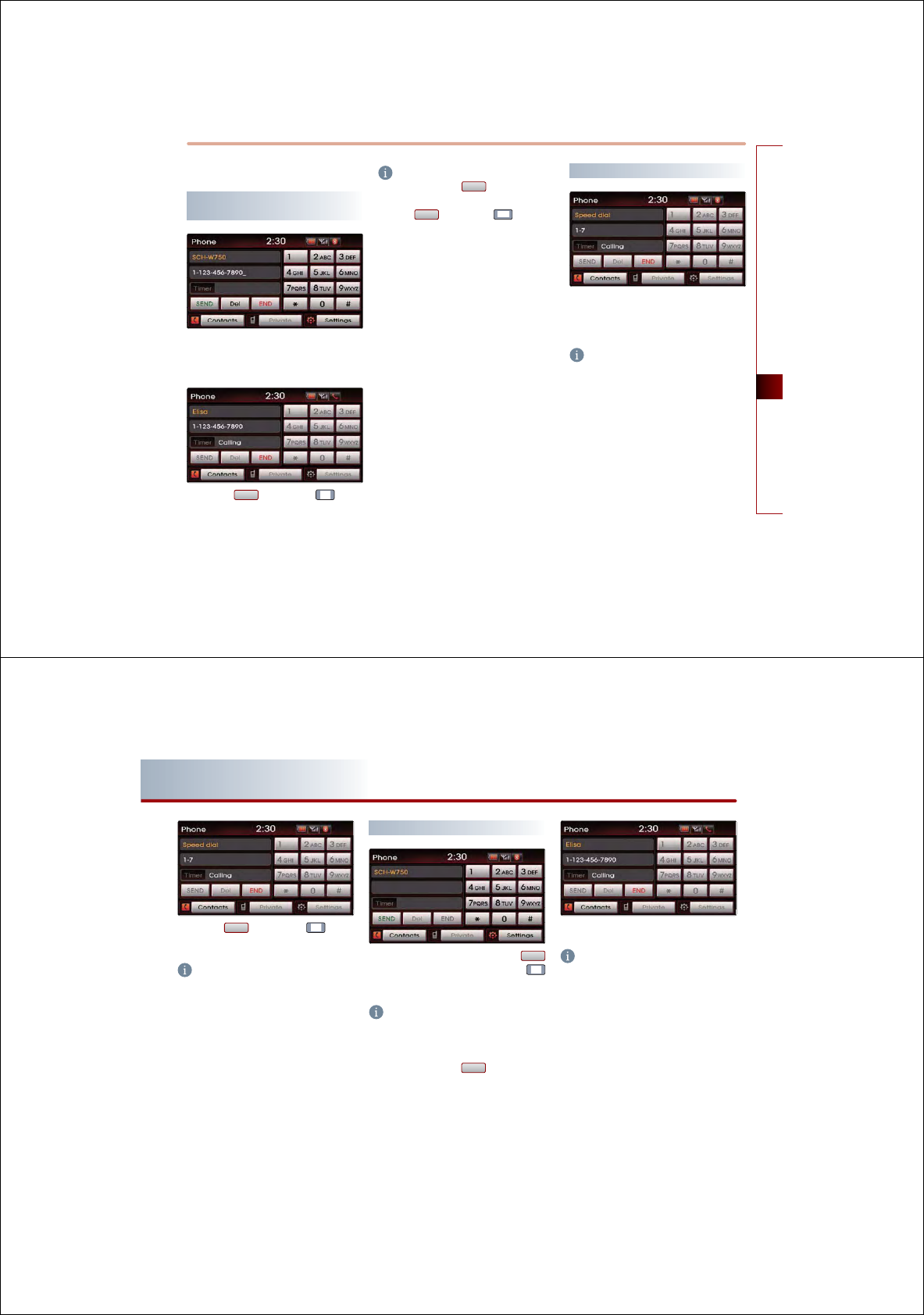
BLUETOOTH® HANDSFREE 5-11
BLUETOOTH
Ⓡ
HANDSFREE
Making a call
Making a call by dialing a phone
number
1. Use the number pad on the right side of the
PHONE screen to input the number you
wish to call.
2.
Press the
6(1'
button or the key on
the steering wheel to make the call.
INFORMATION
To modify, press the
'HO
button to delete
the inputted number one digit at a time.
Press the
(1'
button or the
key on the
steering wheel to cancel the call.
Making a call from Speed Dial
1. Use the number pad on the right side of the
PHONE screen to input a speed dial num-
ber.
INFORMATION
Only speed dial numbers already stored on
the mobile phone can be used for speed dial
calls.
Up to 2-digit speed dial numbers are suppor-
ted.
5-12 BLUETOOTH® HANDSFREE
PART 5 BLUETOOTH® HANDSFREE
2. Press the
6(1'
button or the key on
the steering wheel to make the call.
INFORMATION
For 2-digit speed dial numbers, press and hold
the 2nd digit to make a call to the speed dial
number.
Making a call by redialing
1.
Press and hold (over 0.8 second) the
6(1'
button on the PHONE screen or the
key on the steering wheel.
INFORMATION
Redialing is not possible when there is no call
history or the call history list is being down-
loaded from the mobile phone. When there is
no call history list, the
6(1'
button will be
inactive.
2.
The recently called number is redialed.
INFORMATION
It is not possible to display the AUDIO mode
and Settings screen when on a phone call.
Only the call volume and Navigation (MAP,
DEST, ROUTE) screens can be operated.
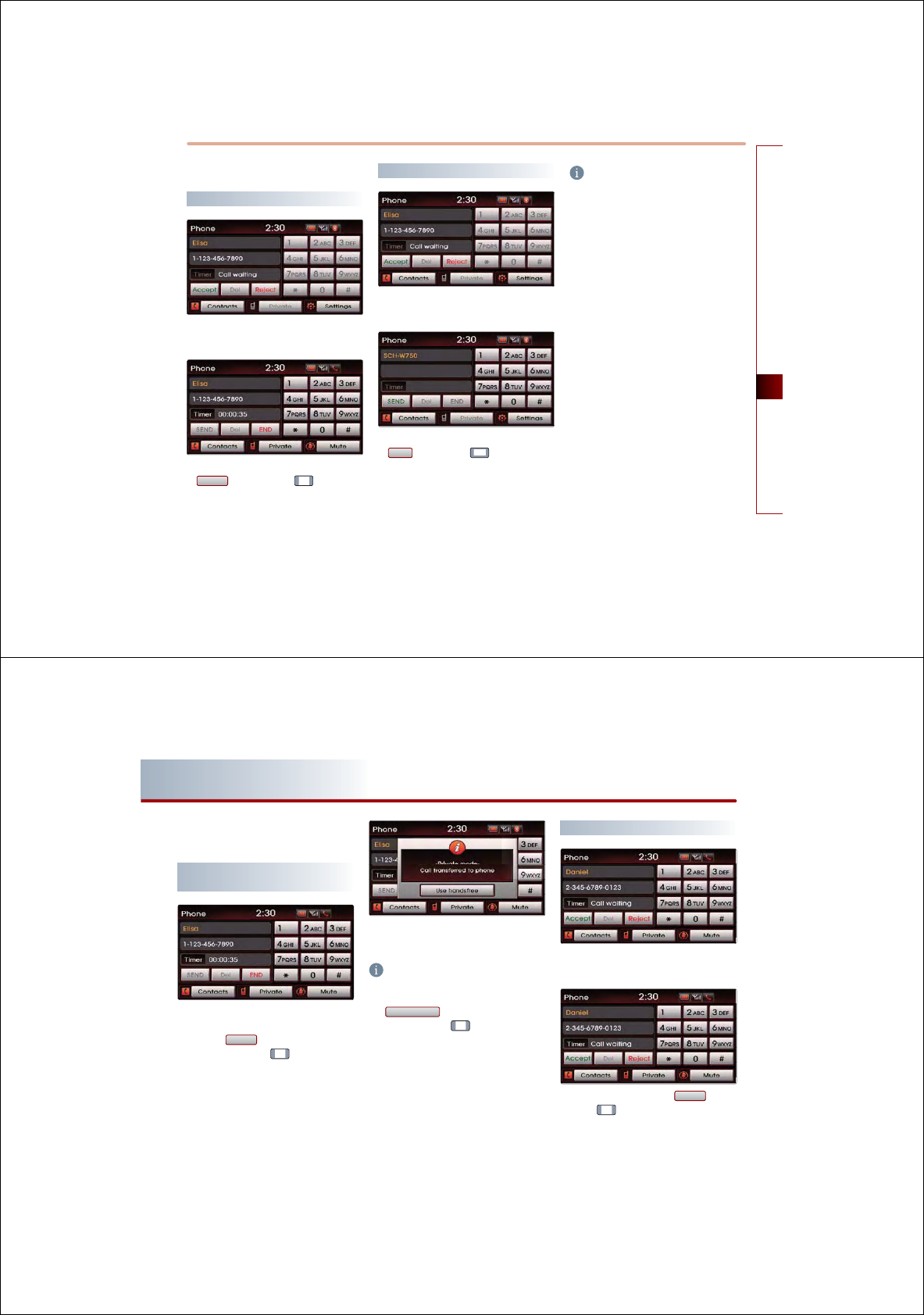
BLUETOOTH® HANDSFREE 5-13
BLUETOOTH
Ⓡ
HANDSFREE
Answering a call
Answering an incoming call
1.
The following screen will be displayed
when you receive an incoming call.
2.
To answer the incoming call, press the
$FFHSW
button or the key on the
steering wheel.
Rejecting an incoming
1.
The following screen will be displayed
when you receive an incoming call.
2.
To reject the incoming call, press the
5HMHFW
button or the key on the stee-
ring wheel. The incoming call will be rejec-
ted.
INFORMATION
Upon receiving a call, the [Reject] function
may not be supported in some mobile
phones.
5-14 BLUETOOTH® HANDSFREE
PART 5 BLUETOOTH® HANDSFREE
Operating menus during a call
Switching call to the mobile
phone
1.
If you wish to switch the call to the mobile
phone while talking on the car handsfree,
press the
3ULYDWH
button or press and hold
(over 0.8 second) the key on the stee-
ring wheel.
2.
As shown, the call will be switched to the
mobile phone.
INFORMATION
If you wish to switch the call to the car hands-
free while talking on the mobile phone, press
the
8VHKDQGVIUHH
button or press and hold
(over 0.8 second) the
key on the steering
wheel. The call will be switched to the car
handsfree.
Activating Call waiting
1. If another person calls while already on a
call, the following screen will be displayed.
2. Press the need screen with
$FFHSW
button
or the key on the steering wheel to
receive the incoming call by switching to
the new caller.
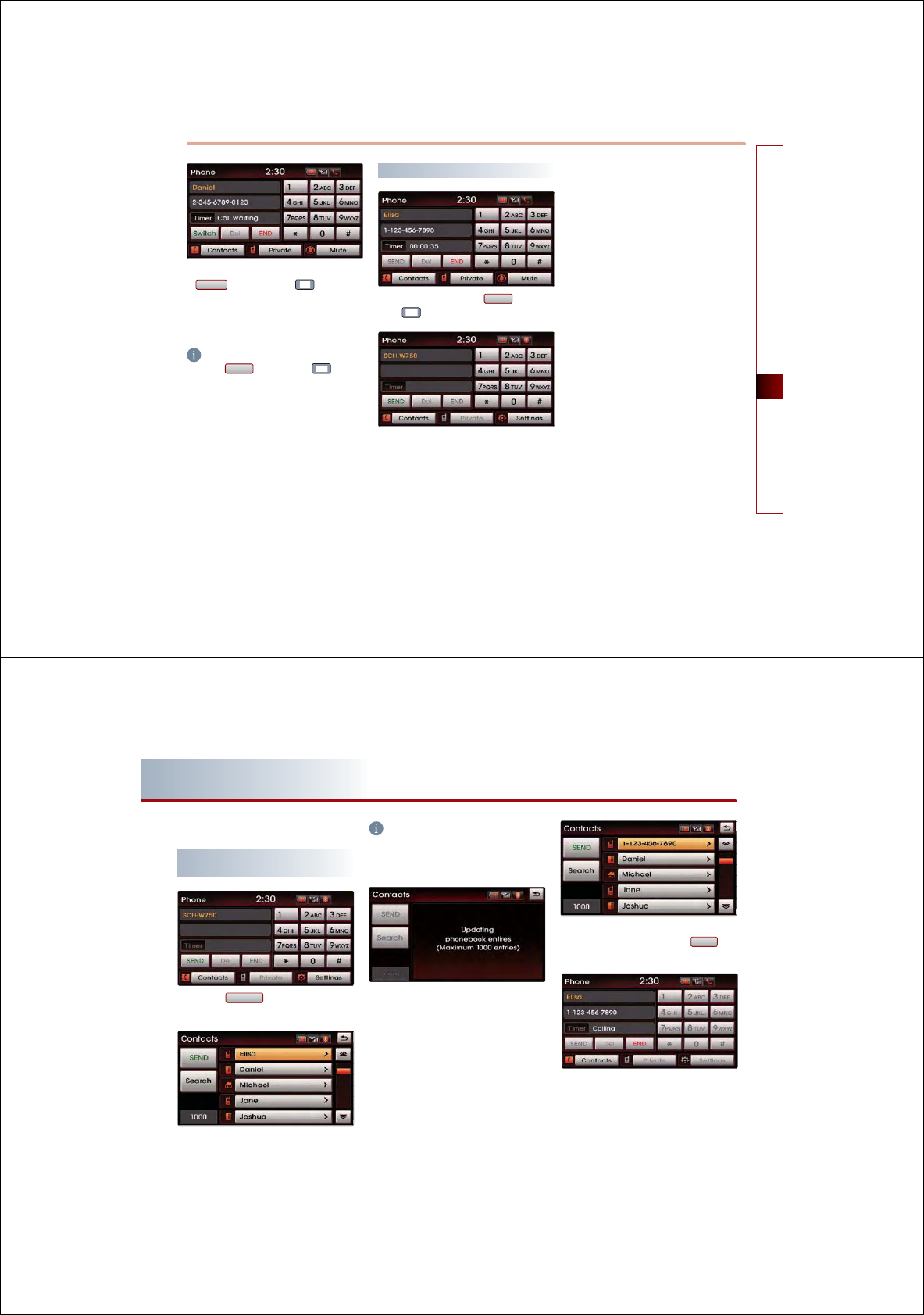
BLUETOOTH® HANDSFREE 5-15
BLUETOOTH
Ⓡ
HANDSFREE
3. To switch again to the other caller, press the
6ZLWFK
button or the key on the
steering wheel. The other call will be
received and the previous call will switch
back to call waiting.
INFORMATION
Press the
(QG
button or the
key on
the steering wheel to end the current call and
call waiting.
Ending a call
1. To end a call, press the
(QG
button or
the key on the steering wheel.
2.
The call will be ended.
5-16 BLUETOOTH® HANDSFREE
PART 5 BLUETOOTH® HANDSFREE
Phone Book
Making a call from the Phone
book
1
.
Press the
&RQWDFWV
button on the PHONE
screen.
2
.
The phone book list will be displayed.
INFORMATION
● The system may begin to slow down when
downloading the phone book in some
mobile phones.
● Upon connecting a mobile phone, the
phone book lists saved in the mobile phone
will automatically be downloaded
(Maximum 1000 entries). The phone book
download function may not be supported
in some mobile phones.
● If you do not wish to automatically down-
load the mobile phone contacts to the vehi-
cle, turn the Contacts Sync setting OFF.
(Phone>Settings>Advanced setup>
Contacts Sync)
3
.
Select the number you wish to call from the
phone book list and press the
6(1'
but-
ton.
4
.
The call will be made to the selected num-
ber.
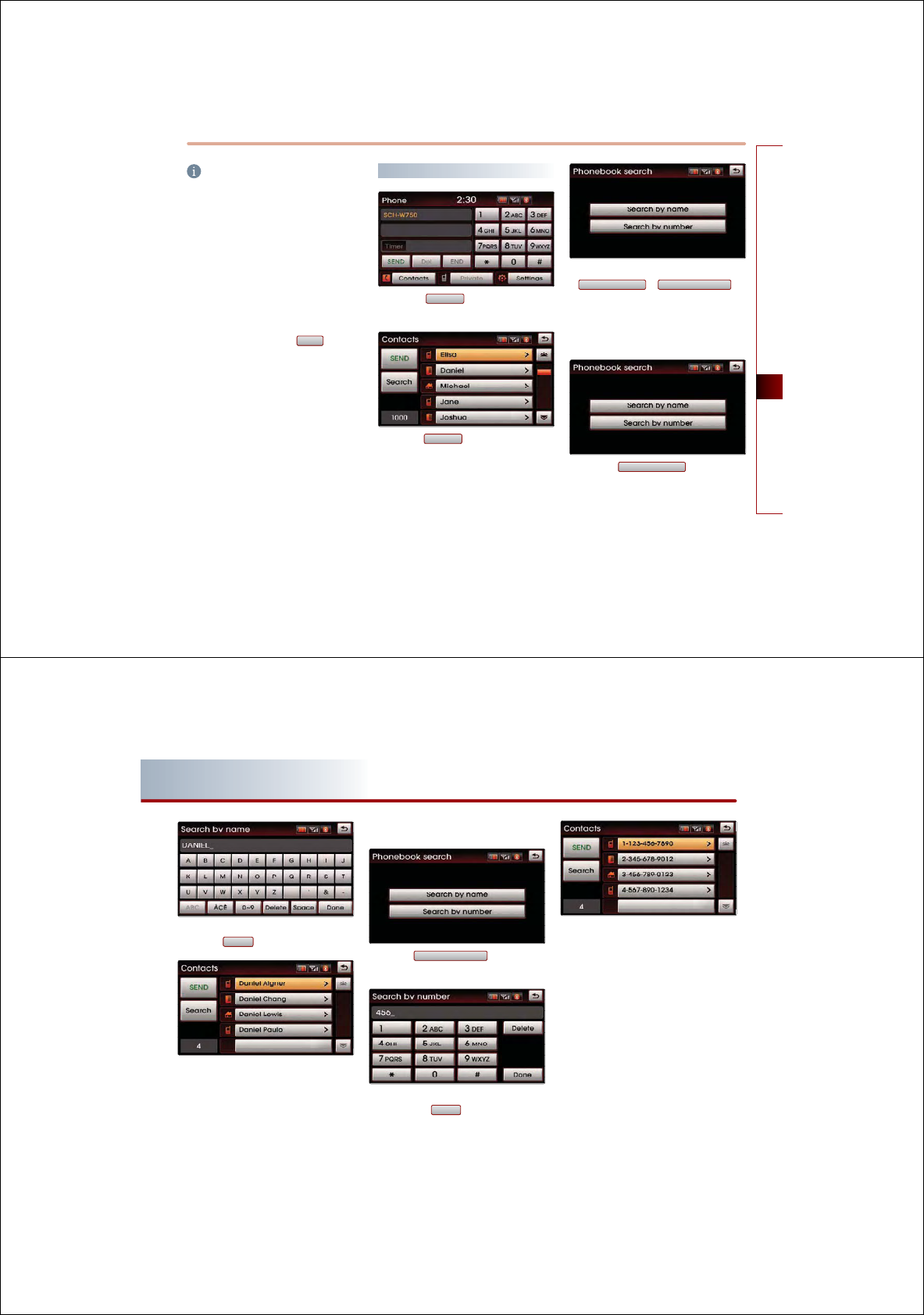
BLUETOOTH® HANDSFREE 5-17
BLUETOOTH
Ⓡ
HANDSFREE
INFORMATION
● When there are more than 2 numbers saved
in one phone number list, if the list is repea-
tedly selected, the registered phone num-
bers will be displayed sequentially on the
list.
●
The Mobile Phone/Office/Home categories
received via the mobile phone may differ
from the information actually stored in the
mobile phone.
● Select the phone number you wish to
connect by repeatedly selecting the phone
number list and press the
6(1'
button to
make the call to the selected number.
Searching the Phone Book
1
.
Press the
&RQWDFWV
button on the PHONE
screen.
2
.
Press the
6HDUFK
button on the Contacts
screen.
3
.
Phone numbers can be searched by either
6HDUFKE\QDPH
or
6HDUFKE\QXPEHU
.
From the two methods, select the search
method you wish to use.
Searching by name
4
.
Press the
6HDUFKE\QDPH
button on the
Phonebook search screen.
5-18 BLUETOOTH® HANDSFREE
PART 5 BLUETOOTH® HANDSFREE
5
.
Input the name you wish to search and
press the
'RQH
button.
6
.
The search results will be displayed on the
screen.
Searching by number
4.
Press the
6HDUFKE\QXPEHU
button on the
Phonebook search screen.
5
.
Input the phone number you wish to search
and press the
'RQH
button.
6
.
The search results will be displayed on the
screen.
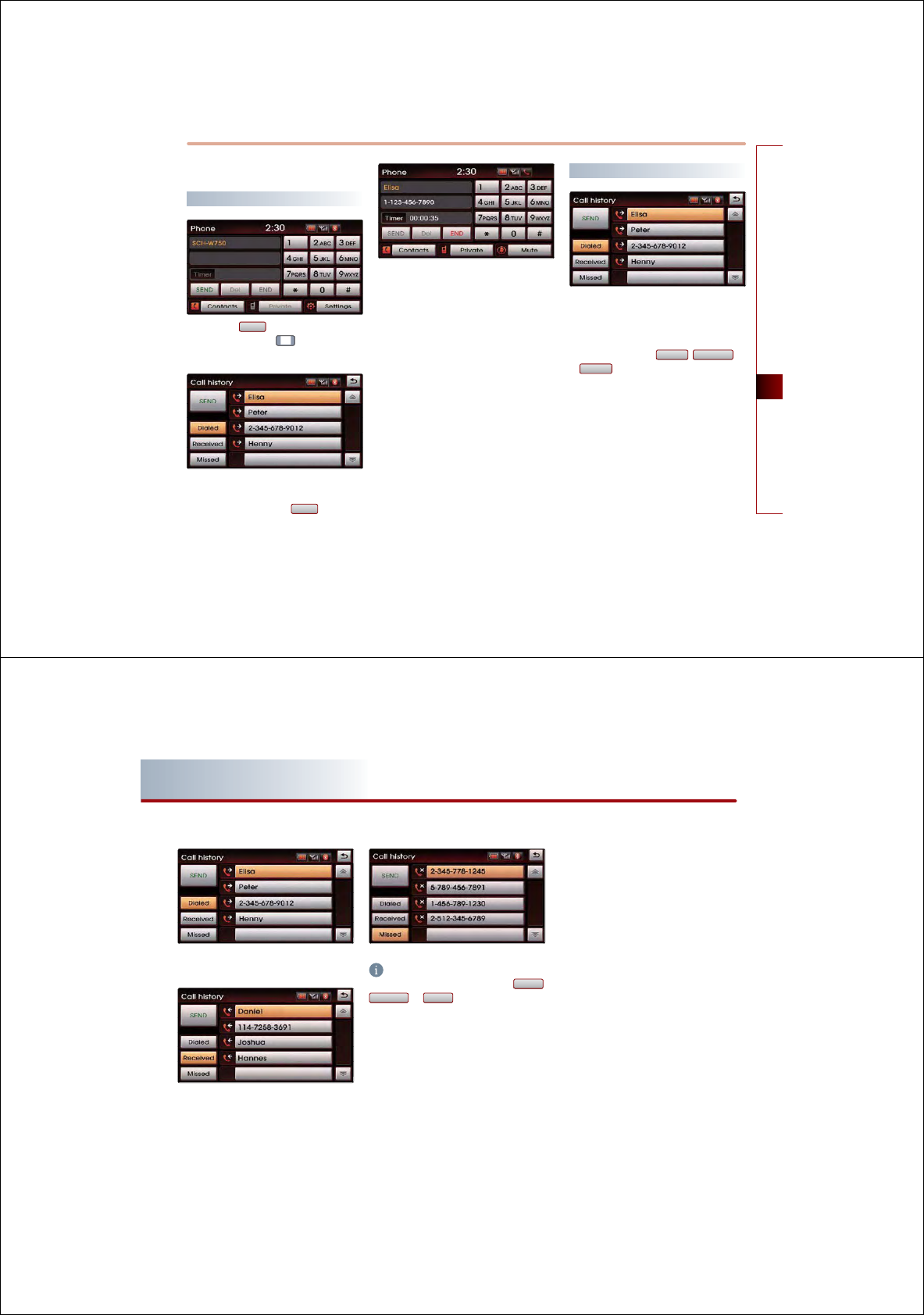
BLUETOOTH® HANDSFREE 5-19
BLUETOOTH
Ⓡ
HANDSFREE
Call History List
Making a call from Call history
1.
Press the
6(1'
button on the PHONE
screen or press the key on the stee-
ring wheel.
2.
The call history list will be displayed. Select
the number you wish to call from the call
history list and press the
6(1'
button.
3.
The call will be made to the selected num-
ber.
Sorting call history
1.
The call history can be displayed by sorting
the incoming calls, outgoing calls and
missed calls.
2.
When pressing the
'LDOHG
,
5HFHLYHG
, or
0LVVHG
button, the corresponding call his-
tory list will be displayed.
5-20 BLUETOOTH® HANDSFREE
PART 5 BLUETOOTH® HANDSFREE
Dialed number
Received number
Missed number
INFORMATION
If there are no entries saved in the
'LDOHG
,
5HFHLYHG
, or
0LVVHG
lists, the corresponding
button will be inactive. Up to 20 entries can
be saved in each list.
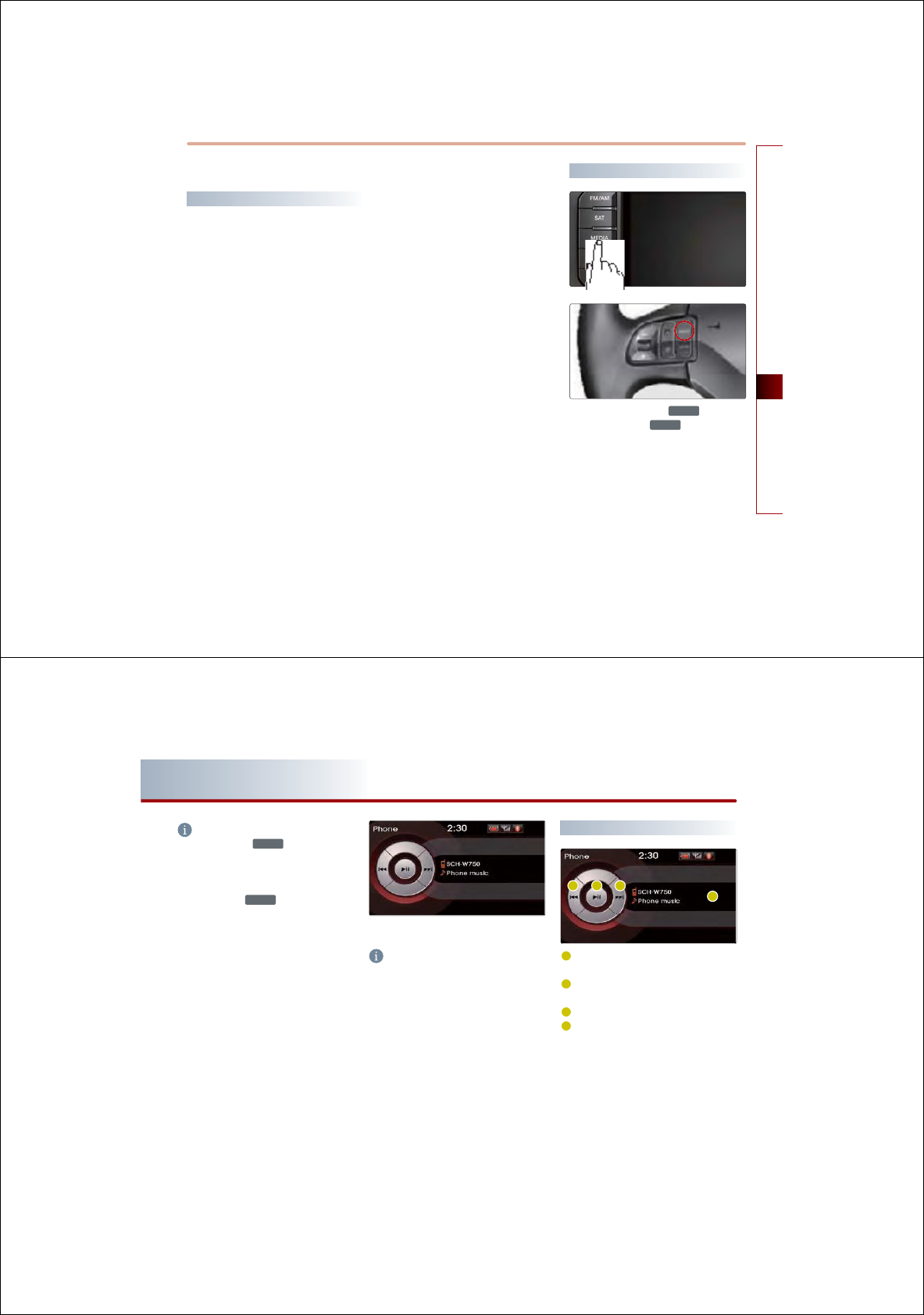
BLUETOOTH® HANDSFREE 5-21
BLUETOOTH
Ⓡ
HANDSFREE
Phone Music
Before playing Phone music
Music saved in the mobile phone can be
played in the car through Bluetooth® audio
streaming.
Phone music can be played only when a
Bluetooth® phone has been connected. To
play phone music, connect the Bluetooth®
phone to the car system. For more informa-
tion on connecting Bluetooth®, please refer to
the user's manual [Pairing and Connecting a
Bluetooth® phone].
If the Bluetooth® is disconnected while
playing phone music, the music will be dis-
continued.
The audio streaming function may not be
supported in some mobile phones.
Only one function can be used at a time
between the Bluetooth® handsfree or Phone
music function.
For example, if you convert to the Bluetooth®
handsfree while playing Phone music, the
music will be discontinued.
Playing music from the car is not possible
when there are no music files stored in the
mobile phone.
Starting Phone Music
1. Repeatedly press the
0(',$
key on the
front panel or the
02'(
key on the stee-
ring wheel to enter Phone music mode.
5-22 BLUETOOTH® HANDSFREE
PART 5 BLUETOOTH® HANDSFREE
INFORMATION
Each press of the
0(',$
key on the front
panel will change the function in the order of
DISC
ĺ
USB or iPod
ĺ
AUX
ĺ
Phone Music
ĺ
DISC .
Each press of the
02'(
key on the steering
wheel will change the audio mode in the
order of FM1
ĺ
FM2
ĺ
AM
ĺ
SIRIUS1
ĺ
SIRIUS2
ĺ
SIRIUS3
ĺ
DISC
ĺ
USB or iPod
ĺ
AUX
ĺ
Phone Music
ĺ
FM1.
It is not possible to enter Phone music mode if
the mobile phone is not connected or if the
audio streaming setting within Bluetooth®
handsfree settings has been set to [Disable
streaming audio].
For more information on audio streaming
setting, please refer to the user's manual
[Bluetooth® settings > Setting Audio streaming].
2.
The Phone music screen is displayed.
INFORMATION
While music saved in the mobile phone will
automatically begin playing after converting
to the Phone music screen, this music player
function may not be supported in some
mobile phones.
If music does not begin playing even after
converting to the Phone music screen, try
starting the music directly from the mobile
phone.
Phone music screen layout
Information Bar : displays information for
the currently playing song.
File Down button : plays the previous
song.
Play/Pause button : Plays/pauses the song.
File Up button : plays the next song.
4
5 76
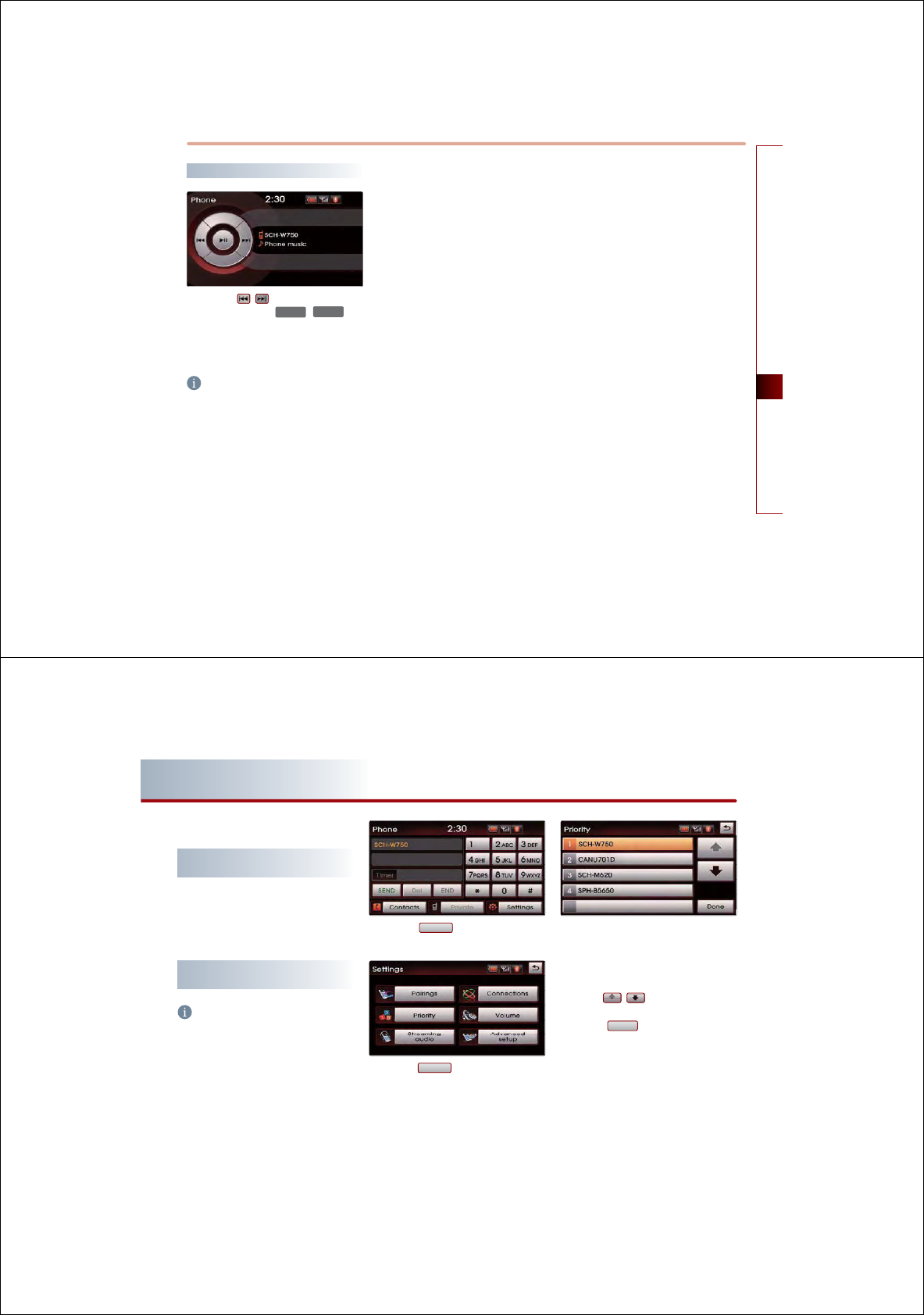
BLUETOOTH® HANDSFREE 5-23
BLUETOOTH
Ⓡ
HANDSFREE
Selecting Phone music files
1.
Press the , buttons on the Phone
music screen or the
6((.
A
,
75$&.
keys
on the system.
The previous or next song will be played
each time the button or key is pressed.
INFORMATION
The file selection function may not be suppor-
ted in some mobile phones.
5-24 BLUETOOTH® HANDSFREE
PART 5 BLUETOOTH® HANDSFREE
Bluetooth® settings
Pairing and connecting a mobile
phone
For more information on pairing and connec-
ting a mobile phone, please refer to [Pairing
and Connecting a Bluetooth® phone].
Setting mobile phone auto
connect priority
INFORMATION
After turning on the car ignition and the sys-
tem is booted up, the Bluetooth® connection
between the car system and mobile phone is
automatically made.
The Bluetooth® connection will be conducted
in the order of mobile phone priority.
The auto connect priority will be supported
only for previously paired mobile phones.
1.
Press the
6HWWLQJV
button on the PHONE
screen.
2.
Press the
3ULRULW\
button on the Settings
screen.
3. The paired mobile phone list and the
mobile phone connection priority will be
displayed.
When wishing to change the priority order,
select the mobile phone from the list and
use the , buttons to change its
priority.
Press the
'RQH
button to save the chan-
ged mobile phone priority.
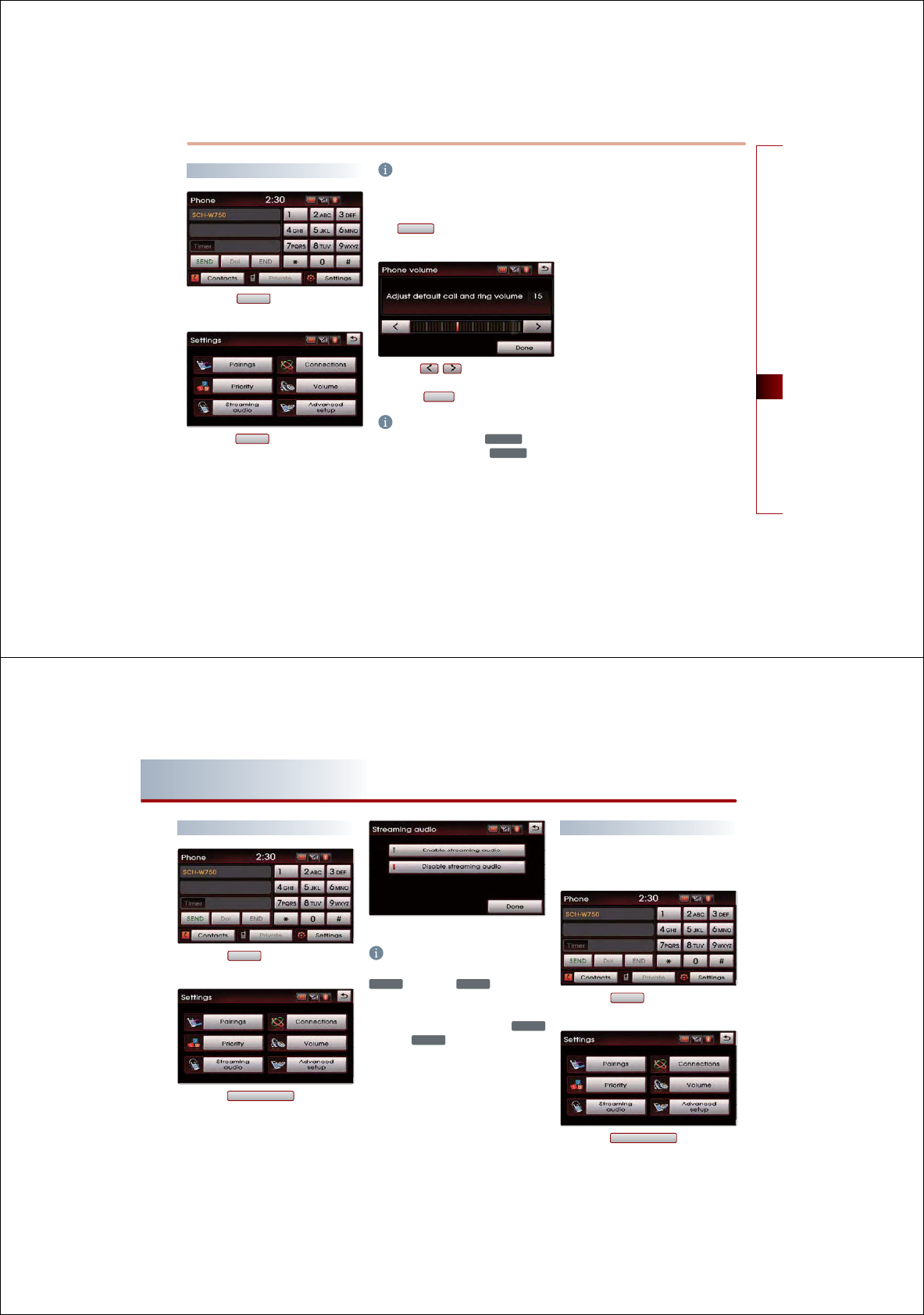
BLUETOOTH® HANDSFREE 5-25
BLUETOOTH
Ⓡ
HANDSFREE
Setting Handsfree volume
1.
Press the
6HWWLQJV
button on the PHONE
screen.
2.
Press the
9ROXPH
button on the Settings
screen.
INFORMATION
The Bluetooth® handsfree volume can be
adjusted only when a mobile phone has been
connected.
The
9ROXPH
cannot be set if no mobile
phone has been connected.
3.
Use the , buttons to set the desi-
red volume on the Phone volume screen.
Press the
'RQH
button to save.
INFORMATION
While on a call, turning the
32:(5
knob to
the left/right or pressing the
䑯
92/
䑰
key on
the steering wheel will also adjust the call
volume.
Set the incoming call volume accordingly.
5-26 BLUETOOTH® HANDSFREE
PART 5 BLUETOOTH® HANDSFREE
Setting Audio streaming
1.
Press the
6HWWLQJV
button on the PHONE
screen.
2.
Press the
6WUHDPLQJDXGLR
button on the
Settings screen.
3.
Streaming audio setting is selected.
INFORMATION
Enable streaming audio: Repeatedly press the
&'$8;
key or the
02'(
key to enter
Phone music mode. Phone music can be
played through Bluetooth® audio streaming.
Disable streaming audio: Even if the
&'$8;
key or the
02'(
key is repeatedly pressed,
will not e available Phone music mode. Phone
music through Bluetooth® audio streaming is
not supported.
Advanced settings
Bluetooth® advanced settings can be chan-
ged. Enter advanced settings through the fol-
lowing way.
1.
Press the
6HWWLQJV
button on the PHONE
screen.
2.
Press the
$GYDQFHGVHWXS
button on the
Settings screen.
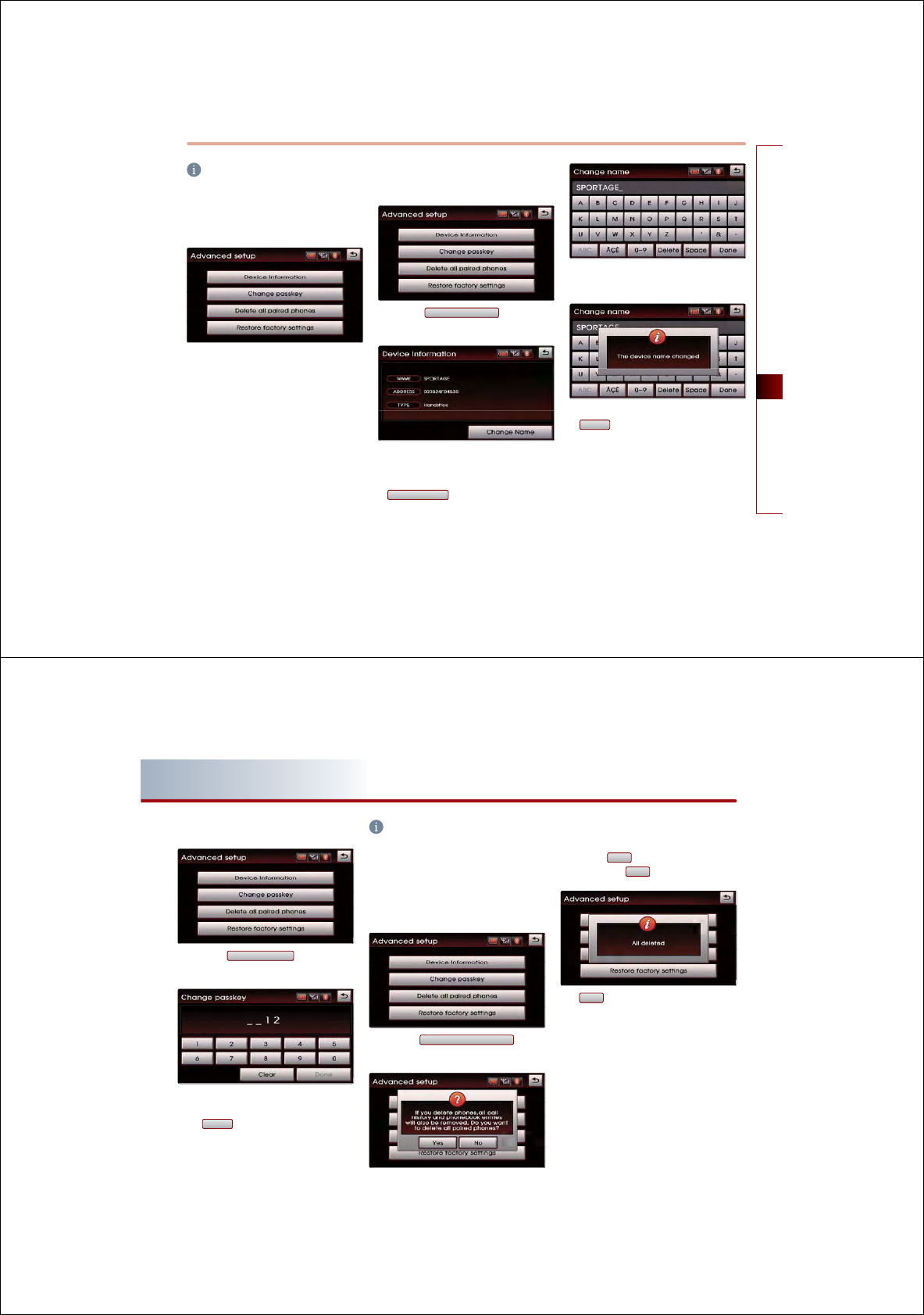
BLUETOOTH® HANDSFREE 5-27
BLUETOOTH
Ⓡ
HANDSFREE
INFORMATION
For safety reasons, operation of Advance
setup is not possible when the vehicle is in
motion. Please park in a safe place to make
changes to Advanced setup.
3.
The Advance setup screen will be displayed.
In Advance setup, the following four settings
can be made.
Searching and modifying my device
properties
4.
Press the
'HYLFHLQIRUPDWLRQ
button on the
Advance setup screen.
5.
Displays the Device information such as the
name and address of the car system.
To modify the device name, press the
&KDQJHQDPH
button.
6.
Use the key pad to input the Device name
you wish to modify.
7.
After inputting is complete, press the
'RQH
button to save.
5-28 BLUETOOTH® HANDSFREE
PART 5 BLUETOOTH® HANDSFREE
Changing passkey
1.
Press the
&KDQJHSDVVNH\
button on the
Advance setup screen.
2.
Once the Change passkey screen is dis-
played, input the desired passkey and press
the
'RQH
button.
INFORMATION
The passkey is a 4-digit authentication code
used for the Bluetooth® connection between
the mobile phone and car system. The default
passkey is set to 0000.
Deleting all paired phones
1.
Press the
'HOHWHDOOSDLUHGSKRQHV
button
on the Advance setup screen.
2.
A pop-up asking whether you wish to
delete all paired phone will be displayed.
Press the
<HV
button to delete all paired
phones or the
1R
button to cancel.
3.
If
<HV
button is pressed, all currently pai-
red phones will be deleted.
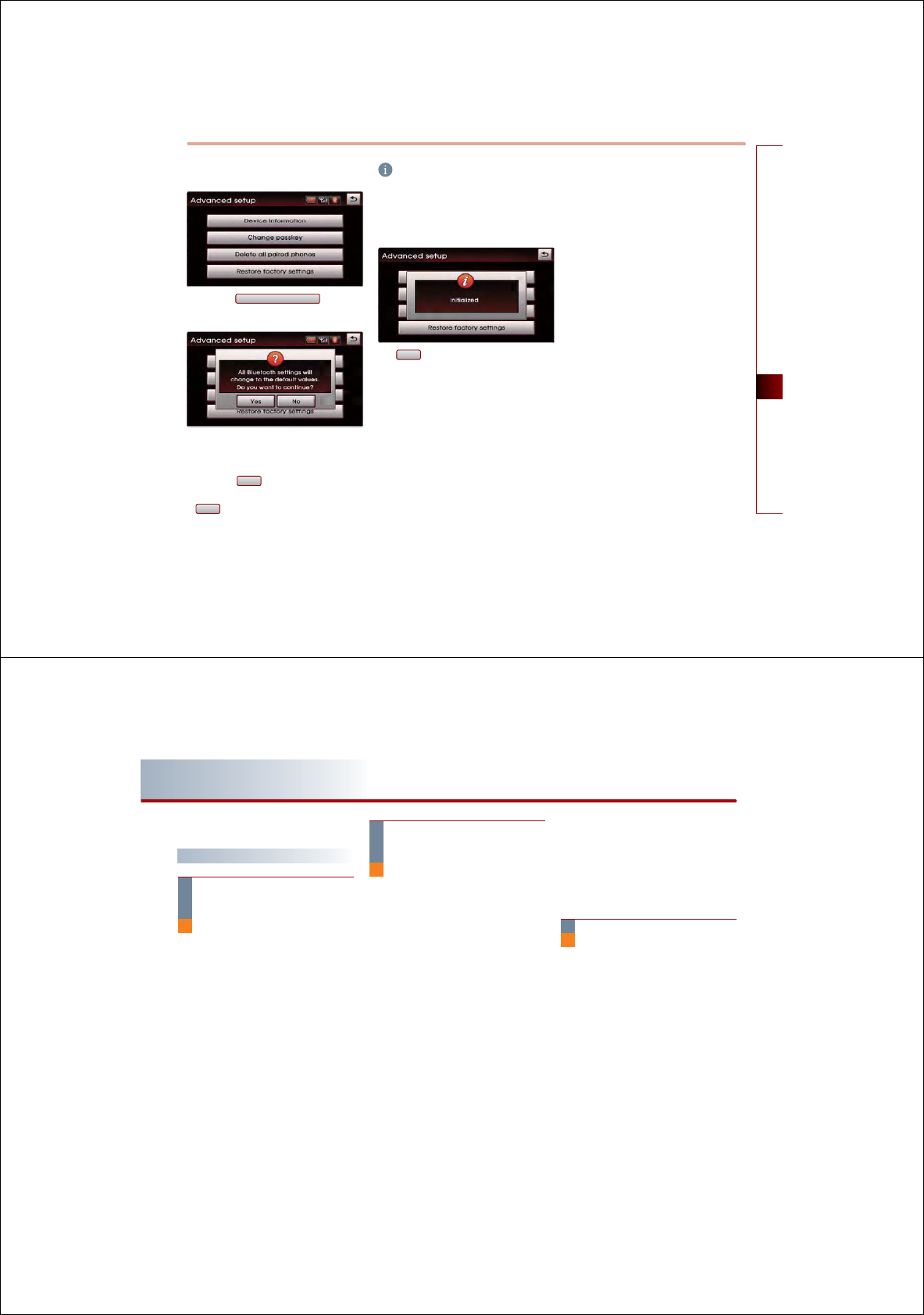
BLUETOOTH® HANDSFREE 5-29
BLUETOOTH
Ⓡ
HANDSFREE
Initializing Bluetooth® handsfree
1.
Press the
5HVWRUHIDFWRU\VHWWLQJV
button on
the Advance setup screen.
2. A pop-up asking whether you wish to initia-
lize the Bluetooth® handsfree will be dis-
played.
Press the
<HV
button to initialize the
Bluetooth® handsfree system and the
1R
button to cancel.
INFORMATION
Upon initializing the Bluetooth® handsfree,
the entire paired phone list will be deleted
and all Bluetooth® related settings will be res-
tored to factory state.
3.
If
<HV
is pressed, the Bluetooth® handsfree
settings will be initialized.
5-30 BLUETOOTH® HANDSFREE
PART 5 BLUETOOTH® HANDSFREE
Important information
About pairing mobile phones
I cannot search for mobile phones
through the car system. What is the
cause?
Check to see whether the mobile phone
you wish to connect supports Bluetooth®
function. If your mobile phone supports
Bluetooth®, check to see that whether the
Bluetooth® settings in the mobile phone
have been set to hidden state or if the
Bluetooth® power has been turned off. If
the device has been set to hidden,
release the hidden state and if the
Bluetooth® power has been turned off,
turn the power ON and try searching
again.
What is the difference between pairing a
mobile phone and connecting a mobile
phone?
Paring id the process of creating a secure
communication connection between the
mobile phone and the car Bluetooth® sys-
tem.
Through a two-way passkey between the
car system and mobile phones, up to 5
mobile phones can be paired with the
car system. The paired mobile phone will
remain paired with the car system until
the user deletes it manually.
In addition, the call history lists and
phone number books saved in each
mobile phone will also be maintained
until the paired phone is deleted. For
more information on pairing mobile
phones, please refer to the manual
[Pairing and Connecting a Bluetooth
®phone > Pairing a mobile phone].
Connecting a mobile phone to
Bluetooth® by selecting the desired
mobile phone from the paired phones.
Within the car system, only one
Bluetooth® phone can be connected at
one time.
For more information, please refer to the
manual [Pairing and Connecting a
Bluetooth® phone > Pairing a mobile
phone].
What is a Passkey?
A passkey is an authentication code used
for two-way communication of the car
system and the mobile phone.
Only 4-digit numbers can be used as
passkeys. Passkeys are registered only
once when pairing the phone number
for the first time. The factory-set passkey
is 0000.
Q.
A.
A.
A.
Q.
Q.
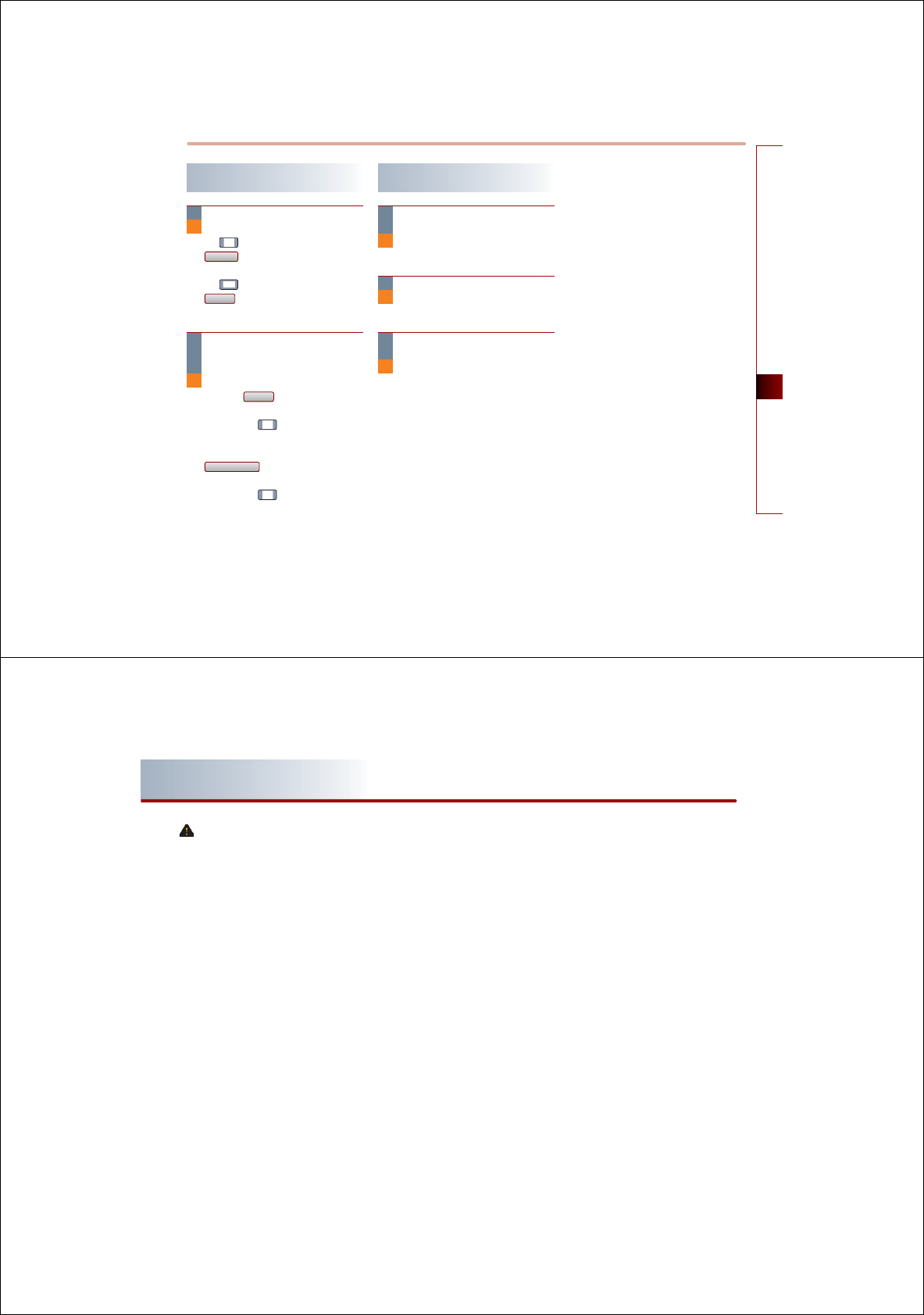
BLUETOOTH® HANDSFREE 5-31
BLUETOOTH
Ⓡ
HANDSFREE
About making/answering phone
calls
How can I answer a call?
When you receive an incoming call, press
the key on the steering wheel or the
$FFHSW
button on the PHONE screen to
answer. To reject the incoming call, press
the key on the steering wheel or the
5HMHFW
button on the PHONE screen.
What should I do if I am talking on the
Handsfree but wish to switch the call to
the mobile phone?
To switch the call to the mobile phone,
press the
3ULYDWH
button on the PHONE
screen or press and hold (over 0.8
second) the key on the steering
wheel. If you wish to switch the call back
to the car handsfree, press the
8VHKDQGVIUHH
button on the PHONE
screen or press and hold (over 0.8
second) the key on the steering
wheel.
About Bluetooth® device
environment
What is the range for Bluetooth® wireless
connection?
The wireless connection range is within
approximately 30 feet.
How many mobile phones can be paired?
It is possible to pair up to five phones
with the car system.
What is the reason why the call quality
deteriorates?
First, check to see the signal strength of
the mobile phone. The call quality may
deteriorate when the signal strength is
low. Call quality may also deteriorate if
metal objects, such as drink cans, are
placed near the mobile phone.
A.
Q.
A.
Q.
A.
Q.
A.
Q.
A.
Q.
5-32 BLUETOOTH® HANDSFREE
PART 5 BLUETOOTH® HANDSFREE
CAUTION!
Mobile Phone Compatibility
Depending on the manufacturer, product and
product specification, some mobile phones
functions may not be supported or may not
operate to specification. Carefully read the
cautions listed below.
●
#
The occurrence of problems upon using
mobile phones may be caused by the
mobile phone and not by the Audio /
Navigation unit.
●
Even mobile phones which support
Bluetooth® function may not operate pro-
perly if the mobile phone connection has-
been locked. Release the connection lock
and try connecting the mobile phone with
the system again.
●
The Mobile phone battery icon and signal
strength icon may not be properly dis-
played depending on the type of mobile
phone.
●
Call waiting is supported only when
connected mobile phones support this fea-
ture. The call waiting pop-up may not be
displayed in some mobile phones.
●
Audio streaming mode will operate only
when a Bluetooth® phone has been connec-
ted. Connecting or disconnecting a
Bluetooth® phone while audio streaming is
operating will stop music play.
●
The audio streaming function may not be
supported in some mobile phones.
●
The phonebook may take a prolonged
period of time to download or may not ope-
rate in some mobile phones. The quality of
Bluetooth® handsfree calls may differ
depending on the mobile phone.

APPENDIX 6-1
APPEINDIX
PART 6
APPENDIX
Troubleshooting guide #䐙䐙 #6-2
Before thinking the product has
malfunctioned# 㾕㾕㾕㾕㾕㾕㾕㾕 #6-2
Troubleshooting # 㾕㾕㾕㾕㾕㾕㾕 #6-3
Map legend # 䐙䐙䐙䐙䐙䐙䐙 #6-5
Road color# 㾕㾕㾕㾕㾕㾕㾕㾕㾕㾕 #6-5
Landmark icons#㾕㾕㾕㾕㾕㾕㾕㾕 #6-5
POI icons#㾕㾕㾕㾕㾕㾕㾕㾕㾕㾕㾕 #6-5
INDEX#䐙䐙䐙䐙䐙䐙䐙䐙䐙䐙 #6-8
6-2 APPENDIX
PART 6 APPENDIX
Troubleshooting guide
Before thinking the product has malfunctioned
1. Errors which occur during the operation or installation of the device may be mistaken as a malfunction of the actual device.
2. If you are having problems with the device, try the suggestions listed below.
3. If the problems persist, contact your KIA dealer.
Problem Function
There are small red, blue, or green dots on
the screen
Because the LCD is manufactured with technology requiring high point density, a pixel
deficiency or lighting may occur within 0.01% of total pixels.
The sound or image is not working
●
Has the Switch for the vehicle been turned to [ACC] or [ON]?
●Has the SYSTEM been turned OFF?
The video is being displayed but
sound is not working
●Has the volume been set to a low level?
●Has the volume been set on mute?
When the power is turned on, the corners of
the screen are dark
●
The display looking somewhat darker after prolonged periods of use is a normal
phenomenon with LCD panels. It is not a malfunction.
●
If the screen is very dark, contact your nearest KIA dealer for assistance.
Sound is working from only one speaker
Is the position of FAL/BAL sound controls or volume adjusted to only one side?
Sound and video does not work in AUX
mode Are the audio and video connector jacks fully inserted into the AUX terminal?
The external device is not working Is the external device connected with a standard connector cable?
The road is missing Some map data may be missing or incorrect.
The road name is spoken incorrectly The TTS(Text To Speech) engine speaks the street name based on the phonetic spelling.
This will continuously be update with the map database.
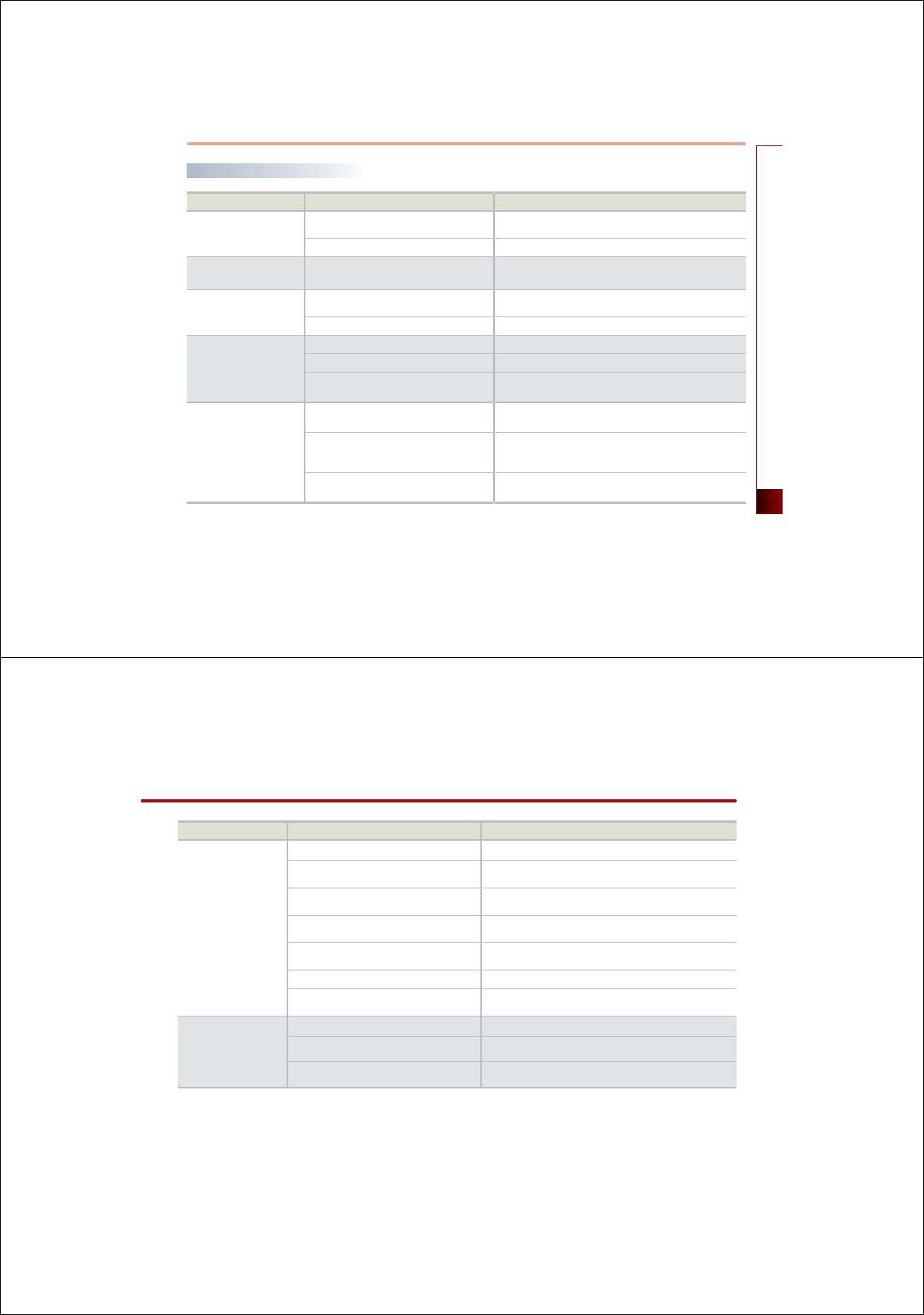
APPENDIX 6-3
APPEINDIX
Problem Possible Cause Solution
The power does not
turn on.
The fuse is disconnected. Replace with a suitable fuse. If the fuse is disconnected again,
please contact your point of purchase or serviece center.
Device is not properly connected. Check to see that the device has been properly connected.
The image color or tone
quality is low.
The brightness, saturation, hue, and contrast
levels are not properly set.
Adjust the brighteness, saturation, hue, and contast levels
through the display setting.
The video does not
work.
The brightness level has been set to the lowest
level.
Adjust the brighteness to a higher level.
The device is not properly connected.
Check to see that the device has been properly conneted.
The sound does not
work.
The volume level is set the lowest level. Adjust the volume level.
The connector is not properly connected.
Check the connection state.
The device is currently fast-forwarding,
rewinding, scanning, or playing in slow mode.
The sound will not work when the device is fast-forwarding,
rewinding, scanning, or playing in slow mode.
The sound or video
quality is low.
The DISC is dirty or scratched. Wipe off water or dirt from the DISC. Do not use a disc which
has been scratched.
Vibration is occurring from the position in
which the conversion switch has been
installed.
The sound may be short-circuited and the image distorted if
the device begins to vibrate. The device will return to normal
operation once the vibration has stopped.
The color and tone quality of the image is low. Aging of the video display and deterioration in performance
may cause certain quality degradations.
Troubleshooting
6-4 APPENDIX
PART 6 APPENDIX
Problem Possible Cause Solution
The USB does not work.
USB memory is damaged.
Please use after formatting the USB into FAT 12/16/32 format.
USB memory has been contaminated.
Remove any foreign substances on the contact surface of the
USB memory and multimedia terminal.
A separately purchased USB HUB is being used.
Directly connect the USB memory with the multimedia terminal
on the vehicle.
A USB extension cable is being used.
Directly connect the USB memory with the multimedia terminal
on the vehicle.
A USB which is not a Metal Cover Type USB
Memory is being used. Use a standard USB Memory.
A HDD type, CF, SD Memory is being used.
Use standard USB Memory.
There are no music files which can be played.
Only MP3,WMA file formats are supported. Please use only the
supported music file formats.
The iPod is not
recognized even though
it has been connected.
There are no titles which can be played. Use iTunes to download and save MP3 files into the iPod.
The iPod firmware version has not been properly
updated.
Use iTunes to update the firmware version and reconnect the
iPod with the device.
The iPod device does not recognize downloads.
Reset the iPod and reconnect with the device.
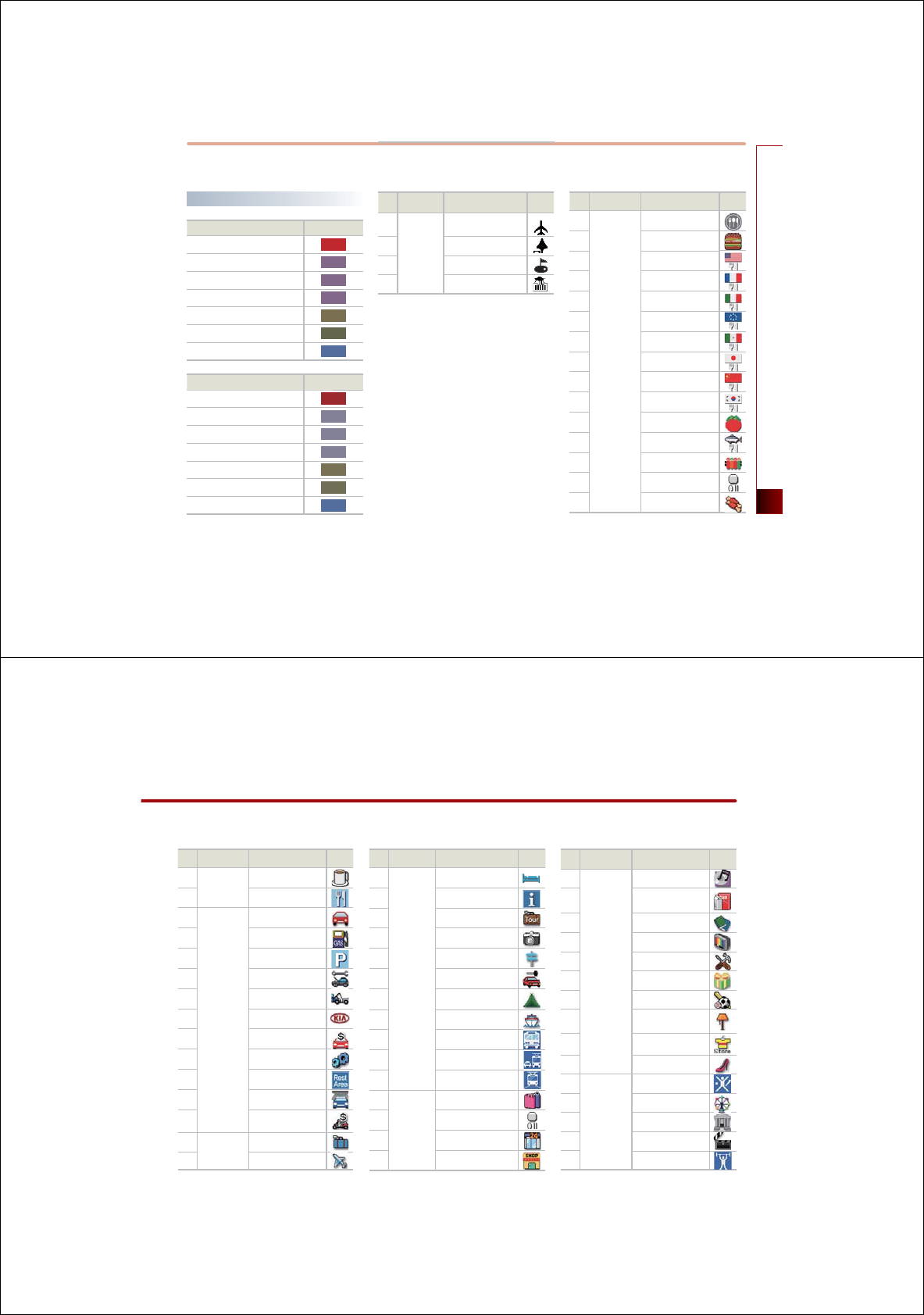
APPENDIX 6-5
APPEINDIX
Landmark icons POI icons
Map legend
Road color
Day Road Type Color
Freeway
Arterial
County
Collector
Local
Unpaved local
Ferry
Night Road Type Color
Freeway
Arterial
County
Collector
Local
Unpaved local
Ferry
No Category Sub Category Icon
1
Restaurants
Representation
2
Fast Food
3
American
4
French
5
Italian
6
Continental
7
Mexican
8
Japanese
9
Chinese
10
Korean
11
Vegetarian Food
12
Seafood
13
Latin American
14
Asian
15
African
No Category Sub Category Icon
1
Service
Airport
2Park
3Golf
4University
6-6 APPENDIX
PART 6 APPENDIX
No Category Sub Category Icon
16
Restaurants
Coffee Shop
17
Others
18
Automotive
Representation
19
Gas Station
20
Parking
21
Auto service
22
Road Assistance
23
KIA Dealership
24
Automobile Dealership
25
Auto Parts
26
Rest Area
27
Car Wash
28
Motorcycle Dealership
29
Travel Representation
30
Airport
POI icons
No Category Sub Category Icon
31
Travel
Hotel
32
Tourist Information
33
Travel Agent
34
Tourist Attraction
35
Popular Spot
36
Rental Car Agency
37
Campground
38
Ferry Terminal
39
Bus Station
40
Local Transit
41
Train Station
42
Shopping
Representation
43
Department Store
44
Convenience Store
45
Shopping Center
No Category Sub Category Icon
46
Shopping
Music Store
47
Grocery Store
48
Bookstore
49
Electronics
50
Hardware Store
51
Gifts
52
Sporting Goods
53
Home Specialty Store
54
Clothing
55
Shoe Store
56
Recreation
Representation
57
Amusement Park
58
Museum
59
Cinema
60
Sports Activities
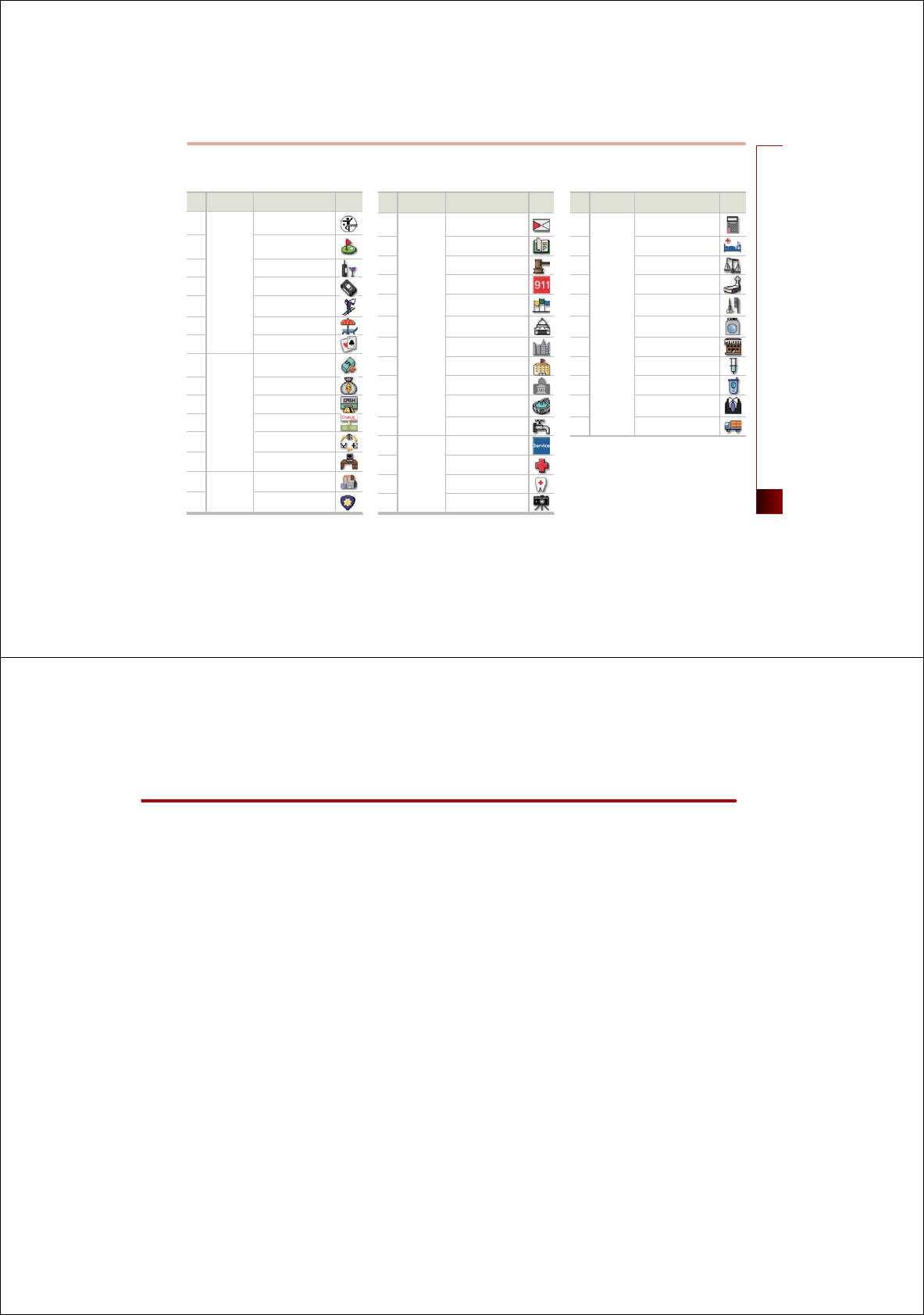
APPENDIX 6-7
APPEINDIX
POI icons
No Category Sub Category Icon
61
Recreation
Sports Complex
62
Golf Course
63
Winery
64
Video & Game Rental
65
Ski Resort
66
Recreation Area
67
Other Recreation
68
Financial
Service
Representation
69
Bank
70
ATM
71
Check Cashing Service
72
Money Transfer
73
Business Facility
74
Community
Representation
75
Police Station
No Category Sub Category Icon
76
Community
Post Office
77
Library
78
Court House
79
Fire Department
80
Convention Center
81
City Hall
82
Civic Center
83
School
84
Government Offices
85
Waste & Sanitary
86
Utilities
87
Service
Representation
88
Hospital
89
Dentist
90
Photography
No Category Sub Category Icon
91
Service
Tax Service
92
Medical Service
93
Attorney
94
Funeral Director
95
Hair & Beauty
96
Cleaning & Laundry
97
Social Service
98
Physician
99
Communication
100
Tailor & Alteration
101
Mover
6-8 APPENDIX
PART 6 APPENDIX
A
Adaptive volume control ON/OFF
#㾕㾕㾕#
3-52
About CDP#㾕㾕㾕㾕㾕㾕㾕㾕㾕㾕㾕㾕 #2-11
Activating call waiting
#㾕㾕㾕㾕㾕㾕㾕#
5-14
Adding to address book
#㾕㾕㾕㾕㾕㾕#
3-27
Adding waypoints
#㾕㾕㾕㾕㾕㾕㾕㾕#
3-32
Adjusting audio volume#㾕㾕㾕㾕㾕㾕㾕㾕#1-7
Advanced settings
#㾕㾕㾕㾕㾕㾕㾕㾕#
5-26
Audio streaming
#㾕㾕㾕㾕㾕㾕㾕㾕㾕#
5-21
Answering an incoming call
# 㾕㾕㾕㾕#
5-13
Audio Sound setting# 㾕㾕㾕㾕㾕㾕㾕㾕 #1-10
Auto Volume Control ON/OFF# 㾕㾕㾕㾕 #1-10
AUX#㾕㾕㾕㾕㾕㾕㾕㾕㾕㾕㾕㾕㾕㾕㾕 #2-32
AUX screen#㾕㾕㾕㾕㾕㾕㾕㾕㾕㾕㾕㾕 #2-33
B
BAS/MID/TRE#㾕㾕㾕㾕㾕㾕㾕㾕㾕㾕㾕 #1-10
Basic Operation and setting# 㾕㾕㾕㾕㾕㾕#1-6
Basic operation for voice command
control
# 㾕㾕㾕㾕㾕㾕㾕㾕㾕㾕㾕㾕㾕㾕#4-2
Before thinking the product has malfunctioned
#㾕㾕#
5-2
Bluetooth handsfree
# 㾕㾕㾕㾕㾕㾕㾕 #
5-2
Bluetooth handsfree mode
#㾕㾕㾕㾕㾕 #
5-2
Bluetooth settings
#㾕㾕㾕㾕㾕㾕㾕㾕#
5-24
Brightness# 㾕㾕㾕㾕㾕㾕㾕㾕㾕㾕㾕㾕 #1-11
Browsing detailed information about
the iPod music# 㾕㾕㾕㾕㾕㾕㾕㾕㾕㾕 #2-28
Browsing detailed information about
the MP3 file#㾕㾕㾕㾕㾕㾕㾕㾕㾕㾕㾕㾕 #2-22
Browsing detailed information about
the SIRIUS channel#㾕㾕㾕㾕㾕㾕㾕㾕㾕 #2-10
C
Call history
#㾕㾕㾕㾕㾕㾕㾕㾕㾕㾕㾕#
5-19
CD # 㾕㾕㾕㾕㾕㾕㾕㾕㾕㾕㾕㾕㾕㾕㾕㾕#4-9
CD screen and functions# 㾕㾕㾕㾕㾕㾕 #2-16
Changing destination position
#㾕㾕㾕㾕#
3-27
Changing Route option
# 㾕㾕㾕㾕㾕㾕#
3-32
Changing the map scale
#㾕㾕㾕㾕㾕㾕 #
3-8
Changing passkey
# 㾕㾕㾕㾕㾕㾕㾕㾕#
5-28
Command list of Audio system#㾕㾕㾕㾕㾕#4-7
Command list of Help# 㾕㾕㾕㾕㾕㾕㾕㾕#4-6
Command list of Navigation system#㾕㾕 #4-13
Command list of Phone#㾕㾕㾕㾕㾕㾕㾕 #4-13
Condition for voice command system#㾕㾕
#4-2
Condition for voice command system #㾕㾕#1-9
Connecting a mobile phone
# 㾕㾕㾕㾕
5-7
Connections
# 㾕㾕㾕㾕㾕㾕㾕㾕㾕㾕
5-7
Connecting AUX#㾕㾕㾕㾕㾕㾕㾕㾕㾕㾕 #2-32
Connecting iPod devices# 㾕㾕㾕㾕㾕㾕 #2-24
Connecting the USB devices#㾕㾕㾕㾕㾕 #2-31
Control panel#㾕㾕㾕㾕㾕㾕㾕㾕㾕㾕㾕㾕#1-3
Controller and functions# 㾕㾕㾕㾕㾕㾕㾕#1-3
Current position map screen (without route)
㾕㾕㾕㾕㾕㾕㾕㾕㾕㾕㾕㾕㾕㾕㾕㾕㾕㾕㾕㾕
#
3-5
D
Deleting all avoid area# 㾕㾕㾕㾕㾕㾕㾕 #3-41
Deleting all paired phones#㾕㾕㾕㾕㾕㾕 #5-28
Deleting an address book#㾕㾕㾕㾕㾕㾕 #3-47
Deleting an address of address book
#㾕#
3-46
Deleting avoid area
#㾕㾕㾕㾕㾕㾕㾕㾕#
3-41
Deleting favorite place
# 㾕㾕㾕㾕㾕㾕#
3-50
Deleting Home address
# 㾕㾕㾕㾕㾕㾕#
3-48
Deleting waypoints
㾕㾕㾕㾕㾕㾕㾕㾕#
3-34
Deleting a paired phone
#㾕㾕㾕㾕㾕㾕 #
5-6
Destination#㾕㾕㾕㾕㾕㾕㾕㾕㾕㾕㾕㾕 #4-15
Destination by address book#㾕㾕㾕㾕㾕 #4-24
Destination by memory point
<1 to 5># 㾕㾕㾕㾕㾕㾕㾕㾕㾕㾕㾕㾕㾕 #4-25
Destination POI by phone number#㾕㾕#4-22
Device information
#㾕㾕㾕㾕㾕㾕㾕㾕#
5-27
Device name
#㾕㾕㾕㾕㾕㾕㾕㾕㾕㾕#
5-27
Device address
# 㾕㾕㾕㾕㾕㾕㾕㾕㾕#
5-27
Disc/content format compatibility#㾕㾕#2-13

APPENDIX 6-9
APPEINDIX
Display mode#㾕㾕㾕㾕㾕㾕㾕㾕㾕㾕㾕 #1-11
Display OFF#㾕㾕㾕㾕㾕㾕㾕㾕㾕㾕㾕㾕 #1-11
Display ON#㾕㾕㾕㾕㾕㾕㾕㾕㾕㾕㾕㾕 #1-11
Display setting# 㾕㾕㾕㾕㾕㾕㾕㾕㾕㾕 #1-11
Displaying the list# 㾕㾕㾕㾕㾕㾕㾕㾕㾕㾕#1-9
Destination menu screen and functions
##
3-12
Displaying / Hiding POI icons on the map
##
3-9
Displaying / Hiding Q.POI icons
# 㾕㾕㾕㾕#
3-9
Displaying /Hiding icons other than
Q.POI icons
# 㾕㾕㾕㾕㾕㾕㾕㾕㾕㾕㾕㾕#
3-9
Displaying the list
# 㾕㾕㾕㾕㾕㾕㾕㾕㾕#
1-9
Disable streaming audio
#㾕㾕㾕㾕㾕㾕#
5-26
Disconnecting a mobile phone
# 㾕㾕㾕 #
5-8
E
Editing an address of address book
#㾕㾕#
3-45
Editing avoid area
# 㾕㾕㾕㾕㾕㾕㾕㾕#
3-40
Editing waypoints
# 㾕㾕㾕㾕㾕㾕㾕㾕#
3-32
Enable streaming audio
# 㾕㾕㾕㾕㾕㾕#
5-26
Ending a call
# 㾕㾕㾕㾕㾕㾕㾕㾕㾕㾕#
5-15
F
FAD/BAL#㾕㾕㾕㾕㾕㾕㾕㾕㾕㾕㾕㾕㾕 #1-10
Find address# 㾕㾕㾕㾕㾕㾕㾕㾕㾕㾕㾕 #4-19
Find emergency <Category>#㾕㾕㾕㾕㾕 #4-23
Find nearest <POI name>#㾕㾕㾕㾕㾕㾕 #4-21
FM/AM Radio#㾕㾕㾕㾕㾕㾕㾕㾕㾕㾕㾕㾕#2-2
FM/AM screen and functions#㾕㾕㾕㾕㾕㾕#2-2
For safe and efficient operation#㾕㾕㾕㾕 #2-11
Finishing route guidance
(Delete Destination)
# 㾕㾕㾕㾕㾕㾕㾕#
3-30
G
Giving voice command
# 㾕㾕㾕㾕㾕㾕㾕#
1-9
Go home
#㾕㾕㾕㾕㾕㾕㾕㾕㾕㾕㾕㾕 #
4-25
GPS signal reception state
# 㾕㾕㾕㾕㾕 #
3-2
H
Handsfree volume
#㾕㾕㾕㾕㾕㾕㾕㾕
5-25
Help
#㾕㾕㾕㾕㾕㾕㾕㾕㾕㾕㾕㾕㾕#
3-54
How to operate a menu by voice
command
# 㾕㾕㾕㾕㾕㾕㾕㾕㾕㾕㾕㾕#
1-9
How to operate the screen menu
#㾕㾕㾕㾕#
1-8
I
Important information about this manual
#㾕㾕#
1-2
iPod
#㾕㾕㾕㾕㾕㾕㾕㾕㾕㾕㾕㾕㾕㾕 #
2-24
iPod screen and functions
# 㾕㾕㾕㾕㾕 #
2-25
Initializing system
# 㾕㾕㾕㾕㾕㾕㾕㾕 #
3-37
Initializing Bluetooth handsfree
# 㾕㾕㾕#
5-29
Inserting/Ejecting Disc
#㾕㾕㾕㾕㾕㾕㾕 #
2-15
Introduction
#㾕㾕㾕㾕㾕㾕㾕㾕㾕㾕㾕㾕#
1-2
Inputting letters by using screen
keyboard
#㾕㾕㾕㾕㾕㾕㾕㾕㾕㾕㾕㾕㾕#
1-8
L
Landmark icons
#㾕㾕㾕㾕㾕㾕㾕㾕㾕 #
7-7
Limitations of the navigation system
#㾕#
3-2
Listening to CD music
#㾕㾕㾕㾕㾕㾕㾕 #
2-16
Listening to MP3 music
# 㾕㾕㾕㾕㾕㾕 #
2-20
Listening to music from iPod
# 㾕㾕㾕㾕 #
2-24
Listening to the FM/AM radio
# 㾕㾕㾕㾕㾕#
2-2
Listening to the SIRIUS radio
# 㾕㾕㾕㾕㾕#
2-6
Listening to USB music
㾕㾕㾕㾕㾕㾕㾕 #
2-31
M
Main setting
# 㾕㾕㾕㾕㾕㾕㾕㾕㾕㾕#
3-36
Making a call to POI
# 㾕㾕㾕㾕㾕㾕㾕#
3-10
Map Functions
# 㾕㾕㾕㾕㾕㾕㾕㾕㾕 #
3-5
Map
#㾕㾕㾕㾕㾕㾕㾕㾕㾕㾕㾕㾕㾕㾕 #
4-13
Map legend
# 㾕㾕㾕㾕㾕㾕㾕㾕㾕㾕 #
6-5
Making a call by dialing a phone number
#㾕#
5-11
Making a call from Speed Dial
#㾕㾕㾕㾕#
5-11
Making a call by redialing
# 㾕㾕㾕㾕㾕#
5-12
Making a call from the Phone book
#㾕㾕#
5-16
6-10 APPENDIX
PART 6 APPENDIX
Making a call from Call history
#㾕㾕㾕㾕#
5-19
MP3
#㾕㾕㾕㾕㾕㾕㾕㾕㾕㾕㾕㾕㾕㾕 #
2-19
MP3 disc related information and precaution
##
2-19
MP3 screen and functions
# 㾕㾕㾕㾕㾕 #
2-20
My places setting
# 㾕㾕㾕㾕㾕㾕㾕㾕#
3-43
N
Navigation setting
#㾕㾕㾕㾕㾕㾕㾕㾕#
3-38
O
Operating the CDP
# 㾕㾕㾕㾕㾕㾕㾕㾕 #
2-11
Operating the external devices
# 㾕㾕㾕 #
2-24
Operating the radio
#㾕㾕㾕㾕㾕㾕㾕㾕㾕#
2-2
Operating typical screen menu
# 㾕㾕㾕㾕#
1-7
Operating voice command
#㾕㾕㾕㾕㾕㾕#
4-2
Operating after searching a destination
#㾕#
3-27
Operating after setting a destination
#㾕㾕#
3-28
P
Pairings
#㾕㾕㾕㾕㾕㾕㾕㾕㾕㾕㾕㾕 #
5-4
Pairing a mobile phone
# 㾕㾕㾕㾕㾕㾕 #
5-4
Passkey
#㾕㾕㾕㾕㾕㾕㾕㾕㾕㾕㾕㾕 #
5-5
Phonebook
# 㾕㾕㾕㾕㾕㾕㾕㾕㾕㾕#
5-16
Phonebook download
#㾕㾕㾕㾕㾕㾕㾕#
5-16
Phone music
#㾕㾕㾕㾕㾕㾕㾕㾕㾕㾕#
5-21
Playing AUX
#㾕㾕㾕㾕㾕㾕㾕㾕㾕㾕㾕 #
2-32
POI Category list
# 㾕㾕㾕㾕㾕㾕㾕㾕㾕 #
4-18
Precaution for safe usage
#㾕㾕㾕㾕㾕㾕㾕#
1-2
Precautions upon handling discs
#㾕㾕㾕 #
2-11
Precautions upon handling USB
# 㾕㾕㾕 #
2-29
Previous destination
# 㾕㾕㾕㾕㾕㾕㾕 #
4-24
Previous start point
#㾕㾕㾕㾕㾕㾕㾕㾕 #
4-25
Priority
#㾕㾕㾕㾕㾕㾕㾕㾕㾕㾕㾕㾕#
5-24
Private mode
#㾕㾕㾕㾕㾕㾕㾕㾕㾕㾕#
5-14
R
Registering favorite place
# 㾕㾕㾕㾕㾕#
3-49
Registering home address
# 㾕㾕㾕㾕㾕#
3-48
Registering new address in address book
#㾕#
3-43
Re-ordering waypoints
# 㾕㾕㾕㾕㾕㾕#
3-34
Rejecting an incoming call
#㾕㾕㾕㾕㾕#
5-13
REW/FF CD track
#㾕㾕㾕㾕㾕㾕㾕㾕㾕 #
2-17
REW/FF iPod music
#㾕㾕㾕㾕㾕㾕㾕㾕 #
2-27
REW/FF MP3 file
# 㾕㾕㾕㾕㾕㾕㾕㾕㾕 #
2-22
Road color
#㾕㾕㾕㾕㾕㾕㾕㾕㾕㾕㾕 #
6-5
Route
# 㾕㾕㾕㾕㾕㾕㾕㾕㾕㾕㾕㾕㾕 #
4-16
Route guidance
#㾕㾕㾕㾕㾕㾕㾕 #
3-4, 3-30
Route guidance screen
# 㾕㾕㾕㾕㾕㾕#
3-28
Route menu screen and functions
#㾕㾕#
3-30
Route overview(View Entire Route)
#㾕㾕#
3-31
Route Re-calculation
# 㾕㾕㾕㾕㾕㾕㾕 #
3-4
S
Searching a POI
#㾕㾕㾕㾕㾕㾕㾕㾕㾕#
3-20
Searching a previous Destination
#㾕㾕㾕#
3-17
Searching an Address
#㾕㾕㾕㾕㾕㾕㾕#
3-13
Searching an intersection
# 㾕㾕㾕㾕㾕#
3-17
Searching favorite places
#㾕㾕㾕㾕㾕㾕#
3-26
Searching for Emergency facilities
#㾕㾕#
3-25
Searching from Address book
#㾕㾕㾕㾕#
3-24
Searching from MAP
# 㾕㾕㾕㾕㾕㾕㾕#
3-26
Searching POI by local POI list
#㾕㾕㾕㾕#
3-26
Searching your Home
#㾕㾕㾕㾕㾕㾕㾕#
3-25
Searching a destination by voice command
##
4-19
Searching the Phone Book
# 㾕㾕㾕㾕㾕#
5-17
Searching a Destination
# 㾕㾕㾕㾕㾕㾕#
3-13
Selecting an item in a list
#㾕㾕㾕㾕㾕㾕 #
1-9
Searcting a destination
# 㾕㾕㾕㾕㾕㾕#
3-13
Selecting other route
#㾕㾕㾕㾕㾕㾕㾕#
3-29
Selecting the MP3 file
#㾕㾕㾕㾕㾕㾕㾕 #
2-21
Selecting an item in a list
# 㾕㾕㾕㾕㾕㾕#
1-9
Selecting FM/AM broadcast frequency
#㾕 #
2-4
Selecting music from iPod
# 㾕㾕㾕㾕㾕 #
2-26
Selecting SIRIUS broadcast channel
#㾕㾕㾕#
2-7
Selecting the CD track
#㾕㾕㾕㾕㾕㾕㾕 #
2-17

APPENDIX 6-11
APPEINDIX
Selecting Phone Music files
#㾕㾕㾕㾕㾕#
5-23
Setting arrival time and distance display
#㾕#
3-38
Setting as Destination/waypoint
#㾕㾕㾕#
3-27
Setting avoid streets on route
#㾕㾕㾕㾕#
3-35
Setting detour distance
# 㾕㾕㾕㾕㾕㾕#
3-35
Setting estimate travel time
#㾕㾕㾕㾕㾕#
3-42
Setting keyboard for inputting letter
#㾕#
3-36
Setting Language
# 㾕㾕㾕㾕㾕㾕㾕㾕#
3-37
Setting Q.POI icons
#㾕㾕㾕㾕㾕㾕㾕㾕#
3-42
Setting the Clock
# 㾕㾕㾕㾕㾕㾕㾕㾕#
1-14
Setting units (mile/ km)
# 㾕㾕㾕㾕㾕㾕#
3-38
Setting voice command feedback ON/OFF
#㾕#
3-37
Setup and Information
# 㾕㾕㾕㾕㾕㾕#
3-36
Setup menu screen and functions
#㾕㾕#
3-36
Setting random function for CD music
#㾕#
2-17
Setting random function for iPod music
#㾕#
2-27
Setting random function for MP3 file
#㾕 #
2-22
Setting repeat function for CD music
#㾕 #
2-18
Setting repeat function for iPod music
#㾕#
2-28
Setting repeat function for MP3 file
#㾕 㾕 #
2-23
Setting up the voice command system
#㾕㾕#
4-4
Setting voice Prompt ON/OFF
#㾕㾕㾕㾕㾕#
4-4
Scanning CD track
# 㾕㾕㾕㾕㾕㾕㾕㾕 #
2-18
Scanning FM/AM broadcast frequency
#㾕 #
2-5
Setting Picture Frame
# 㾕㾕㾕㾕㾕㾕㾕 #
1-13
Scanning MP3 file
# 㾕㾕㾕㾕㾕㾕㾕㾕 #
2-23
Scanning SIRIUS broadcast channel
#㾕 㾕 #
2-10
Scrolling map
#㾕㾕㾕㾕㾕㾕㾕㾕㾕㾕#
3-11
SIRIUS Radio
#㾕㾕㾕㾕㾕㾕㾕㾕㾕㾕㾕㾕#
2-6
SIRIUS screen and functions
#㾕㾕㾕㾕㾕㾕#
2-6
Sorting items from the list
# 㾕㾕㾕㾕㾕㾕#
1-8
Speaker adaptation
#㾕㾕㾕㾕㾕㾕㾕㾕㾕#
4-4
Steering wheel remote controller
# 㾕㾕㾕#
1-5
Storing FM/AM presets
# 㾕㾕㾕㾕㾕㾕㾕#
2-5
Storing SIRIUS presets
#㾕㾕㾕㾕㾕㾕㾕㾕#
2-9
Supported disc formats
# 㾕㾕㾕㾕㾕㾕 #
2-12
Starting navigation system
#㾕㾕㾕㾕㾕 #
3-5
Starting route Guidance
#㾕㾕㾕㾕㾕㾕#
3-28
Sorting call history
#㾕㾕㾕㾕㾕㾕㾕㾕#
5-19
Sorting Items from the list
# 㾕㾕㾕㾕㾕 #
1-9
Speed dial
#㾕㾕㾕㾕㾕㾕㾕㾕㾕㾕㾕#
5-11
Starting Phone Music
#㾕㾕㾕㾕㾕㾕㾕#
5-21
Switching call to the mobile phone
#㾕㾕#
5-14
Switching the SIRIUS modes(channel/category)
##
2-7
Switching map mode(north up/heading up)
##
3-6
System information and update
# 㾕㾕㾕#
3-51
T
Touch Screen Beep ON/OFF
#㾕㾕㾕㾕㾕 #
1-10
Traffic Information
#㾕㾕㾕㾕㾕㾕㾕㾕#
3-52
Traffic Setup
# 㾕㾕㾕㾕㾕㾕㾕㾕㾕㾕#
3-52
Troubleshooting
#㾕㾕㾕㾕㾕㾕㾕㾕㾕 #
6-3
Troubleshooting guide
# 㾕㾕㾕㾕㾕㾕 #
6-2
Turning the audio ON/OFF
# 㾕㾕㾕㾕㾕㾕#
1-6
Turning the power OFF
# 㾕㾕㾕㾕㾕㾕㾕#
1-6
Turning the power ON
#㾕㾕㾕㾕㾕㾕㾕㾕#
1-6
U
USB
#㾕㾕㾕㾕㾕㾕㾕㾕㾕㾕㾕㾕㾕㾕 #
2-29
USB MP3 related information and
precaution
# 㾕㾕㾕㾕㾕㾕㾕㾕㾕㾕㾕 #
2-29
V
Vehicle position display
# 㾕㾕㾕㾕㾕㾕 #
3-3
Viewing Current Time
#㾕㾕㾕㾕㾕㾕㾕#
1-13
Viewing GPS signal state
#㾕㾕㾕㾕㾕㾕 #
3-7
Voice guidance volume control
# 㾕㾕㾕#
3-51
Voice guidance volume setting
# 㾕㾕㾕#
3-51
Voice command list
# 㾕㾕㾕㾕㾕㾕㾕 #
4-6
W
Waiting call switch
#㾕㾕㾕㾕㾕㾕㾕㾕#
5-15
6-12 APPENDIX
MS
Microsoft® Windows® Automotive Operating System
Important Safety Information
Read and Follow Instructions
Before using your Windows Automotive-based system, read and follow all instructions and safety information provided in this end user manual
("User's Guide"). Not following precautions found in this User's Guide can lead to an accident or other serious consequences.
Keep User's Guide in Vehicle
When kept in the vehicle, the User's Guide will be a ready reference for you and other users unfamiliar with the Windows Automotive-based system.
Please make certain that before using the system for the first time, all persons have access to the User's Guide and read its instructions and safety
information carefully.
Warning:
Operating certain parts of this system while driving can distract your attention away from the road, and possibly cause an accident or other
serious consequences. Do not change system settings or enter data non-verbally (using your hands) while driving. Stop the vehicle in a safe
and legal manner before attempting these operations. This is important since while setting up or changing some functions you might be
required to distract your attention away from the road and remove your hands from the wheel.
General Operation
Voice Command Control
Functions within the Windows Automotive-based system may be accomplished using only voice commands. Using voice commands while driving
allows you to operate the system without removing your hands from the wheel.

APPENDIX 6-13
APPEINDIX
Prolonged Views of Screen
Do not access any function requiring a prolonged view of the screen while you are driving. Pull over in a safe and legal manner before attempting to
access a function of the system requiring prolonged attention. Even occasional short scans to the screen may be hazardous if your attention has been
diverted away from your driving task at a critical time.
Volume Setting
Do not raise the volume excessively. Keep the volume at a level where you can still hear outside traffic and emergency signals while driving. Driving
while unable to hear these sounds could cause an accident.
Navigation Features
Any navigation features included in the system are intended to provide turn by turn instructions to get you to a desired destination. Please make cer-
tain all persons using this system carefully read and follow instructions and safety information fully.
Distraction Hazard
Some navigation features may require manual (non-verbal) setup. Attempting to perform such set-up or insert data while driving can seriously dis-
tract your attention and could cause an accident or other serious consequences. Stop the vehicle in a safe and legal manner before attempting these
operations.
Let Your Judgment Prevail
Any navigation features are provided only as an aid. Make your driving decisions based on your observations of local conditions and existing traffic
regulations. Any such feature is not a substitute for your personal judgment. Any route suggestions made by this system should never replace any
local traffic regulations or your personal judgment or knowledge of safe driving practices.
6-14 APPENDIX
MS
Route Safety
Do not follow the route suggestions if doing so would result in an unsafe or illegal maneuver, if you would be placed in an unsafe situation, or if you
would be directed into an area that you consider unsafe. The driver is ultimately responsible for the safe operation of the vehicle and therefore, must
evaluate whether it is safe to follow the suggested directions.
Potential Map Inaccuracy
Maps used by this system may be inaccurate because of changes in roads, traffic controls or driving conditions. Always use good judgment and com-
mon sense when following the suggested routes.
Emergency Services
Do not rely on any navigation features included in the system to route you to emergency services. Ask local authorities or an emergency services
operator for these locations. Not all emergency services such as police, fire stations, hospitals and clinics are likely to be contained in the map data-
base for navigation features.
Use of Speech Recognition Functions
Speech recognition software is inherently a statistical process which is subject to errors. It is your responsibility to monitor any speech reco-
gnition functions included in the system and address any errors.
This equipment has been tested and found to comply with the limits for a Class B digital
device ,pursuant to part 15 of the FCC rules. These limits are designed to provide
reasonable protection against harmful interference in a residential installation. This
equipment generates, uses and can radiate radio frequency energy and, if not installed
and used in accordance with the instructions, may cause harmful interference to radio
communications. However, there is no guarantee that interference will not occur in a
particular installation. If this equipment does cause harmful interference to radio or
television reception, which can be determined by turning the equipment off and on, the
user is encouraged to try to correct the interference by one or more of the
following measures:
-Reorient or relocate the receiving antenna.
-Increase the separation between the equipment and receiver.
-Connect the equipment into an outlet on a circuit different from that to which the receiver
is connected.
-Consult the dealer or an experienced radio/TV technician for help.
You are cautioned that changes or modifications not expressly approved by the party
responsible for compliance could void your authority to operate the equipment.
FCC RF Radiation Exposure Statement:
1.This Transmitter must not be co-located or operating in conjunction with any other
antenna or transmitter.
2.This equipment complies with FCC RF radiation exposure limits set forth for an
uncontrolled environment. This equipment should be installed and operated with a
minimum distance of 20 centimeters between the radiator and your body.
IC Warning
Operation of this device is subject to the following two conditions: (1) this device
may not cause interference, and (2) this device must accept any interference,
including interference that may cause undesired operation of the device.